–
太極拳
TAIJI BOXING
顧汝章
by Gu Ruzhang
[published May, 1936]
[translation by Paul Brennan, Aug, 2013]
–
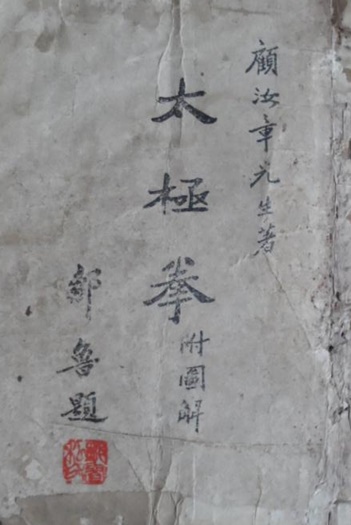
顧汝章先生著
by Gu Ruzhang:
太極拳(附圖解)
Taiji Boxing (including illustrations)
鄒魯題
– calligraphy by Zou Lu
–
太極拳詳細圖解目錄
TAIJI BOXING ILLUSTRATED IN DETAIL CONTENTS
顧汝章玉照
Portrait of Gu Ruzhang
凡例
General Comments
自序
Author’s Preface
郭岐鳳序
Preface by Guo Qifeng
第一章 太極拳之理論 上篇
Chapter One: Taiji Boxing Theory – (The Upper Section)
(一)太極先師張三丰傳
1. A Bio of Taiji Founder Zhang Sanfeng
(二)太極拳源流考
2. Examining the Origin & Development of Taiji Boxing
(三)太極圖形解說
3. Explaining the Taiji Symbol
(四)太極化生說
Part 4. Explaining Taiji’s Generative Principle
(五)明石右王宗岳太極拳經(並註)
5. The Taiji Boxing Classic of Wong Zongyue of Shanxi of the Ming Dynasty (with commentary)
(六)太極拳論(並註)
6. The Taiji Boxing Treatise (with commentary)
(七)十三勢淺解
7. An Overview of the Thirteen Dynamics
(八)十三勢歌訣
8. Thirteen Dynamics Song
(九)十三勢行功心解(並註坿訣)
9. Understanding How to Practice the Thirteen Dynamics (with commentary and songs)
(十)太極拳術練法之要義
10. Essentials of Practicing the Taiji Boxing Art
(十一)太極拳之五要訣
11. Taiji Boxing’s Five-Word Formula
(十二)擎放密訣
12. The Trick to Raising & Releasing
(十三)走架打手行功要言
13. Essentials in Practicing the Solo Set & Playing Hands
(十四)太極拳術打手歌(並註)
14. Taiji Boxing’s Playing Hands Song (with commentary)
(十五)練太極拳術之經騐(一)(二)
15. Experiences of Practicing Taiji Boxing (two parts)
(十六)太極拳應用須知
16. Things That Must be Understood in the Application of Taiji Boxing
(十七)附藥方
17. Added Prescriptions
第二章 太極拳術詳解(附圖)中篇
Chapter Two: Taiji Boxing Solo Set Explained in Detail (including photos) – (The Middle Section)
(一)太極拳式名稱表
1. List of Taiji Boxing Posture Names
(二)太極拳式全蹚分講…由第一式至一〇三式
2. Breakdown of the Entire Set, From Posture 1 to Posture 103:
1,名稱 Name [About half the time, the explanations for the posture names are mostly copied from Yao Fuchun & Jiang Rongqiao’s 1930 manual.]
2,練法 Practice Method
3,功用 Effects
4,用法 Application
5,姿勢(附圖) Posture (photo)
第三章 太極拳推手法(附圖)下篇
Chapter Three: Taiji Boxing’s Pushing Hands Methods (including photos) – (The Lower Section)
1,太極拳推手之講義
Taiji Boxing’s Pushing Hands Curriculum
2,四正推手法
Pushing Hands Method for the Four Primary Techniques:
掤,捋,擠,按。(裡按外按)之使用及練法。
Warding Off, Rolling Back, Pressing, and Pushing Down (including both pushing down inward and pushing down outward) – their function and practice method.
3,四隅推手法(卽大捋推手法也)
Pushing Hands Method for the Four Secondary Techniques (known as Large Rollback Pushing Hands):
採,挒,肘,靠。之使用及練法。
Plucking, Rending, Elbowing, and Bumping – their function and practice method.
4,其他推手法
Other Pushing Hands Methods:
甲「單手推單手」之使用及練法。
A. Single Hand vs. Single Hand – its function and practice method.
乙「雙手推單手」之使用及練法。
B. Double Hand vs. Single Hand – its function and practice method.
丙「對步雙手推雙手」之使用及練法。
C. Facing-Step Double Hand vs. Double Hand – its function and practice method.
丁「拗步推手」之使用及練法。
D. Twisting-Hand Pushing Hands – its function and practice method.
戊「左右三人雙手推單手」之使用及練法。
E. Three-Person Double Hand vs. Single Hand on Both Sides – its function and practice method.
補述
Supplementary Comments
唐啓賢跋
Postscript by Tang Qixian
–
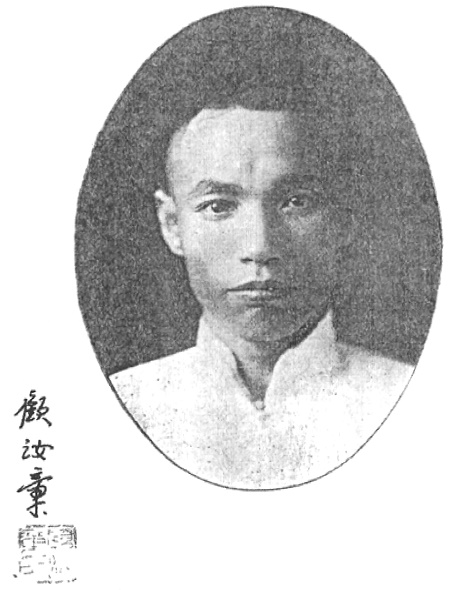
顧汝章玉照
Portrait of Gu Ruzhang [including his signature and stamp]
–
凡例
GENERAL COMMENTS [text for the first six items mostly copied from Sun Lutang’s 1921 Taiji manual, also copying from Sun’s 1915 Xingyi manual for seventh item]
一是書分為上下兩編。由源流起至太極拳收式為上編。下編為各式推手。是全其用。以二人打手分甲乙上下之勢。由開門起點。進退伸縮。變化諸法。一一詳載。打手時。凡一動一靜。按此定法。不使紊亂。則此拳之全體大用功能。庶幾近於道矣。
– This book is separated into two parts (an “upper section” and a “lower section”): the first part goes through the solo set, from its beginning posture to its closing posture, while the second part goes through each of the pushing hands postures, which throughout show two people doing the exercises, marked A and B, or the initiator and the responder. [There is no proper theory section in Sun’s book beyond a meager appendix supplying the Li Yiyu texts, thus there are indeed only two sections in Sun’s book, but in this book there are explicitly three – theory, set, pushing (an “upper section”, a “middle section”, and a “lower section”). Also, this book has not merely a Person A and a Person B as in Sun’s book, but an A, B, and C. Therefore to plagiarize these particular comments from Sun’s book seems somewhat inattentive.] From its beginning position, there is advancing and retreating, extending and contracting, transforming in various ways, explained in step-by-step detail. When pushing hands, each movement is also a stillness. In this way, you will prevent yourself from being disordered. Thus the ways of this art as a whole will bring you very close to the Way.
一此書上編之單人所練太極拳。乃一氣流行。一動一靜。上下相隨。內外如一。謂之練體。為知己功夫。下編二人打手。起落進退。左顧右盼。縱橫聯絡。變化無窮。謂之習用。為知人功夫。古人云。知己知彼。百戰百勝。此之謂也。
– The first part of this book is concerned with solo practice, with moving in a flowing way, combining movement and stillness, getting your upper body and lower body to be coordinated with each other, and making inside and outside become one. This is called “practicing the essence”, and is the practice of knowing yourself. The second part of this book is concerned with partner practice, with rising and lowering, advancing and retreating, working both sides, moving freely and staying connected, and changing endlessly. This is called “practicing the function”, and is the practice of knowing the opponent. An ancient man said [Sunzi – Art of War, chapter 3]: “Knowing both self and opponent, in a hundred battles you will have a hundred victories.” This is the idea.
一此書拳術。不尚血氣。純任自然。不能傷其後天之力。專以善養人之浩然之氣為主。
– The boxing art in this book values naturalness rather than vigor, and thereby will not diminish the strength you have developed. It is especially “good at nurturing (your) noble energy” [Mengzi, chapter 2a].
一此書專講究為修身而作。凡我同胞。無論何界。男女老幼。皆可習之。身體過懦者。可以使之强。過剛者。可以使之柔。或有身體極弱。及有癆傷病症者。或因他種拳術。非血氣之力不能練習者。亦均可以練之。將氣質馴致中和。氣固而神自完。却病延年。可操左券。
– Use this book with particular attention toward self-cultivation. We are all compatriots, no matter where we come from. Man or woman, young or old, all can practice this art. The overly meek can become mighty and the overly tough can be softened. It is for those whose bodies are very weak or debilitated by diseases, and it is for those who seek to train in a martial art that is not quite so vigorous as others. Anyone can practice it. It will tame your temperament and bring it into harmony. Your vitality will become solid and your spirit will naturally become full. Disease will be prevented and life prolonged. These results are guaranteed.
一此書將拳理加註。至於拳中功用。名稱。動作次序。一一詳細說明。使學者。虛心研究。方知拳中一氣貫通之奧妙。
– This book presents the boxing theory with added commentary, and the boxing usage with the names of the postures and the sequence of the movements in step-by-step detailed explanations, so that those students with a willingness to study will be able to know the subtlety within the art of there being a single energy running through it all.
一此書每式均附有形圖。用電版製成。而於陰陽方向不致錯誤。使太極拳之姿勢確實。以達太極拳之精神。能力巧妙。因知各式互相連絡。總合而為一體。終非散式也。
– With all the postures in this book are included pictures made from photographic printing plates, presented without error in brightness or angle. This means the Taiji Boxing postures are presented more reliably so that you can achieve the art’s spirit and become capable with its skills. But you should know that each posture is connected to those surrounding it, joined together as a single unit, and that throughout there is to be no discontinuity between the postures.
一此書為發揚國術起見。祇叙斯拳之實益。議論以粗淺。易明之言。簡約之式。但求通達。原非等於詞藻文章。幸勿以文理拘也。
– As the purpose of this book is to promote martial arts, it only discusses the genuine benefits of this art, explaining them in a common and shallow style so that they will be in language easy to understand. The posture descriptions are concise, striving to be effective rather than being pompous, happily unrestricted by literary expectations.
一此書因應急需。倉卒付梓。錯漏之處。在所難免。尚希海內明達。不吝指敎。俾再版時。重加修正。不勝企望。
– Because this book is a response to an urgent need, it was hurriedly published. Inevitably there are errors, and I hope all those in the nation who understand these things will not hold back in pointing out its flaws. In a future edition, there will be an emphasis on making corrections, and I am eagerly looking forward to it. [Alas, such a future edition never happened. The following year the Japanese invaded, and then after the Japanese surrendered, the conflict between nationalists and communists resumed. The progress of martial arts publishing had been considerably distracted for twelve years, and then not that long after things had at last settled down, Gu died. The closest thing to a future volume of this specific material was by his student: Long Zixiang’s 1952 manual.]
–
自序
AUTHOR’S PREFACE
太極拳。為武當嫡傳。稱內家拳。其術主柔。柔中有勁也。練架子。以慢為佳。慢非一式一式。固為遲慢。盖一氣呵成。連綿不斷。粘着弗丢也。每見世之習外家拳者。鼓努為力。騰踴呼呌。此皆以後天之拙力為尚。太極拳術與此適反。尚氣則滯。尚力則拙。豈能語虛靈之境哉。練架式則純任自然。毫無勉强劇烈之病。不獨少壯者可習。即老弱者。尤宜習。習而久之。尤有却病延年之功。非尋常外家拳所可比擬也。至於禦侮制敵。尤餘事耳。余有暇晷。輒喜演練架式。即平常衣服。或穿長袍。皆可從事。尤為武術中之嫻雅者。民國廿五年。重遊羊石。應陳總司令之聘。任技術敎官。學子中有以太極拳編纂成書。以便練習為請者。余以課忙。實無握管之時間。荏苒半年。後得敎員唐啓賢君之助。(唐君為予入室弟子)卒成此編。以往昔得諸師友者。拉雜寫來。不敢云于拳中眞諦。有所發明。祗紹述先賢之理論而已。各式均有附圖。演練架式。按圖索驥。俾熱心斯道。而無暇就學者。可以自修。一秉公開研究之旨。作提倡國術之一助云爾。
中華民國廿五年江蘇顧汝章序于廣州國術社
Taiji Boxing was handed down from Wudang. It is deemed an internal style of boxing. The key to the art is softness. Within its softness lies its strength. When practicing the solo set, slowly is best. Slow does not mean posing in each posture one after another, for that would only train hesitation. It should be a continuous flow from beginning to end, connected and unbroken, adhering together without interruption.
We constantly observe external stylists trying so hard in all their jumping and shouting. Such training only ingrains a habit of excessive effort. The art of Taiji Boxing does the opposite. To emphasize anger makes one stiff, and to emphasize effort makes one clumsy. How could we talk of nimbleness in such cases? When practicing the solo set, it should be completely natural and not have the least bit of strenuous effort.
This art is not only for the young and strong to practice. It is particularly suitable for the old and weak, because after practicing over a long period, it has the special result of preventing disease and prolonging life, which it does much better than external styles. This art also repels bullies and defeats opponents, but it excels at these extra benefits. Whenever I find spare time, I delight in practicing the solo set. It can be done in ordinary clothes or long robes, either way, and so it is especially suited for sophisticated citizens who want to train in martial arts.
During 1936, I have been frequently traveling to Yangshi [an army barracks about 75 miles northeast of Guangzhou], where Commander-in-Chief Chen Jitang has appointed me as instructor. The students there asked me to put together a book on Taiji Boxing for them to train from. Being fully occupied with teaching the lessons, there really has been no time to write, and half a year has slipped by. Then after I enlisted the help of my student Tang Qixian, this volume has been brought to completion.
In the old days, teachers and their colleagues wrote these things down in a very disorganized way. Yet we do not presume to add anything to the essence of the art, and are only passing down the theories of the forefathers. With each posture is included a photo to help you find your way as you practice the solo set. Students who are earnestly interested but have no time to take formal classes will be able to train themselves in this way. Our purpose is to give this research to the public so as to help boost our martial arts.
– written by Gu Ruzhang of Jiangsu at the Guangzhou Martial Arts Society, 1936
–
序
PREFACE [BY GUO QIFENG]
國術一門。有內外兩家之分。世人嘗云。外家祖。達摩祖師。曰少林派。內家祖。張三丰先生。曰武當派。攷其眞理。名殊而源同。其所為拳術用勁。不外乎順天自然之理。形於外。蘊於內者。故有張祖師三丰遺留太極拳之名。運用依純正之氣。世人不察。以外家主剛。內家主柔。不可偏重。且亦未嘗須臾離也。
吾國拳術。發明最早。歷代世有傳人。然口傳心授。隱秘其法。不以著傳後人。講武者。莫不宗其所傳。淺俗歌訣。記之不能詳其理法。然習之者。多不能盡其術。且傳者多秘其精妙。言術而不能言理。後學更無從問津焉。今廣州國術社社長顧君汝章。精研太極拳術。恐此傳之年久。必當失傳。特著太極拳專書。註及圖解。以餉同志。詳其動作。誌其應用。此拳無論男女婦孺。及年近半百之人。均可練習。一無猛烈曲折之苦。二無跳高躍險之勢。隨便常服。均能從事。好斯術者。得空前絕後之妙技也。讀者苟能悉心體會。豁然貫通。自不難階及神明。余不敏。敢眞言不貢。對斯術未窺門徑。畧贅數言而矣。
固始郭岐鳳序於羊城
Martial arts are a single entity which divides into two schools, internal and external. It is commonly said that the ancestor of the external was Damo, and it is called the Shaolin school, while the ancestor of the internal was Zhang Sanfeng, and it is called the Wudang school. Examining their veracity, their names are different but their source is the same: when power is applied in these arts, they do not go beyond the principles of nature and naturalness.
To reveal is a feature of the external, to conceal a feature of the internal. And so Zhang Sanfeng has handed down to us what is called Taiji Boxing, which moves according to pure energy. People do not scrutinize sufficiently, saying that the external is all about hardness and the internal is all about softness. Though while we must not overstress this distinction, we also should not ignore it.
Our nation’s martial arts were the earliest to be developed. Over the centuries, they were transmitted orally, the methods kept secret instead of being written down for future generations, yet those who discuss martial arts all venerate what has been passed down. It is beyond the capacity of rustic verse to record the theories in detail, and so practitioners are usually not able to address the material exhaustively. Furthermore, many who transmit these arts hold back their deeper essence, and though they talk about them, they are unwilling to discuss the theory, making it that much harder for pupils to be able to delve into them.
But now the director of the Guangzhou Martial Arts Society, Gu Ruzhang, has made an intensive study of the art of Taiji Boxing, and fearing that over time the art will die out, has written an exceptional book focusing on it, complete with annotations and photographs so as to provide for our comrades. He explains the movements and makes note of their applications.
With this art, regardless of whether you are a man or woman, a wife or child, or an aging person, all can practice. It lacks agonizing vigor and contortionism, as well as postures of jumping high and leaping riskily, and can be done in casual attire. Those who enjoy this art will gain unique skills, and readers who are able to pay careful attention will come to realize clearly and will not have difficulty progressing toward illumination on their own. I am not clever and I do not presume to be contributing great words. I have not yet had a breakthrough in this art, and so my comments here may be rather superfluous.
– written by Guo Qifeng of Gushi [in Henan] at Yangcheng [older name for Guangzhou]
–
太極拳
TAIJI BOXING
–
第一章 太極拳之理論
CHAPTER ONE: TAIJI BOXING THEORY
–
(一)太極先師張三丰傳
I. A BIO OF TAIJI FOUNDER ZHANG SANFENG [text mostly copied from Chen Weiming’s 1925 manual, influenced in part by the version in Yao Fuchun & Jiang Rongqiao’s 1930 manual]
張三丰。字全一。一名君寳。又名玄玄。亦號昆陽。關外懿州人也。生有異質。鶴髮仙骨。面長身頎。高七尺餘。修髯如戟。頂作一髻。常戴偃月冠。一笠一衲。雖嚴寒酷暑。皆不肯易。人皆呼為張邋遢。所啖升斗輙盡。或數月不食。亦無飢色。盖得呂純陽之先天道。及鄭六龍之太上道也。元末。居寰鷄金台觀。正至丙午。九月廿日。自言亂世。留偈而逝。士民楊軌山。置棺殮訖。臨窆復生。時年百三十歲矣。後入蜀。至太和山。結茅於玉虛庵。庵前古木五株。常棲其下。猛獸不傷。鷙鳥不摶。衆皆驚異。常語土人曰。此山當受朝廷勅修。成祖時果如其言。眞人隱於傭工。人皆不識。該山主持。丹士孫碧雲。受敎於眞人。帝聞之屢召不赴。以詩詞託碧雲奏之。後以術傳道士丘元靖。不知所終。今世傳太極拳術。乃張三丰所傳也。又云眞人為武當山隱士。徽宗召之。道梗不得進。夜夢元帝授以拳法。厥明單丁殺賊百餘。其術可謂奇矣。師壯為儒者。工詩詞。善書畫。至中統元年。曾任中山博陵令。因政悟道。乃於寳鷄山中金台觀隱修。山有三峰。自號曰三丰子。故今之習太極拳者。輒稱張三丰為祖師焉。
Zhang Sanfeng, given name Quanyi, and called Junbao, Xuanxuan, or Kunyang, was from Yizhou, beyond the eastern end of the Great Wall. He was born with an unusual nature. He had white hair and the body of an immortal. His face was long and he was very tall, more than seven feet. His beard was like a trident and his hair was rolled into a bun on top of his head. He often wore a crescent-moon cap or a bamboo hat and patchwork monk’s vest. He could not be bothered to adjust his clothes to suit winter or summer in their peak, and everyone called him “Zhang the Slob”. He would be satiated after eating no more than a bowlful, and go several months without eating and never look hungry.
He obtained Lu Chunyang’s Natural Way and Zheng Liulong’s Uppermost Way. While the Yuan Dynasty was drawing to a close [ending in 1368], he dwelled at Golden Tower View in Baoji. In 1366, ninth month, twentieth day, he said he was going to die, then passed away while chanting. The scholar Yang Guishan placed him in his coffin, and saw him buried and then saw him resurrected. In this year, Zhang was a hundred and thirty years old.
Later Zhang went to Sichuan, and upon arriving at Mt. Taihe [Wudang], he built a hut at the Jade Void temple. He would often dwell under the five ancient tree trunks in front of the temple, but he was never harmed by wild beasts nor attacked by birds of prey, to the surprise of everyone. It was often being said by the locals: “This mountain has received the royal command from Emperor Yongle to be embellished.” Zhang then mixed himself in with the rest of the laborers and nobody could recognize him. The elixirist abbot of Wudang, Sun Biyun, received many of Zhang’s teachings. The emperor heard about this and repeatedly summoned Zhang, but still he would not attend upon the emperor, and poetry was applied for Sun to try to win Zhang over with. Later he passed the art on to the Daoist priest Qiu Yuanjing. We do not know where it went from there, but the Taiji boxing art that has been passed down to us came from Zhang Sanfeng.
It is also said [from the memorial tablet for Wang Zhengnan]: “Zhang was a hermit of Mt. Wudang. Emperor Huizong summoned him, but his route was blocked and he could not get through. That night in a dream, the first Song Emperor gave him the boxing method. The next day he single-handedly killed over a hundred bandits.” His skill could be described as rare indeed. When he was young he was a Confucian scholar, versed in poetry and essays, good at calligraphy and painting. Then in the first year of Kublai Khan’s reign [1260], he was appointed to tend the abundant hills of the central mountains. But he wanted to improve himself and find the truth, so he instead went to Golden Tower View at a mountain in Baoji to be a hermit and cultivate himself. There the mountain has three peaks, and because of this he’s called Sanfengzi [“Triple Peak Master”]. Thus those who practice Taiji Boxing today call Zhang Sanfeng the founder.
–
(二)太極拳源流考
II. EXAMINING THE ORIGIN & DEVELOPMENT OF TAIJI BOXING [much of the text copied out of Yao Fuchun & Jiang Rongqiao’s 1930 manual]
中國之拳術。名稱不一。然不外內功與外功而已矣。外功宗少林。以其動作皆壯於外。前人多有論及。茲不複贅。內功宗武當。以其勁蓄於內。如太極拳是也。蓋其勁不顯於外。純任自然。如環之無端。動作圓活。又稱其為內功。與少林不同者也。按太極拳之流派。可分為五。(一)唐朝許宣平者名曰三十七式。以其僅三十七式之動作。故得是名。後傳宋遠橋。(二)為俞氏所傳者。名曰先天拳。授自唐朝之李道子。傳兪淸慧等。(三)為韓拱月傳程靈詵。後傳至程氏子孫。名曰程鉍者。改名曰。小九天。共有十四手。(四)為殷利亨所傳者。為後天法。傳胡鏡子。再傳宋仲殊。共有十七式。(五)為張三丰所傳者為武當派(因張居留在武當山)又名內家拳。動作最多。再改名為太極拳。又分為兩派。張松溪。張近泉。王征南。甘鳳池等。是為南派。王宗岳。蔣發。陳長興。為北派。張松溪傳四明葉近泉。再傳吳崑山。周雲山。單思南。陳貞石。孫斷槎。後崑山傳李天目。徐岱岳。再傳余仲波。吳七郎。陳茂宏。雲山傳盧紹岐。貞石傳董扶輿。夏枝溪。斷槎傳僧耳。僧尾。姚石門。柴元明。思南傳王征南。再傳甘鳳池。迄至淸初乃傳山右王宗岳。數傳無法考。後又傳至河南蔣發及陳長興。長興傳子紀信。耿信。及廣平楊祿禪。陳耕耘。李白魁諸人。祿禪又傳其子斑侯。建侯。王蘭亭等。斑侯傳萬春。全祐。侯凌山。陳秀峰等。建侯傳其子兆熊。兆淸。兆元。兆林。兆祥。李景林。劉勝奎。張義。許禹生等。兆熊字少侯。傳田紹麟。尤志學等。兆淸字澄甫。傳子振銘。董英傑。陳微明。武滙川。褚德馨。牛春明。閻仲雁。陳農先。徐苕雪等。全祐傳吳鑑泉諸人。吳鑑泉傳褚民誼。徐致一等。李景林傳顧汝章。郭岐鳳。白志祥等。聞河南陳淸平。乃陳家溝之嫡傳。名為活步開合太極拳。與楊家練架子動作不同。而拳中理論則一。惟推手各式。仍與楊家無異。是源流同一之証也。首由陳淸平傳武禹讓。禹讓傳李亦畬。亦畬傳郝為楨。為楨傳孫祿堂。祿堂傳顧汝章。白志祥等諸人。此不過就所知者。大槪言之。蓋各人均有傳授。代有傑出。容俟調查淸楚。再版時。一併編入。俾後之學者。得知其本源焉。
China’s boxing arts have many names, but amount to no more than the internal skill and the external skill. The ancestor of the external is Shaolin. Its movements are all magnificently expressed. Since its principles have been spelled out by many previous generations, they do not need to be repeated here. The ancestor of the internal is Wudang. Its strength is stored within, such as in Taiji Boxing. Its power not being outwardly displayed, it instead has a pure naturalness. Like an unending circle, its movements are lively. And so it is deemed internal and is different from Shaolin.
Taiji Boxing’s origin can be separated into five versions:
1. Xu Xuanping of the Tang Dynasty taught something called Thirty-Seven Postures. It had only thirty-seven movements, hence the name. Later it was passed on to Song Yuanqiao.
2. The Yu family taught something called Innate Nature Boxing. It was received from Li Daozi of the Tang Dynasty, who taught Yu Qinghui and others.
3. What Han Gongyue taught to Cheng Lingshen [Lingxi] was later transmitted to a descendant of his, and it was called Cheng Bi’s version. The name was changed to Small Highest Heaven, and it contained a total of fourteen hand techniques.
4. What Yin Liheng taught was the Acquired Nature Method. He taught it to Hu Jingzi, who then passed it on to Zhong Shu of the Song Dynasty, and it contained a total of seventeen postures.
5. What Zhang Sanfeng taught was of the Wudang branch (because he was living in the Wudang mountains), and it was known as the “internal school” of boxing. This version had the highest number of movements yet. Again the name was changed, now to Taiji Boxing, and it went down two paths:
[1] Zhang Songxi, Zhang Jinquan, Wang Zhengnan, Gan Fengchi, and so on – this is the southern school.
[2] Wang Zongyue, Jiang Fa, Chen Changxing – this is the northern school.
[Southern school:]
Zhang Songxi taught it to Ye Jinquan, who then taught it to Wu Kunshan, Zhou Yunshan, Shan Sinan, Chen Zhenshi, and Sun Duancha. Wu Kunshan then taught Li Tianmu and Xu Daiyue, who then taught Yu Zhongbo, Wu Qilang, and Chen Maohong. Zhou Yunshan taught Lu Shaoqi. Chen Zhenshi taught Dong Fuxing and Xia Zhixi. Sun Duancha taught Seng Er, Seng Wei, Yao Shimen, and Chai Yuanming. Shan Sinan taught Wang Zhengnan, who then taught Gan Fengchi.
[Northern school:]
In the beginning of the Qing Dynasty, it was transmitted to Wang Zongyue of Shanxi. Several generations passed that we have no way of examining, but later it found its way to Jiang Fa of Henan, as well as Chen Changxing. Chen Changxing taught his sons, Jixin and Gengxin, and to Yang Luchan of Guangping, Chen Gengyun, Li Baikui, and many others. Yang Luchan also taught his sons, Banhou and Jianhou, as well as Wang Lanting and others. Yang Banhou taught Wan Chun, Quan You, Hou Lingshan, Chen Xiufeng, and others. Yang Jianhou taught his sons, Zhaoxiong, Zhaoqing, Zhaoyuan, Zhaolin, Zhaoxiang, as well as Li Jinglin, Liu Shengkui, Zhang Yi, Xu Yusheng, and others. Yang Zhaoxiong, called Shaohou, taught Tian Shaolin [a confused combination of Zhaolin and his other name Shaoxian], You Zhixue, and others. Yang Zhaoqing, called Chengfu, taught his son Zhenming, as well as Dong Yingjie, Chen Weiming, Wu Huichuan, Chu Dexin, Niu Chunming, Yan Zhongyan, Chen Nongxian, Xu Tiaoxue, and others. Quan You taught [his son] Wu Jianquan and many others. Wu Jianquan taught Chu Minyi, Xu Zhiyi, and others. Li Jinglin taught Gu Ruzhang, Guo Qifeng, Bai Zhixiang, and others.
[Another northern branch:]
It is well-known that Chen Qingping of Henan, a direct-lineage descendant of the Chen family village, named his art Agile Step Expand-Contract Taiji Boxing. The movements are different from the solo set as practiced by the Yang family, but the boxing theory is identical, and the pushing-hands exercises are also the same. Thus it has the same credentials. It started from Chen Qingping, who taught it to Wu Yurang [Yuxiang], who taught it to Li Yiyu, who taught it to Hao Weizhen, who taught it to Sun Lutang. Sun Lutang taught Gu Ruzhang, Bai Zhixiang, and many others.
These are just the people we know about, to give a general idea. To cover every person who has received it and make a clear survey of the prominent practitioners of each generation, that will have to wait for a future edition. More will be added later so that future students can know about the source of their art.
–
(三)太極圖形解說
III. EXPLAINING THE TAIJI SYMBOL
太極圖說云。氣者神之宅也。體者氣之宅也。又云。仁配天地。謂之人。渾淪無端。謂之太極。空洞無際。謂之太虛。眞精不二。謂之太一。生化莫測。謂之太造。又云天高地下。渾兮闢兮。二氣絪蘊。莫知端倪。屈伸摩盪。變化無方。成象成形。洋洋乎充塞於兩間矣。觀此。則天地一氣功也。人受天地之氣而生。人身亦為一小天地耳。故天地人稱為三才。則人身亦一氣功也。
It says in the “Explanation to the Taiji Diagram” [This paragraph does not actually quote from Zhou Dunyi’s famous Explanation to the Taiji Diagram, nor is Zhou’s diagram even pictured in this book, but instead quotes from Lai Zhide’s commentary to the Book of Changes, although not including his particular taiji symbol either.]: “Energy houses the spirit, and the body houses the energy.” It also says: “Benevolence joins us to the universe – it is called Humanity. All things are blurred together without distinctions – it is called the Grand Polarity. The emptiness is limitless – it is called the Grand Void. Perfection lies not in twoness – it is called the Grand Oneness. Evolution operates unnoticed – it is called the Grand Creation.” It also says: “Sky is high above, ground just below, joined together in surrounding us. These two energies merge in dense mist, so we can no longer tell them apart. Twisting, stretching, rubbing, shaking, they transform without pattern. Things are thereby manifested and take form to fill up the vastness between the two.” Looked at in this way, the universe is two things merged into one. A person receives the essence of both and is brought to life. A man is a small universe himself. Therefore sky, ground, and mankind are called the “three substances”, and the human body is the achievement of [all three blending into] a single energy.
古式双魚太極圖形(其一)
traditional double-fish taiji diagram 1:
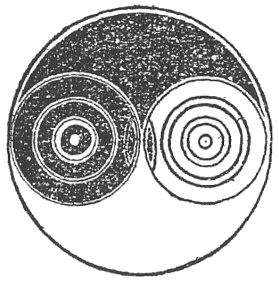
古式双魚太極圖形(其二)
traditional double-fish taiji diagram 2:
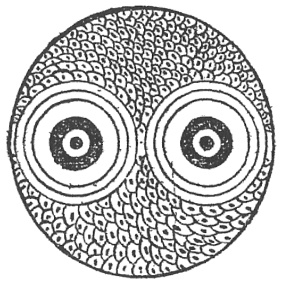
右列二圖。為世俗所傳之太極圖形。中繪雙魚形相啣連。陰陽交接。蓋天地未分以前。名曰太極此圖卽示混沌未判之意。故易經有無極生太極。太極生兩儀。兩儀生四象。四象生八卦。如吾心寂然。無思無慮。萬善未發。是謂無極也。陽動以喻太極。陰靜以喻無極也。動之始則陽生。動之極則陰生。始靜則柔。極靜則剛。故習太極拳至活步推手時。多從此中求奧妙。第一圖白色者為陽。黑色者為陰。其點是為陰中陽。陽中陰。可知陰陽鼓盪於圜形中。亦即為太極拳之陰勁與陽勁也。
[Much of this paragraph is copied from Yao Fuchun & Jiang Rongqiao’s 1930 manual.] The two drawings above are common ways to display a taiji diagram. Within each is drawn a pair of fish linking at the mouths, representing passive and active interconnected. The condition before skyness and groundness become distinct from each other is called the Grand Polarity. These drawings depict the concept of the primal murkiness before there were such distinctions. It is said in the Book of Changes: “Nonpolarity generated the Grand Polarity, the Grand Polarity generated the dual aspects, the dual aspects generated the four manifestations, and the four manifestations generated the eight trigrams.” When my mind is silent, without wants or worries, even all good things making no voice, this is called Nonpolarity. When active, when there is movement, this is like the Grand Polarity. But when passive, when there is stillness, this is like Nonpolarity. When movement starts, then the active aspect is generated. When movement reaches it limit, then the passive aspect is generated. As stillness begins, there is softness. As stillness peaks, there is hardness. Therefore, whenever you practice Taiji Boxing, all the way through to moving step pushing hands, it is by always following this central principle that you will seek out the secret. In the first drawing above, the white part is the active aspect and the black part is the passive aspect. The dots are the active within the passive and the passive within the active. We can see passive and active surge around the middle, and these are the passive and active energies of Taiji Boxing.
先天畫卦圖
depiction of the primordial state:
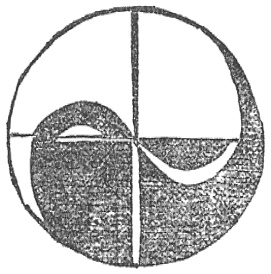
無極生太極圖
depiction of Nonpolarity generating the Grand Polarity:
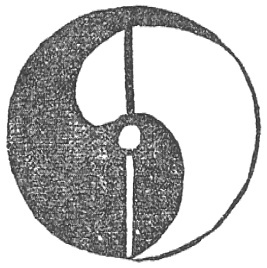
上列二圖。其一為先天畫卦圖。亦成為一圜形。而陰陽相生。循環不斷。即太極拳中之走勁黏勁而為化勁也。按走勁者卽陰勁也。黏勁者即陽勁也。其二圖為無極生太極也。陰陽內蘊。而對待者數也。中圈是無極。主宰者理也。陰極生陽。陽極生陰。流行者氣也。即太極之以心行氣之意也。
Of the two drawings above, the first is a depiction of the primordial state, a circle in which passive and active are giving rise to each other, circulating endlessly. This is Taiji Boxing’s yielding energy and sticking energy, the sum of which is neutralizing, the yielding energy being the passive energy and the sticking energy being the active energy. The second drawing is a depiction of Nonpolarity generating the Grand Polarity. The passive and active aspects are contained within, constantly approaching each other. At the center of the circle is Nonpolarity, which is the governing principle. Passive at its limit generates the active, and active at its limit generates the passive. This is the flow of energy. Herein lies the meaning in Taiji of “use mind to move energy”.
三才太極圖
depiction of the Grand Polarity as the Three Substances:
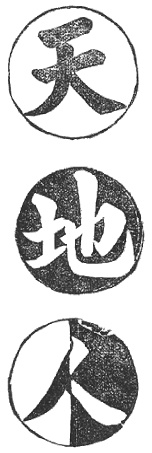
天
sky
地
ground
人
mankind
右列三圖。可知天地人均為一太極以兩間皆氣所充塞。人旣受天地之氣而生。即無在而不太極也。
From the three diagrams above, we can see that sky, ground, and mankind all make a grand polarity by way of the space between two energies filling in: a person receives the energies of both sky and ground and is given life. Unless this is the case, there is no Grand Polarity.
–
(四)太極化生說
IV. EXPLAINING TAIJI’S GENERATIVE PRINCIPLE
太極化生之理。無極生有極。有極生太極。太極生兩儀。兩儀生三淸。三淸生四象。四象生五行。五行生六脉。六脉生七巧。七巧生八卦。
Taiji’s generative principle: Nothingness generates Somethingness, Somethingness generates Everythingness, Everythingness generates the dual aspects, the dual aspects generate the three distinctions, the three distinctions generate the four manifestations, the four manifestations generate the five elements, the five elements generate the six arteries, the six arteries generate the seven ingenuities, and the seven ingenuities generate the eight trigrams.
1無極
NOTHINGNESS
無極者。無影無形。無動無靜。無思無慮。無式無法。混沌一體。
The “Nothingness” [wu ji – “without polarity”] is: no image or shape, no movement or stillness, no thoughts or cares, no patterns or methods, everything mixed together as a whole.
2有極
SOMETHINGNESS
有極者。有式有法。有動有靜。有形有意。有神有情。有虛有實。有急有緩。有柔有剛。純任自然。一氣貫通。
The “Somethingness” [you ji – “with polarity”] is: having patterns and methods, having movement and stillness, having shape and idea, having spirit and emotion, having emptiness and fullness, having quickness and leisure, having softness and hardness, everything pure and natural, a single flow throughout.
3太極
EVERYTHINGNESS
太極者。是一體是事。萬物由太極生。萬法由體變化。一站一立。一出一入。一動一靜。一招一勢。萬法得而合一。
The “Everythingness” [tai ji – “grand polarity”] is the integration of the whole, for everything is generated from Everythingness, all principles transformed by its essence. With each position and stance, each exiting and entering, each movement and stillness, each technique and posture, all methods obtain unification.
4兩儀
DUAL ASPECTS
兩儀者。兩手分陰陽。分前後。分左右。分上下。分反正。兩手有出有入。有伸有縮。有收有放。有緩有急。有虛有實。
The “dual aspects” are your two hands separated into the roles of passive and active, forward and behind, left and right, above and below, contrary and straightforward, exiting and entering, extending and withdrawing, gathering and releasing, leisurely and quick, empty and full.
5三淸
THREE DISTINCTIONS
三淸者。是首身足。分上中下三盤。分三節。分三禮。三盤要淸靈活合。進退要淸。動靜要靈。閃展要活。曲直要合。
The “three distinctions” are your head, torso, and legs. They divide above, between, and below into the “three levels”, “three sections”, or “three bodies”. The three levels should have the qualities of crispness, craftiness, liveliness, and unity. Advancing and retreating should be crisp. Movement and stillness should be crafty. Dodging and extending should be lively. Bending and straightening should be combined.
6四象
FOUR MANIFESTATIONS
四象者。是週身而要嚴前後左右。前進後退。前攻後守。左顧右盼。奔前以護後。閃左以顧右。
The “four manifestations” are the close attentions paid by your whole body to the front, back, left, and right. In advancing and retreating, go forward attacking and backward defending, rushing forward to protect behind [and rushing back to protect in front]. In looking left and gazing right, dodge to the left to be looking to the right [and dodge to the right to be gazing to the left].
7五行
FIVE ELEMENTS
五行者。金木水火土。心肝脾肺腎。上下左右中。一護首。二護肘。三護中心。四護腎。五護膝。
The “five elements” are: metal, wood, water, fire, and earth; heart, liver, spleen, lungs, and kidneys; forward, back, left, right, and middle; as well as: 1. protecting your head, 2. protecting your elbows, 3. protecting your center, 4. protecting your kidneys, 5. protecting your knees.
8六脉
SIX ARTERIES
六脉者。六合也。心與意合。意與氣合。氣與力合。手與足合。肘與膝合。肩與胯合。六種操法相合。合而歸一。一氣貫通。(一)伸縮往來。(二)聚神驚嚇。(三)沉滾揉挄。(四)接掩揎擎。(五)劈摟攉挑。(六)引進落空。
The “six arteries” are the six unions: mind united with intent, intent united with energy, energy united with power, hand united with foot, elbow united with knee, and shoulder united with hip [the “arteries” being the imaginary conduits by which they unite]. They are also six kinds of drills that are to be merged together into a single flowing method: 1. Expanding and contracting, come and go. 2. Concentrate your spirit to intimidate the opponent. 3. Sink, roll, rub, and twist. 4. Connect, cover, push, and lift. 5. Chop, drag, shovel, and carry. 6. Draw him in to land on nothing.
9七巧
SEVEN INGENUITIES
七巧者。是巧妙變換。一變腰。二變腕。三變肘。四變肩。五變身。六變胯。七變步。又謂之七種動作也。(一)進步。(二)退步。(三)閃展步。(四)連環步。(五)萬子步。卍(六)旋轉步。(七)搖身膀胱。
The “seven ingenuities” are the clever ways of transforming: 1. transform at your waist, 2. transform at your wrist, 3. transform at your elbow, 4. transform at your shoulder, 5. transform with your torso, 6. transform at your hip, 7. transform with your step. The term is also applied to seven ways of moving: 1. advancing, 2. retreating, 3. side-stepping, 4. continuous stepping, 5. zigzagging, 6. spinning around, 7. shaking.
10八卦
EIGHT TRIGRAMS
八卦者。乾坎艮震巽離坤兌。是謂之八門也。合掤捋擠按為四正方。採挒肘靠。為斜四角也。
The “eight trigrams” are ☰, ☵, ☶, ☳, ☴, ☲, ☷, and ☱, which are also called the “eight gates”. The techniques of ward-off, rollback, press, and push correspond to those placed in line with the cardinal compass points, while pluck, rend, elbow, and bump correspond to those to the corner compass points.
附太極拳術俚語
Additional: COLLOQUIAL VERSES ABOUT THE TAIJI BOXING ART [text mainly copied from Chen Ziming’s 1932 manual, where it is a poem within a section discussing perseverance]
理境原無盡。學拳意貴誠。三年不窺園。志壹並神凝。始則從明師。繼則訪良朋。誘掖兼獎勸。循循啓靈明。一層深一層。層層意無窮。一開連一合。開合遞相承。引我以入勝。雖欲罷不能。卓爾如有見。再加以涵泳。一旦心有悟。豁然皆貫通。
Since the theory is limitless in scope,
the most important thing in learning the art is sincerity.
After several years it may still not make sense to you,
but stay intent upon it and keep your spirit concentrated.
Begin by learning from a teacher who is enlightened,
then continue by seeking out colleagues who excel.
With both guidance and encouragement,
step by step you will start to understand.
After peeling away one layer, delve deeper and find another,
layer upon layer, on and on forever.
One level starts up where another left off,
beginning and finishing trading places with each other.
It draws me in and captivates me so,
even if I wanted to quit, I could not.
The better you seem to be getting,
the more you need to work at it.
One day your mind will awaken,
and suddenly all will become clear.
–
(五)明山右王宗岳太極拳經 並註(名長拳一名十三勢)
V. THE TAIJI BOXING CLASSIC OF WANG ZONGYUE OF SHANXI OF THE MING DYNASTY – WITH COMMENTARY [by Chen Weiming – text copied from his 1925 book] (Taiji Boxing is also called Long Boxing or Thirteen Dynamics)
太極者。無極而生。陰陽之母也。
Taiji is born of wuji, and is the mother of yin and yang.
(註)陰陽生於太極。太極本於無極。太極拳。處處分虛實陰陽。故名曰太極也。
Yin and yang [the passive and active aspects] are generated from taiji [the grand polarity], which comes from wuji [no polarity]. In Taiji Boxing, every part of your body divides into either empty or full, i.e. passive or active. That is why this boxing art is called Taiji.
動之則分。靜之則合。
When there is movement, the passive and active aspects become distinct from each other. When there is stillness, they return to being indistinguishable.
(註)我身不動。渾然一太極。如稍動。則陰陽分焉。
When my body does not move, it is a taiji all over. Once it moves even a little bit, then passive and active become distinguishable.
無過不及。隨屈就伸。
Neither going too far nor not far enough, comply and bend then engage and extend.
(註)此言與人相接相黏之時。隨彼之動而動。彼屈則我伸。彼伸則我屈。與之密合。不丢不頂。不使有稍過與不及之弊。
When connecting and sticking to an opponent, adapt to his movement and act according to it. When he bends, I extend. When he extends, I bend. I closely join with him, neither running away nor crashing in. Do not let yourself even slightly commit the errors of either going too far nor not far enough.
人剛我柔謂之走。我順人背謂之粘。
He is hard while I am soft – this is yielding. My energy is smooth while his energy is coarse – this is sticking.
(註)人剛我剛。則兩相抵抗。人剛我柔。則不相防碍。不防礙則走化矣。旣走化。彼之力失其中。則背矣。我之勢得其中。則順矣。以順粘背。則彼雖有力而不得力矣。
If he is hard and I am hard, then we are both resisting each other. If he is hard and I am soft, then we are not obstructing each other. Unobstructed, there is yielding and neutralizing. When I yield and neutralize, his power goes off center and his energy turns coarse, while my posture remains centered and my energy stays smooth. By sticking to his coarse energy with my smooth energy, then even if he has strength, he will have no access to it.
動急則急應。動緩則緩隨。雖變化萬端。而理惟一貫。
If he moves fast, I quickly respond, and if his movement is slow, I leisurely follow. Although there is an endless variety of possible scenarios, there is only this single principle [of yielding and sticking] throughout.
(註)我之緩急。隨彼之緩急。不自為緩急。則自然能粘連不斷。然非兩臂鬆凈。不使有絲毫之拙力。不能相隨之如是巧合。若兩臂有力。則喜自作主張。不能捨己從人矣。動之方向緩急不同。故曰。變化萬端。雖不同。而吾之粘隨。其理則一也。
My speed depends on his. When it does not come from myself, I am automatically able to stick and connect continuously. But if my arms are not fully relaxed, and if I am not keeping myself from allowing the smallest bit of awkward effort, then I will not be able to follow him and thereby skillfully close on him. If my arms use effort, then I am getting distracted by the pleasure of acting from myself and will be incapable of letting go of myself to follow him. Because the movements change their direction and speed, “there is an endless variety of possible scenarios”. Although they are different, my sticking and following is a constant principle.
由著熟而漸悟懂勁。由懂勁而階及神明。然非用力之久。不能豁然貫通焉。
Once you have ingrained these techniques, you will gradually come to identify energies, and then from there you will work your way toward something miraculous. But unless you practice a lot over a long time, you will never have a breakthrough.
(註)著熟者。習拳以練體。推手以應用。用力旣久。自然懂勁。而神明矣。
“Ingraining the techniques” means practicing the solo set to train the essence and the pushing hands to apply it. With “a lot of practice over a long time”, you will naturally come to identify energies and then become miraculous.
虛靈頂勁。氣沉丹田。不偏不倚。忽隱忽顯。
Forcelessly press up your headtop. Energy sinks to your elixir field. Neither lean nor slant. Suddenly hide and suddenly appear.
(註)無論練架子及推手。皆須有虛靈頂勁。氣沉丹田之意。腿不偏不倚者。立身中正。而不偏倚也。忽隱忽顯者。虛實靡定。變化不測也。
Regardless of practicing either the solo set or the pushing hands, in both cases you must have the intentions of forcelessly pressing up your headtop and of energy sinking to your elixir field. To “neither lean nor slant” means to stand straight and balanced rather than leaned or slanted. To “suddenly hide and suddenly appear” means your emptiness and fullness are not constant and that your changes are unpredictable.
左重則右虛。右重則左杳。
When there is pressure on the left, the right [left] empties. When there is pressure on the right, the left [right] disappears. [Due to the different contexts of “empty” and “disappear”, this section is referring to facing an opponent with your right side forward, left foot behind.]
(註)此二句即釋解忽隱忽顯之意。與彼粘手。覽左邊重。則吾之左邊與彼相粘處。即變為虛。右邊亦然。杳者。不可捉摸之意。與彼相粘隨其意而化之。不可稍有抵抗。使之處處落空。而無可如何也。
These two sentences expound upon the concept of “suddenly hide and suddenly appear”. When sticking hands with an opponent, if I feel some pressure on my left side, then the place on my left side where he is sticking to me promptly changes to become empty. The situation on my right side is the same, but to “disappear” means that he cannot figure out what I am doing. When sticking with an opponent, I go along with his intention and neutralize it. I must not even slightly resist but instead make him always land on nothing, and then there is nothing he can do.
仰之則彌高。俯之則彌深。進之則愈長。退之則愈促。
When looking up, it is still higher. When looking down, it is still lower. When advancing, it is even farther. When retreating, it is even nearer.
(註)彼仰則覺我彌高。如捫天而難攀。彼俯則覺我彌深。如臨淵而恐陷。彼進則覺我愈長而不可及。彼退則覺我愈逼而不可逃。皆言我之能粘隨不丢。使彼不得力也。
When he looks upward, he perceives me to be still higher, like touching the sky but having difficulty reaching it. When he looks downward, he perceives me to be still lower, like facing an abyss and fearing falling into it. When he advances, he perceives me to be even farther away and cannot get to me. When he retreats, he perceives me to be even nearer and cannot get away from me. All of these words are about my ability to stick and follow without disconnecting, making the opponent unable to use his power.
一羽不能加蠅蟲不能落。人不知我。我獨知人。英雄所向無敵。盖皆由此而及也。
A feather cannot be added and a fly cannot land. The opponent does not understand me, only I understand him. A hero is one who encounters no opposition, and it is through this kind of method that such a condition is achieved.
(註)羽不能加。蠅不能落。形容不頂之意。技之精者。方能如此。盖其感覺靈敏。已到極處。稍觸即知。工夫至此。舉動輕靈。自然人不知我。我獨知人矣。
“A feather cannot be added and a fly cannot land.” These words describe the idea of being without resistance. Once your skill is refined, you can be like this. When your awareness and sensitivity are extreme, the slightest contact will tell you everything about the opponent. When you can get your skill up to this stage, your movements will be nimble and you will naturally have the quality of “he does not understand me, only I understand him”.
斯技旁門甚多。雖勢有區別。槪不外乎壯欺弱。慢讓快耳。有力打無力。手慢讓手快。此是先天自然之能。非關學力而有所為也。
There are many other schools of boxing arts besides this one. Although the postures are different between them, they generally do not go beyond the strong bullying the weak and the slow yielding to the fast. The strong beating the weak and the slow submitting to the fast are both a matter of inherent natural ability and bear no relation to skill that is learned.
(註)以上言外家拳術。派別甚多。不多以力以快勝人。以力以快勝人者。若更遇力過我。快過我者。則敗矣。是皆充其自然之能。非有巧妙如太極拳術之不恃力不恃快而能勝人也。
These words address external styles of boxing arts, of which there are many different branches. They do no more than use strength and speed to win. If I try to win by way of strength and speed, then when I face someone stronger and faster than me, I will lose. It would all come down to a matter of natural ability rather than skillful ingenuity as in Taiji Boxing’s non-reliance on strength and speed to be able to overcome opponents.
察四両撥千斤之句。顯非力勝。觀耄耋能禦衆之形。快何能為。
Examine the phrase “four ounces moves a thousand pounds”, which is clearly not a victory obtained through strength. Or consider the sight of an old man repelling a group, which could not come from an aggressive speed.
(註)太極拳之巧妙。在以四両撥千斤。彼雖有千斤之力。而我順彼背。則千斤亦無用矣。彼之快乃自動也。若遇精於太極拳術者。以手粘之。彼欲動且不能。何能快乎。
Taiji Boxing’s ingenuity lies in the use of four ounces to move a thousand pounds. Even if the opponent has a thousand pounds of force, my energy is smooth while his energy is coarse, rendering his thousand pounds useless. Although his speed is generated by his own actions, if he encounters an expert in the Taiji boxing art, the hands will be sticking to him so much that when he wants to take action he cannot, and being unable to act he certainly cannot act very fast.
立如平凖。活似車輪。
Stand like a scale. Move like a wheel.
(註)立能如平凖者。有虛靈頂勁也。活似車輪者。以腰為主宰。無處不隨腰運動圓轉也。
To stand like a scale means to have the quality of forcelessly pressing up your headtop. To move like a wheel means to use your waist to control the movement. With every part complying with your waist, the movement will be rounded.
偏沈則隨。雙重則滯。
If you drop one side, you can move. If you have equal pressure on both sides, you will be stuck.
(註)何謂偏沈則隨。雙重則滯。譬如兩處與彼相粘。其力平均。彼此之力相遇。則相抵抗。是謂雙重。雙重則二人相持不下。仍是力大者勝焉。兩處之力平均。若鬆一處。是為偏沈。我若能偏沈。則彼雖有力者。亦不得力。而我可以走化矣。
What does this mean? If you stick to the opponent with equal strength on both sides of your body, then once he opposes your strength, you will be resisting each other. This is what is meant by being equal on both sides. Being equal on both sides, you will freeze up each other’s movement and winning will return to a matter of who is strongest. If your strength on both sides is equal but then one side is loosened, this is the meaning of dropping one side. If I let go on one side, then even if the opponent has strength, he can do nothing with it and I can neutralize him.
每見數年純功。不能運化者。率皆自為人制雙重之病未悟耳。
We often see one who has practiced hard for many years yet is unable to perform any neutralizations and is generally under the opponent’s control, and the issue here is that this error of double pressure has not yet been understood.
(註)有數年之純功。若尚有雙重之病。則不免有時為人所制。不能立時運化。
If you have practiced hard for many years but still make the error of double pressure, then you will inevitably sometimes be under the opponent’s control, incapable of neutralizing fast enough.
欲避此病。須知陰陽。粘即是走。走即是粘。陰不離陽。陽不離陰。陰陽相濟。方為懂勁。
If you want to avoid this error, you must understand passive and active. In sticking there is yielding and in yielding there is sticking. The active does not depart from the passive and the passive does not depart from the active, for the passive and active exchange roles. Once you have this understanding, you will be identifying energies.
(註)若欲避雙重之病。須知陰陽。陰陽即虛實也。稍覺雙重。卽速偏沈。虛處為陰。實處為陽。雖分陰陽。而仍粘連不脫。故能粘能走。陰不離陽。陽不離陰者。彼實我虛。彼虛我又變為實。故陰變為陽。陽變為陰。陰陽相濟。本無定形。皆視彼方之意而變耳。如能隨彼之意。而虛實應付。毫釐不爽。是眞可謂之懂勁矣。
If you want to avoid the error of double pressure, you must understand passive and active, i.e. emptiness and fullness. If you slightly sense double pressure is happening, promptly drop one side. The empty area is passive. The full area is active. Although passive and active separate into distinct areas, there is still no disconnecting with the opponent, and thus you are able to stick and to yield. “The active does not depart from the passive and the passive does not depart from the active” means that when the opponent is full I am empty, and once he becomes empty I change my emptiness into fullness. Therefore passive changes into active and active changes into passive, passive and active exchanging roles without any solid pattern, and always changing due to observation of the direction of the opponent’s intention. If you can go along with the opponent’s intention and then respond with emptiness or fullness without at all mistaking which one fits where, you are then accurately identifying energies.
懂勁後。愈練愈精。默識揣摩。漸至從心所欲。
Once you are identifying energies, then the more you practice, the more efficient your skill will be, and by absorbing through experience and by constantly contemplating, gradually you will reach the point that you can do whatever you want.
(註)懂之勁後。可謂入門矣。然不可間斷。必須日日練習。處處揣摩。如有所悟。默識於心。心動則身隨。無不如意。技日精矣。
Once you are identifying energies, it can be said that you have graduated kindergarten. But you must not rest on your laurels and give yourself a break from it, but must instead continue to practice every day, contemplating every part of it. As you come to grasp it more and more, absorbing the experience of it into your mind, then mind will act and body will comply, all will happen as you will it, and your skill will daily improve.
本是捨己從人。多誤捨近求遠。
The basic of basics is to forget about your plans and simply respond to the opponent. We often make the mistake of ignoring what is right in front of us in favor of something that has nothing to do with our immediate circumstances.
(註)太極拳不主作自張。處處從人。彼之動作。必有一方向。則吾隨其方向而去。不稍抵抗。故彼落空。或跌出。皆彼用力太過也。如有一定手法。不知隨彼。是謂捨近而求遠矣。
In Taiji Boxing, you do not act from yourself but always according to the opponent. Since his movements will be in some direction, I go along with him in the same direction and send him away along it instead of even slightly resisting against his direction. Thus his attack lands on nothing and he stumbles away all because he himself has used too much power. When you are intent on using a particular technique and are consequently not aware of and not going along with the opponent, this is what is meant by ignoring what is right in front of you in favor of something that has nothing to do with your immediate circumstances.
所謂差之毫釐。謬以千里。學者不可不詳辨焉。
For such situations it is said: “Miss by an inch, lose by a mile.” You must understand all this clearly.
(註)太極拳與人粘連。即在粘連密切之處而應付之。所謂不差毫釐也。稍離則遠。失其機矣。
In Taiji Boxing, when you stick and connect to the opponent, you will respond to the area that you are most closely connecting to, and so it is said that you are not to “miss by an inch”. To slightly separate is to be greatly separated, for you then lose connection with the timing.
此論句句切要。並無一字敷衍陪襯。非有夙慧。不能悟也。先師不肯妄傳。非獨擇人。亦恐枉費工夫耳。
This essay contains one crucial sentence after another and does have a single word that does not enrich and sharpen its ideas. But if you are not smart, you will not be able to understand it. The founder did not lightly teach the art, not just because he was discriminating over accepting students, but also because he did want to go to the effort only to have it wasted.
(註)太極拳之精微奧妙。皆不出此經。非有夙慧之人。不能領悟。可見此術不可以技藝視之也。
Taiji Boxing’s refined subtleties all manifest in this essay. From the notion that unless you are a smart person you will be incapable of making sense of it, it is apparent that this art cannot be looked upon as just a skill.
太極拳亦名長拳。長拳者。如長江大海。滔滔不絕也。武當山隱修張三峰先師遺論。欲天下豪傑。延年益壽。長生不老。不徒作技藝之末也。
Taiji Boxing is also called Long Boxing. Long Boxing: it is like a long river flowing into the wide ocean, on and on ceaselessly. It is has been left to us by the hermit Zhang Sanfeng of the Wudang Mountains. He wanted all the heroes in the world to live long and stay young, not merely gain skill.
–
(六)太極拳論 並註
VI. THE TAIJI BOXING TREATISE – WITH COMMENTARY [by Chen Weiming – text again copied from his 1925 book]
一舉動。周身俱要輕靈。尤須貫串。
Once there is any movement, your entire body should be nimble and alert. There especially needs to be connection from movement to movement.
(註)不要用後天之拙力。則周身自然輕靈。貫串者。綿綿不斷之謂也。不貫串則斷。斷則人乘虛而入。故要貫串。
If you are not using habitual crude effort, your whole body will naturally be nimble and alert. To be connected is called “continuous without interruption”. If your movements do not connect, there is interruption between them. When there is this interruption, your opponent can take advantage of the gap and get through. Therefore the movements should connect.
氣宜鼓盪。神宜內歛。
Energy should be roused and spirit should be collected within.
(註)氣鼓盪則無間。神內歛。則不亂矣。
When the energy is roused, there are no gaps. When spirit is collected within, there is no confusion.
無使有凸凹處。無使有斷續處。
Do not allow there to be protrusions or pits anywhere, breaks in the flow anywhere.
(註)有凸處。有凹處。有斷時。有續時。此皆未能圓滿也。凸凹之處。易為人所制。斷續之時。易為人所乘。皆致敗之由也。
If there are areas of your posture that stick out or sink in, or if there are moments in which your movement comes to halt and has to start up again, in both cases you cannot be rounded and full. Places where you stick out or sink in are easy for the opponent to manipulate, and the time between halting and starting over is easy for the opponent to take advantage of. Both will be a source of failure.
其根在脚。發於腿。主宰於腰。形於手指。由脚而腿而腰。總須完整一氣。向前退後。乃得機得勢。
Starting from your foot, issue through your leg, directing it at your waist, and expressing it at your fingers. From foot through leg through waist, it must be a fully continuous process, and whether advancing or retreating, you will then catch the opportunity and gain the upper hand.
(註)莊子曰。至人之息以踵。太極拳術。呼吸深長。上可至頂。下可至踵。故變動其根在脚。由脚而上至腿。由腿而上至腰。由腰而上至手指。完整一氣。故太極拳以手指放人。而跌出者。並非僅手指之力。其力乃發於足跟。而人不知也。上手下足中腰部。無處不相應。自然能得機得勢矣。
Zhuangzi said [Zhuangzi, chapter 6]: “An authentic man breathes with his heels [as opposed to most people who breathe only with their throats].” In Taiji Boxing, the breathing is deep and long. You can either breath up to your head or down to your heels. Therefore when you move, start from your foot. From your foot it goes up through your leg, from your leg up to your waist, and from your waist up to your fingers in a fully continuous process. Therefore in Taiji, when your fingers are used to send away an opponent and he falls, it is not only due to the strength of your fingers, it is power that was undetectably initiated from your heels. Above are the hands, below are the feet, and in between is the waist. When all are coordinated with each other, you will naturally be able to catch the opportunity and gain the upper hand.
有不得機得勢處。身便散亂。其病必於腰腿求之。
If you miss and your body easily falls into disorder, the problem must be in your waist and legs, so look for it there.
(註)不得機。不得勢。必是手動而腰腿不動。腰腿不動。手愈有力。而身愈散亂。故有不得力處。必留心動腰腿也。
If you do not catch the opportunity and do not get the upper hand, it must be that your hands are moving but your waist and legs are not moving. If your waist and legs are not moving, your hands will use that much more effort, causing your body to fall that much further into disorder. Therefore to keep from using effort anywhere, you must make sure to be moving your waist and legs.
上下左右前後皆然。凡此皆是意。不在外面。有上即有下。有前即有後。有左即有右。
This is always so, regardless of the direction of the movement, be it up, down, left, right, forward, back. And in all of these cases, the problem is a matter of your intent and does not lie outside of you. With an upward comes a downward, with a forward comes a backward, and with a left comes a right.
(註)欲上欲下。欲前欲後。欲左欲右。皆須動腰腿。然後能如意。雖動腰腿。而內中有知己知彼。隨機應變之意在。若無此意。祗動腰腿。亦亂動而已。
If you want to go up, down, forward, back, left, or right, you must always move your waist and legs, and then you will be able to do as you please. Yet even though you move your waist and legs, inside you have to know yourself and know your opponent, for therein lies the meaning of adjusting according to the situation. If you have no intent, then even though you move your waist and legs, it will be merely a disordered movement.
如意要向上。即寓下意。若將物掀起而加以挫之之力。斯其根自斷。乃壞之速而無疑。
If your intention wants to go upward, then harbor a downward intention, like when you reach down to lift up an object. You thereby add a setback to the opponent’s own intention, thus he cuts his own root and is defeated quickly and certainly.
(註)此言與人交手時之隨機應變。反復無端。令人不測。使彼顧此而失彼。顧彼而失此。自然散亂。散亂則吾可以發勁矣。
When sparring, I adjust according to the situation, constantly and endlessly, so the opponent cannot figure out what I am doing. This will cause him to either watch only himself and cease paying attention to me or to watch only me and cease paying attention to himself, both of which will naturally lead him into being disordered. Once he is in disorder, I am free to issue power.
虛實宜分淸楚。一處自有一處之虛實。處處總此一虛實。
Empty and full must be distinguished clearly. In each part there is a part that is empty and a part that is full. Everywhere it is always like this, an emptiness and a fullness.
(註)練架子要分淸虛實。與人交手。亦須分淸虛實。此虛實雖要分淸。然全視來者之意而定。彼虛我實。彼實我虛。實者忽變而為虛。虛者忽變而為實。彼不知我。我能知彼。則無不勝矣。
When practicing the solo set, empty and full should be clearly distinguished. When sparring, empty and full must still be clearly distinguished. Although empty and full should be clearly distinguished, you also should be completely aware of the way you are being attacked so as to deal with it properly. When he is empty, I am full. When he is full, I am empty. Fullness suddenly transforms to become emptiness. Emptiness suddenly transforms to become fullness. He does not understand what I am doing but I can understand him, and thereby I always win.
周身節節貫串。無令絲毫間斷。
Throughout your body, as the movement goes from one section to another there is connection. Do not allow the slightest break in the connection.
(註)周身節節貫串。節節二字。以言其能虛空粉碎。則處處不相牽連。故彼不能使我牽動。而我穩於泰山矣。雖虛空粉碎。不相牽連。而運用之時。又能節節貫串。非不相顧。如常山之蛇。擊首則尾應。擊尾則首應。擊其背。則首尾俱應。夫然後可謂之輕靈矣。譬如以千斤之鐵棍。非不重也。然有巨力者。可持之而起。以百斤之鐵鍊。雖有巨力者。不能持之而起。以其分為若干節也。雖分為若干節。而仍貫串。練太極拳。亦猶此意耳。
The connecting of the movement through your whole body from one section to another indicates the ability to empty and dissolve, and thereby no sections will jam each other up. In this way he cannot affect my movement and I will be as stable as Mt. Tai. Although you empty and dissolve and no sections are getting stuck to each other, when you move you can nevertheless connect all sections and have them cooperate with each other. It is like the snake of Mt. Chang: “Strike its head and its tail responds, strike its tail and its head responds, or strike its middle and both head and tail respond” [Art of War, chapter 11]. This is the epitome of being nimble and alert.
Think of an iron pole weighing a thousand pounds. Every bit of it is heavy, but if you are very strong you can lift it up with one grab. Then consider an iron chain weighing only a hundred pounds. Even if you are very strong you cannot lift it up with one grab because it is separated into many sections. Now although it is separated into many sections, they are still connected, and practicing Taiji Boxing is the same as this idea.
–
(七)十三勢淺解
VII. AN OVERVIEW OF THE THIRTEEN DYNAMICS
十三勢者乃捧。捋。擠。按。採。挒。肘。靠。此八卦也。前進。後退。左顧。右盼。中定。此五行也。合而言之曰。十三勢也。捧。捋。擠。按。即坎。離。震。兌。四正方也。採。挒。肘。靠。即乾。坤。艮。巽。四斜角也。進。退顧盼定。卽五行之金。木。水。火。土也。學雖舊說。習太極拳者不可不知也。
The thirteen dynamics are: warding off, rolling back, pressing, pushing, plucking, rending, elbowing, and bumping – which relate to the eight trigrams:
☴☲☷
☳ ☱
☶☵☰
and advancing, retreating, stepping to the left, stepping to the right, and staying in the center – which relate to metal, wood, water, fire, and earth: the five elements. These combined [8+5] are called the Thirteen Dynamics. Warding off, rolling back, pressing, and pushing correspond to ☵, ☲, ☳, and ☱ in the four principle compass directions [meaning simply that these are the primary techniques]. Plucking, rending, elbowing, and bumping correspond to ☰, ☷, ☶, and ☴ in the four corner directions [i.e. are the secondary techniques]. Advancing, retreating, stepping to the left, stepping to the right, and staying in the center correspond to the five elements of metal, wood, water, fire, and earth. Although these are archaic terms to learn, the Taiji Boxing practitioner must understand them.
–
(八)十三勢歌訣
VIII. THIRTEEN DYNAMICS SONG
十三總勢莫輕視。命意源頭在腰隙。變轉虛實須留意。氣遍身體不少凝。靜中觸動動猶靜。因敵變化示神奇。勢勢在心揆用意。得來不覺費工夫。刻刻留意在腰間。腹內鬆靜氣騰然。尾閭中正神貫頂。滿身輕利頂頭懸。仔細留心向推求。屈伸開合聽自由。入門引路須口授。工夫無息法自修。若言體用何為凖。意氣君來骨肉臣。想推用意終何在。益壽延年不老春。歌兮歌兮百四十。字字眞切義無疑。若不向此推求去。枉費工夫貽歎息。
Do not neglect any of the thirteen dynamics,
their command coming from your lower back.
You must pay attention to the alternation of empty and full,
then energy will flow through your whole body without getting stuck anywhere.
In stillness, movement stirs, and then once in motion, seem yet to be in stillness,
for the magic lies in making adjustments based on being receptive to the opponent.
In every movement, very deliberately control it by the use of intention,
for once you achieve that, it will all be effortless.
At every moment, pay attention to your waist,
for if there is relaxation and stillness within your belly, energy is primed.
Your tailbone is centered and spirit penetrates to your headtop,
thus your whole body will be nimble and your headtop will be pulled up as if suspended.
Pay careful attention in your practice that you are letting bending and extending, contracting and expanding, happen as the situation requires.
Beginning the training requires personal instruction,
but mastering the art depends on your own unceasing effort.
Whether we are discussing in terms of theory or function, what is the constant?
It is that mind is sovereign and body is subject.
If you think about it, what is emphasizing the use of intention going to lead you to?
To a longer life and a longer youth.
Repeatedly recite the words above,
all of which speak clearly and hence their ideas come through without confusion.
If you pay no heed to those ideas, you will go astray in your training,
and you will find you have wasted your time and be left with only sighs of regret.
–
(九)十三勢行功心解 並註
IX. UNDERSTANDING HOW TO PRACTICE THE THIRTEEN DYNAMICS – WITH COMMENTARY [by Chen Weiming – text again copied from his 1925 book]
以心行義。務令沉着。乃能收歛入骨。以氣運身。務令順遂。乃能便利從心。
Use mind to move energy. You must get the energy to sink. It is then able to collect in your bones. Use energy to move your body. You must get the energy to be smooth. Your body can then easily obey your mind.
(註)以心行氣者。所謂意到氣亦到。意要沈着。則氣可收歛入骨。並非格外運氣也。氣收歛入骨。工夫旣久。則骨亦日沈重。內勁長矣。以氣運身者。所謂氣動身亦動。氣要順遂。則身能便利從心。故變動往來。無不從心所欲。則無阻滯之處矣。
“Use mind to move energy” means that the energy arrives where the intent goes. The intent should sink, then energy can collect in your bones instead of moving around. With the energy collecting in your bones, if you work at it for a long time your bones will daily become heavier and the internal power will grow. “Use energy to move your body” means that your body moves when the energy moves. The energy should be smooth so your body can easily obey your mind. Therefore as the movements change and go back and forth, they all obey your will without your mind at any point being obstructed.
精神能提得起。則無遲重之虞。所謂頂頭懸也。
If you can raise your spirit, then you will be without worry of being slow or weighed down. Thus it is said [in the Thirteen Dynamics Song]: “Your whole body will be nimble and your headtop will be pulled up as if suspended.”
(註)有虛靈頂勁。則精神自然能提得起。精神提得起。則身體自然輕靈。觀此。可知捨精神而用拙力者。身體必為力所軀使。不能轉動如意矣。
By forcelessly pressing up your headtop, your spirit will automatically be able to raise, and with your spirit raised, your body will automatically be nimble. It follows then that if you do not raise your spirit, your body will be clumsy and require effort to be moved around, incapable of moving with spontaneity.
意氣須換得靈。乃有圓活之趣所謂變動虛實也。
Your mind must perform alternations nimbly, and then you will have the qualities of roundness and liveliness. Thus it is said [in the Thirteen Dynamics Song] that you are to “pay attention to the alternation of empty and full”.
(註)與敵相黏。須隨機換意。仍不外虛實分得淸楚。則自然有圓活之趣變化轉側。而虛實無不得心應手矣。
When sticking with an opponent, you must go along with the situation to adjust your intent, which amounts to nothing more than clearly distinguishing empty and full, and then you will automatically have the qualities of being rounded and lively, alternating empty and full with constant efficiency.
發勁須沉着鬆靜。專注一方。
When issuing power, you must sink and relax, concentrating it in one direction.
(註)發勁之時。必須全身鬆靜。不鬆靜則不能沉着。沉着鬆靜。自然能放得遠。專注一方者。隨彼動之方向而直去也。隨敵之勢。如欲打高。眼神上望。如欲打低。眼神下望。如欲打遠。眼神遠望。神至則氣到。全不在用力也。
When issuing power, it is necessary for the whole body to relax completely. If you do not relax completely, you will not be able to sink. If you are heavy and relaxed, you will naturally be able to send the opponent far. “Concentrate it in one direction” means that you are to go straight out along the direction of the opponent’s movement. Follow along with his momentum. If he is trying to attack high, look up. If he is trying to attack low, look down. If he is trying to attack far, look far away. Where your spirit goes, your energy arrives. It is has entirely nothing to do with exertion.
立身須中正安舒。支撐八面。
Your posture must be straight and comfortable, bracing in all directions.
(註)頂頭懸。則自然中正。鬆靜。則自然安舒。穩如泰山。則自然能支撐八面矣。
When your headtop is suspended, you will automatically be upright. When you are relaxed, you will automatically be comfortable. When you are as stable as Mt. Tai, you will automatically be able to brace in all directions.
行氣如九曲珠。無微不利。氣遍身軀之謂也。
Move energy as though through a winding-path pearl, penetrating even the smallest nook, meaning the energy is everywhere in the body.
(註)九曲珠。言其圓活也。四肢百體。無處不有圓珠。無處不是太極圈子。故力未有不能化者也。
The mention of the winding-path pearl is used to describe the roundness and liveliness of the energy. Through your limbs and bones, everywhere it is like a rounded ball, everywhere a taiji circle, and thus you will have power that can never be neutralized.
運勁如百煉鋼。何堅不推。
Wield power like tempered steel, so strong there is nothing tough enough to stand up against it.
(註)太極雖不用力。而其增長內勁。可無窮盡。其勁如百煉鋼。無堅不推也。
Taiji does not use exertion. Instead it develops internal power, which can go on without limit. This power is like steel folded hundreds of times, nothing tough enough to stand up against it.
形如搏兎之鵠。勢如捕鼠之貓。
The shape is like a falcon capturing a rabbit. The dynamic is like a cat pouncing on a mouse.
(註)搏兎之鵠。盤旋不定。捕鼠之貓。待機而動。
“A falcon pouncing on a rabbit.” This means to circle unpredictably. “A cat catching a mouse.” This means to wait for the opportunity then act.
靜如山岳。動似江河。
In stillness, be like a mountain, and in movement, be like a river.
(註)靜如山岳者。言其沉重不浮。動似江河者。言其周流不息也。
“In stillness, be like a mountain.” This means to sink rather than float. “In movement, be like a river.” This means to flow ceaselessly.
蓄勁如開弓。發勁如放箭。
Store power like drawing a bow. Issue power like loosing an arrow.
(註)蓄勁如開弓。以言其滿。發勁如放箭。以言其速。
“Store power like drawing a bow.” This has to do with completeness. “Issue power like loosing an arrow.” This has to do with suddenness.
曲中求直。蓄而後發。
Within curving, seek to be straightening. Store and then issue.
(註)曲是化人之勁。勁己化去。必向彼身求一直線。則勁可發矣。
Curving is when you neutralize the opponent’s power. Once it is neutralized, you must find a straight line in his direction so your power can issue.
力由脊發。步隨身換。
Power comes from your spine. Step according to your body’s changes.
(註)含胸拔背。以蓄其勢。發勁之時。力由背脊而出。非徒两手之勁也。身動步隨。則轉換無定式矣。
Contain your chest and pull up your back to store your power. When issuing energy, the power comes from your spine, not merely from the strength of your hands. Your body moves and your steps go along with it, the posture changing unpredictably.
收卽是放。放即是收。斷而復連。
To gather is to release and to release is to gather. Disconnect but stay connected.
(註)粘。化。打。雖是三意。而不能分開。收卽粘化。放是打。放人之時。勁似稍斷。而意仍不斷拳。
Although sticking, neutralizing, and attacking are three distinct concepts, they cannot be separated. Gathering is sticking and neutralizing. Releasing is attacking. When you send the opponent away, the power seems to almost come to an end but the intent of it does not finish.
往復須有摺叠。進退須有轉換。
In the back and forth [of your arms], there must be folding. In the advance and retreat [of your feet], there must be variation.
(註)摺叠者。亦變虛實也。其所變之虛實。最為細微。太極拳截勁。往往用摺叠。外面看似未動。而其內已有摺叠。進退必變換步法。雖退仍是進也。
Folding means the transformation between empty and full, which is extremely subtle. Taiji Boxing’s stopping power often makes use of folding. Outwardly it looks as if you have not moved while inwardly there is folding already going on. When advancing and retreating, there must be variation in the footwork. Even in retreat there is still advance.
極柔軟。然後能堅硬。能呼吸。然後能靈活。
Extreme softness begets extreme hardness. Your ability to be nimble lies in your ability to breathe.
(註)老子曰。天下之至柔。馳騁天下之至堅。其至柔者。乃至剛也。演式時。氣須緩緩下沉。自然靈活矣。吸為提為收。呼為放為沉。此呼吸乃先天之呼吸。與後天之呼吸相反。故能提得人起。放得人出。
Laozi said [Daodejing, chapter 43]: “The softest thing in the world [referring to water] wears away the hardest thing in the world.” To achieve softness is therefore to achieve hardness. When performing the postures, energy will be gradually sinking down, naturally giving rise to nimbleness. Inhaling is lifting and gathering. Exhaling is sinking and releasing. This kind of breathing is the manner of breathing you were born with, the opposite of the breathing habit you have learned. With it you can lift the opponent and send him away.
氣以直養而無害。勁以曲蓄而有餘。
By nurturing energy with integrity, it will not be corrupted. By storing power in crooked parts, it will be in abundant supply.
(註)孟子曰。吾善養吾浩然之氣。至大至剛。以直養而無害。則塞乎天地之間。太極拳蓋養先天之氣。非運後天之氣也。運氣之餘。流弊甚大。養氣則順乎自然。日習之養之而不覺。數十年後。積虛成實。至大至剛。至用之時。則曲蓄其勁。以待發。旣發則沛然莫之能禦也。
Mengzi said [Mengzi, chapter 2a]: “I am good at nurturing my noble energy… until it is vast and strong. I use integrity to nurture it and do not corrupt it, and thus it fills up the world.” Taiji Boxing is a matter of nurturing the energy you were born with rather than wielding the energy of habits. Other methods of wielding energy are big frauds, but in nurturing energy you are going along with what is natural. Practice every day, nurturing it, but do not be overly aware of it. After several decades, so much emptiness will have been amassed that it turns into fullness, “vast and strong.” Then when you make use of it, your crooked parts will store power and standby to issue. Upon issuing, it will be so abundant that no one would be able to resist.
心為令。氣為旗。腰為纛。
Your mind makes the command, the energy is its flag, and your waist is its banner.
(註)心為主帥以發令。氣為表示其令之旗。以腰為纛。則旗中正不偏。無致敗之道也。
Your mind is the commander issuing orders. The energy is then the flag which conveys the orders. Your waist is the large banner that stands straight and does not tip over, and thus does not signal to the army that it has lost the battle.
先求開展。後求緊凑。乃可臻於縝密矣。
First strive to open up, then strive to close up, and from there you will be able to attain a refined subtlety.
(註)無論練架子及推手。皆須先求開展。開展則腰腿皆動。無微不到。迨功夫純熟。再求緊凑。由大圈而歸於小圈。由小圈而歸於無圈。所謂放之則彌六合。卷之則退藏於密也。
Regardless of practicing the solo set or the pushing hands, in either case first strive to open up, which gets your hips to be always moving when there is even the slightest action. Once you have become skillful, strive to close up, big circles turning into small circles turning into no circles, as it is said [preface to “Zhong Yong”]: “Sent out, it fills the world. Shrunk back, it hides in subtlety.”
又曰。先在心。後在身。腹鬆氣斂入骨。神舒體靜。刻刻在心。
It is also said:
First in your mind, then in your body. Your abdomen relaxes and then energy collects in your bones. Spirit comfortable, body calm – at every moment be mindful of this.
(註)太極以心意為本。身體為末。所謂『意氣君來骨肉臣』。是也。腹鬆凈者。即不存絲毫後天之拙力。則氣自歛入骨。氣歛入骨。其剛可知。神要安舒。體要靜逸。能安舒靜逸。則應變整暇。决不慌亂也。
In Taiji, it begins with your mind and ends with your body, as it is said [in the Thirteen Dynamics Song]: “Mind is sovereign and body is subject.” When your abdomen relaxes completely, not retaining the smallest amount of habitual effort, then energy will collect in your lower back. When the energy is collected in your lower back, you will realize the strength of it. Your spirit should be comfortable and your body should be calm. When this is the case, then you can adapt in an orderly and effortless manner, entirely free of confusion.
切記一動無有不動。一靜無有不靜。
Always remember: if one part moves, every part moves, and if one part is still, every part is still.
(註)內外相合。故能如此。亦即上下相隨之意也。
When inside and out are as one, you will then be capable of this. There is also the intention of your upper body and lower coordinating with each other.
牽動往來。氣要貼背。歛入脊骨。內固精神。外示安逸。
As the movement leads back and forth, energy stays near the back and gathers in the spine. Inwardly bolster spirit and outwardly show ease.
(註)此言與人比手之時。牽動往來。須涵胸拔背。使氣貼之於背。歛於脊骨。以待機會。機會至則發。能氣貼於背。歛於脊骨。則能力由脊發。不然。則仍手足之勁耳。神固體逸。則不致散亂矣。
These words have to do with playing hands. While the movements lead back and forth, it is necessary to contain your chest and pluck up your back, which makes the energy stick to your back and collect in your spine where it waits for the opportunity, and once the moment comes, it issues. If you can get the energy to stick to your back and collect in your spine, then you can get the power to come from your spine. But if you cannot, you will only be using the strength of your hands and feet. With your spirit bolstered and your body at ease, you will be without confusion.
邁步如貓行。運勁如抽絲。
Step like a cat and move energy as if drawing silk.
(註)此仍形容綿綿不斷。待機而發之意也。
This is the manner of moving continuously without interruption and the intention of waiting for the moment to issue power.
全身意在精神。不在氣。在氣則滯。有氣者無力。無氣者純剛。
Throughout your body, your mind should be on your spirit rather than on the energy, for if you are fixated on the energy, your movement will become sluggish. Whenever your mind is on the energy, there will be no power, whereas if you ignore the energy and let it take care of itself, there will be pure strength.
(註)太極拳純以神行。不尚氣力。此氣言後天之氣力也。盖養氣之氣。為先天之氣。運氣之氣。為後天之氣。後天之氣有盡。而先天之氣無窮。
Taiji Boxing is all about the movement of spirit and does not emphasize the physical effort of acquired habit. The energy of letting energy maintain you is innate from birth. The energy of moving energy around is an acquired habit. The acquired energy keeps finishing, but the innate energy goes on and on.
氣如車輪。腰似車軸。
The energy is like a wheel and your waist is like an axle.
(註)氣為旗。腰為纛。此言其靜也。氣如車輪。腰如車軸。此言其動也。腰為一身之樞紐。腰動則先天之氣。如車輪之旋轉。所謂「氣遍身軀不少滯」也。
Whereas the energy being a flag and your waist being a banner describes the still aspect, the energy being a wheel and your waist being an axle describes the moving aspect. Your waist is the pivot for your whole body, so if your waist moves, the innate energy will be like the moving of a wheel. It will be as it is said [in the Thirteen Dynamics Song]: “Energy will flow through your whole body without getting stuck anywhere.”
茲附歌訣如後
Additional: A SELECTION OF SONGS
1,掤捋擠按四正方。採挒肘靠斜角成。乾坤震兌乃八卦。進退顧盻定五行。
Ward-off, rollback, press, and push are the four cardinal directions [i.e. the four primary techniques].
Pluck, rend, elbow, and bump are the four corner directions [i.e. the four secondary techniques].
They are associated with the eight trigrams – Qian, Kun, [Kan, Li,] and [Sun,] Zhen, Dui, [Gen].
Advance and retreat, stepping left and right, and staying put – these are associated with the five elements.
2,極柔卽剛極虛靈。運若抽絲處處明。開展緊凑乃縝密。待機而動如貓行。
From extreme softness, extreme hardness comes naturally.
When the movement is like drawing silk, at every point there is clarity.
Through opening up then closing up, you will gain a refined subtlety.
Await the moment, then make your move, stepping like a cat.
3,拿住丹田練內功。哼哈二氣妙無窮。動分靜合屈伸就。緩應急隨理貫通。
Focus on your elixir field to smelt internal skill.
Within “heng!” and “ha…”, there are endless subtleties.
With passive and active dividing in movement and blending in stillness, bend and extend.
Responding slowly to slowness and quickly to quickness, the theory will be realized.
4,舉動輕靈神內歛。莫敎斷續一氣研。左宜右有虛實處。意上寓下後天還。
Move lightly and nimbly, spirit gathering within.
Show no interruption in the movement, for it should be continuous.
When your left has to do something, your right also has something to do, for empty and full have their places.
When your upward intention contains a downward, bad habits return [i.e. it brings stiffness to the opponent’s posture].
5,順項貫頂兩膀鬆。束烈下氣把襠撐。胃音開勁兩捶爭。五指抓地上彎弓。
Extend your neck and draw up your headtop, your arms both loosening.
Strongly bind energy downward, bracing it upward at your crotch.
Sound it from your gut when you express power, beating with your fists.
While your toes grip the ground, your upper body bends like a bow.
–
(十)太極拳術練法之要義
X. ESSENTIALS OF PRACTICING THE TAIJI BOXING ART [dictated by Yang Chengfu, recorded by Chen Weiming – text again copied from his 1925 book]
(一)虛靈頂勁。
1. FORCELESSLY PRESS UP YOUR HEADTOP
頂勁者。頭容正直。神貫於頂也。不可用力。用力則項强。氣血不能通流。須有虛靈自然之意。非有虛靈頂勁。則精神不能提起也。
By “press up your headtop” is indicated that the appearance of your head is upright and spirit penetrates to your headtop. You must not use exertion. If you use exertion, your neck will be straining, and energy and blood will be unable to flow through. There must be an intention of being forceless and natural. If you do not have this quality of forcelessly pressing up your headtop, then spirit cannot be raised.
(二)涵胸拔背。
2. CONTAIN YOUR CHEST & PLUCK UP YOUR BACK
涵胸者。胸畧內涵。使氣沉於丹田也。胸忌挺出。挺出則氣擁胸際。上重下輕。脚跟易於浮起。拔背者。氣貼於背也。能涵胸。則自能拔背。能拔背。則能力由脊發。所向無敵也。
To “contain your chest” means your chest is slightly shrugged inward, causing energy to sink to your elixir field. Your chest must not stick out. If it sticks out, then energy will swarm to your chest area, resulting in your upper body being heavy and your lower body being light, and your heels will easily float up. To “pluck up your back” means energy sticks to your back. If you can contain your chest, then you will automatically be able to pluck up your back. If you can pluck up your back, then you can issue power from your spine and be invincible.
(三)腰必須鬆。
3. YOUR WAIST MUST LOOSEN
腰為一身之主宰。能鬆腰。然後兩足有力。下盤穩固。虛實變化。皆由腰轉動。故曰「命意源頭在腰隙」。有不得力處。必於腰腿求之也。
The waist is the controller of the whole body. If you can loosen your waist, then your feet will have strength, and your stance will be stable. The transformations between empty and full all come from the turning of your waist. Thus it is said [in the Thirteen Dynamics Song] that the “command comes from your lower back”, and if you do not have the advantage, the problem “must be in your waist and legs, so look for it there”.
(四)分淸虛實。
4. DISTINGUISH CLEARLY BETWEEN EMPTY & FULL
太極拳術。以分淸虛實。為第一要義。如全身皆坐在右腿。則右腿為實。左腿為虛。全身皆坐在左腿。則左腿為實。右腿為虛。虛實能分淸。而後轉動輕靈。毫不費力。如不能分淸。則邁步重滯。自立不穩。而易為人所牽動。可不愼哉。
In the Taiji boxing art, clearly distinguishing empty and full is of prime importance. If the weight is on your right leg, your right leg is full and your left leg is empty. If the weight is on your left leg, your left leg is full and your right leg is empty. If you can clearly distinguish between empty and full from each other, movements will be light and nimble, not at all strenuous. If they cannot be clearly distinguished, your steps will be heavy and sluggish, your stance will naturally be unstable, and it will be easy for an opponent to pull you off-balance. Can you afford to be incautious?
(五)沉肩墜肘。
5. SINK YOUR SHOULDERS & DROP YOUR ELBOWS
沉肩者。肩鬆開而下埀也。若肩不能鬆垂。兩肩端起。則氣亦隨之而上。全身皆不得力矣。墜肘者。肘往下鬆墜之意。肘若懸起。則肩亦不能沉。放人不遠。近於外家之斷勁矣。
To “sink your shoulders” means your shoulders loosen and hang down. If they cannot loosen and hang, they will end up lifting, then energy will also follow them upward, and your whole body will have no strength. To “drop your elbows” means an intention of loosening your elbows to drop them downward. If your elbows are lifted up, neither will your shoulders be able to sink, and you will not send the opponent far. It would be more like the interrupted power of external styles.
(六)用意不用力。
6. USE INTENTION, NOT EXERTION
太極拳論云「此全是用意不用力」。練太極拳。全身鬆開。不使有分毫之拙勁。以留滯於筋骨血脉之間。以自縛束。然後能輕靈變化。圓轉自如。或疑不用力。何以能長力。盖人身之有經絡。如地之有溝洫。溝洫不塞而水行。經絡不閉而氣通。如渾身殭勁。充滿經絡。血氣停滯。轉動不靈。牽一髮而全身動矣。若不用力而用意。意之所至。氣卽至焉。如是血氣流注。日月貫輸。周流全身。無時停滯。久久練習。則得眞正內勁。即太極論中所云「極柔軟。然後能極堅剛」即此意也。太極拳功夫純熟之人。臂胯如棉裹鐵。分量極沉重。練外家拳者。用力則顯有力。不用力時。則甚輕浮。可見其力。乃外勁浮面之勁也。外家之力。最易引動。故不尚也。
A Taiji Boxing essay [Li Yiyu’s Five-Word Formula] says: “This is entirely a matter of using intention, not exertion.” When practicing Taiji Boxing, your whole body should be loosened. If you do not allow there to be the slightest bit of clumsy effort clogging up the spaces between your muscles and bones, vessels and meridians, and which would tie you up in knots, then you can be nimble and adaptable, rounded and unhindered. You may ask: “If one does not exert oneself, how can one get stronger?” A person’s body has energy channels like irrigation canals. When a canal is unblocked, the water can move, and when the channels are not closed off, energy can flow. If your whole body is stiff, it is as though the channels have been filled in, and thus the energy and blood become stagnant, the movement becomes awkward, and your whole body will be affected by but the tug of a hair. If you use intention instead of exertion, then wherever your intention goes, energy will arrive. If energy and blood are flowing, for days and months coursing through, circulating through your whole body without a moment of stagnation, then after practicing for a long time, you will obtain genuine internal power. Another Taiji essay [Understanding How To Practice] says: “Extreme softness begets extreme hardness.” This is the idea. One who is skilled in Taiji Boxing has arms like cotton wrapped around iron and they feel very heavy. When practitioners of external styles use exertion, it is obvious they are exerting themselves, and when they do not use exertion, they are very light and floating. It can be seen that their strength is an external and superficial strength. The strength of external styles is the easiest to take advantage of, therefore do not esteem it.
(七)上下相隨。
7. YOUR UPPER BODY & LOWER COORDINATE WITH EACH OTHER
上下相隨者。卽太極論中所云。「其根在脚。發於腿。主宰於腰。形於手指。由脚而腿而腰。總須完整一氣」也。卽手動腰動脚動。眼神亦隨之動。如是方可謂之上下相隨。有一不動。卽散亂矣。
The meaning of this is stated in the Taiji Treatise: “Starting from your foot, issue through your leg, directing it at your waist, and expressing it at your fingers. From foot through leg through waist, it must be a fully continuous process.” And so your hands move, your waist moves, your feet move, and even your gaze also goes along with the movement. If it is like this, then you can say your upper body and lower are coordinating with each other, but if there is one part that is not moving with all the rest, then you are in disorder.
(八)內外相合。
8. INSIDE & OUT JOIN WITH EACH OTHER
太極所練在神。故云神為主帥。身為驅使。精神能提得起。自然舉動輕靈。練架子不外虛實開合。所謂開者。不但手足開。心意亦與之俱開。所謂合者。不但手足合。心意亦與之俱合。能內外合為一氣。則渾然無間矣。
Taiji training is all about the spirit. Therefore it is said [in an earlier version of Understanding How to Practice]: “Your spirit is the general and your body is the army.” If your spirit can be lifted, naturally the movement will be nimble. When practicing the solo set, there is nothing more to it than emptiness and fullness, and expansion and contraction. Expansion is not only a matter of the hands and feet. The intention also expands. Contraction is not only a matter of hands and feet. The intention also contracts. If you can merge inside and outside into a single unit, there will be entirely no distinction between them.
(九)相連不斷。
9. THE MOVEMENTS ARE LINKED TOGETHER WITHOUT INTERRUPTION
外家拳術。其勁乃後天之拙勁。故有起有止。有續有斷。舊力已盡。新力未生。此時最易為人所乘。太極拳用意不用力。自始至終。綿綿不斷。周而復始。循環無窮。蓋卽所謂如。「長江大海滔滔不絕也」。又曰「運勁如抽絲」。皆言其貫串一氣也。
In external styles of boxing arts, their strength is only the clumsy strength of acquired habit. Therefore there is a start and a stop, a continuing and an interrupting. It is when old force is spent and new force is not yet initiated that is the easiest moment for an opponent to take advantage of. Taiji Boxing uses intention, not exertion, and so from beginning to end, it is continuous without interruption, recycling endlessly. As it is said [in the Classic]: “It is like a long river flowing into the wide ocean, on and on ceaselessly.” It is also said [in Understanding How to Practice]: “Move energy as if drawing silk.” These words describe a continuous flow throughout.
(十)動中求靜。
10. WITHIN MOVEMENT, SEEK STILLNESS
外家拳術。以跳躑為能。用盡氣力。故練習之後。無不喘氣者。太極以靜御動。雖動猶靜。故練架子。愈慢愈好。慢則呼吸深長。氣沉丹田。自無血脉憤張之弊。學者細心體會。庶可得意焉。
External styles of boxing arts look upon jumping and posing as ability. Practitioners spend all of their energy, and therefore after practicing are always panting for breath. Taiji uses stillness to control movement, and although moving, seems yet to be in stillness. Therefore when practicing the solo set, the slower the better. When it is slow, your breath will be deep and long, energy will sink to your elixir field, and there will naturally be no excessive rise in heart-rate. Students who are attentive and realize through experience will all get the idea.
按右列之十要義。為太極拳練習之不可缺者。每一動作。均須有十要義在內。否則亦等無練。學者希留意參合也。
The ten essentials above are indispensible to the practice of Taiji Boxing. Every movement must have the ten essentials within them, otherwise it does not count as practice. I hope you will pay attention to them and refer to them.
–
(十一)太極拳之五要訣
XI. TAIJI BOXING’S FIVE-WORD FORMULA [by Li Yiyu]
一要心靜
1. The mind is CALM.
心不靜。則不專一。舉手前後左右。全無定向。故要心靜。起初舉動。未能由己。要息心體認。隨人所動。隨曲就伸。不丢不頂。勿自伸縮。彼有力。我亦有力。我力要在先。彼無力。我亦有力。我意仍在先。要刻刻留心。挨何處心要用力在何處。須向不丢不頂中討消息。從此做去。日積月累。便能施之於身。此全是用意。不是用勁。久之則人為我制。我不為人所制矣。
If your mind is not calm, it will not be focused, and each movement of your hands, be it forward or back, left or right, will not be in any definite direction. Therefore your mind should be calm. At first your movement will not yet be able to come from yourself, and so you should clear your mind and let your body intuit, going along with the opponent’s movements. Bend and then extend, neither coming away nor crashing in, and do not expand and contract on your own. When the opponent has power, I also have power, but my power beats him to the punch. When he has no power, I also have power [no power], but it is my intention that beats him to the decision. You should constantly pay attention. Wherever the opponent nears you, your mind should go there. You must neither come away nor crash in, and then you will be able to analyze what is going on. After doing this for about a year or so, it will become natural part of you. This is entirely a matter of using intention and is not a matter of using strength. Over time, you will reach the point in which you can say “he is under my control and I am not under his”.
二要身靈
2. The body is LIVELY.
身滯則進退不能自如。故要身靈。舉手不可有呆像。彼之力方覺侵我皮毛。我之意已入彼骨裏。兩手支撐。一氣貫串。左重則左虛。而右已去。右重則右虛。而左已去。氣如車輪。週身俱要相隨。有不相隨處。身便散亂。便不得力。其病在於腰腿求之。先以心使身。復人不從己。後使身能從心。由己仍從人。由己則滯。從人則活。能從人之手上。便有分寸。量彼勁之大小。分釐不錯。權彼來之長短。毫髮無差。前進後退。處處恰合。工彌久。而技彌精矣。
If your body is sluggish, advancing and retreating cannot be done smoothly. Therefore your body should be lively. When moving your hands, there must be nothing resembling hesitation. When the opponent’s force hinders even the hairs on my skin, my intention instantly enters his bones and my hands are bracing him, all as one event. If he puts pressure on my left side, I empty my left side and my right side goes forth, or if he puts pressure on my right side, I empty my right side and my left side goes forth, the energy like a wheel. Your whole body should be coordinated. If there is a lack of coordination anywhere, your body will then be disorganized, and you will then have no power. Seek for the problem in your waist and legs. First use your mind to command your body, and follow the opponent rather than yourself. Later your body will be able to follow your mind, yet this moving from yourself will still depend on following the opponent. If you act from yourself, you will be sluggish. If you follow the opponent, you will be lively. If you can follow the opponent, your hands on him will detect in finer detail, weighing the size of his power and being accurate to the smallest measure, assessing the length of his attack and not being off by the slightest bit, and you will advance and retreat always at the right moment. The more you work at it, the more perfected your skill will be.
三要氣歛
3. The energy is COLLECTED.
氣勢散漫。便無含蓄。身易散亂。務使氣歛入脊骨。呼吸通靈。週身罔間。吸為合為蓄。呼為開為發。蓋吸則自然提得起。亦拿得人起。呼則自然沉得下。亦放得人出。此是以意運氣。非以力使氣也。
If your energy is scattered, then it will not be stored, and your body will easily fall into disorder. You must cause the energy to collect into your spine. Inhaling and exhaling penetrates and enlivens, influencing every part of your body. Inhaling is contracting and storing. Exhaling is expanding and releasing. Since with inhaling there is a natural rising, take the opponent up. Since with exhaling there is a natural sinking, spit the opponent away. This is the use of intention to move energy, not the use of exertion to force energy.
四要勁整
4. The power is COMPLETE.
一身之勁。練成一家。分淸虛實。發勁要有根源。勁起脚跟。主於腰間。形於手指。發於脊背。又要提起全付精神。於彼勁將出未發之際。我勁已接入彼勁。恰好不後不先。如皮燃火。如泉湧出。前進後退。無絲毫散亂。曲中求直。蓄而後發。方能隨手奏效。此謂之借力打人。四両撥千斤之法也。
The power of your whole body is trained to become a single unit, distinguishing clearly between empty and full. To issue power, there should be a source of it. Power starts from your heel, it is directed at your waist, and expresses at your fingers, issuing from your spine. With it there should also be a rousing of all your spirit. When the opponent’s power is about to be come out but has not yet issued, my power connects with and invades his instantly, neither late nor early, as if my skin is a burning fire or as if a spring is gushing forth. I advance and retreat without the slightest disorder, and seeking the straight within the curved, I store and then issue. Thus I am able to be effortlessly successful. This is called “borrowing his force to hit him with”, the technique of “using four ounces to move a thousand pounds”.
五要神聚
5. The spirit is GATHERED.
上四者俱備。總歸神聚。神聚則一氣鼓鑄。練氣歸神。氣勢騰挪。精神貫注。開合有致。虛實淸楚。左虛則右實。右虛則左實。虛非全然無力。氣勢要有騰挪。實非全然占煞。精神要貴貫注。緊要全在胸中。腰間運用。不在外面。力從人借。氣由脊發。胡能氣由脊發。氣向下沉。由兩肩收於脊骨。注於腰間。此氣之由上而下也。謂之合。由腰形於脊骨。布於兩膊。施於手指。此氣之由下而上也。謂之開。合便是收。開便是放。能懂得開合。便知陰陽。到此地位。工用一日。技精一日。漸至從心所欲。罔不如意矣。
With the four above prepared, finally spirit gathers. Once spirit is gathered, then energy is tempered, and this smelted energy then reinforces spirit. Energy is ready to move and spirit is concentrated. Expand and contract are decisive. Empty and full are distinct. When left is empty, right is full. When right is empty, left is full. Empty does not mean you are in that area completely weak, but that energy should there be ready to move. Full does not mean you are in that area completely stuck, but that spirit should there be concentrated. It is crucial that changes are within your chest and waist and are not external. Force is borrowed from the opponent. Energy is expressed from your spine. How can energy issue from your spine? It sinks downwards, going from your shoulders, gathering in your spine, and concentrates in your waist. This energy going from above to below is called “contracting”. Then it goes from your waist to your spine, spreading to your arms to be applied at your fingers. This energy going from below to above is called “expanding”. Contracting is gathering. Expanding is releasing. When you can understand expanding and contracting, then you will understand passive and active. When you reach this state, then daily work will yield daily refinement, and gradually you will reach the point that you can do whatever you want and everything will happen as you imagine.
–
(十二)驚放密訣
XII. THE TRICK TO RAISING & RELEASING [by Li Yiyu]
擎。引。鬆。放。四字。
Raise, draw in, relax, and release.
擎。擎開彼勁借彼力。中有靈字。
引。引到身前勁始蓄。中有歛字。
鬆。鬆開我勁勿使屈。中有靜字。
放。放時腰脚認端的。中有整字。
I get the opponent’s body to rise up and I borrow his force. (This has to do with “lively”.)
Once I have drawn him in front of me, my power begins to store. (This has to do with “collected”.)
I relax my power, but I do not allow it to collapse. (This has to do with “calm”.)
When I release, it comes from my waist and legs. (This has to do with “complete”.)
–
(十三)走架打手行功要言
XIII. ESSENTIALS IN PRACTICING THE SOLO SET & PLAYING HANDS [by Li Yiyu]
先師云。能引進落空。能四両撥千斤。不能引進落空。不能四両撥千斤。語甚賅括。初學末由領悟予加數語以解之。俾有志斯技者。得所從入。庶日進有功矣。欲要引進落空。四両撥千斤。先要知己知彼。欲要知己知彼。先要舍己從人。欲要舍己從人。先要得機得勢。欲要得機得勢。先要周身一家。欲要周身一家。先要周身無有缺陷。欲要周身無有缺陷。先要神氣鼓盪。欲要神氣鼓盪。先要提起精神。欲要提起精神。先要神不外散。欲要神不外散。先要神氣收歛入骨。欲要神氣收歛入骨。先要兩股前節有力。兩肩鬆開。氣向下沉。勁起於脚跟。變換在腿。含蓄在胸。運動在兩肩。主宰在腰。上於兩膊相繫。下於兩腿相隨。勁由內換。收便是合。放卽是開。靜則俱靜。靜是合。合中寓開。動則俱動。動是開。開中寓合。觸之則旋轉自如。無不得力。纔能引進落空。四両撥千斤。平日走架。是知己工夫。一動勢。先問自己周身合上數項否。稍有不合。卽速改換。走架所以要慢。不要快。打手是知人功夫。動靜固是知人。仍是問己。自己安排得好。人一挨我。我不動彼絲毫。趁勢而入。接定彼勁。彼自跌出。如自己有不得力處。便是雙重未化。要於陰陽開合求之。所謂知己知彼。百戰百勝也。
An earlier teacher said: “If you can draw the opponent in to land on nothing, you can then use four ounces of force to move his of a thousand pounds. If you cannot draw the opponent in to land on nothing, you cannot use four ounces to move a thousand pounds.” These words are rather vague and a beginner would not understand them. I will explain further so that those who want this skill are in a position to begin and then after much regular training get to possess it:
If you want to draw the opponent into emptiness and use four ounces to move a thousand pounds, you first must know both yourself and the opponent. If you want to know both yourself and the opponent, you first must let go of your plans and just respond to the opponent. If you want to let go of your plans and just respond to the opponent, you first must be in the right place at the right time. If you want to be in the right place at the right time, you first must get your whole body to behave as one unit. If you want to get your whole body to behave as one unit, you first must get your whole body to be without cracks or gaps. If you want to get your whole body to be without cracks or gaps, you first must get your spirit and energy to be ready. If you want your spirit and energy to be ready, you first must rouse your spirit. If you want to rouse your spirit, you must first keep it from being distracted. If you want to keep your spirit from being distracted, you first must get your spirit and energy to gather and collect in your spine. If you want to get your spirit and energy to gather and collect in your spine, you first must get the front of your thighs to have strength, get your shoulders to loosen, and get your energy to sink downward.
Power starts from your heel, is transferred through your leg, stored in your chest, moved at your shoulders, and controlled at your waist. In your upper body, your arms are connected with each other. In your lower body, your legs are coordinated with each other. Power is transferred from within. Gathering is contracting. Releasing is expanding. When becoming still, everything becomes still. Stillness refers to contracting. When contraction finishes, there will be expansion. When there is movement, everything moves. Movement refers to expanding. When expansion finishes, there will be contraction. Then when there is contact, you can turn smoothly and will be strong everywhere. You will then be able to draw the opponent in to land on nothing and use four ounces of force to move his of a thousand pounds.
Whenever you practice the solo set, it is the practice of knowing yourself. Before moving through the postures, make sure your whole body is in accord with the principles as stated above. When the slightest part is off, immediately adjust it. To facilitate this, the set should be done slowly rather than quickly. Playing hands is the practice of knowing the opponent. His movement and stillness must be firmly comprehended. Still examine yourself as well. If I am in good order myself, then when the opponent comes near me, I do not need to act upon him at all, but take advantage of his momentum to find a way in. Connecting firmly to his power, I let him cause himself to fall out. If you do not have a strong position, this is simply a case of double pressure rather than neutralization, and you should seek within passive and active, or contracting and expanding, to fix it. It is said [Art of War, chapter 3]: “Knowing both self and opponent, in a hundred battles you will have a hundred victories.”
–
(十四)太極拳術打手歌(按打手卽推手也)
XIV. TAIJI BOXING’S PLAYING HANDS SONG (playing hands meaning pushing hands) [with commentary by Chen Weiming – text again copied from his 1925 book]
捧捋擠按須認眞。
上下相隨人難進。
任他巨力來打我。
牽動四両撥千斤。
引進落空合卽出。
粘連黏隨不丢頂。
Ward-off, rollback, press, and push must be taken seriously.
With coordination between above and below, the opponent will hardly find a way in.
I will let him attack me with as much power as he likes,
for I will tug with four ounces of force to move his of a thousand pounds.
Guiding him in to land on nothing, I then close on him and send him away.
I stick to him and go along with his movement instead of coming away or crashing in.
(註)認眞者。捧捋擠按四字。皆卽按師傳規矩。絲毫不錯。日中打手多。功久自然能上下相隨。一動無有不動。雖巨力來打。稍稍牽動。則我之四両。可撥彼之千斤。彼力雖巨。必長而直。當其用力之時。不能變動方向。我隨彼之方向而引進。則彼落空矣。然必須粘連黏隨。不丢不頂。方能引進空。四両撥千斤也。
[line 1] “Taken seriously” means that the four techniques of ward-off, rollback, press, and push are all to be in accordance with the standards of the teaching as it has been passed down, precise to the smallest detail.
[line 2] Do a lot of playing hands every day. By working at it over a long period, you will automatically be able to have coordination between the upper body and the lower. When one part moves, every part will move.
[line 3] Even if he comes in to hit me with a lot of power,
[line 4] I slightly tug on his movement with a little extra, and so my “four ounces” can move his “thousand pounds”. Although he uses a lot of power, he will inevitably be extending far and straightening his joints, and so when he applies such power he will be incapable of altering his direction once he has started along it.
[line 5] I follow his direction and tempt him farther along it. His attack thus lands on nothing.
[line 6] But it is essential that I stick to him and move along with him rather than pull away from him or crash into him, for only then will I be able to draw him in to land on nothing with four ounces moving a thousand pounds.
又曰。彼不動。己不動。彼微動。己先動。似鬆非鬆。將展未展。勁斷意不斷。藕斷絲亦連。
It is also said:
If he takes no action, I take no action, but once he takes even the slightest action, I have already acted. He seems relaxed but not relaxed, about to expand but not yet expanding. When my power finishes, my intent of it continues. When the lotus stalk is snapped, its fibers are still connected.
(註)打手之時。彼不動。則我亦不動。以靜待之。彼若微動。其動必有一方向。我意在彼之先。隨其方向而先動。則彼必跌出矣。似鬆非鬆。將展未展。皆言聽彼之勁。蓄勢待機。機到則放。放時勁似斷而意仍不斷也。
Commentary:
During playing hands, if he takes no action, I take no action and calmly await his action. If he takes the slightest action, his action will assuredly be in some direction, so my intention will move ahead of his action by going along the path he wants to take, and I will then take the initiative before he does and he will consequently stumble away. “He seems relaxed but not relaxed, about to expand but not yet expanding.” – these are words concerning monitoring the opponent’s energy. Be poised to act and await the opportunity, then when the moment comes, release. When you release, the power seems to finish but the intent of it does not finish.
–
(十五)練太極拳術之經騐(一)
XV: EXPERIENCES OF PRACTICING TAIJI BOXING – Part 1 [Though credited to Bai Zhixiang, the text below was plagiarized from Sun Lutang’s essay in chapter 8 of his 1924 manual.]
余自幼練拳以來。聞諸先生之言。云拳即是道。余聞懷疑。至練暗勁。剛柔合一。動作靈妙。一任心自然。與同道人研究。彼此各有所會。惟練化勁之後。內中消息。與同道之人言之。知者多不肯言。不知者茫然莫解。故筆之於書。以示同道。倘有經此景况者。可以互相研究。以歸至善。余練化勁所經者。每日練一形之式。到停式時。立正。心中神氣一定。每覺下部海底處。如有物萌動。初不甚着意。每日練之有動之時。亦有不動之時。日久亦有動之甚久之時。亦有不動時。漸漸至於停式。心中一定。如欲泄漏者。想丹書坐功。有眞陽發動之語。可以採取。彼是靜中動。練靜坐者。知者亦頗多。乃彼是靜中求動也。此是拳術動中求靜。不知能消化否。又想拳經亦有處處行持不可移之言。每日功夫總不間斷。以後練至一停式。周身就有發空之景象。眞陽亦發動。而欲泄。此情形似孫祿堂老師所云。復覺眞元之意思也。自覺身子一毫亦不敢動。動即要泄矣。心想仍用拳術之法以化之。內中之意。虛靈下沉。注於丹田。下邊用虛靈之意。提住谷道。內外之意思。仍如練拳蹚子一般。意注丹田片時。陽即收縮。萌動者上移於丹田矣。此時周身融和。綿綿不斷。當時尚不知採取轉法輪之理。而丹田內。如同兩物相爭狀况。經四五小時。方漸漸安靜。心想不動之理。是余練拳術之時。呼吸之息。仍在丹田之中。至於不練之時。雖言談呼吸。並不妨碍內中之眞息。並非有意存。照是無時不然也。莊子云。眞人之呼吸以踵。大約即此意也。因有不息而息之火。將此動物消化。暢達於周身也。以後又如前動。仍提丹田。仍是練拳蹚子。內外總是一氣。緩緩悠悠練之。不敢有一毫之不平穩處。動作練時。內中四肢。融融綿綿虛空。與前站着之景况無異。亦有練一蹚而不動者。亦有練二蹚而不動者。嗣後亦有動時。乃提至丹田。而用內拳之內呼吸。轉法輪用意主之於丹田。以神用息而轉之。從尾閭。至夾脊。至玉枕。至天頂而下。與靜坐功夫相同。下至丹田。亦有二三轉而不動者。亦有四五轉而不動者。所轉者。與所練蹚子。消化之意相同。以後有不練之時。或坐立。或行動。內中仍以用練拳之呼吸。身子行路亦可消化矣。以後甚至於睡熟。內中忽動。動而即醒。仍以用練拳之呼吸。而消化之。以後睡熟而內中不動。內外周身四肢。忽然似空。周身融融和和。如沐如浴之景况。睡時亦有如此情形。而夢中亦能。用神意呼吸。而化之。因睡後。已知夢中之情形。而化之也。以後練拳術睡熟時。內中卽不動矣。後只有睡熟時。內外忽然有虛空之時。白天行止坐臥。四肢亦有發空之時。身中之情意。異常舒暢。每逢晚上。練過拳術。夜間睡熟時。身中發虛空之時多。晚上若不練拳術。睡時發虛空之時較少。以後知丹道有氣消之弊病。自己體察內外之情形。人道縮至甚小。消除百病。精神有增無減。以後靜坐亦如此。練拳亦如此。到此方知拳術與丹道是一理也。以上是余練拳術。自已身體內外之所經騐也。故書之以告同忠。
民國廿五年五月湖北白志祥識於羊石
I have practiced boxing arts since my youth. I had heard every teacher say that these boxing arts are Daoist arts. I was doubtful whenever I heard this until I had progressed to training the hidden energy. Hardness and softness had merged into one, movement felt miraculous, and it became spontaneous and natural.
Discussing it with my fellow students, we each knew something about it. However, once I had moved on to training the neutral energy, the quality of discussion about my new internal condition had changed. Those who understood the experience were often less willing to talk about it, and those who knew nothing about it would not stop talking about it. For that reason, I have put pen to paper in order to reveal it to my fellows. For those of you who have passed through to such a condition, by sharing with each other we can mutually achieve perfection.
When I trained to develop the neutral energy, at the finish of each day’s practice of postures I would stand straight and think of my spirit and energy settling. Each time, I felt something down in my root chakra. It was like a plant sprouting, and in the beginning I did not pay it much attention.
In my daily practice, there were times when the sensation would be there, other times when I felt nothing at all. In the course of time, there were occasions when the sensation lasted very long, as well as other times in which there was again no sensation. Gradually, once in the finishing posture and thinking on settling, it seemed like it was there but on the verge of going away. I thought of what the elixirist literature says about seated meditation: “Your true active aspect activates.” I made use of this idea, which to elixirists is a matter of movement within stillness.
Among those who practice seated meditation, there are a great many who understand the idea of seeking movement within stillness. In the case of boxing arts, what is sought is stillness within movement, but I am not sure how that can be communicated. I also thought upon this phrase from the Boxing Classics: “Always the exercise is to be maintained and never allowed to slip away.” I trained every day, never skipping a day.
Eventually in the training, from the moment I was in the finishing posture my whole body went into a condition of emptiness. My true active aspect would also activate, but would be on the verge of going away. Such a state is what Sun Lutang [Sun’s original text: “Such a state is what Liu Huayang…”] meant by “returning to a sense of the true primordial state”. I became aware of my body’s smallest movement, and I dared not to move at all, for if I moved it would go away.
I thought if I returned to the method in the boxing, it would adjust the situation. My intention within was of sinking naturalness down to my elixir field, while underneath also using an intention of naturalness to lift up my rectum. The idea inside and out was now just like when practicing the boxing. Then the moment my intention focused on my elixir field, the active aspect promptly shrank in upward and resprouted there. My whole body was now pleasantly warm and stayed so continuously.
I did not yet know about the principle of rotating the dharma wheel, but it was all going on there within my elixir field, like two things in a state of competing with each other. [A dharma wheel rotation is the active energy moving up the Du meridian in the back and the passive energy moving down the Ren meridian in front, and the elixir field is where the exchange of passive and active takes place.] Then after four or five hours like that, finally they were at peace.
It seemed to me that the cause of such stillness was that from when I was practicing the boxing, the essential breath had remained in my elixir field. Even when I was not practicing, despite even the breathing of conversation, the true breath within was not hindered at all. Indeed I was not trying to deliberately cause such an effect, but there was no moment when it was not so. Zhuangzi said [Zhuangzi, chapter 6]: “An authentic man breathes with his heels.” This is essentially the idea, and this engine of there being breath without my mind being on the breath drove the activity of the active aspect to be absorbed and to smoothly reach to every part of my body.
I thereafter repeated the process as before, again rousing my elixir field, again going through my practice routine of boxing postures. With my inside and outside always a single continuum, I slowly and leisurely practiced, not allowing the slightest bit of unevenness anywhere. As I practiced, within and to my extremities it was harmonious, a continuous emptiness, and then the situation once I was standing in the finishing posture was no different from before.
There were times when I would go through my practice routine and then feel nothing, times when I would go through my routine twice and still feel nothing. But subsequently when there was something happening, I would again lift it to my elixir field and then use the boxing’s internal breathing to rotate the dharma wheel, my intention focusing on my elixir field.
Breathing mindfully, I rotated the wheel along its course from my tailbone, to my spine, to my head, to my headtop, and then back down, same as in seated meditation practice, back down to my elixir field. At times I could do only two or three rotations and then the feeling would stop, at times only three or four rotations and then the feeling would stop. The degree of my intent was matched in both cases, the amount of rotations I could manage and the amount of boxing practice I had put in.
Later when I was not practicing, whether I was just sitting, standing, or walking, inside I was still using the breathing of the boxing practice. My body while walking could still process it. Later on it happened even when I was sleeping deeply. There would be a sudden stirring within, which immediately woke me. I again used the breathing from practicing the boxing to absorb it. I then slept soundly, and inside there was no movement. Inside and out, my whole body to its extremities suddenly felt like a void. My whole body was as harmoniously contented as if I was taking a bath.
Sometimes when this situation happened in my sleep, I was able in my dream to mindfully breathe and thereby absorb it. After I woke up, I was aware that it had happened and had been dealt with in my dream.
After practicing the boxing, I slept soundly and there was stillness within. Eventually I only had to fall asleep for my inside and out to suddenly slip into a period of emptiness. During the day, whether walking, standing, sitting, or lying down, my limbs also experienced periods of such emptiness, and the sensation within my body was extraordinarily comfortable. Every evening, I practiced the boxing, and then while I was asleep in the night, my body often slipped into a state of emptiness. Although if I did not practice in the evening, the emptiness during sleep would occur less regularly.
Later on I understood that elixirisism has an energy which dispels ailments. My own personal experiences and observations of internal and external conditions were that typical human problems become inconsequential, all illnesses are cast off, and vitality is increased. After doing seated meditation in this way and practicing the boxing in this way, I finally understood that boxing arts and elixirism share the same principles.
This has been my personal experience, internal and external, of practicing boxing arts. I have written it down for the purpose of further clarifying for my comrades.
– written in Yangshi by Bai Zhixiang of Hubei, May, 1936
白師弟性嗜國術。尤精醫治傷科。凡形意。太極。八卦。少林。查拳。等等拳術。均有相當之認識。而太極一門。曾於民十九年得名師楊澄甫先生指敎。時楊師任江蘇省國術館顧問。白師弟任敎官。以同館之便。故得常常請益。深得個中三昧。爰將其近稿附錄於此。以供同好之研究耳。
編者誌
“Younger Brother” Bai is addicted to martial arts, and is especially good at healing injuries. Xingyi, Taiji, Bagua, Shaolin, Cha Boxing, and many other martial arts – he knows them all. But in the area of Taiji, he in 1930 received extra pointers from Yang Chengfu. Yang was appointed as an advisor to the Jiangsu Martial Arts Institute, Bai having been appointed as an instructor. From the convenience of being in the same building, he so often got instruction that he reached a very deep level. This little additional note is just to supply fellow enthusiasts with reference information.
– note by Gu Ruzhang
–
練太極拳術之經騐(二)
XV (Cont.): EXPERIENCES OF PRACTICING TAIJI BOXING – Part 2
余練太極拳術。覺與其他之拳術不同。盖外家派勁路方法。均有分別。此則須綿綿不斷之意。尤須貫串。故余常以孔子之「吾道一以貫之」。為喩。然須每式虛實宜分淸楚。如一串念經珠之粒粒不連。而其中有一線貫串之。是線即不斷之意也。又相傳太極拳為張三丰在觀內念經。忽聞院外有蛇雀之鬥爭。乃仿其大意而成。初學者。未能領悟其意。迨至年久功純。漸趨柔軟。練拳之時。覺有蛇體蜿蜒之意。擊首則尾應。擊尾則首應。擊身則首尾皆應。循環不已。變化無窮。轉換之時。自有妙用在乎其間。但仍須注意養氣功夫。孟子曰。「吾善養吾然之氣。」其為氣也。至大至剛。太極拳門之養氣。其意相同。以養成其浩然之氣。庶幾日近有功。故練拳之時。神宜內歛。氣沉丹田。鬆肩墜肘。每式之動作。不可有分散心意之統一。外而鼓盪其氣。充塞於週身之間。圓滿無缺。拳譜所謂「氣以直養而無害。」即此意也。茲再將練法各字。分述之如下。
In my practice of the Taiji boxing art, I have felt it to be different from other boxing arts. In the external school, the energy of every technique in the practice sets is separated, whereas in this art it is required that there be an intention of continuousness that must run all the way through it. Therefore I often explain by way of these words from Confucius [Lun Yu, 4.15]: “All my doctrine has a single unifying thread running through it.” Although you must distinguish between empty and full in every posture, it is like a string of prayer beads, the way they are not actually connected one to another but are connected because of a string that runs through them, and it is this string that is the idea of continuousness.
Tradition has it that Zhang Sanfeng was indoors reciting scriptures when he suddenly heard a snake and a sparrow fighting outside in the courtyard, and he then imitated the general idea of what they were doing and it became Taiji Boxing. Beginners will not yet be able to understand its concepts but after many years will reach the point of practiced skill, gradually inclining toward softness.
When practicing the boxing set, I feel there is an intention of a snake body wriggling – [Art of War, chapter 11:] “Strike its head and its tail responds, strike its tail and its head responds, or strike its middle and both head and tail respond.” The movement goes on and on without end, transforming without limit. As you go through these changes, you will gain marvelous effects from it, yet you must focus your attention on the work of nurturing your energy. Mengzi said [Mengzi, chapter 2a]: “I am good at nurturing my noble energy.” His energy was the grandest and most indomitable. The way of nurturing energy in the school of Taiji Boxing is the same idea as his.
Cultivating your “noble energy” is a daily task. When practicing the boxing set, spirit should gather within, energy should sink to your elixir field, and you should loosen your shoulders and drop your elbows. In the movements of each posture, you must not break apart the integration of mind and intent. Rouse your outward energy so it fills into every part of your body until there is no part unfilled. It says in the Boxing Classics [Understanding How to Practice]: “By nurturing energy with integrity, it will not be corrupted.” This is exactly the idea.
I now present various principles of practice, described individually below:
鬆
LOOSEN
鬆字為練太極拳之第一要訣。其意與散字不同也。蓋散則如沙。彼此各不相連也。世俗所謂如沙之散。鬆則有不斷之意。又如佛珠之一百零八粒。雖可分開。但其中又有一線貫串之。即非散開之意也。故練太極拳時。首要由肩鬆。肘鬆。腕鬆。後而全身各部均須鬆之。
Loosening is the prime essential in practicing Taiji Boxing. Its intention is not the same as scattering, which is like sand grains going every which way, unconnected to each other, and thus it is a common thing to say “like sand scattering”. But with loosening, there is the intention of not disconnecting, making it more like the hundred and eight Buddhist prayer beads. Although they can be seen as separate beads, there is a thread running through them and so they are not dispersed from each other. Therefore while practicing Taiji Boxing, we must start from loosening our shoulders, then elbows, then wrists, after which every part of the body must be loosened.
開
OPEN
開字。卽張開之謂也。如開弓之開。在太極拳中為開合虛實。拳經有云。「先求開展。」但練拳者當開時。力求其開。尤須有不盡之意。夫如是。則筋自長矣。筋長則意力長。故曰。開字如開弓之意。如拳中斜飛式。白鶴亮翅。單鞭。等動作。皆開字明顯之處。不可有偏勝之處。顧前不顧後。尤為大忌。
Opening means to spread open, as if drawing a bow. In Taiji Boxing there is opening and closing, emptiness and fullness. It says in the Boxing Classics [Understanding How to Practice]: “First strive to open up,…” During moments of opening while practicing the boxing set, striving to open must be done with an intention that wants to keep on opening. In this way, your sinews will then naturally be stretched, and with your sinews lengthened, the strength of your intention will be developed. That is why it is said that opening is like drawing a bow. Movements in the boxing set such as DIAGONAL FLYING POSTURE, WHITE CRANE SHOWS ITS WINGS, and SINGLE ROD all exhibit the quality of opening, but must not be overdone to one side, for regarding what is in front without considering what is behind is something very important to avoid.
展
EXTEND
展字即承前文開字之後為展。盖展字如展畫之意由捲而展。均伸張之謂也。如拳中倒輦猴。高探馬。等動作。皆含有展字之意也。
Extending continues from opening. Extending is like unrolling a painting scroll until it is fully spread. Movements in the boxing set such as RETREAT, DRIVING AWAY THE MONKEY and RISING UP AND REACHING OUT TO THE HORSE both contain the intention of extending.
緊
TIGHTEN
緊字是對懈字之良葯。非緊張之意。亦即拳譜所謂「後求緊凑。」故凡練拳。不獨太極為然。均須首求開展。以鍛鍊其筋骨。迨至功成。所出之手。無不緊凑。庶免為敵所襲擊之意也。
Tightening is the best cure for slackening, but does not have the intention of being tense. The phrase in the Boxing Classics continues: “… then strive to close up.” Generally when training in boxing arts, not only Taiji, we must initially seek to open up and extend in order to develop our sinews and bones. Once we have achieved success in that regard, we will put out our hands with more compactness to prevent the opponent’s ideas of making surprise attacks.
懈
SLACKNESS
懈字為練太極拳中最忌之一字。練時如有懈字發現。則精神提不起。而有遲重之虞矣。蓋意有所注。神有所分。雖練與不練等。或練習半蹚。即行休息。而不續練。是即懈字之表現。初學者尤易犯之。對於功夫上。亦蒙其影響。故余謂苟不練拳則已。若存心練拳。須勿懈其心志。方能日進有功也。
Slackening is the prime thing to avoid in practicing Taiji Boxing. If you are slackening during practice, your spirit will be unable to lift up and it will feel frustratingly slow and sluggish. When you are intent upon it but your spirit is not involved, practicing is no better than not practicing. Or if you get only halfway through the boxing set and take a rest, and then do not come back to it, that is also a display of slackness. Beginners are especially prone to it as it blankets over skill-building with its influence. And so I say: “If you’re not practicing the art, then that’s that.” But if you are practicing with mindfulness, you must not slacken in your resolution, and then you will be able to progress toward achievement with each day.
慢
SLOW DOWN
慢者非急促也。為練太極拳必不可少之一字。要慢而匀。不可因慢而勢停。尤須貫串。方能得着拳中眞諦。在練架子。是為體之根本。亦取知己功夫。與人推手是為用。亦即知人功夫。所謂知己知彼。百戰百勝。手之慢匀。初學不易做到。而足則更難矣。拳經云「邁步如貓行。」落地要輕靈。不可有嚮聲。夫如是。則日久自能上下相隨。氣貫丹田也。
To go slow means to not be in a rush. It is an indispensable feature of practicing Taiji Boxing, which should be done slowly and evenly. But the postures must not come to a halt due to the slowness, for they have to be continuous, and you will then be able to obtain the true essence of the art. Practicing the solo set is the foundation of the system and is the practice of knowing yourself. Pushing hands with a partner is the application training and is the practice of knowing the opponent. And so it is said [Art of War, chapter 3]: “Knowing both self and opponent, in a hundred battles you will have a hundred victories.” For the hands to be moving slowly and evenly is difficult for beginners to achieve, even more difficult to do with the legs. It says in the Boxing Classics [Understanding How to Practice]: “Step like a cat.” The feet should come down with delicacy and must not make a sound. In this way, after a long period your upper body and lower will naturally become capable at coordinating with each other, and energy will be reaching to your elixir field.
以上數則。為余練太極拳之經騐。故錄之以告同志。且時間短促。急於付梓。故謹述一二。學者舉一反三。練拳時。將拳中理論。默識揣摩。自不難階及神明矣。
The list of principles above is my own experience of practicing Taiji Boxing, which I have recorded to share with my comrades. Because time is short, and I had to hurry up and finish the book for the printers, I have related only a little bit, but students will glean much from the little that is here. When practicing, be guided by the theory within the art. If you memorize and ponder, it surely will not be difficult to proceed to mastery.
–
(十六)太極拳應用須知
XVI. THINGS THAT MUST BE UNDERSTOOD IN THE APPLICATION OF TAIJI BOXING
太極拳。以虛無為本。以鍛鍊神氣二者而已。以正氣作用運動肢體。而俯仰屈伸。各如其神。使身心相合為一。由開合鼓盪。呼吸進退。以鍊其氣。由肋接觸。以敏其神。使太極體用兼備。
In Taiji Boxing, emptiness is the foundation. The art is really no more than the refining of both spirit and energy. Use pure energy to create the movements throughout your body. In every bowing and raising, bending and extending, each resembles your spirit. Make body and mind merge into one. It is through opening and closing, rousing and stirring, exhaling and inhaling, advancing and withdrawing, that we refine energy, and it is through the ribs contracting [another way of saying tucking in the tailbone] that we quicken the spirit, causing the Taiji theory and function to come together.
身法
BODY METHODS [by Wu Yuxiang]
涵胸。拔背。提頂。調襠。閃。展。騰。挪。
– Contain your chest.
– Pluck up your back.
– Lift your headtop.
– Suspend your crotch.
– Suddenly extend.
– Always be ready.
手指點要法
ESSENTIAL [TARGETS] OF FINGER JABBING
鎖項 兩脇上中下 節末。
– to the throat
– both flanks (high, middle, low)
– the ends of the limbs
用掌法
PALM TECHNIQUES
擎心掌 貫耳掌 撲面掌 托肚掌
– palm striking to the solar plexus
– palm covering the ears
– pouncing palm to the face
– propping palm to the belly
用捶法
PUNCHING TECHNIQUES
搬攔捶 指襠捶 撇身捶 肘底捶 栽捶 頂心捶
– Parrying-Block Punch
– Punch to the Crotch
– Torso-Flung Punch
– Punch Under the Elbow
– Planting Punch
– Punch to the Solar Plexus
打手撒放
PLAYING HANDS RELEASINGS [by Wu Yuxiang]
掤平聲 業入聲 噫上聲 咳入聲 呼平聲 吭平聲 呵去聲 哈上聲
“Peng!” “Ye!” “Yi!” “Hai!” “Hu!” “Keng!” “He!” “Ha!”
–
(十七)附藥方
XVII. ADDED PRESCRIPTIONS
定神散
CONCENTRATION POWDER:
人參 一両
ginseng – 50 grams
硃砂 三錢
cinnabar grounds – 15 grams
共為細末服用以三分度
Once it is all powdered, use 1.5 grams of it at a time.
長生散
LONGEVITY POWDER:
甘栒杞 四両
sweet wolfberry fruit – 200 grams
石菖蒲 四両
grass-leaved sweetflag – 200 grams
遠志 二両
polygala – 100 grams
茯神 五錢
tuckahoe with pine – 25 grams
粉草 三錢
powdered straw – 15 grams
–
第二章 太極拳術詳解(附圖)
CHAPTER TWO: THE TAIJI BOXING SOLO SET EXPLAINED IN DETAIL (INCLUDING PHOTOS)
–
太極拳式名稱表
LIST OF TAIJI BOXING POSTURE NAMES
1無極式
WUJI POSTURE
2太極起式
TAIJI BEGINNING POSTURE
3坐盤抱極式
SIT & TWIST, HOLDING A TAIJI SPHERE
4攬雀尾
CATCH THE SPARROW BY THE TAIL
5單鞭
SINGLE ROD
6提手
RAISE THE HANDS
7白鶴亮翅
WHITE CRANE SHOWS ITS WINGS
8摟膝抝步
BRUSH KNEE IN A CROSSED STANCE
9手抱琵琶
HOLDING THE LUTE
10左摟膝抝步
LEFT BRUSH KNEE IN A CROSSED STANCE
11右摟膝抝步
RIGHT BRUSH KNEE IN A CROSSED STANCE
12左摟膝抝步
LEFT BRUSH KNEE IN A CROSSED STANCE
13手抱琵琶
HOLDING THE LUTE
14扭步抱極
TWISTING STANCE, HOLDING A TAIJI SPHERE
15上步搬攔捶
STEP FORWARD, PARRYING-BLOCK PUNCH
16進步指襠捶
ADVANCE, PUNCH TO THE CROTCH
17如封似閉
SEALING SHUT
18十字手
CROSSED HANDS
19抱虎歸山
CAPTURE THE TIGER TO SEND IT BACK TO ITS MOUNTAIN
20探海迎面掌
SEARCHING THE SEA, PALM STRIKE TO THE FACE
21攬雀尾
CATCH THE SPARROW BY THE TAIL
22肘底看捶
GUARDING PUNCH UNDER THE ELBOW
23倒輦猴
RETREAT, DRIVING AWAY THE MONKEY
24斜飛式
DIAGONAL FLYING POSTURE
25提手
RAISE THE HANDS
26白鶴亮翅
WHITE CRANE SHOWS ITS WINGS
27摟膝抝步
BRUSH KNEE IN A CROSSED STANCE
28海底針
NEEDLE UNDER THE SEA
29扇通臂
FAN THROUGH THE ARMS
30白蛇吐信
WHITE SNAKE SHOOTS OUT ITS TONGUE
31撇身捶
TORSO-FLUNG PUNCH
32上步搬攔捶
STEP FORWARD, PARRYING-BLOCK PUNCH
33進步指襠捶
ADVANCE, PUNCH TO THE CROTCH
34進步攬雀尾
ADVANCE, CATCH THE SPARROW BY THE TAIL
35單鞭
SINGLE ROD
36雲手
CLOUDING HANDS
37單鞭
SINGLE ROD
38高探馬
RISING UP AND REACHING OUT TO THE HORSE
39右伏虎分脚
RIGHT CROUCHING TIGER & KICK TO THE SIDE
40左伏虎分脚
LEFT CROUCHING TIGER & KICK TO THE SIDE
41轉身蹬脚
TURN AROUND, PRESSING KICK
42左右摟膝抝步
LEFT & RIGHT BRUSH KNEE IN A CROSSED STANCE
43進步栽捶
ADVANCE, PLANTING PUNCH
44翻身白蛇吐信
TURN AROUND, WHITE SNAKE SHOOTS OUT ITS TONGUE
45撇身捶
TORSO-FLUNG PUNCH
46上步搬攔捶
STEP FORWARD, PARRYING-BLOCK PUNCH
47進步指襠捶
ADVANCE, PUNCH TO THE CROTCH
48右斜蹬脚
RIGHT DIAGONAL PRESSING KICK
49左披身伏虎白蛇吐信
LEFT DRAPING-BODY CROUCHING TIGER, WHITE SNAKE SHOOTS OUT ITS TONGUE
50右披身伏虎流星捶
RIGHT DRAPING-BODY CROUCHING TIGER, METEOR PUNCH
51十字手抱虎歸山
CROSSED HANDS, CAPTURE THE TIGER TO SEND IT BACK TO ITS MOUNTAIN
52囘身右蹬脚
TURN AROUND, RIGHT PRESSING KICK
53雙風貫耳
DOUBLE WINDS THROUGH THE EARS
54左蹬脚
RIGHT DIAGONAL PRESSING KICK
55轉身右蹬分脚
TURN AROUND, RIGHT PRESSING KICK TO THE SIDE
56上步搬攔捶
STEP FORWARD, PARRYING-BLOCK PUNCH
57上步指襠捶
STEP FORWARD, PUNCH TO THE CROTCH
58如封似閉
SEALING SHUT
59十字手抱虎歸山
CROSSED HANDS, CAPTURE THE TIGER TO SEND IT BACK TO ITS MOUNTAIN
60探海迎面掌
SEARCHING THE SEA, PALM STRIKE TO THE FACE
61攬雀尾
CATCH THE SPARROW BY THE TAIL
62斜單鞭
DIAGONAL SINGLE ROD
63左右野馬分鬃
LEFT & RIGHT WILD HORSE VEERS ITS MANE
64上步攬雀尾
ADVANCE, CATCH THE SPARROW BY THE TAIL
65單鞭
SINGLE ROD
66轉身抱極式
TURN AROUND, HOLDING A TAIJI SPHERE TAIJI
67玉女穿梭
MAIDEN WORKS THE SHUTTLE
68上步攬雀尾
STEP FORWARD, CATCH THE SPARROW BY THE TAIL
69單鞭
SINGLE ROD
70雲手
CLOUDING HANDS
71單鞭下勢
SINGLE ROD, LOW POSTURE
72左右金鷄獨立
LEFT & RIGHT GOLDEN ROOSTER STANDS ON ONE LEG
73倒輦猴
RETREAT, DRIVING AWAY THE MONKEY
74斜飛式
DIAGONAL FLYING POSTURE
75提手
RAISE THE HANDS
76白鶴亮翅
WHITE CRANE SHOWS ITS WINGS
77摟膝抝步
BRUSH KNEE IN A CROSSED STANCE
78海底針
NEEDLE UNDER THE SEA
79扇通臂
FAN THROUGH THE ARMS
80白蛇吐信
WHITE SNAKE SHOOTS OUT ITS TONGUE
81撇身捶
TORSO-FLUNG PUNCH
82上步搬攔捶
STEP FORWARD, PARRYING-BLOCK PUNCH
83進步指襠捶
ADVANCE, PUNCH TO THE CROTCH
84進步攬雀尾
ADVANCE, CATCH THE SPARROW BY THE TAIL
85單鞭
SINGLE ROD
86雲手
CLOUDING HANDS
87單鞭
SINGLE ROD
88高探馬代穿掌
RISING UP AND REACHING OUT TO THE HORSE, CHANGING TO THREADING PALM
89右轉身蹬脚十字腿
TURN TO THE RIGHT, PRESSING KICK (KICKING WITH THE OPPOSITE HAND FORWARD)
90落步搬攔捶
COME DOWN, PARRYING-BLOCK PUNCH
91上步指襠捶
STEP FORWARD, PUNCH TO THE CROTCH
92進步攬雀尾
ADVANCE, CATCH THE SPARROW BY THE TAIL
93單鞭下勢連
SINGLE ROD CONTINUING INTO LOW POSTURE
94上步七星
STEP FORWARD WITH THE BIG DIPPER
95退步跨虎
RETREAT TO SITTING TIGER POSTURE
96轉身擺蓮
TURN AROUND, SWINGING LOTUS KICK
97彎弓射虎
BEND THE BOW TO SHOOT THE TIGER
98上步搬攔捶
STEP FORWARD, PARRYING-BLOCK PUNCH
99進步指襠捶
ADVANCE, PUNCH TO THE CROTCH
100如封似閉
SEALING SHUT
101十字手
CROSSED HANDS
102抱虎歸山
CAPTURE THE TIGER TO SEND IT BACK TO ITS MOUNTAIN
103合太極收式 收式
MERGING WITH THE GRAND POLARITY (CLOSING POSTURE)
–
第一式
Posture 1
1,名稱……無極式。此為預備式。全無動作。無極云者。蓋喩心中虛無一物。萬念澄淸。平心靜氣。無形無象混混渾渾精神專注。六合歸一。故名之曰無極式也。
Name: WUJI POSTURE
This is the preparation posture. There is no movement at all. Wuji (“without polarity”) is a metaphor for a state of complete emptiness within your mind, all thoughts cleared away, all emotions in stillness. There are no shapes, no forms, no distinctions, no distractions, your spirit is concentrated, and the six unions are returned to being just one [i.e. the three dimensions are now as if none – there is but space, a void], thus the name.
2,練法……初起步法。面向南立正。兩足平行分開如||形。寬與肩齊。眼須向前平視。兩臂隨自然之性而埀。心中空空洞洞氣須和和緩緩。內無所思。外不遊視。身驅直立。氣沉丹田。涵胸拔背。否則雖日日用功。亦等枉練耳。而動作圓活。又如濛鴻萌兆之景是也。
Practice method:
For the footwork in the opening posture, stand facing south, your feet parallel with each other and spread apart to shoulder width. Your gaze must be forward and level. Your arms hang naturally. Your mind is empty and your energy is mild. Inside there is nothing thought of and outside there is nothing shown. Your body stands straight, energy sinking to your elixir field. Contain your chest and pluck up your back. Without these qualities, even if you practice every day, you will train in vain, and any nimbleness in your movements will only look like drunkenness.
3,功用……此式功能養神。與佛家之打坐同一類也。
Effects:
Practicing this posture can nourish your spirit. It is the same kind of thing as Buddhist seated meditation.
4,用法……此式包羅萬象。用法繁多。其意卽候敵如何來襲我。我則如何迎之。而隨機應變也。
Application:
This posture has everything in it, its functions numerous. The idea is to wait for whatever the opponent wants to surprise me with so that I will respond according to the situation.
5,姿勢……如第一式第一圖是也。
For this posture, see photo 1:

第二式
Posture 2
1,名稱……太極起式。此式為太極拳術練法開始之動作。故名太極起式。
Name: TAIJI BEGINNING POSTURE
This posture is the beginning movement when practicing the Taiji boxing set, thus the name.
2,練法……承上式。原地不動。兩手緩緩向前面平起。起至與肩部平齊。不可過高或太低。兩手虎口均朝上。雙肘微曲。勿伸直。有向沉墜之意。但兩手當上提平時。須用心意導之。尤應鬆肩頂項。否則不能得此中玄妙也。太極自無稱而生。遂一氣流動。由此萌芽。
Practice method:
Continuing from the previous posture, staying where you are, your hands slowly lift forward until level, the tiger’s mouths facing upward, lifting until at shoulder level, and must not be too high or too low. Your elbows are slightly bent, should not be extended straight, and they have an intention of sinking. When your hands lift up to be level, you must use intention to lead them. You especially should loosen your shoulders and press up your neck. Without these qualities, you will not be able to obtain the subtlety within this posture. Taiji is born of the Nameless, and from this posture then sprouts a continuous flow.
3,功用……此式乃練兩手挑力及膀力。能使挑力與膀力增加。兼能舒活血脉。血脉流通在乎時陰時陽。上交下換。一氣貫澈。天然活躍自始至終開合自如。忽伸展。忽緊凑。極盡運用之能方得含氣之妙。全部效力。蓋自茲興。
Effects:
This posture trains in your arms the abilities of both carrying and expanding, and can further increase such powers. It also can relax and enliven your blood vessels so that your circulation is smoothly switching roles between going from and going to your heart in an unobstructed flow. There is a natural dynamic throughout the set of the movements opening and closing smoothly, suddenly expanding, suddenly contracting. Practicing with great dedication, you can obtain the subtlety of contained energy. All effects will begin from this posture.
4,用法……例如敵人以工力拳之雙撞(雙拳)打來。我即接其兩肘而送之。尤須相敵之方向因其勢而定之。不能事先拘定。反覺呆笨也。
Application:
If an opponent uses Gongli Boxing’s DOUBLE RUSHING PUNCHES to attack me, I connect to his elbows and carry them. I especially must observe his direction of force in order to stabilize it and make him unable to do anything, causing him to feel stupid.
5,姿勢……如第二式第三圖是也。
For this posture, see photo 2:
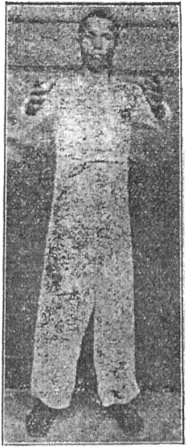
第三式
Posture 3
1,名稱……坐盤抱極式。此式前虛後實之步法。全身重點皆在左足。兩手手心上下相對。如抱圓形之太極狀。故名為坐盤抱極式。
Name: SIT & TWIST, HOLDING A TAIJI SPHERE
In this posture, the footwork is front foot emptying, rear foot filling, the weight of your whole body going onto your left foot. Your palms are facing each other as though you are holding a taiji sphere, thus the name.
2,練法……承上式。身向右旋轉。右手隨身轉去與肩平。肘彎如月形。手心向下。掌距離胸部約八寸許。同時左手由下轉來。手心朝上。與上之右手心相對。成為陰陽之勢。右足轉時足尖須正。兩手如捧球。左膝在後如屈坐之像。右膝在前。須作斜直之勢。身胸俱直。不可前俯後仰。惟小腹之部位。仍如凹形。方能聚氣也。
Practice method:
Continuing from the previous posture, your body turns to the right, your right arm going along with the turn, elbow bent like a crescent moon, palm downward about eight inches from your chest. At the same time, your left hand turns inward from below to be palm up, facing the right palm above, making a yin/yang shape, as if your hands are holding a ball. Once your right foot has turned, it must be pointed straight, your left knee behind appears to crouch, and your right knee in front must be diagonally vertical. Your chest is upright and must not be leaning forward or back, but your belly seems to hollow, and thus you will be able to gather energy.
3,功用……以功言。則能鍛鍊腎部。助之發育平均。使之堅强無敵。以用言。人須千鈞力以對我。我則只以最微之力。亦足以應付。蓋如球之無端。一經粘。便已滑去也。
Effects:
In terms of its results, it can strengthen your kidneys and help nourish balance within them, making you tough and invincible. In terms of its function, an opponent will surely use a great force to attack me, but I will then use only the slightest force and it will be sufficient to deal with it. It is like the edgelessness of a ball, for once contact is made, he easily slips off.
4,用法……例如敵人用拳向我胸部打來。我以雙手合拳捧敵人之拳。使其向外去。不能打到我身也。
Application:
If an opponent punches toward my chest, I use both hands to connect with it and carry his fist, sending it outward and unable to strike my body.
5,姿勢……如第三式第三圖是也。
For this posture, see photo 3:
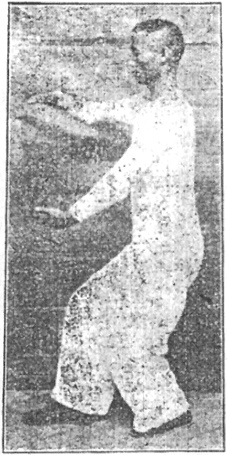
第四式之(一)
Posture 4 (part 1)
1,名稱……攬雀尾。攬雀尾者。猶言一雀上飛。我即起而攬其尾。意即敵人攻我。我即攬其拳也。此式內包有掤。捋。擠。按。四字。為太極拳最切要之妙訣也。
Name: CATCH THE SPARROW BY THE TAIL
The idea is that a bird is taking flight and I then lift up to catch it at its tail. The intention is that when an opponent attacks me, I then catch his fist. This posture contains the four techniques of ward-off, rollback, press, and push, which are the most important elements in Taiji Boxing.
2,練法……承上式。左足收回。足尖靠緊右足。然後左足向左前方伸開一步。左手橫開。右手縮囘。向後徐拉之意。手心朝下。左手高度與肩平。虎口向上。雙目注視左手虎口。兩足成弓步。腰宜伸直。
Practice method:
Continuing from the previous posture, your left foot withdraws so the toes are close to your right foot, then takes a step to the forward left as your left hand spreads away horizontally, your right hand withdrawing to the rear with an intention of slowly pulling, palm down. Your left hand is at shoulder level, tiger’s mouth up, your gaze toward the tiger’s mouth. Your legs are making a bow stance. Your waist should be straight.
3,功用……以功言。週身各部發育平均。故能壯其筋骨。與增長內勁。以用言。若得傳授之眞。知其底蘊。一遇敵人脫彈吾即應手而出。反之則如撼大樹。學者其勉力而行之。庶幾近矣。
Effects:
As for its result, every part of your body is developed in a balanced way, therefore it can strengthen your physique and increase internal power. As for its function, If I have obtained the authentic teachings and understand in detail, then when an opponent suddenly attacks me, my response will send him away, but otherwise it would be like trying to shake a great tree. If you work hard in your practice, you will be almost there.
4,用法……掤者。如敵人用右手打來。我即以右手接其手腕。同時上左弓步。以左手掤敵人之脇部。
Application of ward-off:
If an opponent uses his right hand to strike at me, I then use my right hand to connect to his wrist while stepping forward into a left bow stance, and use my left hand in a ward-off to his ribs.
5,姿勢……如第四式第四圖是也。
For this posture, see photo 4:

第四式之(二)
Posture 4 (part 2)
1,名稱……攬雀尾(同上)
Name: CATCH THE SPARROW BY THE TAIL (same as above)
2,練法……承上式。右手反轉手心向天。由腰際而上。再經左肘外邊。往右方掤出。右足收後亦同回時往右前方伸出。成右弓步。左手徐向後拉之意。手心向下。雙目注視右手虎口處。
Practice method:
Continuing from the previous posture, your right hand turns over so the palm is upward and goes upward from your waist, passing the outside of your left elbow, and warding off outward to the right. Your right foot at the same time withdraws and then extends to the forward right, making a right bow stance, your left hand going to the rear with an intention of slowly pulling, palm down. Your gaze is to your right tiger’s mouth.
3,功用……見第四式攬雀尾(一)
Effects:
See part 1.
4,用法……若敵再以右手挾住我手。幷退右步又以左手向我胸部打來。我則身一蹲。撤囘右手。再以左手握敵之左手。進右弓步。以右手掤敵之脇部。並可因其來勢。使其向前傾跌也。
Application:
If the opponent then uses his right hand to grab my hand, and while retreating his right foot he uses his left hand to attack my chest, I then squat my body, withdrawing my right hand, using my left hand to grab his left hand, advance into a right bow stance, and use my right hand in a ward-off to his ribs. Due to his attacking momentum, this can cause him to lean forward and stumble away.
5,姿勢……如第四式之二第五圖是也。
For this posture, see photo 5:
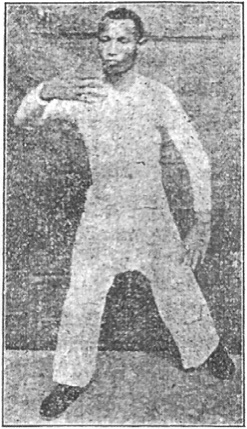
第四式之(三)
Posture 4 (part 3)
1,名稱……攬雀尾(同上)
Name: CATCH THE SPARROW BY THE TAIL (same as above)
2,練法……承上式。右手同時向外翻。左手前迎。約距尺許。復半身形。手隨身往後下。坐實左腿。兩手手心向外。再後左手手心向上。右手手心向下。一陰一陽。徐徐收囘。兩肘要墜。兩肩要鬆開。腰要塌勁。兩眼看右手。此即是捋。
Practice method:
Continuing from the previous posture, your right hand turns outward, your left hand coming forward, until they are about a foot from each other at half body width. Your hands then go along with your body, which goes downward to the rear and sits on your left leg, and both palms turn from facing outward to now be left palm upward, right palm downward, one passive and one active, slowly withdrawing. Your elbows should sink, your shoulders should loosen, and your waist should have a sinking energy. Your gaze is to your right hand. This is the rollback technique.
3,功用……見第四式攬雀尾(一)
Effects:
See part 1.
4,用法……捋者若敵人用拳向胸部打來。我卽涵胸雙手拖下。撤回右手。再以左手接敵人之手。跨上弓步式。以右手掤敵人之脇部。若敵人餘威未殺。再用拳向我胸部打來。我則涵胸雙手接敵人之手。順其勢向外一拉。使敵之巨力反往外回去。無所用其力。左右均同。
Application of rollback:
After the opponent used his fist to attack my chest, I then hollowed my chest and pulled down with both hands, withdrawing my right hand and using my left hand to connect to his hand, stepping forward into a bow stance and using my right hand to do a ward-off to his ribs. If his aggression is not yet spent and he again punches to my chest, I then hollow my chest and use both hands to connect to his hand, following his momentum outward with a pull, causing his great force to be overturned and sent outward, without using any force of my own. The application would be the same on either side.
5,姿勢……如第四式之三第六圖是也。
For this posture, see photo 6 [which shows the palms-outward moment at the beginning of the rollback instead of the completed rollback]:
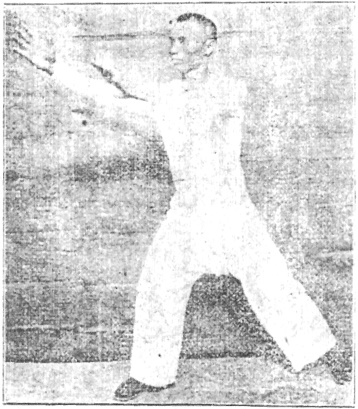
第四式之(四)
Posture 4 (part 4)
1,名稱……攬雀尾(同上)
Name: CATCH THE SPARROW BY THE TAIL (same as above)
2,練法……承上式。右手隨動手指朝上向內。左手隨動。手心亦隨之向下向外。左手手心。距離右手脉門約二寸許。雙手同時向西面擠出。腰必隨之前進。右腿變實。左腿變虛。两手高度與肩平。兩眼隨手之方向平視。此卽是擠法。
Practice method:
Continuing from the previous posture, your right hand then turns to be thumb upward, palm inward, your left hand going along with the movement, palm correspondingly turning downward and outward, and with the palm about two inches from your right pulse area, both hands press in unison to the west. Your waist must advance with the movement. Your right leg becomes full, left leg empty. Your hands are at shoulder level. Your gaze follows the direction of your hands, looking level. This is the press technique.
3,功用……見第四式攬雀尾(一)此式練推擠。但往外推擠時。須腰脊心意隨動。兩手始能擠出推開。如由懷中推出重之物然。極
Effects:
See part 1. Additionally, this movement trains the pressing push. But when pressing outward, your lower back and your mind must go along with the movement. During the beginning of ability in this technique, it will be like pushing away something very heavy from in front of your chest.
4,用法……擠者如敵人接住我手之肘部。我即以手扶肘。用力順勢向外擠去。或捋住敵人臂腕。敵進我仍捋。敵退我擠而出之。左右均同。
Application of press:
If the opponent connects to my elbow area, I then use my other hand to assist my elbow and seize the opportunity to forcefully press outward. Or if he advances while I am rolling back his arm, I roll back further, and then once he retreats, I press and send him away. The application would be the same on either side.
5,姿勢……如第四式之四。第七圖是也。
For this posture, see photo 7:
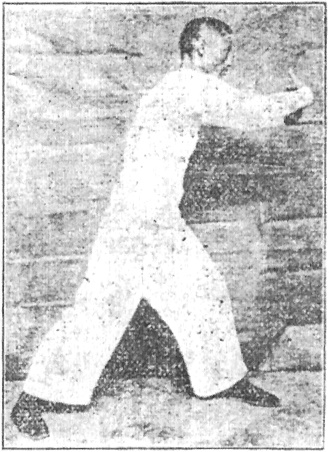
第四式之(五)
Posture 4 (part 5)
1,名稱……攬雀尾(同上)
Name: CATCH THE SPARROW BY THE TAIL (same as above)
2,練法……承上式。兩手往囘擠出時。迨至極處。左手抹右背。徐徐兩手離開寬仍與肩平齊。兩肩同時鬆開。不可有絲毫拙力在內。眼向前平視。兩手手心向地。兩足成弓箭步。
Practice method:
Continuing from the previous posture, when your hands have pressed out to their limit, your left hand wipes the back of your right hand as they slowly separate to shoulder width. Your shoulders at the same time loosen and there must not be the slightest bit of awkward effort within. Your gaze is forward and level. Both palms are facing the ground. Your feet are in a bow and arrow stance.
3,功用……見第四式攬雀尾(一)
Effects:
See part 1.
4,用法……挒者之一字。向未示人。蓋只知有掤。捋。擠。按。而不知四字之中。尚有一挒字之用法。假如敵人以兩手封閉我之兩手。是敵手甫接我肘。卽以兩手乘時分開。此時之兩掌。須揚起手指平向。手心下向。預備封敵人之手。並可藉勢還擊。敵雖欲躱避。亦已不及也。
Application of the rending technique:
Unnoticed by people who are only aware of the four techniques of ward-off, rollback, press, and push within Posture 4, there is also the rending technique. If the opponent uses both hands to seal off both of my hands by catching my elbows, I take advantage of the moment by spreading my hands apart. At this time, both palms must lift so the fingers are level, palms downward. In preparing to seal off the opponent’s hands, I can take advantage of the opportunity and return a strike. Even if he wants to escape, he will not be able to.
5,姿勢……如第四式之五第八圖是也。
For this posture, see photo 8:
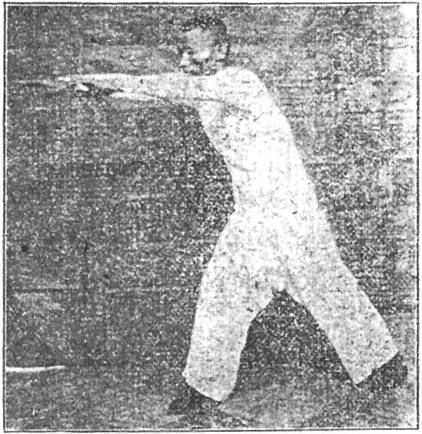
第四式之(六)
Posture 4 (part 6)
1,名稱……「攬雀尾」(同上)
Name: CATCH THE SPARROW BY THE TAIL (same as above)
2,練法……承上式。身與腰。均往囘向後坐。雙手亦隨之往囘縮。縮至兩肩前稍停。手心向前。右脚脚踵靠地。不停式。两手往前方推出。兩足不動。仍成為右弓左箭步。當兩手推至極點時。有由上往下按之意。約二三寸按至與肩平為度。惟按時只以心意下按。勿强用力。仍須鬆肩墜肘。身有下沉。兩眼向前平視。
Practice method:
Continuing from the previous posture, your body sits back, your hands shrink back, stopping in front of your shoulders, palms forward, and your right foot has its heel touching down. The posture does not pause there. Your hands push out forward, and your feet, staying where they are, again make a stance of right bow and left arrow. When the push has reached its limit, there is an intention of pushing down from above, pushing down for about two or three inches until at shoulder level. When pushing down, you must only use intention, not forceful effort. Again you must be loosening your shoulders and dropping your elbows, and your body sinks down. Your gaze is forward and level.
3,功用……按勁能令氣貫丹田。若遇敵時。擠出敵人乘勢按之。按時尤須沉着堅實。不可輕浮。總要心中發勁。貫於手掌甲梢。
Effects:
The energy of pushing down can lead energy to your elixir field. When pressing outward toward the opponent, take advantage of the opportunity and push downward. When pushing down, you must be focused and solid rather than light and floating. You should always use your mind to express power, coursing it through to your palms and fingertips.
4,用法……按者即敵人兩手擠我之時。我雙手往下沉一按。則敵自跌矣。
Application of push:
When the opponent’s hands press mine, I sink both hands into a push, causing him to naturally stumble away.
5,姿勢……如第四式之六。第九圖是也。
For [the first half of] this posture, see photo 9 [and look ahead to photo 28 for the second half]:

第四式之(七)
Posture 4 (part 7)
1,名稱……「攬雀尾」(同上)
Name: CATCH THE SPARROW BY THE TAIL (same as above)
2,練法……承上式。兩手推到極點後。自右向左橫攬。行動之時。以腰脊之力量。領着手動。左手在前。右手在後。左手曲於胸前。手心向外。右臂斜直。手虎口朝上。迨至身體研囘正前面。右手伸平。左手微低。成弓步。腰手同時而動。並非手先動或腰先動。否則身法丢帶也。
Practice method:
Continuing from the previous posture, when the push has reached its limit, your hands pull across to the left. During the movement, use the strength of your lower back to lead the movement of your hands. Your right hand is in front, left hand behind. Your left arm is bent in front of your chest, palm outward, right arm straightened at an angle, tiger’s mouth upward. Once your body has turned to be squared with the starting posture, your right hand is extended level, left hand slightly lower. You are making a bow stance. Your waist and hands move in unison, not your hands first or waist first, otherwise the body standards will have been discarded.
3,功用……此式能活動全身。堅實體腹腰肩各部。
Effects:
This posture can enliven your whole body and bring robustness to your belly, waist, and shoulders.
4,用法……若遇敵人之時。得機自右向左。攬其臂肘。而於推之。或往後摕。及斜推之着法也。
Application:
If the opponent moves across from right to left, I grasp his arm by the elbow and push him, or I pull him to the rear and use the technique of pushing him diagonally.
5,姿勢……如第四式之七第十圖是也。
For this posture, see photo 10:

第五式
Posture 5
1,名稱……「單鞭」。此式之動作。一掌向前伸出。一手鈎形在後。猶如挑夫之担物扁担。橫置肩上之狀。故名。或言如單手擊敵之意。此鞭指鞭法而言也。
Name: SINGLE ROD
In this posture’s movement, one palm extends forward and the other hand makes a hook shape to the rear. It is like a porter carrying objects with a yoke placed across his shoulders, thus the name. [The word 鞭 covers both soft “whips” and hard “whips”. In English, we would deem a “soft whip” to be a “whip” while a “hard whip” would be considered to be more along the lines of a “rod”. A soft whip explanation could be used to explain the movement, but the hard whip explanation describes the final posture, either with both arms nearly forming a single line like a rod or with the image of a shouldered pole being grasped from underneath by the front hand while the rear hand wraps lazily over the top of the pole behind.] It is also said the meaning is that it is like a single hand striking the opponent. [In this case it would be translated as “whip”. It is thoughtful of Gu to supply this whip explanation along with the rod explanation, but since he seems to emphasize the rod explanation, it is appropriate for us to translate the term as “rod” in his case.] These are the intentions and methods of whip/rod.
2,練法……承上式。左足收囘。足尖靠緊右足心。然後又向外伸出。同左手向左往下兜囘。由丹田而上。經右肩前至面部之前而過。五指鬆開。手心向內彎。出右足向西者。足跟轉動。使足尖向南。全身重點。坐在右腿上。此時右足亦同時向東慢慢伸去。足尖畧偏於西。此時右足跟亦同時轉動足尖。畧向東南。全身坐實右腿。左手隨動轉變成朝外往東伸展。乃成單鞭形式。當左手放出。須以丹田腰脊力。向前擰翻而進。尤要腰手齊到。不可先後參差。如第十二圖。左步如弓式矣。
Practice method:
Continuing from the previous posture, your left foot withdraws, the toes closing inward toward your right sole, then once more extends outward. At the same time, your left hand goes to the left, downward, wraps in, [as in the first photo below,] goes upward from your elixir field, passing in front of your right shoulder and face, all the fingers loosely spread, palm bent inward. Your right foot was pointing to the west, and has turned on the heel to make the toes point south. The weight of your whole body is sitting on your right leg. Your right [left] foot now slowly extends to the east, toes slightly inclined to the west [southeast]. Your right heel now turns the toes slightly to the southeast, and the weight is on your right [left] leg. Your left hand goes along with the movement by turning outward and extending to the east to make the SINGLE ROD posture. To express power with your left hand, you must use your elixir field and the strength of your waist and back to twist the hand around and send it forward. It is particularly important for your waist and hand to arrive in unison, for they must not be acting unevenly with one before the other. See the second photo below, with the left leg in a bow stance.
3,功用……此式外剛內柔。有淸潤肺氣。暢利呼吸之功。按肺為華蓋。若得淸潤之法。不為濁枯所攻。其精神之充足。可以斷言。故外剛足以强身。而內柔亦所以養氣也。
Effects:
This posture is outwardly hard and inwardly soft. It has the effects of clearing and lubricating the lung energy, freeing up your breath. The lungs are the key to it all [the “imperial canopy”]. If you obtain a means of keeping them clear and moist, there will be no unhealthy blockage or dryness and your spirit will be abundant. And so it can be said therefore that external hardness is enough to strengthen the body, but internal softness is what will nurture the energy.
4,用法……例如敵人雙拳打來。吾以右手勾住敵人左手。順勢往裡往外一格。趁勢還以掌擊攻其肩部。如敵人再欲起腿。則吾又側身以避之。進可攻。退能守。法極活潑。虛虛實實之時。若無深造功夫。烏能售世。願世之學者。曷其勉諸。
Application:
If an opponent attacks me with both fists, I use my right hand to hook his left hand and then go outward from inside to block it away, then take advantage of the opportunity by counterattacking with a palm strike to his shoulder. Or he wishes to kick, I will turn my body away to evade it. Advancing, I can attack. Retreating, I can defend. The technique is very lively, mixing emptiness and fullness. If you do not go deeply into it and work hard, how can you offer it to others? I hope that all who study will make an effort.
5,姿勢……如第五式第十一圖為過度式。第十二圖為單鞭之正式。
For this posture, see photos 11 & 12:


第六式
Posture 6
1,名稱……「提手」提手者。卽兩手往上提勁。若提重物之意。與提携不同也。
Name: RAISE THE HANDS
Your hands raise up as though they are lifting something heavy, but not necessarily to carry it.
2,練法……承上式。左足跟轉向南方左右兩手。同時向前伸出。兩掌離八寸許。遙遙相合。隨腰轉向西南。左手畧前。右手畧後。約離三寸許之斜形。手心須相對。鬆肩墜肘。卽鬆開順其自然之性。不可强用蠻力。反失本旨。右手須於同時動作中。提向西南方。足跟虛點於地。眼神亦隨之以往。左腿坐實。右腿虛立。尤應注意者。為頭宜頂勁。項要竪勁。兩臂與腰腿脊骨。均要有伸縮力。丹田亦要吸勁。夫如是。然後始能得着此中妙處也。
Practice method:
Continuing from the previous posture, your left heel turns to point the foot to the south, your hands at the same time extending forward, palms about eight inches away from each other, going along with your waist’s movement of turning to the southwest, left hand slightly more forward than the right by about three inches, the palms facing each other. Sink your shoulders and drop your elbows to loosen and settle in a natural manner. You must not use excessive force or you will fail in your purpose. Your right hand [foot] must during the movement lift to the southwest, gently touching down with the heel. Your gaze follows the direction of the movement. Your left leg sits full and your right leg stands empty. Things you should pay particular attention to are: your head should press up, your neck should be straight, your arms, waist, legs, and spine should all be flexible, and your elixir field should have an energy of drawing back. If you do it in this way, then you will be on your way to obtaining the subtleties within it.
3,功用……此式為外似柔。而內則剛。有靜止不亂之容。若言用。則必分淸虛實。須有旋轉格鬥之巧。左右逢源之奇。自然措置裕如。不虞失敗也。
Effects:
This posture is outwardly soft and inwardly hard. Within it lies stillness stabilizing chaos. As for its function, you must distinguish between empty and full, and you must have the skill of rotating to fend off the opponent. You will thereby possess the skill of doing as you please, naturally managing everything without effort, and will have no worry of failing.
4,用法……例如敵人以雙拳。或單拳由上部打來。吾以雙手。或單手向上迎架。使其拳不能落下。若敵人再以腿踢下陰。吾卽往後一退。一脚半下。彼雖踢來。亦屬落空。無濟於事。而我又可反借其力。乘勢封其手。反推使出。則敵力盡失。而我反佔優勢矣。舉一反三。學者當能領悟焉。
Application:
If an opponent uses both fists or a single fist striking from above, I use both hands, or a single hand, to prop up and prevent his fist [or fists] from coming down. If he also uses his leg to kick to my groin, I retreat a half step, leaving his kick to land on nothing and have no effect, while I can borrow his force and take advantage of the opportunity to seal off his hand and then return a push to send him away. I thereby exhaust his force and reverse the situation to occupy the superior position. From the first action, the rest will fall into place, and so it ought to be intuitive for you.
5,姿勢……如第六式第十三圖是也。
For this posture, see photo 13:
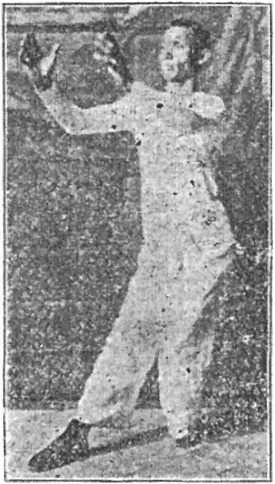
第七式
Posture 7
1,名稱……「白鶴亮翅」此式之動作。如鳥之斜伸雙翅式。两臂張開。右足坐實。左足為虛。亦如鶴之獨立狀。右手斜伸。左手下按。又如白鶴之展翅。故得是名。
Name: WHITE CRANE SHOWS ITS WINGS
This posture’s movement is like a bird diagonally stretching out its wings, your arms spreading apart. Your right foot sits full and your left foot is empty, in the manner of a bird standing on one leg. Your right hand extends diagonally as your left hand pushes down. It is like a white crane unfurling its wings, thus the name.
2,練法……承上式。左足稍向後提進半步。脚踏實地。連接轉向東南方向。全身坐在右腿上。兩手與腰。同時而轉。右手轉下。手心向前。左手轉上。手心朝下。兩手斜對。如抱圓球。隨即分開。右手向裡。徐徐提起。同時左手在外。緩緩放下。左手手心俱已向下。此式須含有輕靈之意。方合姿勢。身手旣平整。動作自雅觀。由 呆而活。當能純熟。
Practice method:
Continuing from the previous posture, your left [right] foot slightly lifts to the rear then advances a half step and flattens out, pivoting to point to the southeast, and your whole body sits onto your right leg. Your hands arc along with your waist, right hand arcing downward, palm forward, left hand arcing upward, palm downward, the two hands diagonally facing each other as if holding a ball. Then they spread apart, right hand on the inside and slowly lifting, left hand on the outside and slowly lowering, left palm downward throughout [but finishing by facing to the rear, going by the photo]. This posture must contain an intention of lightness, and then you are conforming to the [name of the] posture. Your body and hands are orderly, and then the movement is elegant. Go from stiffness to liveliness, and then you will be able to be skillful.
3,功用……此式外剛內柔。中心空虛。氣歛神聚。上下和緩。無所阻滯。以之應敵。則有按點。斫之法。且能運動右腿。與腰部及兩臂之力。能使人身體靈活。腰腿强健。舒展胸肺。而丹由之勁。始終含抱。
Effects:
This posture is outwardly hard and inwardly soft. With emptiness in the center, energy is gathered and spirit is concentrated. With mildness above and below, there is no stagnation anywhere. For responding to an opponent, there is then a point of stability for this technique of chopping away. It can also exercise your right leg, as well as the ability of your waist and arms, can make your body nimble, strengthen your hips, open up your chest and lungs, and get power to be always contained within your elixir field.
4,用法……如敵人以十字腿打來。我以左手格其右腿。而右手又格其左手。用力一掀。敵必因而傾跌。緣敵人用力過猛。我則以逸待勞。彼術安得不敗。所謂十字腿者。卽以左拳攻人面。右腿踢敵下部者也。
Application:
If an opponent attacks me by kicking while punching with his opposite hand, I use my left hand to block his right leg and my right hand to block his left hand, forcefully lifting it up, and he must as a result lean and stumble away. Because he uses force too aggressively, I “use ease to await his exhaustion” [Art of War, chapter 7]. How then can his technique succeed? What is meant by kicking while the opposite hand is punching is that his left fist attacks my face while his right leg attacks my groin.
5,姿勢……如第七式第十四圖是也。
For this posture, see photo 14:
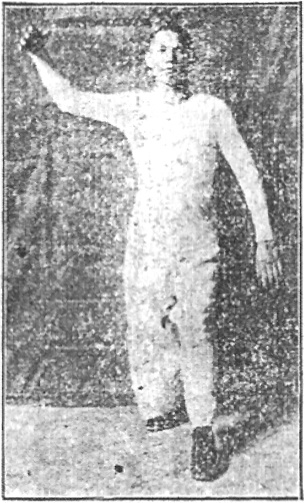
第八式
Posture 8
1,名稱……「摟膝抝步」摟膝者。即以手摟過膝蓋之意也。拗步者。為步法之一種。猶如扭其步之意也。卽左手右足在前。是為扭步。左右同。
(按)左右摟膝步。亦有人名之曰。摟膝拗步。
Name: BRUSH KNEE IN A CROSSED STANCE
To “brush the knee” means to use your hand to brush past your knee. A “crossed stance” is a kind of stance resembling a twisting stance in that your left hand and right foot are forward, or right hand and left foot are forward. There are also people who call it LEFT & RIGHT BRUSH KNEE STANCE.
2,練法……承上式。身向左方扭轉。右手往下按之意。手心向下。左手手心朝上。有往上托之意。與肩平齊。如第十五圖。摟膝拗步。(一)是也。繼則身向右轉。左手在上撥下。右手往上托之意。右手伸直。左手在右肩前。左手陰而右手陽。步法則不扭不動。再次左足收囘。靠緊右足心成虛步。身畧向左轉正面。先開左弓步。左手摟過左膝外。右掌由右耳邊伸出。如擊敵之意。肘不宜過直。如第十六圖是也。
Practice method:
Continuing from the previous posture, your body twists to the left, your right hand pushing down, palm down, as your left hand, palm up, props up to shoulder level. It is like the first photo below. Then your body twists to the right, your left palm above deflecting downward, your right hand propping upward and extending. Your left hand is in front of your right shoulder. Your left hand is passive and your right hand is active. Your feet twist but stay where they are. Then your left foot withdraws to come close to your right instep, making an empty step. Your body slightly turns to face to the left, first stepping into a left bow stance, your left hand brushes to the outside of your left knee, and your right palm extends from beside your right ear as if striking an opponent, but the elbow should not be too straight. It is like the second photo below.
3,功用……此式為運動兩脇。及兩手之推摟二勁。且能舒展雙臂。開暢胸襟。
Effects:
This posture exercises your ribs on both sides, as well as the pushing and brushing energies for both hands, and can stretch both arms and loosen your chest.
4,用法……如敵人從背後用拳打來。我以左手握敵人之拳。另以右手托其肘。可令彼肘脫臼。左右均同樣應付之。若敵人在前面。再用足踢來。我以一手摟其腿。幷以一掌還擊之。則敵之足。旣為我摟開。失其攻勢。鮮有不傾跌者矣。
Application:
If an opponent uses his fist to attack me from behind, I use my left hand to grasp his fist and use my right hand to prop up his elbow, which can cause it to dislocate. The application is the same on either side. If an opponent in front of me then uses his foot to kick, I use my left hand to brush aside his leg and use a palm to return a strike. Once his foot has been brushed aside, he will lose his attacking momentum. It is rare for this not to result in the opponent leaning and stumbling away.
5,姿勢……如第八式。第十五圖(一)。第十六圖(二)。是也。
For this posture, see photos 15 & 16:

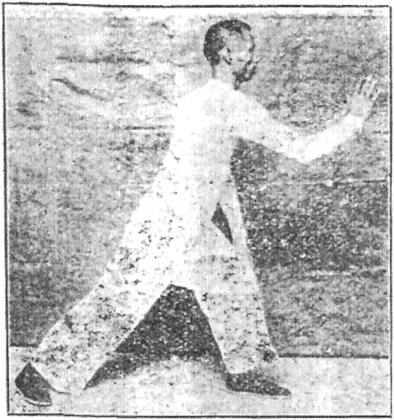
第九式
Posture 9
1,名稱……「手抱琵琶」此式两手。左上右下。前伸後縮。如樂師之抱琵琶狀。手揮搖動。又如手撫弦索。故名手抱琵琶。
Name: HOLDING THE LUTE
In this posture, your hands are left hand above and right hand below, forward hand extended and rear hand withdrawn, in the manner of a musician holding a lute. Your [right] hand waves as if plucking a string, thus the name.
2,練法……承上式。身在原地不動。右足向上畧起。隨落下。右手隨身之落勢。收囘在後。左手隨身提在前。兩手手心相對。如抱琶琶。兩膀鬆開。徐徐捧起。不可有夾勁。全身重點。落於右腿上。兩肘微曲。須有下墜意。雙目向前平視。
Practice method:
Continuing from the previous posture, your torso staying in its original space, your right foot lifts to come down slightly forward, and your right hand goes along with your body’s lowering momentum and withdraws to the rear as your left hand goes along with your body and lifts forward, the palms facing each other as if holding a lute. Your arms loosen and slowly prop up, but must not have a squeezing energy. The weight of your whole body lowers onto your right leg. Both elbows are slightly bent and must have a sinking intention. Your gaze is forward and level.
3,功用……是式乃運用兩手合力與按力。兼能增長兩臂之伸縮力。並以腰脊為軸。手為立樁。
Effects:
This posture exercises the ability of your arms in both closing inward and pushing downward, and can improve the flexibility of your arms, the use of your waist as a pivot, and the standing up of your hands.
4,用法……例如敵人向我胸前打一拳。我以右手握其拳。左手托其肘。或乘勢一摔。使向側面傾撲而出。
Application:
If the opponent punches toward my chest, I use my right hand to grasp his fist and my left hand to prop up his elbow. Or I take advantage of the momentum to throw him by causing him to lean to the side and fall away.
5,姿勢……如第九式第十七圖是也。
For this posture, see photo 17:
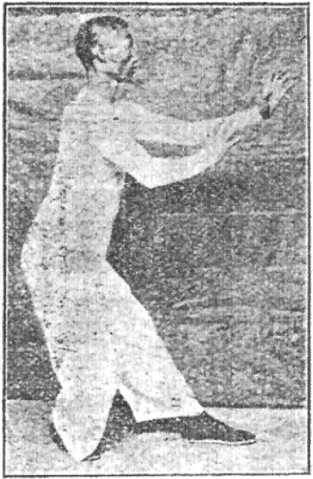
第十式
Posture 10
1,名稱……「左摟膝拗步」此式與第十六圖同。所差者惟多一扭步。但此式為左足在前。用左手摟過左膝。故名左摟膝拗步。
Name: LEFT BRUSH KNEE IN A CROSSED STANCE
This posture is the same as in photo 16, except with only one twisting stance. In this posture, step forward with your left foot and use your left hand to brush past your left knee, thus the name.
2,練法……承上式。身向右轉。右手往下撥上伸直。成平線。左手由面部撥至右肩部。右手陽。左手陰。左足收囘。靠緊右足心。再次身向左微轉。左足向左伸開一步。成左弓式。左手往下摟至左足膝外。右掌由面部撥向左方伸直。卽以右掌擊人也。
Practice method:
Continuing from the previous posture, your body twists to the right, your right hand deflects downward and extends upward, making a horizontal line, and your left hand deflects from your face to your right shoulder. Your right hand is active and your left hand is passive. Your left foot withdraws to come close to your right instep, making an empty step. Your body turns slightly to the left, your left foot extends a step to the left, making a left bow stance, your left hand brushes downward until to the outside of your left knee, and your right palm extends from your face, deflecting [issuing] to the left with a palm strike to the opponent.
3,功用……參看第八式之功用條。
Effects:
See the explanation in Posture 8.
4,用法……若敵人在前面。用足踢來。我則以左手摟開其足。然後又以右掌還擊之。
Application:
If the opponent in front of me uses his foot to kick, I then use my left hand to brush aside his foot and then also use my right palm to return a strike.
5,姿勢……如第十式第十八圖是也。
For this posture, see photo 18:

第十一式
Posture 11
1,名稱……「右摟膝拗步」此式與前式所差者。惟多一扭步與多第十五圖(一)式耳。緣此式為右腿在前。而以右手摟過右膝。故名之為右摟膝步。
Name: RIGHT BRUSH KNEE IN A CROSSED STANCE
This posture is different from the previous posture in that the twisting stance is like in photo 15. In this posture, step your right leg forward and use your right hand to brush past your right knee, thus the name.
2,練法……承上式。右足上前。左足跟轉動。使足尖向東北。右足尖緊靠左足心。身向左轉。右手由面部撥過左方。掌靠左肩。左手提上至肩部伸直。左手陽。右手陰。再次則身向右轉。右足伸前一步。成右弓步。右手往下摟撥至右膝外。左掌則由肩部推出。不可太直。須微有曲肘下墜之意。
Practice method:
Continuing from the previous posture, your right foot steps forward, your left heel turning so the toes point to the northeast, your right toes coming close to your left instep, your body twisting to the left, your right hand deflecting downward to the left from your face, the palm getting close to your left shoulder, and your left hand lifts up until at shoulder level, extending straight. Your left hand is active and your right hand is passive. Then your body turns to the right, your right foot extends a step forward, making a right bow stance, your right hand brushes downward until to the outside of your right knee, and your left palm pushes out from the shoulder, but must not be too straight and must have a bend in the elbow, which has an intention of hanging down.
3,功用……詳見第八式之功用條。
Effects:
See the explanation in Posture 8.
4,用法……詳見第十式之用法條。
Application:
See the explanation in Posture 10.
5,姿勢……如第十一式第十九圖是也
For this posture, see photo 19:

第十二式
Posture 12
左摟膝抝步……詳見第十式。一切相同。
LEFT BRUSH KNEE IN A CROSSED STANCE – Same as Posture 10.
第十三式
Posture 13
手抱琵琶……詳見第九式。一切相同。
HOLDING THE LUTE – Same as Posture 9.
第十四式
Posture 14
1,名稱……「扭步抱極」此式曲膝扭步。兩手手心上下相對。如抱圓球形之太極式。故名。
Name: TWISTING STANCE, HOLDING A TAIJI SPHERE
In this posture, the knee bends into a twisting stance and your palms face each other as though holding a taiji sphere, thus the name.
2,練法……承上式。身向左轉移。兩足在原地。作扭步式。左手在上。手心朝下。右手在下。手心向上。如抱太極圖狀。左足在前。右步在後。身向下微坐。身須挺直。氣沉丹田。
Practice method:
Continuing from the previous posture, your torso turns to the left, your feet staying where they are and making a twisting stance. Your left hand is above, palm down, right hand below, palm up, as if holding the taiji symbol. Your left foot is in front, right foot behind, and your body slightly sits. Your body must be straight, energy sinking to your elixir field.
3,功用……此式乃運動腰部之力。如球之圓。旋轉不定。人一挨我。卽向外滑去。而不能傷我皮毛也。
Effects:
This posture exercises your waist’s ability to be like a round ball spinning indefinitely. When an opponent gets near me, he promptly slips off outward and is unable to harm me in the least.
4,用法……若敵人一拳打我肩部。我即一坐盤。如右便打來。則坐右邊閃去。左邊打來。則坐左邊閃去。使其力向外。不能及已。同時即以雙手合捧敵人之拳。使不得脫。幷以肘還擊之。即雙手如抱太極圖之形狀也。
Application:
If an opponent punches toward my shoulder, I promptly sit and twist (If he was striking to my right, I would evade on my right side, and if he strikes to my left, I will evade on my left side.), causing his energy to go outward and unable to reach me. At the same time, my hands come together to carry his fist, causing him to be unable to escape, and I use my elbow to return a strike. Both hands are like they are holding the taiji symbol.
5,姿勢……如第十四式。第二十圖是也。
For this posture, see photo 20:
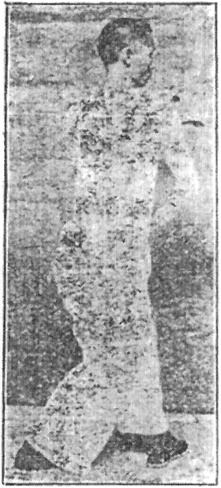
第十五式
Posture 15
1,名稱……「上步搬攔捶」搬攔捶。為太極拳五捶之一也。搬者。搬易位置之謂也。攔者。卽遮攔之意也。蓋即謂一進步。便搬翻與遮攔也。
Name: STEP FORWARD, PARRYING-BLOCK PUNCH
This is one of the five punches in Taiji Boxing. To parry means to change the position. To block means to impede. Advancing makes easier the act of parrying and blocking.
2,練法……承上式。腰隨即向右轉。右步同時上前成弓式。右手翻而手心朝上。隨着腰轉時。直向正前方摔出。不可用力。拳心朝上。再抽囘。停於右腰旁邊。當右手抽囘時。左手往正前面探出。按在右手手拗處。徐徐伸去。要有按勁。鬆肩墜肘。丹田要抱。心意要整。而眼平視正前方。
Practice method:
Continuing from the previous posture, your waist then turns to the right as your right foot steps forward to make a bow stance, and your right hand turns over so the palm is up, thrown out forward as your waist turns, but must not do so with effort, then pulls back with the center of the fist upward, stopping at the right side of your waist. As your right hand withdraws, your left hand reaches out forward. When your right hand twists over, slowly extending, it should have an energy of pressing down. Loosen your shoulders and sink your elbows. Your elixir field should contain power and your mind should be orderly. Your gaze is straight ahead.
3,功用……此式最能活潑週身筋絡。俾氣血通暢。無所阻滯。則精力之日充。身幹之靈便。可斷言也。幷能變化敵人之攻勢。搬開敵人之襲擊。用之得法。頭頭是道。然切不可探身。授人以隙也。
Effects:
This is the best posture for enlivening the muscles of your whole body so that the energy and blood will flow unobstructed. When there is no stagnation, the energy is sufficient every day, and your body’s nimbleness can be assured. It also can neutralize an opponent’s attack or parry aside his sudden strike. Apply it smoothly and thoughtfully, but be sure not to lean forward or you will give the opponent something to exploit.
4,用法……例如敵人一拳。向我胸部打來。則用右手搬壓之。再進左步。連用左掌封閉敵手。使不克逞。搬欄進擊。尤為玄妙之用法也。
Application:
If the opponent punches toward my chest, I use my right hand to parry and press it down, then advance with my left [right] foot, continuing by using my left palm to seal off his arm, causing him to be unable to do anything. This technique is especially subtle.
5,姿勢……如第十五式。第二十一圖是也。
For this posture, see photo 21:
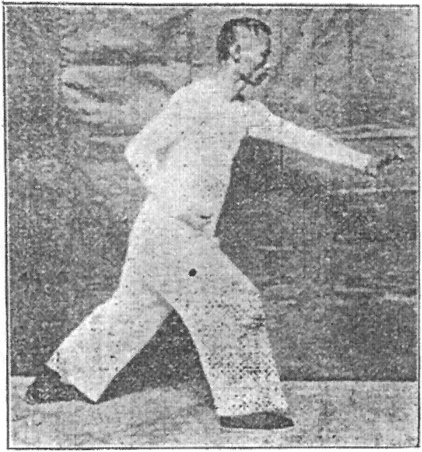
第十六式
Posture 16
1,名稱……「進步指襠捶」是式亦為太極拳中五捶之一也。而此式之右捶。直指攻敵人下陰襠之謂也。然須與上式一氣連貫。敎授時期。不可間斷。
Name: ADVANCE, PUNCH TO THE CROTCH
This is one of the five punches in Taiji Boxing. In this posture, your right fist makes a direct attack to the opponent’s groin. But it must be connected with the previous posture as a single flow, and when teaching the two postures, they cannot be separated.
2,練法……承上式。再上左弓步。卽左腿曲膝。右腿伸直。切不可用拙力硬蹬勁。須要腰部塌勁。兩足距離約二尺七寸許。同時右拳。連接打出。總要緩緩而伸出。用心意的力量。左掌在右臂之上方。向身捩囘。左手之掌。須有立樁。順着右胳膊抺囘來。至右肩前為度。右拳虎口向上。眼向前視。
Practice method:
Continuing from the previous posture, your left foot then steps forward to make a bow stance, the knee bending, and as your right leg straightens, be sure there is no use of clumsy effort or a stiff pressing energy. Your waist must have a sinking energy. Your feet are about two and two-thirds feet apart. At the same time, your right fist strikes, extending slowly, using the strength of intention. Your left palm is above your right arm, withdrawing toward your body, and the palm must be upright, wiping along your right arm until in front of the shoulder. The tiger’s mouth of your right fist is up. Your gaze is forward.
3,功用……此式練之旣純熟。則弱者轉而為强。柔者轉而為剛。誠非欺語。
Effects:
Practice this posture until you are skillful at it, and then weakness will have become strength and softness will have become hardness. These are indeed not exaggerations.
4,用法……例如敵人右拳打來。我卽以左手撇去敵人之手。連接上右步。以右拳向敵人下陰打去。敵為本身利害計。當急避之不暇。焉有餘力以再抗抵我哉。
Application:
If the opponent attacks me with a right punch, I promptly use my left hand to fling away his hand, stepping my right foot forward, and use my right fist to strike to his groin. Such a threat to his body should make him too busy panicking to have any energy leftover with which to attack me further.
5,姿勢……如第十六式第二十二圖。是也。
For this posture, see photo 22:
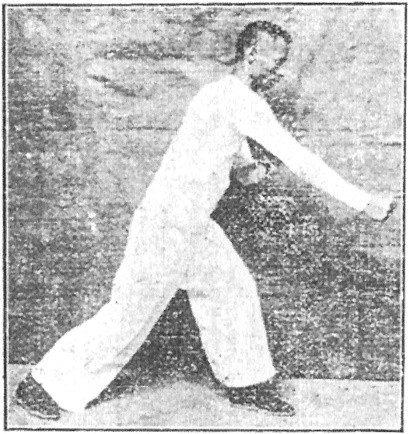
第十七式
Posture 17
1,名稱……「如封似閉」如封似閉者。卽封鎖格閑敵人之謂也。或謂右手後撤。左手橫攔。謂之封。雙手前推。謂之閉。此式動作。因像其形。故得此名。
Name: SEALING SHUT
The meaning is to seal off and lock up the opponent. Or it is said that your right hand withdrawing and your left hand blocking to the side constitutes sealing, and then the forward push with both hands constitutes shutting. The appearance of this posture’s movement is what gives it its name.
2,練法……承上式。左手穿右腋下。手心向上。順着右肘。直向前橫出。同時右拳變掌。由左手上方。向己懷中撤囘。縮至胸部之前。兩手掌心供向外。同時又坐實右腿。微往後退之意。如第二十三圖(一)是也。繼則雙掌齊向前推出。同時左腿曲膝。變為左弓式。眼向前平視。至兩手距離之寬度。與肩同。不可過寬為要。腰頭 須挺直。如第二十四圖。(二)是也。
Practice method:
Continuing from the previous posture, your left hand threads under your right armpit, palm up, follows straight along your right elbow, and comes out forward and across. At the same time, your right fist becomes a palm and withdraws from over your left hand until in front of your chest, both palms outward. At the same time, sit onto your right leg, making it full, with an intention of slightly retreating. It is like the first photo below. Then your hands push forward in unison. At the same time, your left knee bends, making a left bow stance. Your gaze is forward and level. Your hands are shoulder width apart, but must go no wider. Your waist and head must both be upright. It is like the second photo below.
3,功用……此式有淸氣上升之功。猛虎出洞之勇。練之旣久。兩腿無發軟之病。兼能運動腰胯。伸縮两臂。亦養生之要訣也。
Effects:
This posture has the skill of getting purified energy to rise up and the bravery of a fierce tiger leaving its cave. If you practice it for a long time, your legs will not end up becoming weak. It can also exercise your waist and hips, the flexibility of your arms, and is a tonic for your health.
4,用法……如敵人握吾右手。卽以左手從下挒開。乘勢封閉而按出之。或敵進擊。我右手抽囘。用左手橫攔而破之。若已將敵橫出外門。再乘勢與右手向前齊推之。以擊按敵胸為目的。如(二)圖者。卽此用法也。
Application:
If the opponent grasps my right hand, I use my left hand to rend it aside from below, then take advantage of the opportunity to seal him off and push him out. Or if he advances to strike, my right hand withdraws and I use my left hand to block sideways, knocking away his attack, and upon sending him outward I then take advantage of the opportunity to push forward with both hands. I strike or push with his chest as target, as in the second photo below.
5,姿勢……如第十七式。第二十三圖(一)。及二十四圖(二)是也。
For this posture, see photos 23 & 24:


第十八式
Posture 18
1,名稱……「十字手」十字手者。左右两手臂。裡外相交。如十字形。故名。
Name: CROSSED HANDS
Both arms cross, one on the inside and one on the outside, making an X shape, thus the name.
2,練法……承上式。左足足尖。微向南扭回。如倒八字形。兩手往上分開。向上圈轉而上。然後合如十字形。两手手心向前面。右手在前。左手在後。兩手均有抱勁。左腿扑直。右腿曲膝。两足距離。約二尺七八寸許。眼向右方平視。順項貫頂。不可分散精神。方為合法。
Practice method:
Continuing from the previous posture, your left foot twists in to point its toes slightly south, almost making a ninety-degree angle with your right foot, while your hands go upward and spread apart to the sides, making a circle which goes upward, then joining to make an X shape, palms forward, right hand in front, left hand behind, both hands having an embracing energy. Your left leg has straightened and your right knee is bent. Your feet are about two and two-thirds feet apart. Your gaze is level to the right. Extend your neck and draw up your headtop. You must not scatter your spirit, then you will be doing it right.
3,功用……此式乃運動兩手腕。使其活潑敏捷。兼能調理三焦。與調和中樞。
Effects:
This posture exercises your wrists, making them lively and nimble, and can restore your “triple warmer” to bring harmony to your body’s core [i.e. it can reset your metabolism].
4,用法……例如敵人用拳向頭部打來。我卽雙手交叉。往上迎架。使不得落。我則可以乘隙攻其要害。到此關頭。敵雖欲躱避。亦不可得脫矣。
Application:
If an opponent uses a fist to attack my head, I then cross my hands and put them upward as an intercepting rack, making his attack unable to reach me. I then can take advantage of the opening and attack his vital areas. At this moment, he will not be able to escape even if he wants to.
5,姿勢……如第十八式。第二十五圖。是也。
For this posture, see photo 25:
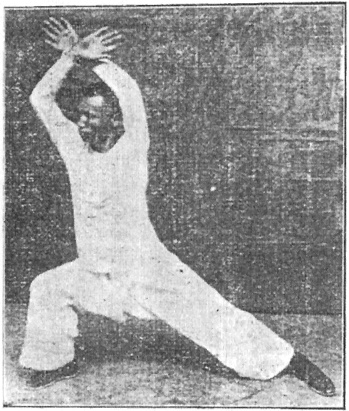
第十九式
Posture 19
1,名稱……「抱虎歸山」此式兩手由上而下。兩手相抱。形如抱虎。假想敵人為虎。我用抱勢而擒之。乘機推之於外門。故名。
Name: CAPTURE THE TIGER TO SEND IT BACK TO ITS MOUNTAIN
In this posture, your hands go down from above, both embracing toward each other, as if embracing a tiger. Imagining the opponent to be a tiger, I use an embracing posture to capture him, then seize the opportunity to push him away, thus the name.
2,練法……承上式。兩手由上而下散開後。再兩手相捧至腹部之前。如抱大圓球狀。同時收囘右足。足尖點地。距離左足心。約尺許。兩手要抱勁。氣沉丹田。身微往下坐。全身重點在左足。兩腿皆曲。不可挺直。眼向右方平視。
Practice method:
Continuing from the previous posture, your hands go down from above, spreading apart, then they both carry in front of your belly, as if holding a large ball. At the same time, your right foot withdraws, toes touching down about a foot from your left instep. Your hands should have an embracing energy. Energy sinks to your elixir field and your body slightly squats down. The weight of your whole body is on your left foot. Your legs are bent, but not so much that they bulge out. Your gaze is level to the right.
3,功用……此式有挾人之勢。拔樹之能。靜而制動之形。且可運動兩肩膀之按下力與捧力。兼得舒暢腰腿筋絡。堅實腰脊。運動臂腕之益。
Effects:
This posture has the dynamic of embracing a person, the capacity of uprooting a tree, and the manner of stillness taking control over movement. It also can exercise the ability of your arms in both pushing down and propping up, as well as loosen your leg muscles, strengthen your lower back, and benefits your arms and wrists.
4,功用……若敵人用掛面脚。向我面部攻來。我卽坐下。以手接其前脚。以一手拾地上沙石等物。向敵人面部撒去。以傷其目。設敵人一拳打來。我卽身往下沉低。以避其勢。隨以右手卽撥其拳。左手抽其腿。使之傾跌。或乘其起脚之時。左手接其腿。右手按其穴。又或乘隙還擊之。無不得當矣。
Effects [Application]:
If the opponent uses a hang-his-face kick to attack my face, I then sit lower, using a hand to connect to his front foot, and using the other hand to pick up some gravel or some other object and throw it in his face to injure his eyes. Or if an opponent attacks me with a punch, I then lower my body to evade it, using my right hand to push aside his fist and my left hand to pull his leg, causing him to lean and stumble away. Or taking advantage of the moment he lifts his leg [to kick], my left hand connects to his leg, and my right hand presses an acupoint [It is not specified which or on what area of the body.] or returns a strike through a gap in his guard, both of which are suitable.
5,姿勢……如第十九式。第二十六圖。是也。
For this posture, see photo 26:
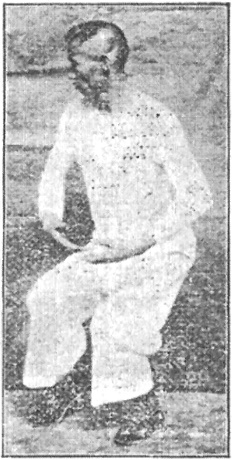
第二十式
Posture 20
1,名稱……「探海迎面掌」此式為一手向地探下。一手迎面打去。因右手形如探海。緣海底不知深淺。故有用手徐徐往下試探之意。故名。
Name: SEARCHING THE SEA, PALM STRIKE TO THE FACE
In this posture, one hand extends downward toward the ground and the other strikes toward the opponent’s face. Your right hand is in the manner of examining the ocean, unaware of its depth, and has an intention of slowly going downward to find out, thus the name.
2,練法……承上式。右腿先往右側方伸出。作扑腿式。左膝徐徐屈曲。右手徐徐沉下。摟過右脚。往右後方。置於右胯旁。左手由耳旁往前伸出。變為右弓步式。眼向斜角前面平視。
Practice method:
Continuing from the previous posture, your right leg first extends to the right side, making a pouncing stance, your left knee slowly bending. Your right hand slowly sinks and brushes past your right foot, then goes to the right rear to be placed beside your right hip, your left hand extending forward from beside your left ear as you change to a right bow stance. Your gaze is forward to the corner, looking level.
3,功用……此式有點按之術。若經長期之練習。技能已熟。必領悟奇特。應敵之方畧也。且可增長推勁。與練習手掌之撥力。如船槳之撥水也。
Effects:
This posture contains the pressure-point skill. If you practice it for a long time, you will be well-versed in the technique, but you must understand its special characteristics and its basic idea of how to deal with an opponent. It can also improve your pushing power and train the ability of your palm in deflecting aside, which resembles a boat’s oar going through the water.
4,用法……如敵欲走之時。我則以右腿虛式。往外探之。若敵人一腿踢來。我卽用右手勾住敵腿。乘勢以掌擊其面部。則彼顧下不顧上。鮮有不失敗者也。
Application:
When the opponent wants to escape, I will then extend my right empty leg, and then if he attacks with a kick, I use my right hand to hook his leg and take advantage of the momentum to strike his face with my palm, which in this case causes him to look down rather than up. It will be rare for an opponent not to fail because of this.
5,姿勢……如第二十式。第二十七圖。是也。
For this posture [first part of the movement], see photo 27:

第二十一式
Posture 21
1,名稱……「攬雀尾」詳見第四式。之(一)。
Name: CATCH THE SPARROW BY THE TAIL – See Posture 4, part 1.
2,練法……承上式。雙足原地不動。右手在右胯旁。如畫一圓球形。由後往上而下。經耳邊徐徐推去。同時左手往後稍撤囘。此時右手在前。手心向下。左手在後。手心向上。或兩手手心相對。均無不可。有往下捋之意。其餘動作等等。悉與前同。故不複贅。
Practice method:
Continuing from the previous posture, both feet staying where they are, your right hand beside your right hip draws a circle going upward from the rear, then downward, passing beside your right ear, and slowly pushes out. At the same time, your left hand slightly withdraws to the rear. Your right hand is now in front, palm down, left hand behind, palm up, palms facing each other, and they must have an intention of a downward rollback. The rest of the movements [of Posture 4] are as before, and so will not be explained again here.
3,功用……詳見第四式之(一)。
Effects:
See Posture 4, part 1.
4,功用……詳見第四式。與各用法相同。
Application:
Same as in Posture 4.
5,姿勢……如第二十一式。第二十八圖攬雀尾(一)。其餘則。掤。捋。擠。按。等等。與第四式之各式相同。
For this posture, see photo 28 (as well as the other photos for ward-off, rollback, press, and push in Posture 4 [photos 6–10, with photo 28 fitting between photos 9 & 10]) [It is not explained why photo 28 is not placed with part 6 of Posture 4 in the first place.]:

第二十二式
Posture 22
1,名稱……「肘底看捶」此式言其捶藏於肘底。故得此名。然亦為太極拳五捶之一也。其意在肘底之捶。為看守門戶。防敵襲擊之謂也。
Name: GUARDING PUNCH UNDER THE ELBOW
For this posture, it is said your fist is concealed below your elbow, thus the name. It is one of the five punches in Taiji Boxing. The intention of your fist being under your elbow is that of guarding a doorway, protecting against an opponent’s sudden attack.
2,練法……承上式。先演半單鞭式。為過渡式。迄至如第五式之(一)式後。右手鬆直。手指稍曲如鈎形。左足畧起。落下足尖緊靠右足心。左手作掌形。停於右肩前稍下之處。手心向上。是為半單鞭之式。然後再伸左足。與右足距離。約二尺許。同時左手往左方撥。如畫半圓圈狀。右手亦同時握拳。由右上方往左下方落下。左掌同時由下穿上。穿時右手在外。左手在內。迨至停式時。則左手作掌。右手握拳。置於右肘之下。右足微提起。復落下成左丁式。脚跟着地。全身重點。坐在右腿。丹田抱勁。須有涵胸拔背。两眼向前平視。以待敵人襲擊時。而應付之意。
Practice method:
Continuing from the previous posture, first perform half of the SINGLE ROD posture as a transition, up to the point that it looks like the first photo of Posture 5. Your right hand loosens to hang straight down and the fingers slightly bend to almost make a hook. Your left foot slightly lifts, coming down with the toes close to your right instep, and your left hand becomes a palm, stopping in front of and slightly below your right shoulder area, palm up. This is half of the SINGLE ROD posture. Then extend your left foot to be about two feet from your right foot. At the same time, your left hand deflects to the left side in a half circle. Your right hand at the same time grasps into a fist and goes from the upper right to the lower left while your left palm threads up from below. When threading, your right hand is on the outside, left hand inside. When the posture has reached its end, your left hand is a palm and your right hand is grasped into a fist placed below your right elbow. Your right foot has slightly lifted then lowered to make a left T stance, your left heel touching down. The weight of your whole body sits on your right leg. Your elixir field has an energy of containing. You must also be containing your chest and plucking up your back. Your gaze is forward and level to await the moment of the opponent’s sudden attack and then respond to it.
3,功用……此式乃運動兩膀之拉力。幷可練習頂勁。惟因腰腿同時推動。但見全身靈活。一氣貫通。年老之人。練習此法。收效更宏。
Effects:
This posture exercises the pulling ability of your arms and can train the pressing up of your headtop, but because your waist and thighs are at the same time pushing, your whole body exhibits nimbleness and there is a continuous flow throughout. When an elderly person practices this technique, the results are even more pronounced.
4,用法……例如敵人。由側面以拳打來。我以左手化開之。如彼再以拳連續打來。我以右手由上壓下。同時左手搬囘。再從胸部伸出。直突擊敵人下顎。此式又名老虎剔牙勢。
Application:
If an opponent uses his fist to attack from the side, I use my left hand to neutralize it aside. If he then uses his fist to attack again, I use my right hand to press down from above, my left hand at the same time parrying inward then extending straight from my chest to suddenly strike to his lower jaw. This posture is also called TIGER PICKS AT ITS TEETH.
5,姿勢……如第二十二式。第二十九圖。是也。
For this posture, see photo 29:
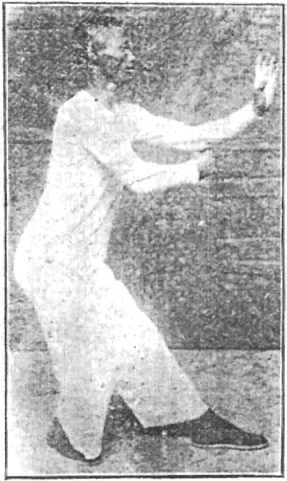
第二十三式
Posture 23
1,名稱……「倒輦猴」倒輦猴者。取其輕靈敏捷之意。且猴善撲人。譬如猴與人鬥。人不能敵。則退步撤手。而另以探掌擊其頭。使不能卽進而傷我也。
Name: RETREAT, DRIVING AWAY THE MONKEY
This refers to nimbleness and agility. A monkey is good at pouncing on a person. If a monkey and a human fight, the human is no match for it. [This explanation implies the monkey is large enough that we probably ought to refer to it as an ape, but I will leave it as the conventional “monkey” for the time being.] And so I retreat from the opponent, withdrawing a hand and extending my other palm with a strike to his head, rendering him unable to advance and harm me.
2,練法……承上式。左掌不動。右拳變掌。自右下方畫一圓圈而上。左足同時撤囘。足尖緊靠右足心。再往左方後退。如之字形。成斜角。左腿屈曲。右腿伸直。同時右掌由耳際伸出。至左掌時。左掌卽變為陽。(手心向上)。右掌卽仍為陰。(手心向下)。往前徐徐伸出。左掌則同時卽撤回左後方。撤時手心向上。至極處。則又變而為向後矣。但此項動作。如地方寬大。可連續退五式。或七式。均無不可。然最少須演三式。總以右手右足在前。為過渡法。而便於接演下式。是為「右倒輦 猴。」
Practice method:
Continuing from the previous posture, your left palm staying where it is, your right fist becomes a palm and draws a circle upward from the lower right. Your left foot at the same time withdraws, the toes coming close to your right instep, then retreats to the left side, in a zigzag to the corner. Your left leg is bent, right leg straight. At the same time, your right palm extends from the ear, and upon reaching your left palm, your left palm then becomes active (palm up) as your right palm stays passive (palm down) and slowly extends forward. Your left palm at the same time withdraws to the left rear, palm up, until it reaches its limit and has become the palm that is behind. With this movement, if you are in a spacious area, you can continue five times or seven times, but the minimum is three times, always finishing with your right hand and right foot forward to conveniently link to the following posture. This is the right side version.
3,功用……此式是運動五臟及兩胯两腿。與兩膀之推按力。練之日久。眞有身壯腿健之效。两膀之勁。亦隨之日增矣。
Effects:
This posture exercises your organs, hips, legs, and the ability of your arms to push forward and down. If you practice it for a long time, the result will surely be a robust body and sturdy legs, and the strength of your arms will also be daily increased.
4,用法……此為詐敗封門式。設敵人一拳或一腿攻來。我卽退步以手按其手或足而封之。使其不能傷我毫末也。或我退步。先用前手化其勁。再以後手探擊其面部或咽喉。
Application:
This is for pretending defeat to seal the opponent off. If he attacks with a punch or kick, I then retreat while using my hand to push down his hand or foot and seal off his attack, rendering him incapable of harming me in the slightest. Or when I retreat, I first use my front hand to neutralize his force, then use my rear hand to extend a strike to his face or throat.
5,姿勢……如第二十三式。第三十圖(一)。是也。
For this posture, see photo 30:
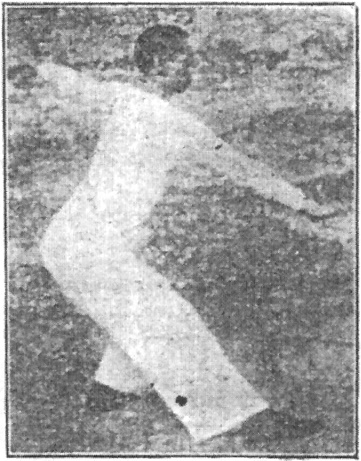
(按)「左倒輦猴」之練法。與前式無甚差別。不過此式為左手左足在前。右足往右後方斜角而退步。其名稱。功用。用法。均相同。故不重述。手足均要連貫一氣。腰脊要有竪勁。方為合法。
Note:
For the left side version, it is not very different from the right, only that now your left hand and left foot are forward and your right foot retreats to the right rear corner. The explanations for the name, effects, and application are all the same, and so they are not explained again here. Your hands and feet should move in a continuous flow, and your lower back should have an energy of being upright, and then it will be harmonious.
姿勢……如第三十一圖(一)。是也。
For this posture, see photo 31:

第二十四式
Posture 24
1,名稱……「斜飛式」斜飛式者。言其動作。如鳥類之將展翅。旋轉而飛之意。故得是名。
Name: DIAGONAL FLYING POSTURE
It is said that the movement for this posture is like a bird spreading its wings while turning to take flight, thus the name.
2,練法……承上式。兩腿不動。如橫弓式。左掌向前。復出至胸前置正。左手在上。手心向下。右手反擰囘手心向上。由腰旁再捧至腹前。此時兩手手心相對。如抱圓球。離身約七八寸許停住。同時右足收囘。足跟離地。兩膝皆曲。身微往下坐。重點在左足。眼向右方平視。如第三十二圖(一)是也。再次則右轉身。開一大步。成右弓式。腰須塌勁。同時右手由下而上。隨着右足向前橫捩。左手亦同時向身後極力伸去。右手之高度。應與鼻齊。鬆肩墜肘。手掌微側立。含有上挑之意。左手手心朝後。兩胳膊亦極力前後舒展。所謂先求開展。如(二)圖是也。
Practice method:
Continuing from the previous posture, your legs stay where they are in what is like a sideways bow stance. Your left palm goes forward to again be right in front of your chest. Your left hand is above, palm down, and your right hand turns over to be palm up, propping up beside your waist until in front of your belly, the palms facing each other as if holding a ball, about seven or eight inches away from your body. At the same time, your right foot withdraws, heel lifted. Both knees are bent, body slightly squatting, weight on your left foot. Your gaze is level to the right. It is like the first photo below. Then your torso turns to the right and you take a large step, making a bow stance. Your waist must have a sinking energy. At the same time, your right hand goes up from below, going along with your right foot by rending forward and across, as your left hand puts all its energy into extending to the rear. The height of your right hand is nose level. Loosening your shoulders and sinking your elbows, the palm is standing slightly sideways, and harbors an intention of propping up. Your left palm is facing to the rear. Your arms put all their energy into extending forward and back, as it is said [in Understanding How to Practice]: “First strive to open up.” It is like the second photo below.
3,功用……此式功能活勁腰胯。與腿部筋絡。兼可運動肩膊之力也。
Effects:
This posture can enliven your waist and hips, as well as the muscles of your legs, and can at the same time exercise the strength of your shoulders and arms.
4,用法……(一)此式與扭步抱極式微同。所異者為腿。如敵人一拳打來。我卽側腰閃之。若一脚打來。我卽用右手往地下一撈。彼足不穩。必自傾跌矣。(二)若敵人由後面攻來。我以左手握其拳。同時上步。以右手掤敵脇部。復閃側。以肩與身撞跌之。
Application for part 1:
This posture is somewhat similar to TWISTING STANCE, HOLDING A TAIJI SPHERE, but is different in the legs [empty stance rather than twisting stance]. If the opponent attacks me with a fist, I then turn my waist sideways to avoid it. If he attacks with a foot, I then use my right hand to drag toward the ground, destabilizing his footing and making him naturally lean and stumble away.
Application for part 2:
If an opponent attacks me from behind, I use my left hand to grasp his fist, and while stepping forward I use my right hand to do a ward-off to his ribs, then suddenly go sideways using my shoulder and body to knock him away.
5,姿勢……如第二十四式。第三十二圖(一)。及三十三圖(二)。是也。
For this posture, see photos 32 & 33:

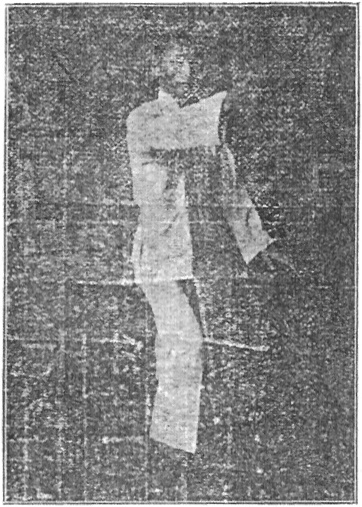
第二十五式
Posture 25
「提手」詳見第六式。一切相同。
RAISE THE HANDS – Same as Posture 6.
第二十六式
Posture 26
「白鶴亮翅」詳見第七式。一切相同。
WHITE CRANE SHOWS ITS WINGS – Same as Posture 7.
第二十七式
Posture 27
「摟膝抝步」詳見第八式。一切相同。
BRUSH KNEE IN A CROSSED STANCE – Same as Posture 8.
第二十八式
Posture 28
1,名稱……「海底針」海底針者。蓋言其向海底撈針之意。然亦有人名之曰海底繒。卽言將網放下海網魚。須臾復提起。而所以喩其手法也。
Name: NEEDLE UNDER THE SEA
It is said that the intention in this posture is of trying to find a needle under the water, but there are also people who call it NETTING UNDER THE SEA, meaning a fishing net thrown down into the water which a moment later will be hoisted up, analogous to the technique [as it continues into the following posture, whereas the name NEEDLE UNDER THE SEA is simply describing the look of this posture alone].
2,練法……承上式。為右手在前。右足不動須彎曲。右手隨腰收囘。後又隨腰向下垂沉。如撮米式。手心向下。左足亦同時收回。足尖點地。提起足跟。離右足約五寸許。重點在右足。左手仍在原處。眼神須向前看。
Practice method:
Continuing from the previous posture with your right hand forward, your right leg does not change its position but must bend, and your right hand goes along with your waist and withdraws, then also goes along with your waist and sinks downward, as if pinching rice, palm down [fingers down according to the photo]. At the same time, your left foot withdraws, toes touching down, heel lifted about five inches from your right foot. The weight is on your right foot and your left hand is still where it was. Your gaze must be forward.
3,功用……此式運動脊背。使筋絡與血氣流通。俱能活動。故無腰痛之病。
Effects:
This posture exercises your spine, getting blood to flow through the muscles and enliven the whole area, thereby relieving lower back ache.
4,用法……例如敵人以拳打來。我卽順勢接着敵手。向下摕(墜)去。使敵站立不穩。自行傾跌。
Application:
If the opponent attacks me with a punch, I seize the opportunity to connect with his hand and lead him downward, causing him to lose his stability and naturally lean and fall.
5,姿勢……如第二十八式。第三十四圖。是也。
For this posture, see photo 34:

第二十九式
Posture 29
1,名稱……「扇通臂」扇通臂者。卽言其两臂扇張。如鳥之伸展雙翅狀。然亦有人名之曰肩通臂者。蓋言其臂由肩往上直伸也。
Name: FAN THROUGH THE ARMS
For this posture, it is said your arms fan open like a bird spreading its wings, but some people say it refers to the arm extending upward from the shoulder.
2,練法……承上式。右足不動。左足上前一步。成左功式。两手隨腰提起。身斜傾上左前方。兩手同時由下往頂上直冲。右手至額上。相離約尺許。手心向外。左手提至胸際。向前探伸出。但此動作。須左手與左足。同時前進。全身重點。坐在左腿上。兩手虎口為斜線。遙遙相對。眼神隨之前視。
Practice method:
Continuing from the previous posture, your right foot stays where it is while your left foot steps forward into a bow stance, your hands go along with your waist and lift up, and your body leans forward to the upper left. Your hands press up from below in unison, your right hand about a foot above your headtop, palm outward, your left hand lifting to your chest area and then extending forward. For this part of the movement, your left hand and left foot must advance together. The weight is on your left leg and the tiger’s mouths are facing each other along a diagonal line. Your gaze follows forward.
3,功用……此式運動兩脇兩膀。能伸長筋絡骨節。且可運用脊背之力。使之貫通於兩臂也。
Effects:
This posture works both sides of your ribs and both of your arms, can stretch your muscles and joints, and can exercise the power of your spine, getting it to course through your arms.
4,用法……例如前式。採墜敵人未能傾扑。我卽以抬身以右手托其肘。左手推而擲之。設敵人或以拳打來。亦同此用法。但左手放下。總不離腰際。又或遇敵襲擊時。我右手先刁腕上提。以化敵勁。然後再用左手向敵脇部。或胸前進攻。
Application:
If when the opponent attacks me with a punch and I pluck him down, he has not yet fallen forward, I then lift my body, using my right hand to prop up his elbow, and use my left hand to push, flinging him away. When an opponent punches me and I apply this technique, the action of my left hand never occurs independent of the action of my waist. Or if an opponent suddenly attacks me, my right hand first lures his wrist upward to neutralize his attack, then my left hand attacks his flank or chest.
5,姿勢……如第二十九式。第三十五圖。是也。
For this posture, see photo 35:

第三十式
Posture 30
1,名稱……「白蛇吐信」此式卽謂一手向上。一手屈曲。謂其翻身掄臂。狀如蛇之探首昂頭吐舌之形態。故得是名。
Name: WHITE SNAKE SHOOTS OUT ITS TONGUE
For this posture, it is said that one hand goes up while the other hand bends in, your body turning with an arm rolling, to be like a snake raising its head and shooting out its tongue, thus the name.
2,練法……承上式。身往右轉(囘頭)。全身重點。仍坐在左膝上。腰塌住勁。此時左腿曲膝。右腿伸直。左掌往頭頂上伸出。手心向上。同時右掌變拳。仍置腹前。拳心向下。兩眼向前平視。
Practice method:
Continuing from the previous posture, turn around to the right (turning your head), the weight still on your left leg. Your waist has a sinking energy. Your left leg is bent, right leg straight. Your left palm extends over your headtop, the palm facing upward. At the same time, your right palm becomes a fist and is placed in front of your abdomen, the center of the fist facing downward. Your gaze is forward and level.
3,功用……此式乃運動腰部之塌勁。及兩膀之支持力。可舒展全身筋絡。幷能使精神煥發。蓋猶常人之倦極伸腰也。
Effects:
This movement exercises the sinking energy of your waist and the bracing ability of your arms. It can stretch the muscles of your whole body and can bolster your spirit. It is like a tired man stretching his back.
4,用法……例如敵人前後打來。以左手架去。再轉身以右手禦敵。又設敵人一拳向我腰部打來。我卽右手翻下。以肱撥開其拳。身向後退。彼拳卽落空。我則再以左掌。由頂而落。直取敵人之眼睛。
Application:
If opponents attack me from front and rear, I use my left hand to prop up, and turn to use my right hand to ward away, preparing against his punch toward my waist. I then turn my right hand over so the palm is downward and use my forearm to deflect his fist aside, while my body moves back so that his punch lands on nothing, and then I send my left palm, lowering from my headtop, aiming straight to his eyes.
5,姿勢……如第三十式。第三十六圖。是也
For this posture, see photo 36:
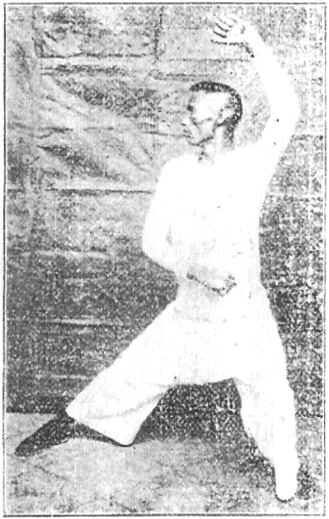
第三十一式
Posture 31
1,名稱……「撇身捶」撇身捶者。為太極拳五捶之一。蓋卽言其捶由身邊撇出之意。右捶撇出。則左掌隨擊。腰身折叠。脊骨挺勁。然亦有人謂撇身卽閃身也。
Name: TORSO-FLUNG PUNCH
This is one of the five punches in Taiji Boxing. For this posture, it is said that a punch is being flung out from beside your torso. When your right punch is flung out, your left palm follows with a strike. Your torso is folding in, your spine sticking out. But there are also some people who say that “flinging torso” means dodging with the body.
2,練法……承上式。雙足原位不動。而身往前向。則變為右弓步式。兩手轉向西。右手隨腰往下鬆。藏在右胯旁。拳心向上。左手繞右拳上。往西按出。手指向上。右拳同時向後鬆握。手指稍散開。從耳前(右方)落下。如畫一圓圈狀。左手為掌。掌心向上。如引拉下握之意。與右拳同時而下。身往後坐。此時變為左腿載全身重 點。眼向前平視。手隨足動。最忌停滯。
Practice method:
Continuing from the previous posture, your feet stay where they are but your body moves forward to make a bow stance. Your hands arc to the west, your right hand going along with your waist as it loosens downward, stopping beside your right hip with the fist center upward. Your left hand is coiling around your right fist and then pushes to the west, fingers up. Your right fist then goes to the rear and loosens, fingers spreading open, lowering from in front of your right ear, drawing a circle. Your left hand turns to be palm up and with an intention of grasping and pulling down and in, it lowers with your right hand, your body sitting back. Your left leg is now carrying the weight of your whole body. Your gaze is forward and level. Your hands go along with the movement of your legs. The most important thing to avoid in this movement is any stagnation.
3,功用……此式為運動手肘壓力。幷搬囘縮力。靈活腰脊之妙法也。
Effects:
This posture exercises the ability of your elbows to press down, as well as the ability to parry and shrink back, the secret of which lies in the liveliness of your spine.
4,用法……例如敵人拳足一齊打來。我卽收囘右腿。使彼腿踢落空。右手壓住敵人之拳。隨用左手按敵手。右手乘勢出擊。如敵人右拳打來。我卽以右手由頂上翻下。壓住敵人之拳。再以左拳。由下往上擊敵人之面部。倘敵再左拳打來。我卽縮囘右拳。以左掌按敵之腕。而封其勢。使彼不能再逞。
Application:
If an opponent attacks me with a [left] punch and [right] kick at the same time, I then withdraw my right leg [contradicted in the practice method by “feet stay where they are”], causing his kick to land on nothing, my right hand pressing down his fist, my left hand pushing down on his arm, and my right hand then takes advantage of the opportunity to strike. If he then attacks with his right fist, I then use my right hand to turn over downward from above my head and press down his fist, and then I may use my left fist, going up from below, to strike to his face. [The application from this point is for the following posture] If he then attacks again with his left fist, I then withdraw my right fist and use my left palm to push down on his wrist, sealing off his power and causing him to be unable to do anything with it.
5,姿勢……如第三十一式。第三十七圖。是也。
For this posture, see photo 37 [which shows the first half of the posture]:
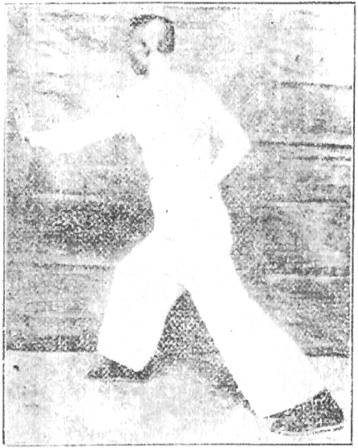
第三十二式
Posture 32
「上步搬攔捶」此式講解。與第十五式。完全一切相同。惟此式為囘頭方向。且練完撇身捶之後。至此動作。須提起右足。足尖又擰向右方。落步時。其手之動作。亦與第十五式相同。故不加圖。
STEP FORWARD, PARRYING-BLOCK PUNCH
Same as Posture 15, but this time to the opposite direction and following from TORSO-FLUNG PUNCH. For this movement, you must lift your right foot and turn the toes toward the right, and then when the foot lowers, the movement of your hands is the same as in Posture 15, thus there is no additional photo.
第三十三式
Posture 33
「進步指襠捶」此式為連接上式。亦為回頭方向。一切講解。悉與第十六式相同。故不重述。閱者請參看上文便明白矣。其動作之姿勢。如第三十八圖。是也。
ADVANCE, PUNCH TO THE CROTCH
Same as Posture 16, and so will not be explained again here. You may refer to the earlier explanation to more easily understand. For this posture, see photo 38:
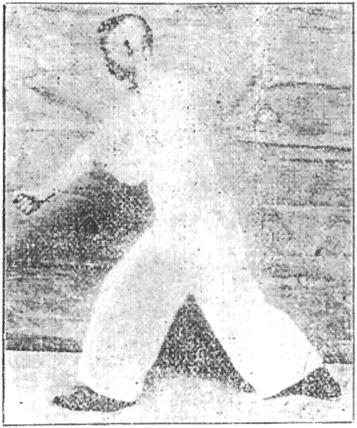
第三十四式
Posture 34
1,名稱……「進步攬雀尾」詳見第四式之(一)。
Name: ADVANCE, CATCH THE SPARROW BY THE TAIL (see Posture 4, part 1)
2,練法……承上式。左足不動。再上右步。左手由下而上。手心向上。平伸與左肩齊。不可高低。右手由右而左。經面前而落。手心向地。停於左臂前。眼看左手。再次則右手由下而上。手心向上。平伸與右肩齊。不可高低。左手由左而右。經面前而落。手心向地。停於右臂前。眼看右手。至繼續演練攬雀尾之過渡法。則雙手一反。變為右掌掌心向地。左掌掌心向上。而繼練掤。捋。擠。按。等式。悉照第四式之各式練法便合。
Practice method:
Continuing from the previous posture, your left foot stays where it is and your right foot steps forward, your left hand goes up from below, palm up, extending level with your left shoulder, no higher or lower, while your right hand goes left from right, passing in front of your face and lowering, palm toward the ground, stopping in front of your left arm. Your gaze is to your left hand. Then your right hand goes up from below, palm up, extending level with your right shoulder, no higher or lower, while your left hand goes right from left, passing in front of your face and lowering, palm toward the ground, stopping in front of your right arm. Your gaze is to your right hand. Continuing into the rest of CATCH THE SPARROW BY THE TAIL, your hands turn over to be right palm toward the ground, left palm up, so that ward-off, rollback, press, and push are performed in succession as before.
3,功用……詳見第四式之(一)。完全相同。
Effects:
Same as in Posture 4, part 1.
4,用法……詳見第四式之各式相同。
Application:
Same as in Posture 4.
5,姿勢……如第三十四式。第三十九圖。是也。
For this posture, see photo 39 [followed by photos 6–9, 28, and 10]:

第三十五式
Posture 35
「單鞭」詳見第五式。完全一切相同。
SINGLE ROD – Same as Posture 5.
第三十六式
Posture 36
1,名稱……「雲手」此式蓋言其手法靈活。如白雲之變幻無窮。忽左忽右。不可摸捉之意。然亦有人謂其两手。左右運打。宛如雲氣旋繞。往來不斷。故名。
Name: CLOUDING HANDS
For this posture, it is said your hands are to be so agile as to resemble the endless fluctuations of clouds, suddenly going left then suddenly right, and must not be predictable. But there are also people who say the hands go side to side with circular strikes, moving like swirling vapors, going back and forth unceasingly, thus the name.
2,練法……承上式。兩足先不動。右手之勾變為掌。往左下方而上。手心向上。在左肘之下停。往右肘稍曲。左手伸直不動。手心向下。同時右足移往與左足並攏。膝微屈曲。身腰往下蹲。不可過於搖動。眼隨雲往外在上之手平視。如(一)圖。再次則右手。經面前雲過右方伸直。手心向下。左手則由下往右方兜上。手心向上。停於右肘下。左肘稍曲。同時左足往左方橫挪開一步。右足不動。眼神亦隨之而轉視右手。如(二)圖。個以(一)(二)兩動作。方為一式。演練時。最少須連雲三次。或五次。七次不等。此看地方大小而言。不可固執。總之卽以單數為標凖也。雲手時經過面前之手。須用手心向己面。手背向外。雙眼隨之平視。不可手到眼 不到。
Practice method:
Continuing from the previous posture, your feet at first stay where they are, your right hook hand becomes a palm, goes to the lower left and up, palm facing upward, stopping below your left elbow, your right elbow slightly bent. Your left hand extends straight without changing its position, palm downward. At the same time, your right foot shifts to be beside your left foot, knees slightly bent. Your body squats down but must not overly sway. Your gaze goes along with the clouding of the hand going outward and upward [i.e. your left hand at this moment], looking level. It is like the first photo below. Then your right hand passes in front of your face, clouding across and extending to the right side, palm down, while your left hand goes from below and wraps upward to the right side, palm up, stopping below your right elbow, your left elbow slightly bent. At the same time, your left foot steps sideways to the left, your right foot staying where it is. Your gaze goes along with the movement, turning to look toward your right hand. It is like the second photo below. These two movements form one posture. When practicing, you must do it at least three times, or you may do five, seven, or more, however many or few not being important, as long as it is an odd number. When doing CLOUDING HANDS, the hand passing in front of your face must have its palm toward your face, the back of the hand outward. Your gaze goes along with it, looking level, and there must not be a case of the hand arriving without your gaze arriving too.
3,功用……此式是運動頭部。眼部。肩部。腰部。能壯其腦筋。故無頭暈眼花之二病。
Effects:
This posture exercises your head, eyes, shoulders, waist, and can strengthen your brain, thus keeping you free from dizziness and blurry vision.
4,用法……例如敵人以左拳向我右耳打來。我即用右手抱其手腕。左手截其肘。能使敵人肘節處折斷。左右式均同一用法。所異者惟方向耳。
Application:
If an opponent uses his left fist to attack my right ear, I then use my right hand to grab his wrist and my left hand to stop his elbow, which can cause his elbow to break. The application is the same on both sides, and the only difference is the direction.
5,姿勢……如第三十六式。第四十圖(一)。及第四十一圖(二)。是也。
For this posture, see photos 40 & 41:
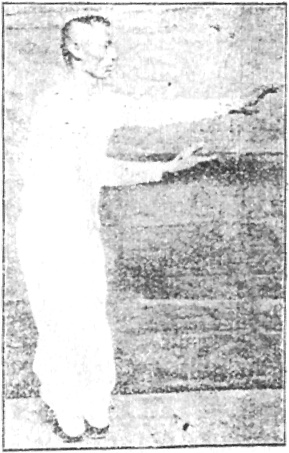
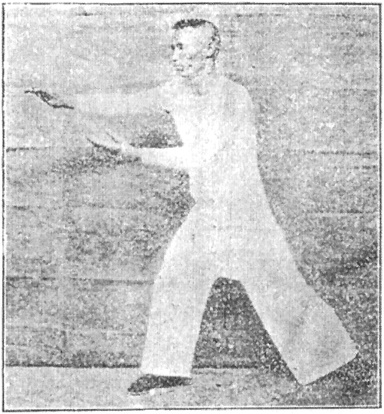
(按)此式之動作。兩手往來。如同行雲。不可阻滯。無論左手右手。當雲至下方時。心中假想有極重之物。擋住我手之意。我用肩之兜力。直向外方捩出。切忌往上托舉。手。足。眼。力。須合成一氣。否則姿勢不整。氣亦散漫矣。
Note:
In this posture’s movement, your hands go back and forth like moving clouds and must not be sluggish. Regardless of which hand it is when the clouding takes it downward, I imagine there is an extremely heavy thing blocking its way, and I apply the strength of my shoulder wrapping in to send the thing away outward. But you must absolutely avoid trying to brace upward, for your hands, feet, eyes, and power must have a continuous flow. The posture will otherwise not be orderly and the energy will be in disarray.
第三十七式
Posture 37
「單鞭」詳見第五式。完全一切相同。故不另。
SINGLE ROD – Same as Posture 5, and so will not be explained again here.
第三十八式
Posture 38
1,名稱……「高探馬」此式即言人欲乘馬。不知性良否。故先探之。然後騎上。且其動作縮步。聳身。向前探出。亦如上馬之探身。故名高探馬。
Name: RISING UP AND REACHING OUT TO THE HORSE
If you want to ride a horse but do not know if its character is good or bad, you reach out to it before climbing onto it. Additionally, this movement has a withdrawing step, a tall body, and a reaching out forward, which is also like getting up onto a horse by reaching with your body, thus the name.
2,練法……承上式。右鈎變掌。兩肩極力鬆勁。兩掌向內作攞一圓圈形。經脇旁往左前右後方伸出。手心向上。右手稍高。同時身往後坐。重點在右腿。左脚作丁式虛步。眼看右手。如(一)圖。再次則左足縮囘。足尖着地。距離右足心。約五六寸許。身往下蹲。兩腿皆曲膝。又以右手手心向下。往左手臂上方推出。同時左手收囘。停於左腰旁。手心向上。右足原位不動。雙目仍向前平視。如(二)圖是也。
Practice method:
Continuing from the previous posture, your right hook hand becomes a palm, your shoulders put their energy into loosening, both palms go inward in a circular shape, [left hand] driven by your ribs to the forward left, [right hand] extending to the right rear, palms up, right hand slightly higher. At the same time, your body sits back, the weight on your right leg, your left foot making a T stance. Your gaze is to your right [left] hand. It is like the first photo below. Then your left foot withdraws, toes touching down about five or six inches from your right instep, as your body squats down, both knees bending, and you use your right hand, palm down [forward, according to the photo], to push out over your left arm. At the same time, your left hand withdraws until by the left side of your waist, palm up. Your right foot stays where it is. Your gaze is still forward and level. It is like the second photo below.
3,功用……此式乃練習两膀之伸張力。及運力。能令肩部發育。助身體之發展。
Effects:
This posture trains the ability of your arms to extend and circle, and it can develop your shoulders, enhancing the build of your body.
4,用法……例如敵人前後打來。我卽以左右手。穿敵咽喉。或眼晴。若敵人由左邊打來。我卽用手一圈。將敵之肘壓住。同時以掌穿敵人咽喉部位。又遇敵捋吾左手。我下縮後聳。以化敵勁。以右手探掌擊之。均無不可。
Application:
If I am attacked by opponents in front and behind, I send out my hands to jab to their throats or eyes. If the opponent to my left then attacks, I send my [left] hand in an arc to press down his elbow, at the same time using my [right] palm to jab to his throat area. Or if an opponent pulls on my left hand, I shrink it away downward and lift it up behind to neutralize his force while extending my right hand with a palm strike. Either of these scenarios will work.
5,姿勢……如第三十八式。第四十二圖(一)。與第四十三圖(二)。是也。
For this posture, see photos 42 & 43:

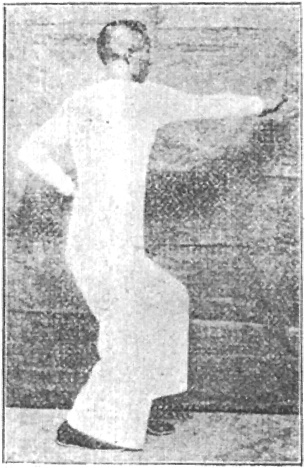
第三十九式
Posture 39
1,名稱……「右伏虎分脚」此式兩掌向後下拉捋之意。又如伏虎形狀。右足向右方一踢。故又有人名之曰右分腳。蓋如少林拳之二起腿。緣少林拳之二起腿。多為聳步向高跳起而拍。此則緩起緩落。是卽剛柔之別也。
Name: RIGHT CROUCHING TIGER & KICK TO THE SIDE
In this posture, there is an intention of the palms pulling downward to the rear and has the appearance of a crouching tiger, and your right foot kicks to the right side, and so there are also people who call it KICK TO THE RIGHT SIDE. It is like Shaolin Boxing’s “double kick”, but the double kick usually involves a fast step, a high jump, and a slap to the foot, whereas here there is a slow rising and a slow lowering, making hard and soft distinct.
2,練法……承上式。右足原位不動。左足後退一步。如弓式。往右轉身。右手手心向下。左手手心朝上。相對。右手在上。左手在下。隨腰由右往左。往下圓轉。隨往下捋。如(一)圖。再次則右足先不動。身往左轉。兩足如扭步狀。兩手隨往東北。慢慢而上。再由下又往上相合。如捧物狀。兩眼須向東南平視。左腿變實。右腿為虛。提起足尖向下。由東南分出。足背須平。兩手同時往左右两邊分開。右手向東南。左手向西北。兩掌則左竪右橫。如(二)圖是也。
Practice method:
Continuing from the previous posture, your right foot stays where it is while your left foot retreats a step, making a bow stance, your torso turning to the right. Your hands are facing each other, right palm down, left palm up, right hand above, left hand below. They go along with your waist from right to left, arcing downward with a rollback. It is like the first photo below. [The photo shows right palm up, left palm down, indicating a ward-off moment at the beginning of the rollback.] Then with your right foot at first staying where it is, your torso turns to the left, your feet seeming to make a twisting stance as your hands go along to the northeast and slowly upward, continuing upward from below until coming together as if carrying something. Your gaze must be level to the southeast. Your left leg becomes full, right leg becomes empty, and your right foot lifts, toes down, then extends to the southeast with the top of the foot flat. Your hands at the same time spread apart to the sides, right hand to the southeast, left hand to the northwest, left palm upright, right palm sideways. It is like the second photo below.
3,功用……此式能全兩腿大筋受運動。因而粗壯。且可活動胯骨。又能健足捷步。
Effects:
This posture can give exercise to the larger muscles of your legs, making them thicken, can liven your hip bones, and can also improve agility in stepping.
4,用法……如敵人一拳向面部打來。我則以右手格之。同時起右足踢敵人腰脇部位。使之傾跌。
Application:
If an opponent punches toward my face, I then use my right hand to block him while using my right foot to kick him in the area of his waist or ribs, causing him to stumble away.
5,姿勢……如第三十九式。第四十四圖(一)。與第四十五圖(二)。是也。
For this posture, see photos 44 & 45:
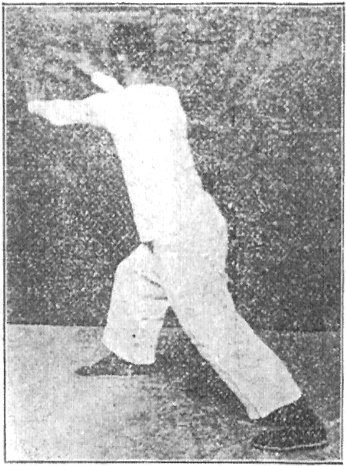
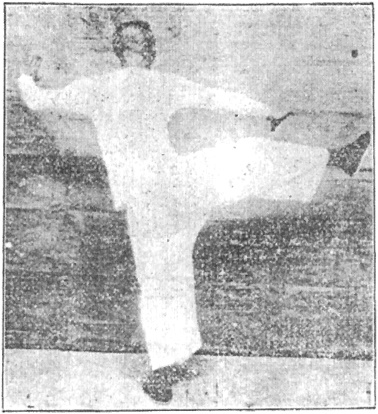
第四十式
Posture 40
1,名稱……「左伏虎分脚」此式之意義。與第三十九式相同。所異者為左右之分別也。
Name: LEFT CROUCHING TIGER & KICK TO THE SIDE – Same meaning as in Posture 39. The difference is the reversing of left and right.
2,練法……承上式。右足落地。兩手仍如前式為捋下之意。繼則變成右弓步。左手伸長。右手肘微曲。再次兩足亦如扭狀。兩手由下而上。如捧物狀。兩手心向上。然後手足一齊分開。大致與上式動作之方向相反。便成是式矣。
Practice method:
Continuing from the previous posture, your right foot lowers and makes a right bow stance while your hands again have an intention of a downward rollback, left hand extended, right elbow bent. Then your feet twist, your hands go up from below as if carrying something, palms up, and spread apart in unison with your [left] foot [kicking]. The orientations are more or less a reversal of the previous posture, and thus this posture is easily realized.
3,功用……詳見第三十九式。完全相同。
Effects:
Same as in Posture 39.
4,用法……此式之用法。與第三十九式相同。所差者。此式為左手格之。與左足踢出之不同者也。
Application:
Same as in Posture 39. The difference here is that it is your left hand that blocks and your left foot that kicks.
5,姿勢……如第四十式。第四十六圖(一)。與第四十七圖(二)。是也。
For this posture, see photos 46 & 47:
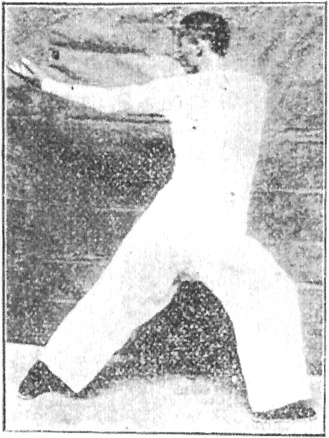
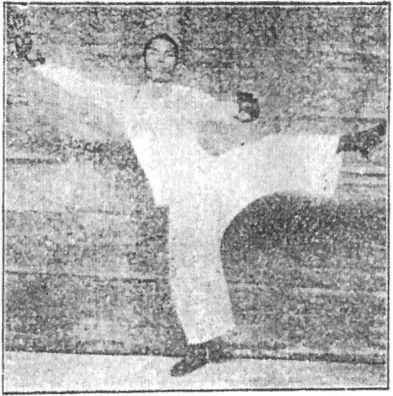
第四十一式
Posture 41
1,名稱……「轉身蹬脚」此式之動作。其身法為向左轉。但足之起法。如脚面向前平面伸直出。是為踢足。又名分脚。脚尖向上勾起。是為蹬足。卽以足心向外直蹬也。此足之法相似。故名。
Name: TURN AROUND, PRESSING KICK
In this posture’s movement, your body’s method is a leftward turn, but as for your foot’s kicking method, if the back of the foot is flat and straight, it is simply called kicking, as in KICKING TO THE SIDE, but if the toes are pulled up, it is called pressing, the sole outward and pressing straight, and since here the kicking technique is like this, thus the name.
2,練法……承上式。連接不停。左足不着地。而向左方轉身。(回頭)不可前俯後仰。重點全在右足。右足跟轉向北方。左足稍下垂。足趾向下。同時两手相合。作十字形。同時分開。右手朝西。左手朝東。左足蹬出。足心向外。足尖朝上。此式身雖朝北而作。雙眼則隨向西平視。(卽看左手)但此式之兩手。均為立掌。右手稍高。左手與肩平。丹田抱勁。氣往下沉。必須與上式一氣貫串也。
Practice method:
Continuing from the previous posture without stopping and without your left foot touching down, turn around to the left (turning your head). You must not lean forward or back. The weight is entirely on your right foot as your right heel pivots to point the foot to the north, your left foot slightly hanging, toes down. At the same time, your hands come together to make an X shape, then spread apart in unison, right hand to the west, left hand to the east, as your left foot presses out, sole outward, toes up. In this posture, although your torso is square to the north, your gaze goes along with the movement, looking level to the west (looking toward your left hand). Your hands in this posture are both upright palms, right hand slightly higher, left hand at shoulder level. Your elixir field contains power, energy sinking down. This posture must be connected to the previous posture as a single flow.
3,功用……此式為練習腿部力量。若能習之有常。則旋轉靈活。自無頭暈之患。腿部遲笨之病也。
Effects:
Practicing this posture will strengthen your legs. If you can practice it often, then you will turn around nimbly, without dizziness and without awkwardness in your legs.
4,用法……此式之用法。與左右分脚同。若遇敵人由背後打。則用轉身化勁法避之。使其落空。然後用足蹬擊之。此着為進攻敵之脅。腰。胸。胯。腹。等處。同時兩手分開。以化敵人繞進而謀我。兼可防我足為彼所持也。
Application:
This posture’s method of application is the same as in KICKING TO THE LEFT & RIGHT SIDES. If I encounter an opponent striking me from behind, I use the turning of my body to neutralize his power and avoid it, causing his attack to land on nothing, then use my foot to strike him with a pressing kick. This technique is a forward attack to the opponent’s flank, waist, chest, hip, abdomen, or such areas. At the same time, my hands spread apart to neutralize the opponent’s circular attack and set things up for me, and can simultaneously protect my foot against his grabbing it.
5,姿勢……如第四十一式。第四十八圖。是也
For this posture, see photo 48:
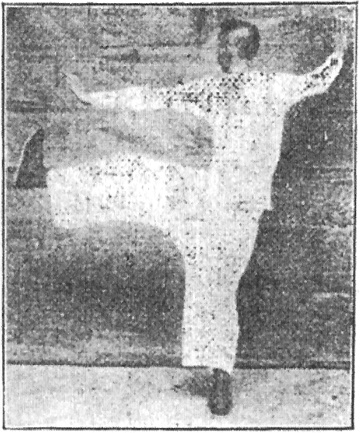
第四十二式
Posture 42
1,名稱……「左右摟膝抝步」此式為囘頭之動作。與第十式。第十一式。方向相反。動作無異。詳見第十式及第十一式。完全相同。故不另述。
Name: LEFT & RIGHT BRUSH KNEE IN A CROSSED STANCE
The movement of this posture is Postures 10 & 11 turned around to the opposite direction, but the movement is no different from those two postures, and so they will not be explained again here [in their entirety].
2,練法……承上式。左足蹬出後。旋卽收囘。足尖須向下垂。全身坐在右腿。左脚慢步前伸。左手摟過左膝。右手按出。如(一)圖。再次換步。右足上前。右手摟過右膝。左手按出。如(二)圖。其餘一切。皆與第十式及第十一式。完全相同。惟中間無此「手抱琵琶」之式耳。
Practice method:
Continuing from the previous posture, after your left foot presses out, it then withdraws, and its toes must hang down. Your whole body is sitting on your right leg. Your left foot slowly steps forward, your left hand brushes past your left knee, and your right hand pushes out. It is like the first photo below. Then switch steps. Your right foot steps forward, your right hand brushes past your right knee, and your left hand pushes out. It is like the second photo below. The rest is the same as in Postures 10 & 11, except there is no HOLDING THE LUTE posture in between them [following them].
3,功用……詳見第十式。與第十一式。完全相同。
Effects:
Same as in Postures 10 & 11.
4,用法……詳見第十式。及第十一式。完全相同。
Application:
Same as in Postures 10 & 11.
5,姿勢……如第四十二式。第四十九圖(一)。及第五十式圖(二)。是也。
For this posture, see photos 49 & 50:
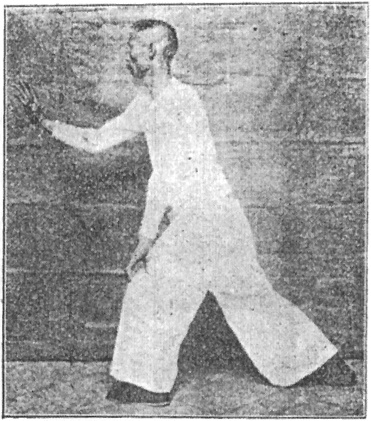
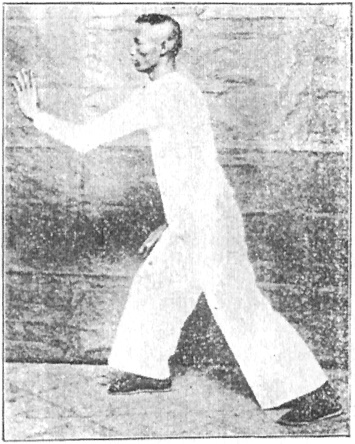
第四十三式
Posture 43
1,名稱……「進步栽捶」進步栽捶。為太極拳五捶之一。此式左足前進。以右捶由上而直下突擊。又如往下栽葱之意也。
Name: ADVANCE, PLANTING PUNCH
This is one of the five punches in Taiji Boxing. Your left foot advances and your right fist suddenly strikes straight down from above, similar in intention to planting an onion.
2,練法……承上式。右足轉向西南。左手摟過左膝。同時左足前進一步。成左弓式。腰塌着勁。同時右手由腰間。向外打出。卽向下突擊。右胳膊向下。作斜直線狀。兩臂均要鬆勁。丹田後吸。幷須有含胸拔背之意。雙眼隨下視右捶。身不可過於前探。宜用腰脊力量。精神尤須提起。動作連貫。自能得其奧妙也。
Practice method:
Continuing from the previous posture, your right foot turns to the southwest [northwest], your left hand brushes past your left knee as your left foot advances a step, making a left bow stance, and your waist has a sinking energy. At the same time, your right hand goes from beside your waist to strike with suddenness outward and downward, the arm going downward along a diagonal line. Your arms must evenly loosen, your elixir field draws back, and there must be an intention of containing your chest and plucking up your back. Your gaze goes along downward to look toward your right fist. Your body must not extend too far forward, you should use strength from your lower back, your spirit must rise, and the movement is to be a consistent flow, and then you will able obtain the subtlety of it.
3,功用……此式為運動左腿。及右臂膀放下之沉墜力。兩腿蹬勁。不可努氣。自能調和呼吸也。
Effects:
This posture exercises your left leg, as well the sinking power of your right arm’s downward punch and the pressing energy of your legs. It must not be too vigorous and then your breath can be harmonious.
4,用法……例如敵人右拳右腿打踢而來。我卽以左手撥開敵之右手。再進步以右捶還擊敵人腹部。敵或攔我右腕。我則用左手。揉化敵手。以右手突擊其丹田而傷之。
Application:
If the opponent attacks me with a right punch or right kick, I use my left hand to push aside his right hand [or right leg], then advance and return a right punch to his abdomen. Or if he obstructs my right wrist [in the previous posture], I then use my left hand to wipe off and neutralize his hand, and use my right hand to suddenly strike to his elixir field and injure him.
5,姿勢……如第四十三式。第五十一圖。是也。
For this posture, see photo 51:
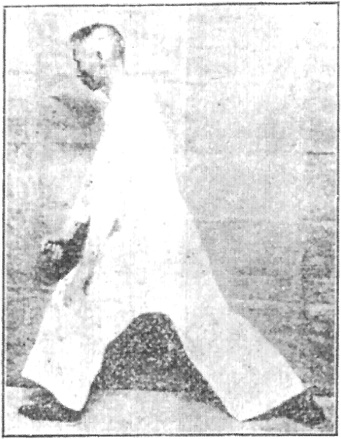
第四十四式
Posture 44
1,名稱……「翻身白蛇吐信」此式之名解。與第三十式相同。惟此式之方向。為翻身(回頭) 之動作。故名「翻身白蛇吐信」。
Name: TURN AROUND, WHITE SNAKE SHOOTS OUT ITS TONGUE
Same as in Posture 30, except for the orientation. There is the movement of turning around (turning your head), thus the name. [No explanation is given as to why this posture has the turning around in its name while Posture 30 does not, even though Posture 30 also has us turning around.]
2,練法……承上式。左足原地不動。足尖轉向北。全身重點。坐在左腿上。左手曲肘東轉往上。右手曲肘西轉。停在腹前。左手手心向上。右手手心向下。两眼亦轉向東看。其餘悉與第三十式相同。請參閱上文。便明白矣。
Practice method:
Continuing from the previous posture, your left foot stays where it is, but it turns to point the toes to the north, the weight on your left leg, your left hand bending at the elbow and arcing upward to the east, your right hand bending at the elbow and arcing to the west, stopping in front of your abdomen. Your left palm is up, right palm down. Your gaze turns to the east. The rest is the same as in Posture 30, and you may refer to the earlier explanation to more easily understand.
3,功用……詳見第三十式。完全相同。
Effects:
Same as in Posture 30.
4,用法……例如敵人。由身後向我襲擊。我卽翻身開步。以右手揉化敵手之來勢。或連用左掌下按。以傷敵頭部。
Application:
If an opponent suddenly attacks me from behind, I turn my body, widening my step, and use my right hand to neutralize his attacking hand, and then I may use my left palm to push down, injuring his head. [Instead of the left hand jabbing to the opponent’s eyes as in his earlier white snake explanation, Gu now seems to be having one of his famous iron palm moments.]
5,姿勢……如第四十四式。第五十二圖。是也。
For this posture, see photo 52:

第四十五式
Posture 45
「撇身捶」詳見第三十一式。完全一切相同。惟方向相反耳。
TORSO-FLUNG PUNCH – Same as Posture 31, except the orientation is reversed.
(按)此處本無是式。然亦有人練時增加之。故併錄載。因其無甚重要。不成問題也。
Note:
This was not originally one of the postures, but there are some people who when they practice have added it in, therefore it is mentioned here. But it is not very important and does not matter either way.
第四十六式
Posture 46
「上步搬攔捶」詳見第三十二式。完全一切相同。惟方向相反耳。
STEP FORWARD, PARRYING-BLOCK PUNCH – Same as Posture 32, except in the opposite direction.
第四十七式
Posture 47
「進步指襠捶」詳見第三十三式。完全一切相同。惟方向相反耳。
ADVANCE, PUNCH TO THE CROTCH – Same as Posture 33, except the orientation is reversed.
第四十八式
Posture 48
1,名稱……「右斜蹬脚」是式蹬右脚之方向。為斜角。而非正面。故以是名之也。其餘與第四十一式。之轉身蹬脚意義相同。請參閱上文。便明白矣。
Name: RIGHT DIAGONAL PRESSING KICK
In this posture, the direction you press your right foot is to the corner instead of straight ahead, thus the name. The rest of the meaning is the same as in Posture 41. You may review it above to more easily understand.
2,練法……承上式。右手臂搭於左手臂之前。作十字形。兩手手心向己身。停於胸前。約距離七八寸許。腰仍須塌勁。右足跟轉向西。全身重點在左腿。然後兩手反轉。手心向外。立卽分開。同時並提起右脚。往斜角蹬去。蹬時須足尖朝上勾勁。足踵往前蹬勁。左肘稍曲。右手伸直。手心仍向地。雙眼往斜角平視。身法須立如 平凖。不可前俯後仰。顯露傾危狀態。
Practice method:
Continuing from the previous posture, your right arm rises up in front of your left arm to make an X shape, palms toward yourself, halting about seven or eight inches in front of your chest. Your waist must maintain a sinking energy. Your right [left] heel pivots to point the foot to the west [northeast] and the weight of your whole body shifts to your left leg. Then your hands turn over so the palms are outward and promptly spread apart as your right foot lifts and presses out toward the corner. When pressing, the toes must be drawn upward, the heel going forward with a pressing energy. Your left elbow is slightly bent, your right hand extended, palm again toward the ground. Your gaze is level to the corner. Your body must stand like a balanced scale and must not lean forward or back or have a noticeably crooked shape.
3,功用……此式亦為操練腰腿之勁。其餘與第四十一式。大意相同。
Effects:
This posture also is for training power in your waist and legs, the rest basically the same as in Posture 41.
4,用法……此式之用法。徦想吾在正面應敵之時。突又有人從斜角地方而來襲擊。我卽向斜角起脚踢之。使其不能前進也。其餘與四十一式之用法相同。
Application:
For this posture’s method of application, I imagine I am dealing with an opponent directly in front of me when suddenly another makes a surprise attack from the corner. I promptly lift my foot to the corner and kick him, causing him to be unable to advance. The rest is the same as in Posture 41.
5,姿勢……如第四十八式。第五十三圖。是也。
For this posture, see photo 53:
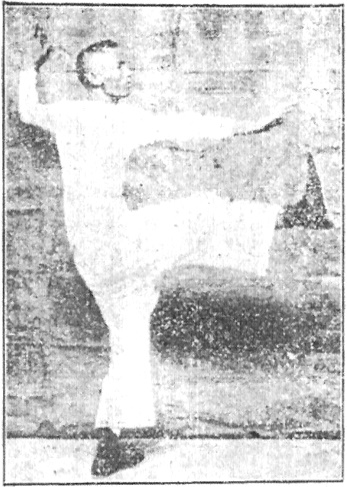
第四十九式
Posture 49
1,名稱……「左披身伏虎白蛇吐信」此式之動作。其身偏側伏下。如伏虎式。其掌由下而上。如第三十式之白蛇吐信相同。惟此式轉較低。故以是名之。
Name: LEFT DRAPING-BODY CROUCHING TIGER, WHITE SNAKE SHOOTS OUT ITS TONGUE
In this posture’s movement, your body leans and crouches down, like a tiger crouching. Your palm going up from below is the same as in Posture 30, except in this posture it arcs lower, thus the name.
2,練法……承上式。右足收囘。乘落下時。即偸步插於左腿之後。左手往右。與右手同時隨步隨腰。往下又往左圓轉而上。右手握拳。手心向下。左掌由左身旁。而圓轉上。至頭部之上。手心朝上。左肘微曲。全身重點。坐在左腿。同時左足往西橫移。成弓箭步。右腿伸直。與上列各式之路線。成十字形。两眼向右足前面平視。
Practice method:
Continuing from the previous posture, your right foot withdraws, and when it lowers, it does a stealing step behind your left leg. Your left hand goes to the right, and then in unison with your right hand goes along with the step and your waist downward, to the left, then arcs upward as your right hand grasps into a fist, palm down. Your left palm goes from the left side of your body in an upward arc until above your head, palm up, elbow slightly bent. The weight shifts to your left leg when your left leg shifts sideways to the west, making a bow and arrow stance, your right leg straightening. The paths of the movements would form an X shape [in that the lines would appear to cross when your left hand moves upward to the right over your head while your right fist moves downward to the left beside your ribs]. Your gaze is forward, looking level toward your right foot.
3,功用……此式係練習腿胯之力。而腰部亦受其運動之影嚮。故其腰部。又可靈活。無腰硬身滯之患。且能壯實腰脊。伸縮臂膀。
Effects:
This posture trains the strength of your legs and hips, and seems to give exercise to your waist, and thus it can liven your waist and thereby reduce stiffness in your torso. It can also strengthen your lower back and make your arms flexible.
4,用法……此式為採挒兼用。若敵人用左拳打來。同時起左脚踢來。我則用雙手緊握敵之手腕。用力往下一墜。卽下採之意。身往後坐低。彼脚不能傷我。同時卽速以左掌。打敵頭部。右拳用以防敵。仍停原處。
Application:
This posture uses both plucking and rending. If an opponent uses his left fist to attack me, and at the same time kicks with his left foot, I then use both hands to grab his wrist and forcefully pull down with a plucking intention. Sitting my body low to the rear so his foot cannot harm me, I quickly use my left palm to hit his head while my right fist is used to guard against him and stays where it is.
5,姿勢……如第四十九式。第五十四圖。是也。
For this posture, see photo 54:

第五十式
Posture 50
1,名稱……「右披身伏虎流星捶」此式與上式之方向相反。卽其身向右方傾伏。亦如伏虎狀。但其捶由下而上。狀如流星。故以此名之。
Name: RIGHT DRAPING-BODY CROUCHING TIGER, METEOR PUNCH
This posture’s orientation is opposite to the previous posture, your body going to the right to lean and crouch, again in the manner of a crouching tiger. But your fist goes up from below to then resemble a falling star, thus the name.
2,練法……承上式。先收囘右足。與左足靠攏。身微下蹲。然後右足仍伸囘原位。右足曲膝。左腿伸直。全身重點。在於右腿。同時兩手隨腰右轉向東南方。有捋之意。再次左手由下轉往右方。握拳停於右脇前。距離約五寸許。手心向下。左肘亦曲。右手再由下從右圓轉而上。轉至頭上。手心向上。其方向與上式成相對。眼往左足前方平視。腰仍塌勁。氣沉丹田。則姿勢自然靈穩矣。
Practice method:
Continuing from the previous posture, first withdraw your right foot, bringing it close to your left foot, your body slightly squatting. Then your right foot extends back to where it was, the knee bends, and your left leg straightens, the weight shifting to your right leg. At the same time, your hands go along with your waist, arcing to the right, to the southeast, with a plucking intention. Your left hand continues to arc to the right from below, grasping into a fist, and stops about five inches in front of your right ribs, palm down, elbow bent, while your right hand meanwhile arcs up from the lower right until above your head, palm up, its orientation opposite to the previous posture. Your gaze is forward, looking level toward your left foot. Your waist maintains a sinking energy, energy sinking to your elixir field, and thus the posture will naturally be nimble and stable.
3,功用……此式練習腿之拉引力。及兩膀之舉力。習之日久。功能調理三焦。誠非虛語也。
Effects:
This posture trains the ability of your legs to pull in and the ability of your arms to raise up. If you practice it for a long time, it can reset your metabolism, and this is indeed no exaggeration.
4,用法……設敵人一拳向我打來。我卽兩手握敵腕。往下捋之意。彼若傾跌。我即乘勢。以右拳由上臨下而擊之。
Application:
If an opponent attacks with a punch, I then use both hands to grab his wrist and go downward with a plucking intention. If he were to lean and fall, I would then take advantage of the opportunity by using my right fist to strike down from above.
5,姿勢……如第五十式。第五十五圖。是也。
For this posture, see photo 55:

第五十一式
Posture 51
「十字手抱虎歸山」詳見第十八式。與第十九式。完全相同。
CROSSED HANDS & CAPTURE THE TIGER TO SEND IT BACK TO ITS MOUNTAIN – Same as Postures 18 & 19.
第五十二式
Posture 52
「囘身右蹬脚」詳見第四十八式。大致相同。練法為右足跟轉向北。腰身均隨之而轉。兩手相合作十字形。左腿坐實。右足蹬出。仍為斜角。其餘請參觀上文。便明白矣。
TURN, RIGHT PRESSING KICK – See Posture 48, which is basically the same. For the practice method, your right [left] heel pivots to point the foot to the north [northeast], your torso turns along with it, your hands come together to make an X shape, the weight sits fully on your left leg, and your right foot presses out, again to the corner. For the rest, see the earlier explanation to more easily understand.
第五十三式
Posture 53
1,名稱……「雙風貫耳」此式之動作。兩拳由兩旁分上。直向敵人两耳貫去。雙拳之動作。其速如風。又謂两拳同時上擊兩太陽穴。形如蜜蜂鑽穴孔之意也。
Name: DOUBLE WINDS THROUGH THE EARS
In this posture’s movement, your fists come up from the sides directly toward the opponent’s ears, and the movement of both fists is as fast as wind. It is also said that the fists are to be striking in unison to the temples, the intent like a bee flying into a hole [i.e. stinging the acupoint]. [The characters for bee 蜂 and wind 風 have the same pronunciation, inevitably leading to some confusion over which was meant to be in the name.]
2,練法……承上式。右足蹬出後。旋收囘。仍不落地。脚提起。足尖下垂。左足跟稍轉向東北。兩手相合。手心朝上。轉向內合至右膝處。復向兩旁分開。手心漸轉向上。向外向前相對。圓轉而至前面。两手又復握拳相對。拳心向外。距離約四五寸許。高度在人之兩太陽穴為合格。兩胳膊稍彎。同時右足落下。在前曲膝。後腿蹬直。如右弓步式。雙眼看兩拳背。身腰亦不可仰前。仍塌住勁。兩肩鬆勁。丹田抱勁。頭頂項竪。能如是。則身體自然輕靈也。
Practice method:
Continuing from the previous posture, after your right foot presses out, bring it back in but do not yet put it down, the foot raised with its toes hanging down. Your left heel slightly pivots to point the foot to the northeast [east], and your hands come together, palms up, arcing inward until by your right knee. Then they spread apart to the sides, palms gradually turning upward [downward], and go outward and forward to point toward each other, arcing until in front of your face. Your hands have also grasped into fists, the center of the fists facing outward, about four or five inches apart at temple height, and your arms are slightly bent. At the same time, your right foot lowers, and the knee bends as your rear leg straightens, making a bow stance. Your gaze is toward the backs of your fists. Your body must not lean forward but instead maintain a sinking energy. Your shoulders have a loosening energy, your elixir field has an energy of containing, your head presses up, and your neck is straight. If you can do it like this, your body will naturally be nimble.
3,功用……此式是以兩拳與兩肘往外大合。拳往裡對合。能使肩背各筋絡粗壯。氣力流通週身。
Effects:
This posture sends your fists and elbows outward then strongly inward. When your fists come inward toward each other, it can make the muscles of your shoulders and back stronger, and get energy to circulate through your whole body.
4,用法……例如敵人當胸打來。我右足落地。兩手隨右足往下分開。即將敵手格開之。若再用雙手打來。我即以雙手往下撥開敵手。乘勢以雙拳還擊敵之太陽太陰二穴。敵自暈矣。
Application:
If the opponent strikes straight to my chest, I lower my right foot, my hands going along with it downward and then spreading apart to block away his hand. If he then uses both hands to strike me, I take both my hands downward to push aside his hands, then take advantage of the momentum to return punches to his temples and dizzy him.
5,姿勢……如第五十三式。第五十六圖。是也。
For this posture, see photo 56:
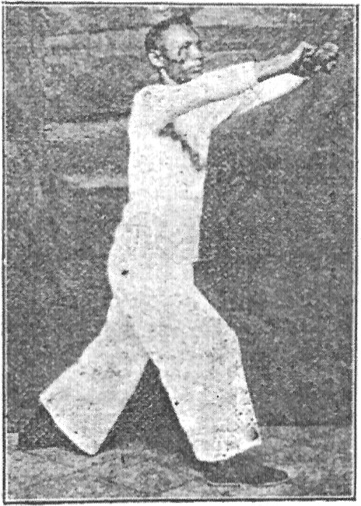
第五十四式
Posture 54
1,名稱……「左蹬脚」此式蹬出為左脚。其名解與第四十一式轉身蹬脚之意義相同。故從畧。
Name: LEFT PRESSING KICK
In this posture, press out with your left foot. The explanation of the name is the same as in Posture 41, and so will not be explained again here.
2,練法……承上式。雙足仍在原處不動。雙拳變為掌。由上分開。手心向外。分至兩手埀直後。卽速兩手手心向上。兩手相合。如捧物之狀。停於胸前。約距離五六寸許。然後雙手一反。雙為手心朝下。往左右而分開。同時即蹬左脚。脚尖向上勾勁。全身重點。坐在右腿。有如白鶴獨立之勢。
Practice method:
Continuing from the previous posture, both feet staying where they are, both fists become palms and spread apart from above, palms outward, until your hands are hanging down, at which point they quickly turn upward and your hands come together as though they are carrying something, stopping about half a foot in front of your chest. Then your hands turn over so both palms are downward and spread apart to the sides as your left foot presses out, toes drawn upward. The weight of your whole body is on your right leg. It is like a posture of a white crane standing on one leg.
3,功用……請參閱第四十一式之「轉身蹬脚」相同。故不另述。
Effects:
Same as in Posture 41, and so will not be explained again here.
4,用法……例如敵勢為我所封閉。不能施展。乘勢以左脚前踢敵人心腹各部。或橫採敵人下陰。其餘悉與第四十一式相同。不過所蹬之脚。為方向不同也。
Application:
If the opponent tries to seal me off so I cannot move freely, I take advantage of the opportunity to kick forward to his chest or abdomen, or go across [with my right hand] to pluck his groin. The rest is the same as in Posture 41, but the direction of the kick is different.
5,姿勢……如第五十四式。第五十七圖。是也。
For this posture, see photo 57 [unfortunately merely a repeat of photo 47 and thus not exhibiting the uprightness of the toes]:
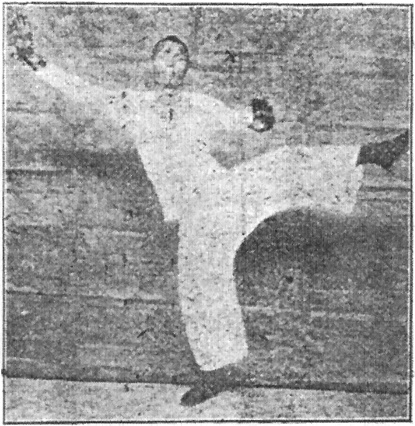
第五十五式
Posture 55
1,名稱……「轉身右蹬分脚」此式之動作。為轉身之後。始再蹬右脚分開。故得是名。
Name: TURN AROUND, RIGHT PRESSING KICK TO THE SIDE
In this posture’s movement, after you have turned around, begin another pressing kick with your right foot spreading away to the side, thus the name.
2,練法……承上式。左足落下。往右轉身。左足即靠攏右足。同時右足尖在原位稍轉向北。同時兩手又往上圓轉而下。再往上相合。手心朝上。如捧物狀。又即往左右分開。分時手心向下。同時提起右脚。往前方蹬出。眼看右手平視。分脚時。身體不可擺動。是為至要。
Practice method:
Continuing from the previous posture, your left foot lowers, your body turning around to the right, and your left foot closes up with your right foot. At the same time, your right toes, staying in the same place, slightly pivot around to point to the north. Also at the same time, your hands go upward and circle downward to again come together, palms up as though carrying something. Then they again spread apart to the sides, palms down, as your right foot lifts and presses out forward. Your gaze is level toward your right hand. When kicking to the side, your body must not sway. This is extremely important.
3,功用……與第四十八式。「右斜蹬脚」相同。故不另述。
Effects:
Same as in Posture 48, and so will not be explained again here.
4,用法……此式之用法。與上式所差者為一轉身耳。例如前式。我脚未能攻着敵人。彼即乘我脚下時。突然襲擊。我即速變換步法。轉身又用右脚蹬去。右手之用法。上文業已述及矣。
Application:
For this posture’s method of application, the difference with the previous posture is the turning around. If in the previous posture I could not connect to the opponent with my foot and he takes advantage of the moment I lower my foot to make a sudden attack, I quickly step to switch my feet and turn around to again press out, now with my right foot. The use of my right hand has already been addressed in the previous explanation.
5,姿勢……如第五十五式。第五十八圖。是也。
For this posture, see photo 58 [unfortunately merely a repeat of photo 45 and thus not exhibiting the uprightness of the toes]:
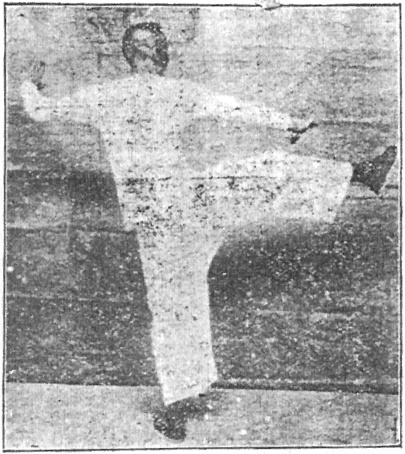
第五十六式
Posture 56
「上步搬攔捶」詳見第十五式。完全一切相同。
STEP FORWARD, PARRYING-BLOCK PUNCH – Same as Posture 15.
第五十七式
Posture 57
「上步指襠捶」詳見第十六式。完全相同。(按)進步與上步。同一動作也。
STEP FORWARD, PUNCH TO THE CROTCH – Same as Posture 16. (Note: [Though it is called] “advance” [in Posture 16] and “step forward” here, they are the same movement.
第五十八式
Posture 58
「如封似閉」詳見第十七式。完全一切相同。
SEALING SHUT – Same as Posture 17.
第五十九式
Posture 59
「十字手抱虎歸山」詳見第十八式。及第十九式。完全一切相同。
CROSSED HANDS, CAPTURE THE TIGER TO SEND IT BACK TO ITS MOUNTAIN – Same as Postures 18 & 19.
(注意)
太極拳之動作。由第一式起。至第五十九式止。是為上半蹚。
Note:
From Posture 1 to Posture 59 constitutes the first half of the set.
第六十式
Posture 60
「探海迎面掌」詳見第二十式。完全一切相同。
SEARCHING THE SEA, PALM STRIKE TO THE FACE – Same as Posture 20.
第六十一式
Posture 61
「攬雀尾」詳見第二十一式。完全一切相同。
CATCH THE SPARROW BY THE TAIL – Same as Posture 21.
第六十二式
Posture 62
1,名稱……「斜單鞭」此式之動作。與第五式之「單鞭」。意義相同。惟此式方向。稍有變更。其步法為斜移右方。故名。其餘悉與第五式相同。請參閱上文。便明白矣。
Name: DIAGONAL SINGLE ROD.
This posture’s movement is the same idea as in Posture 5, except here the direction is slightly changed and its footwork is diagonal toward the right, thus the name. The rest is the same as in Posture 5, and you may refer to the earlier explanation to more easily understand.
2,練法……承上式。其過渡法與第五式之「單鞭」(一)圖。解。均同。故從畧。但右手變鈎之後。左足與右足靠攏。又右足尖在原地稍移。當此時。全身重點。坐在右腿。此斜單鞭。(一)圖。練法之解說也。然後左足往前邁出一步。與右足成一直線。是為左弓式。同時左手掌由右肩直向左足上方。擰翻推出。作半圓形。左。手須有立樁。虎口要圓。左手與左足。同一方向。右手仍為勾形。眼往左手前平視。此式亦須。(一)(二)两動作連貫不可分散或停滯。
Practice method:
Continuing from the previous posture, its transition is the same as in the explanation for the first photo in Posture 5, and so will not be explained again here, but after your right hand makes a hook and your left foot closes toward your right foot, your right toes are slightly shifted from their original position [to point slightly more toward the west], the weight of your whole body sitting on your right leg. This much is the first part of DIAGONAL SINGLE ROD. Then your left foot steps out forward [to the southwest], making a line with your right foot, into a bow stance. At the same time, your left palm goes from your right shoulder to be directly above your left foot, twisting around to push out forward, making a semicircle. Your left hand must be upright, its tiger’s mouth should be rounded, and it is in the same direction as your left foot. Your right hand maintains its hook shape. Your gaze is forward, looking level toward your left hand. The two movements in this posture must be without interruption or stagnation.
3,功用……此式之功用。與第五式相同。故不另述。
Effects:
Same as in Posture 5, and so will not be explained again here.
4,用法……詳見第五式。不過此式為向着斜角而使用之。解與上同。
Application:
Same as in Posture 5, but this time employed to the corner.
5,姿勢……如第五式之(一)圖。及第六十二式之五十九圖(二)。是也。
For this posture, review photo 11 and see photo 59:

第六十三式
Posture 63
1,名稱……「左右野馬分鬃」是式分為三式。卽言兩手向外撥開。兩臂開合。宛如與馬分開頭上之鬃毛展向左右。所謂野馬者。取其散蕩無拘之意也。
Name: LEFT & RIGHT WILD HORSE VEERS ITS MANE
This posture is divided into three movements. Your hands will spread apart to the sides, your arms opening and closing, just like the mane on a horse’s head going from side to side, and so it is called a wild horse, and the intention is to adopt its manner of playing freely.
2,練法……承上式。如三字式斜單鞭相同。惟方向異耳。右手隨腰往左。與左手相合。右手在下。手心向上。左手在上。手心向下。全身重點坐在左腿上。右足提起。往西北伸去。右手隨右足往西北分開。在上之左手。同時往東南分開。在下右手手心仍向上。左手心仍向下。是時全身坐在右腿。眼睛亦向西北平視。此式之動作。若斜飛式。惟其步不同。但練時須連演三次。即右左右。幷須一氣貫串。腰胯手足。均要舒展圓活。
Practice method:
Continuing from the previous posture, it will be the same “triple-line” stance [the line one foot stands on, the line the other foot stands on, and the line running between the feet] of DIAGONAL SINGLE ROD, except the orientation is different [the lines running toward the northwest]. Your right hand goes along with your waist to the left and closes together with your left hand, your right hand below, palm up, left hand above, palm down. The weight of your whole body sitting on your left leg, your right foot lifts and extends to the northwest. Your right hand below goes along with your right foot by spreading away to the northwest, your left hand above at the same time spreading away to the southeast. Your right palm is still up, left palm still down. The weight is now on your right leg. Your gaze is level to the northwest. The posture’s movement is similar to DIAGONAL FLYING POSTURE, except the stepping is not the same [advancing rather than turning], and when practicing, you must continue so that it is performed three times – right, left, right – and it must be a continuous flow throughout. Your waist, hip, hand, and foot should all extend nimbly.
3,功用……詳見第四式攬雀尾之(一)棚式。及之(二)棚式。故不另詳。
Effects:
Same as in Posture 4, parts 1 & 2, and so will not be explained again here.
4,用法……如敵繞擊我左面。我卽以右手順牽敵向左。幷進左步拌敵腿。同時以左手向敵人脇下橫挑之。此用法為左式而言。蓋左右均同。惟方向不同耳。
Application:
If an opponent does a coiling strike to my left side, I then use my right hand to go along with him and tug him to the left [by blocking to the left – the closing action of the arms], and I advance my left foot to confuse his legs, at the same time using my left hand to carry across toward his lower ribs [with the opening action of the arms]. This is the application for the left side. On either side it is the same, except the orientation is different.
5,姿勢……如第六十三式。第六十圖(一)。是也。
For this posture, see photo 60:

換式
[Posture 63’s Method of] Switching Sides
1,名稱……詳見上文。故不再述。
Name:
Same as above, and so will not be explained again here.
2,練法……承上式。左手隨腰往右。與右手相合。左手在下。右手在上。左手手心朝上。右手手心朝下。左足提起。往西南邁去。左手在下。隨左足往西南分開。右手在上。同時往東北分開。眼睛隨向西南平視。其餘與上勢之練法大致相同。(從畧)
Practice method:
Continuing from the previous posture, your left hand goes along with your waist to the right and closes together with your right hand, your left hand below, right hand above, left palm upward, right palm downward. Your left foot lifts and extends to the southwest. Your left hand below goes along with your left foot by spreading away to the southwest. Your right hand above at the same time spreads away to the northeast. Your gaze follows along to look level to the southwest. The rest is mostly the same as in the above explanation (and so will not be repeated here).
3,功用……詳見第四式攬雀尾之(一)(二)兩節。請參閱上文。便明白矣。
Effects:
Same as in Posture 4, parts 1 & 2. You may refer to the earlier explanation to more easily understand.
4,用法……詳見上文。故不再述。
Application:
Same as the above explanation, and so will not be repeated here.
5,姿勢……如第六十三式。第六十一圖(二)。是也。
For this posture, see photo 61:
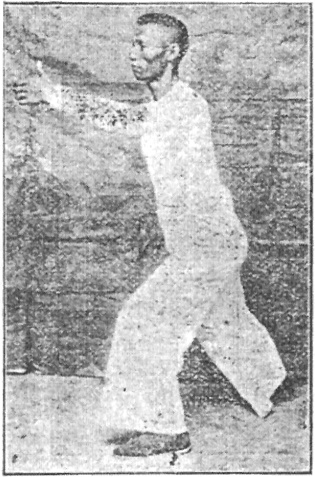
(按)此式練完之後。重又連接為野馬分鬃(一)之姿勢。便合。是即第(三)式也。
Note:
After you have performed this side, the first side repeats, making the third part of this posture.
第六十四式
Posture 64
1,名稱……「上步攬雀尾」詳見第四式之各節。完全相同。
Name: ADVANCE, CATCH THE SPARROW BY THE TAIL
Same as in Posture 4.
2,練法……承上式。左足向前伸半步。左手隨左足。同時向南捧出。右手肘微曲。手心向下。左手伸出。畧有往下墜肘之意。再次則左手往左後方兜上。手心向上。右手畧向北圓轉。手心向下。停在左肩前。同時上右脚一步。雙目向左手平視。然後動作相反。右手往囘右方。繼續再掤。捋。擠。按。便成為攬雀尾矣。
Practice method:
Continuing from the previous posture, your left foot extends a half step forward, your left hand going along with your left foot by propping outward to the south, your right arm slightly bending its elbow, palm down. As your left hand extends, there is an intention of slightly dropping the elbow. [The photo below shows the posture up to this point.] Then your left hand goes to the left rear, wraps upward, palm up, your right hand slightly arcing to the north, palm down, and arrives in front of your left arm. At the same time, take a step forward with your right foot, your gaze level toward your left hand. [At this point, the posture is now as in photo 39.] Then the movement reverses, your right hand returning to the right, and continue with ward-off, rollback, press, and push to complete CATCH THE SPARROW BY THE TAIL.
3,功用……詳見第四式之各節。完全一切相同。
Effects:
Same as in Posture 4.
4,用法……此式之用法。為敵人向我胸部一拳打來。我卽身往後微涵。同時。以左手托其肘下。幷以右手按住其拳。則彼不能進傷我。設此式我稍用力。則敵肘必脫臼。其餘又與第四式同。故從畧。
Application:
If an opponent punches toward my chest, I slightly hollow it to the rear while using my left hand to prop up his elbow and my right hand to push down his fist, causing him to be unable to advance and harm me. If I use any force at all, his elbow will be dislocated. The rest is the same as in Posture 4, and so will not explained again here.
5,姿勢……如第六十四式。第六十二圖(一)。是也。
For this posture, see photo 62 [followed by photos 39, 6–9, 28, and 10]:
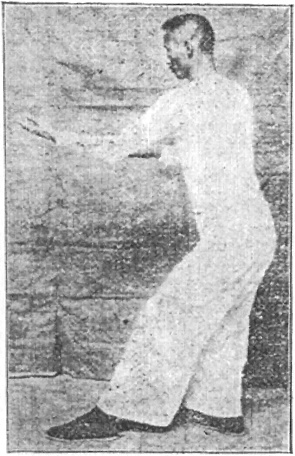
(按)此式又名「上半步」
Note:
This posture is also called HALF STEP FORWARD.
第六十五式
Posture 65
「單鞭」詳見第五式。完全各節相同。
SINGLE ROD – Same as Posture 5.
第六十六式
Posture 66
1,名稱……「轉身抱極式」此言蓋言其身法。向右扭轉。雙手手心上下相對。如抱圓形之太極圖也。故名。
Name: TURN AROUND, HOLDING A TAIJI SPHERE
This indicates your body’s action of twisting around to the right while your palms face each other as though holding a taiji sphere, thus the name.
2,練法……承上式。身向右後轉。雙足作扭步。同時左手往下兜上。手心向上。停在丹田之前。距離約。五六寸許。右手在上。手心朝下。平與右肩齊。停於胸前。距離約五六寸許。兩手手心。上下相對。兩膝微曲。身須正直。腰亦塌住勁。順頂貫項。兩眼向前平視。
Practice method:
Continuing from the previous posture, your torso turns to the right, your feet making a twisting stance. At the same time, your left hand goes down and wraps upward to be palm up, stopping about five or six inches in front of your elixir field. Your right hand is above, palm down, level with your right shoulder, stopping about five or six inches in front of your chest. Your palms are facing each other above and below. Your knees are slightly bent. Your body must be upright and your waist have a sinking energy. Extend your neck and draw up your headtop. Your gaze is forward and level.
3,功用……詳見第十四式之功用相同。故不再述。
Effects:
Same as in Posture 14, and so will not be explained again here.
4,用法……詳見第十四式之用法相同。故不再述。
Application:
Same as in Posture 14, and so will not be explained again here.
5,姿勢……如第六十六式。第六十三圖。是也。
For this posture, see photo 63:

第六十七式
Posture 67
1,名稱……「玉女穿梭」此式之動作分四卽四斜角之方向。而實為四正隅。旋轉八面。往來不斷。身法靈活。如穿機之梭。循環不輟。故名。
Name: MAIDEN WORKS THE SHUTTLE
This posture’s movements are separated into four parts oriented to the four corners, filling the four corner compass points, turning around in all directions, coming and going without pause. Your body’s method is nimble, like the actions of threading a shuttle, recycling without interruption, thus the name.
2,練法……承上式。身往左轉。右足向西南。上前一步。成左弓式。兩足距離約二尺六七寸許。腰塌住勁。同時。左手由下擰翻往頭上架。手心向上。停於距額部約尺許。右掌則由胸前直打出。手心向外。虎口朝上。右手之高度。要與右肩平齊。兩胳膊彎曲。如半月形。丹田吸勁。兩眼向前方平視。
Practice method:
Continuing from the previous posture, your torso turns to the left, your right [left] foot steps forward to the southwest, making a left bow stance. Your feet are about two and two-thirds feet apart. Your waist has a sinking energy. At the same time, your left hand goes from below, twisting over to prop up above your head, palm up, stopping about a foot from your forehead, and your right palm strikes directly forward from your chest, palm outward, tiger’s mouth up, and should be at shoulder height. Your arms are bent into crescent moon shapes. Your elixir field has an energy of drawing back. Your gaze is forward and level.
3,功用……此式是運動胸部臟腑。及推架二勁。習之日久。可免胃痛之患。
Effects:
This posture exercises your chest and organs, as well as the energies of both propping up and pushing out. Practicing it daily can keep you free from stomachache.
4,用法……例如敵人。一拳打來。我即用一手格架。一手還攻擊敵人面部。或敵人突由身後側方擊來。我擰身拗手。以化敵勁。再乘勢進左步。伸掌托捩其腕臂。連用一掌向敵人胸前按擊之。
Application:
If an opponent attacks with a punch, I promptly use one hand to block him upward and the other hand to return a strike to his face. [From here is described the application for part 2:] If an opponent suddenly strikes me from behind, I twist my body around and twist my hand over to neutralize his energy, then take advantage of the momentum to advance with my left [right] foot and extend my palm to prop up and reverse the direction of his wrist or arm while my other palm is doing a pushing strike to his chest.
5,姿勢……如第六十七式。第六十四圖(一)。是也。
For this posture, see photo 64:
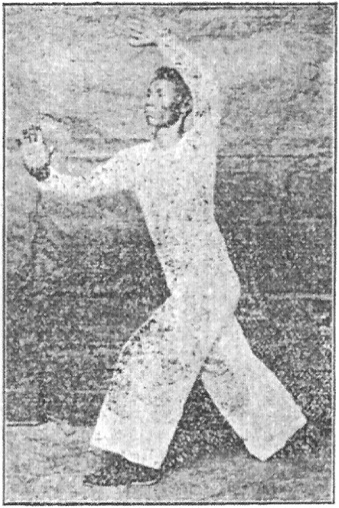
其動作與步法之方向如下。
The orientations for the footwork of these four movements is as below:
1 4
╲ ╱
╱ ╲
2 3
玉女穿梭(之二)
MAIDEN WORKS THE SHUTTLE (part 2)
1,名稱……詳見本式(一)節。故不重述。
Name:
Same as in part 1, and so will not be explained again here.
2,練法……承上式。右足收回。足尖緊靠左足心。同時兩手收囘。手心上下相對。如捧圓球狀。左手在上。右手在下。全身重點在左腿。身往東南轉。右足上前一步。成右弓式。右手由下擰翻。往頭上架。停住。手心向上。同時左手則由胸前直伸出。手心向外。虎口朝上。其餘大致與本式(一)節相同。故從畧。
Practice method:
Continuing from the previous posture, your right foot gathers in, the toes nearing your left instep. At the same time, your hands withdraw so your palms are facing each other above and below as if carrying a ball, left hand above, right hand below. The weight of your whole body sits on your left leg. Your body turns around to the southeast and your right foot steps forward, making a right bow stance. Your right hand goes from below, twisting over to prop up above your head and halts there, palm up. At the same time, your left hand strikes directly forward from your chest, palm outward, tiger’s mouth up. The rest is the same as in part 1, and so will not be explained again here.
3,功用……詳見本式(一)節。故不重述。
Effects:
Same as in part 1, and so will not be explained again here.
4,用法……詳見本式(一)節。故不重述。惟此動作之方向不同耳。
Application:
Same as in part 1, and so will not be explained again here, except this time the orientation is different.
5,姿勢……如本式第六十五圖(二)。是也。
For this posture, see photo 65:
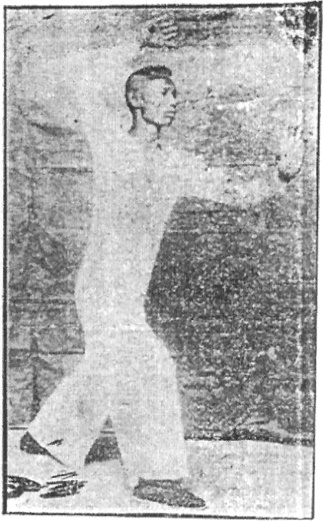
玉女穿梭(之三)
MAIDEN WORKS THE SHUTTLE (part 3)
1,名稱……詳見本式(一)節。故不再述。
Name:
Same as in part 1, and so will not be explained again here.
2,練法……承上式。左足收囘。足尖緊靠右足心。同時兩手收囘。手心上下相對。如捧一圓球狀。右手在上。左手在下。全身重點在右腿。上左足一步。成左弓式。身轉西南。左手由下擰翻而上。至頭頂停着。手心朝上。同時右手仍由胸前往外直伸出。手心向外。虎口朝上。其餘大致與本式(一)節相同。故從畧。
Practice method:
Continuing from the previous posture, your left foot gathers in, the toes nearing your right instep. At the same time, your hands withdraw so the palms are facing each other above and below as if carrying a ball, right hand above, left hand below. The weight of your whole body sits on your right leg. Your left foot steps forward, to make a left bow stance, your torso turning to the southwest [northeast]. Your left hand goes up from below, twisting over, until above your headtop, palm up. At the same time, your right hand extends outward straight from your chest, palm outward, tiger’s mouth up. The rest is the same as in part 1, and so will not be explained again here.
3,功用……詳見本式(一)節。故不再述。
Effects:
Same as in part 1, and so will not be explained again here.
4,用法……詳見本式(一)節。惟方向不同耳。
Application:
Same as in part 1, except the orientation is different.
5,姿勢……如本式。第六十六圖(三)。是也。
For this posture, see photo 66 [merely a repeat of photo 64 and consequently a reversed profile of this particular posture]:
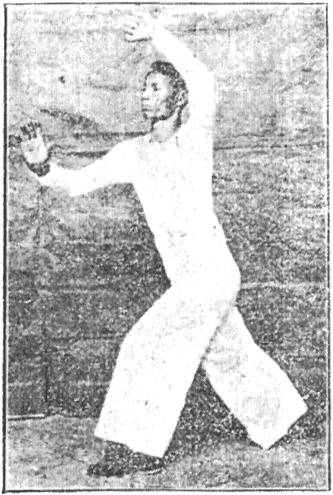
玉女穿梭(之四)
MAIDEN WORKS THE SHUTTLE (part 4)
1,名稱……詳見本式(一)節。故不再述。
Name:
Same as in part 1, and so will not be explained again here.
2,練法……承上式。右足收囘。足尖靠緊左足心。同時兩手收囘。手心上下相對。左手在上。右手在下。如捧一圓球狀。全身重點在左腿。身往西北轉。右手由下擰翻而上。至頭頂停着。手心朝上。同時左手則由胸前。往外伸出。手心向外。虎口朝上。其餘大致與本式之(一)節相同。故從畧。
Practice method:
Continuing from the previous posture, your right foot gathers in, the toes nearing your left instep. At the same time, your hands withdraw so the palms are facing each other above and below, left hand above, right hand below, as if carrying something. The weight of your whole body sits on your left leg. Your body turns around to the northwest. Your right hand goes up from below, twisting over, until above your headtop, palm up. At the same time, your left hand extends outward from your chest, palm outward, tiger’s mouth up. The rest is the same as in part 1, and so will not be explained again here.
3,功用……詳見本式(一)節。故不再述。
Effects:
Same as in part 1, and so will not be explained again here.
4,用法……詳見本式(一)節。惟此動作之方向不同耳。
Application:
Same as in part 1, except this time the orientation is different.
5,姿勢……如本式第六十七圖(四)是也。
For this posture, see photo 67:

(按)此四動作。練時須連貫為一氣。不可停滯。方能輕靈圓活。如穿梳不息之意也。
Note:
When practicing these four movements, it must be a continuous flow without any stagnation. You will then be able to be nimble and lively, like the idea of running a comb through your hair without any hindrance.
第六十八式
Posture 68
「上步攬雀尾」詳見第四式。惟須先上半步。(如六十二圖)。然後則掤。捋。擠。按。各節相同。
STEP FORWARD, CATCH THE SPARROW BY THE TAIL – See Posture 4, except you must first take a half step forward (as in photo 62), then ward-off, rollback, press, and push follow as before.
第六十九式
Posture 69
「單鞭」詳見第五式。各節完全一切相同。故不另述。
SINGLE ROD – Same as Posture 5, and so will not be explained again here.
第七十式
Posture 70
「雲手」詳見第三十六式。各節完全一切相同。故不另述。
CLOUDING HANDS – Same as Posture 36, and so will not be explained again here.
第七十一式
Posture 71
1,名稱……「單鞭下勢」此式乃單鞭連。下勢之動作而成。所謂下勢者。即言左手下沉。同時身腰均往下坐。極力下降。卽低下之形勢也。
Name: SINGLE ROD, LOW POSTURE
The completion of this posture’s movement is called LOW POSTURE. Your left hand sinks down and your body sits down at the same time, putting all its energy into dropping, and thus it is a “lowered posture”.
2,練法……承上勢。由「單鞭」式之後。身體往後極力撤囘。再往下坐。全身重點在右腿上。右膝屈曲。左腿往前伸直。如仆腿式。同時。左手由上方順着左腿抽囘。稍停在左跨前。再順左腿上方伸出。將至左足踝骨停住。右手之勾仍不動。身體不可前俯。頭要有頂勁。兩眼向前平視。
Practice method:
Continuing from the previous posture, after making the SINGLE ROD, your body goes to the rear, putting all its energy into withdrawing, then sitting down. The weight is on your right leg, knee bent, and your left leg is extended forward, as in a pouncing stance. At the same time, your left hand goes from above, withdrawing in the same direction as your left [right] leg, slightly pauses in front of your left hip, then extends over your left leg, pausing as it is about to reach the anklebone. Your right hand’s hook does not move. Your body must not lean forward and your head should have an energy of pressing up. Your gaze is forward and level.
3,功用……此式能使氣往下降。而無呼吸不匀。氣喘面紅之弊。其餘與單鞭式之功用同。
Effects:
This posture can cause energy to sink down and can erase the maladies of uneven breathing or holding your breath until you are red in the face. The rest is the same as in the SINGLE ROD posture.
4,用法……例如敵人打我一拳。我則以單手握其手腕。向斜邊往下一墜。使敵前仆。此用法與海底針相同。所差者。一為直下。一為斜式。如敵往後掙脫。我趁勢前送以擊之。敵不提防。必往後方傾跌矣。
Application:
If an opponent attacks me with a punch, I then use a hand to grasp his wrist and sink down his attack diagonally, causing him to fall forward. This application is the same as NEEDLE UNDER THE SEA. Where it is different lies in that posture going straight down while this one is at a slant. If the opponent goes to the rear, throwing off my grab, I take advantage of the opportunity and strike forward. He will have no defense and inevitably stumble back.
5,姿勢……如第七十一式。第六十八圖。是也。
For this posture, see photo 68:

第七十二式
Posture 72
1,名稱……「左右金鷄獨立」此式一足縣提。一足獨立。蓋鷄與鶴。均有獨立之能。曲肘伸掌。又如金鷄之展翅狀。但分為左右兩種動作。故又名曰左右金鷄獨立。
Name: LEFT & RIGHT GOLDEN ROOSTER STANDS ON ONE LEG
In this posture, one foot is suspended while the other stands on its own in the manner of a rooster or crane, both of which have the ability of standing on one leg. Bending an elbow and extending the palm makes it also like a golden rooster spreading a wing, and as the movement is done on both sides, it is therefore called LEFT & RIGHT GOLDEN ROOSTER STANDS ON ONE LEG.
2,練法……承上式。身腰向前進。隨進隨提右手隨身向上。肘曲與右膝似相連之意。同時提起右腿。提至膝與腰平。足尖稍下埀。右手手心向左。全身重點在左腿上。右手手指。高度與右肩相齊。頭微往前傾。左腿亦微曲。左手下垂曲之意。停在左膀旁。两眼向前平視。如本式(一)圖是也。再次則右腿落下。落時身微後坐。使全身重點。坐在右腿。左手隨左足上提。左膝提至與胯平。左膝與左肘相連。足尖稍下垂。手掌向右。手指朝上。與左眉齊。右手同時往下埀曲之意。停在右胯旁邊。眼亦向前平視。如(二)圖。是也。
Practice method:
Continuing from the previous posture, your body advances. Advancing, it rises, and your right hand goes along with your body upward, the elbow bending and with an intention of coordinating with your right knee. At the same time, lift your right knee until at waist level, toes slightly hanging down. Your right palm is facing toward the left. The weight of your whole body is on your left leg. The fingers of your right hand are at shoulder level. Your head is slightly tilted forward. Your left leg is also slightly bent. Your left hand has an intention of hanging curved, pausing by your left hip. Your gaze is forward and level. It is like the first photo below. Then your right leg lowers, your torso slightly sitting back, causing the weight of your whole body to sit on your right leg. Your left hand goes along with your left foot and lifts, as your left knee lifts up to hip level, coordinated with your left elbow, toes slightly hanging down. Your left palm is facing toward the right, fingers up and level with your left eyebrow [shoulder]. Your right hand at the same time has an intention of hanging curved, pausing beside your right hip. Your gaze is forward and level. It is like the second photo below.
3,功用……此式練習中心穩固。內勁發蓄。不致左右飄搖。幷能靈活腰部。兼可壯其腿部筋絡。有去麻木之功。使手之托勁。均有相當練習之機會。
Effects:
Practicing this posture trains balance and stability, and the issuing and storing of internal power, keeping you from swaying to the sides. It can also make your waist more nimble, can strengthen your leg muscles, is good at dispelling numbness, and will get the energy of propping up to be equal for both hands.
4,用法……例如敵人一掌劈來。我卽以右手托住。或意在挑開敵手。同時再以右足踢其下陰。或用膝蓋上一頂擊敵腹部。均無不可。左右之用法。意義相同。是卽太極拳中之膝打也。
Application:
If the opponent attacks with a chopping palm, I use my right hand to prop it up with the intention of carrying aside his hand. At the same time, I use my right foot to kick to his groin or my knee to smash his belly, either way. Here lies the knee strike in Taiji Boxing. The application on both sides is the same.
5,姿勢……如第七十二式。第六十九圖(一)。及七十圖(二)。是也。
For this posture, see photos 69 & 70:
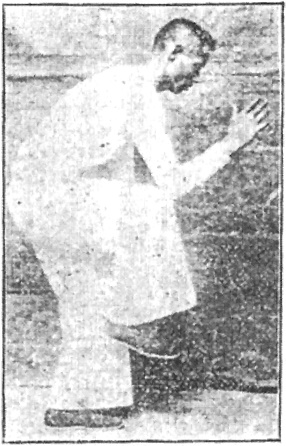

第七十三式
Posture 73
「倒輦猴」詳見第二十三式。完全一切相同。
RETREAT, DRIVING AWAY THE MONKEY – Same as Posture 23.
第七十四式
Posture 74
「斜飛式」詳見第二十四式。完全各節相同。
DIAGONAL FLYING POSTURE – Same as Posture 24.
第七十五式
Posture 75
「提手」詳見第二十五式。完全一切相同。
RAISE THE HANDS – Same as Posture 25.
第七十六式
Posture 76
「白鶴亮翅」詳見第二十六式。完全相同。
WHITE CRANE SHOWS ITS WINGS – Same as Posture 26.
第七十七式
Posture 77
「摟膝拗步」詳見第二十七式。完全各節相同。
BRUSH KNEE IN A CROSSED STANCE – Same as Posture 27.
第七十八式
Posture 78
「海底針」詳見第二十八式。完全一切相同。
NEEDLE UNDER THE SEA – Same as Posture 28.
第七十九式
Posture 79
「扇通臂」詳見第二十九式。完全一切相同。
FAN THROUGH THE ARMS – Same as Posture 29.
第八十式
Posture 80
「白蛇吐信」詳見第三十式。完全各節相同。
WHITE SNAKE SHOOTS OUT ITS TONGUE – Same as Posture 30.
第八十一式
Posture 81
「撇身捶」詳見第三十一式。完全一切相同。
TORSO-FLUNG PUNCH – Same as Posture 31.
第八十二式
Posture 82
「上步搬攔捶」詳見第三十二式。完全相同。
STEP FORWARD, PARRYING-BLOCK PUNCH – Same as Posture 32.
第八十三式
Posture 83
「進步指襠捶」詳見第三十三式。完全一切相同。
ADVANCE, PUNCH TO THE CROTCH – Same as Posture 33.
第八十四式
Posture 84
「進步攬雀尾」詳見第三十四式。完全各節相同。
ADVANCE, CATCH THE SPARROW BY THE TAIL – Same as Posture 34.
第八十五式
Posture 85
「單鞭」詳見第五式。完全各節相同。
SINGLE ROD – Same as Posture 5.
第八十六式
Posture 86
「雲手」詳見第三十六式。完全一切相同。
CLOUDING HANDS – Same as Posture 36.
第八十七式
Posture 87
「單鞭」詳見第五式。完全各節相同。故從畧。
SINGLE ROD – Same as Posture 5, and so will not be explained again here.
第八十八式
Posture 88
1,名稱……「高探馬代穿掌」此式亦名為「左右高探馬」。其意思為連貫而成。除以第三十八式。(一)(二)兩動作外。再加穿掌一動作。共為分為三動作。故得是名。
Name: RISING UP AND REACHING OUT TO THE HORSE, CHANGING TO THREADING PALM
This posture is also called LEFT & RIGHT RISING UP AND REACHING OUT TO THE HORSE, for the idea is to link them together, thus the name. Beyond the two movements in Posture 38, adding the threading palm brings the total for this posture to three movements.
2,練法……承上式。除(一)(二)两動作。詳見第三十八式外。故不再述。右足原地不動。左足往左前方伸出一步。左手同時往前經由右手背上穿出。手心朝上。右手停於左腋下。是式變為左弓式。右手手心朝下。眼向左手上平視。其餘大致詳見第三十八式。請參閱上文。便明白矣。
Practice method:
Continuing from the previous posture, beyond the first two movements, which are the same as in Posture 38 and so will not be explained again here, your right foot stays where it is and your left foot extends a step forward. Your left hand at the same time threads forward over the back of your right hand, palm up, and your right hand stops below your left armpit, palm down. The posture changes to left bow stance. Your gaze is over your left hand, looking level. The rest is the same as in Posture 38, and you may refer to its explanation to more easily understand.
3,功用……與第三十八式相同。惟此式有穿掌。則純練手臂之力耳。
Effects:
Same as in Posture 38, except here there is a threading palm, which simply improves the skillfulness of your [left] arm.
4,用法……此用法與第三十八式相同。至於穿掌之用。例如敵人前勢為我所敗。又再一拳打來。我卽以右手往下壓按其拳。左掌則直伸。而向敵人咽喉部位進攻也。
Application:
Same as in Posture 38, until the threading palm. If the opponent comes forward to strike me where I have left a gap, I then use my right hand to press down his fist and extend my left hand to attack his throat area.
5,姿勢……如第三十八式。第(一)(二)兩圖。及第八十八式。第七十一圖(三)。是也。
For this posture, see photo 71:
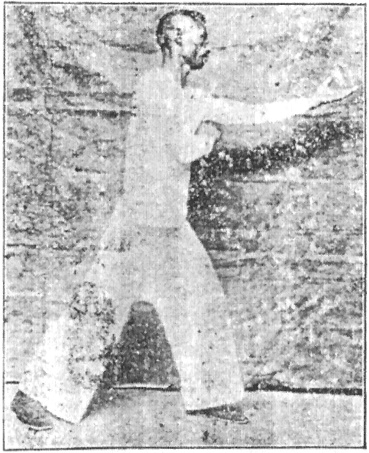
第八十九式
Posture 89
1,名稱……「右轉身蹬脚(十字腿)」此式之動作。與第四十式。第四十八圖相同。但方向一為正面。一為背面。所不同耳。其餘大致亦一樣。故從畧。請參閱上文。便明白矣。
Name: TURN TO THE RIGHT, PRESSING KICK (KICKING WITH THE OPPOSITE HAND FORWARD)
This posture’s movement is the same as in Posture 40, photo 48, except here your torso is squared to the front, whereas in the other you were squared to the rear, so it is not identical. The rest is mostly the same [apart from left and right being reversed], thus there is no further explanation here, and you may refer to the earlier explanation to more easily understand.
2,練法……承上式。坐實左腿。往右轉身。(囘頭)右手由左臂之下穿出。手心朝下。左手往囘右方。作十字形。擰轉手心朝下。然後兩手心皆朝外。在頭上往左右分開。同時提起右脚往囘頭蹬去。全身重點。坐在左腿上。眼隨向西看。足尖同時轉向南方。轉時切忌搖擺。至要。至要。
Practice method:
Continuing from the previous posture, sit fully on your left leg and turn around to the right (turning your head), your right hand threads out from below your left arm, palm down, as your left hand draws back toward your right side, also turning its palm down, so they are now making an X shape. Then the palms turn outward, go above your head, and spread apart to the sides. At the same, your right foot lifts and presses out in the direction you have turned your head. The weight of your whole body is sitting on your left leg. Your gaze is to the west. Your [left] toes at the same time are turned to point to the south. When turning around, absolutely avoid swaying. This is incredibly important.
3,功用……此式為練習轉身穩力。幷手足往外伸蹬之勁。
Effects:
This posture trains stability in turning, as well as developing the energy of extending and pressing outward in your hands and feet.
4,用法……例如敵人。向我面前一拳打來。我卽轉身。用右手撥開敵之右手。使其落空。幷用右脚蹬敵腰脇等處。
Application:
If an opponent tries to punch me from in front [behind], I promptly turn around and use my right hand to push aside his right hand, making his attack land on nothing, while using my right foot to press his waist or flank.
5,姿勢……如第八十九式。第七十二圖。是也。
For this posture, see photo 72:

(按)此式亦有人名之曰十字腿。蓋當其轉身之後。即以右手拍右脚面作嚮。但多數之人。練時甚少拍脚。然拍與否。均不成問題也。故幷誌之。以供研究云爾。
Note:
Some people call this posture KICK WITH THE OPPOSITE HAND FORWARD because after turning around, they use their right [left] hand to audibly slap the top of their right foot. But many when practicing rarely slap the foot. Whether you slap or not does not really matter, but keep it in mind for the sake of others who are studying.
第九十式
Posture 90
「落步搬攔捶」此式將落步時擰脚。繼以搬攔捶。其餘與第十五式相同。故不重述。
COME DOWN, PARRYING-BLOCK PUNCH – This posture comes down with the foot turned out, continuing into the parrying-block punch, but the rest is the same as in Posture 15, and so will not be explained again here.
第九十一式
Posture 91
「上步指襠捶」詳見第十六式。完全一切相同。故不另述。
STEP FORWARD, PUNCH TO THE CROTCH – Same as Posture 16, and so will not be explained again here.
第九十二式
Posture 92
「進步攬雀尾」詳見第八十四式。完全各節相同。
ADVANCE, CATCH THE SPARROW BY THE TAIL – Same as Posture 84.
第九十三式
Posture 93
「單鞭下勢連」詳見第七十一式。完全一切相同。
SINGLE ROD CONTINUING INTO LOW POSTURE – Same as Posture 71.
第九十四式
Posture 94
1,名稱……「上步七星」此式之動作。雙拳交加。如十字形。停在胸前。右足上前。脚趾翹起。技擊界謂之七星勢。亦如少林之所謂踏中宮也。
Name: STEP FORWARD WITH THE BIG DIPPER
In this posture’s movement, your fists cross to make an X shape, stopping in front of your chest, and your right foot steps forward, toes raised. In martial arts, this is called the Big Dipper posture, and in Shaolin it is called “stepping into the central palace”. [This comment is slightly puzzling. In Northern Shaolin’s ten sets, the several mentions of a Big Dipper pose apply only to the posture of the arms and have nothing to do with the stance. Also, there seems to be no mention in Gu’s Shaolin curriculum of a “central palace” technique, and so it may be possible he is describing something from a broader Shaolin perspective that he did not necessarily represent in his teaching, but that may have been familiar to other Shaolin practitioners to whom he was now teaching Taiji.]
2,練法……承上式。兩手變為拳。右拳則由後自下而上。在左手腕外。左手則在內。如交加十字形。高與肩齊。两肘皆曲。兩拳眼向自己身。距離胸前約尺許。同時並上右足成虛式。脚跟着地。脚尖向上。身體後坐。全身重點在左腿。两眼向前面平視雙拳。腰仍塌勁。則氣自然沉貫丹田矣。
Practice method:
Continuing from the previous posture, your hands become fists, your right hand going up from the lower rear to the outside of your left wrist, your left hand on the inside as they cross to make an X shape at shoulder level. Your elbows are both bent and the fist eyes are toward yourself, about a foot away. At the same time, your right foot steps forward to make an empty stance, heel touching down, toes up. Your body is sitting back, the weight of your whole body on your left leg. Your gaze is forward, looking level toward your fists. Your waist maintains a settling energy, causing energy to naturally sink to your elixir field.
3,功用……此式是運動腿胯之力。與雙拳往上架迎之功。
Effects:
This posture exercises the strength of your legs and hips, as well as the skill of propping up with both fists.
4,用法……如敵人一拳打來。我用雙拳作十字形。往上架格之。同時並起右足。向敵人之腿還擊之。
Application:
If the opponent attacks me with a punch, I use both fists to make an X shape, propping upward to obstruct him. At the same time, I lift my right foot with a countering attack to his leg.
5,姿勢……如第九十四式。第七十三圖。是也。
For this posture, see photo 73:
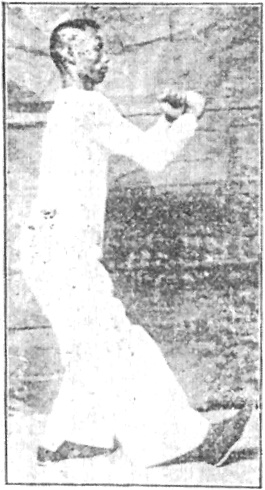
第九十五式
Posture 95
1,名稱……「退步跨虎」此式卽承前式退一步。身往後坐。兩手分開。形如跨虎。退步者。由上步七星勢。而後退為跨虎式之謂也。
Name: RETREAT TO SITTING TIGER POSTURE
This posture continues from the previous posture by retreating a step, your body sitting to the rear, your hands spreading apart. The shape resembles a sitting tiger. The retreat is coming from the posture of STEP FORWARD WITH THE BIG DIPPER, but the retreating posture is called SITTING TIGER POSTURE.
2,練法……承上式。右足退後一步。左足由實而變為虛式。右腿彎曲。全身之重點。皆在於右腿上。同時兩手輕擊右腿上。然後往上下分開。右手在上。手心朝外。左手在下。手心朝後。身體亦隨着舒展。兩眼向前平視。右胳膊亦彎。右手高與頭齊平。左胳膊往下埀。停在左胯旁稍離開。丹田抱勁。頭頂項竪。身不可前仰。
Practice method:
Continuing from the previous posture, your right foot retreats a step, your left foot changes from full to empty, your right leg bending, and the weight of your whole body sits on your right leg. At the same time, your hands lightly strike your right thigh, then spread apart above and below, right hand above, palm outward [although the photo is showing palm inward], left hand below, palm to the rear, and your body is spreading open along with them. Your gaze is forward and level. Your right arm is bent, the hand level with your head. Your left arm is hanging down, pausing beside your left hip at a slight distance from it. Your elixir field has an energy of containing, your head presses up, your neck is straight, and your body must not lean forward.
3,功用……此式是運動腦部之開力。與及腰部之閃力。並往下之塌勁。
Effects:
This posture exercises mental awareness and the dodging ability of your waist, as well as training sinking energy.
4,用法……例如敵人。以腿踢來。我則用手將敵之腿撥開。又復退步。使其腿踢空。此卽是閃避之方法也。
Application:
If the opponent attacks me with a kick, I then use my [left] hand to deflect his leg aside while retreating, causing his kick to land on nothing. This is an evasion technique.
5,姿勢……如第九十五式。第七十四圖。是也。
For this posture, see photo 74:

(按)此式之動作。與第七式之「白鶴亮翅」。形狀相似。而練時動作不同也。
Note:
This posture’s movement is similar in shape to Posture 7 – WHITE CRANE SHOWS ITS WINGS [and in fact the same photo was reused for this posture], but the movement is not the same.
第九十六式
Posture 96
1,名稱……「轉身擺蓮」此式轉身者。卽言其身轉動。擺蓮者。卽言其手足相連。而往外擺去也。故名。(但此轉身擺蓮。是由正前方起足而不落地。仍轉至正前面。然後往外擺踢其足也。)
Name: TURN AROUND, SWINGING LOTUS KICK
This posture turns, meaning your body turns around. By “swinging lotus kick” is meant that your hands and feet connect while swinging outward, thus the name. (But this is the swinging lotus kick turning around, so instead of facing forward and lifting your foot then bringing it down, turn to again face forward and then swing your foot outward with a kick.)
2,練法……承上式。左足往右套步。左手往左後方托上。左手下按右足尖向南西。手心向下。轉動全身亦隨之往右轉一圓週落下正面。坐實左腿。两手隨身而轉。右手上托。手心向上。左手下按。手心向下。隨轉隨合。此式面向東。右足提起。由左擺右。兩手同時由右擺左。當足手均在正面相遇時。兩手先後連拍右脚。即連嚮兩聲。故又有人名之曰「轉身雙擺蓮」也。
Practice method:
Continuing from the previous posture, your left foot takes a covering step to the right, your left hand props up to the left rear and your left [right] hand pushes down, palm down, your right toes turning to point southwest. Turn your whole body around in a complete circle, coming down to face directly forward, and sit on your left leg. Your hands go along with your body’s turn, right hand propping up, palm up, left hand pushing down, palm down, and during the turn, come together. You are now facing east. Your right foot lifts and swings from left to right. Your hands at the same time go from right to left. Right when your hands and foot meet, your hands audibly slap the foot in quick succession. Therefore some people call it TURN AROUND, DOUBLE-SLAP SWINGING LOTUS KICK.
3,功用……此式是運動胯部骨節。與足部之旋轉力。
Effects:
This posture works your [right] hip joint and your foot’s ability in spinning.
4,用法……例如敵人。用槍刀棍等械打來。我用擺蓮腿。踢其手腕。使之受傷。則不能握兵器矣。
又或敵人由側面擊來。我退左足撤左手。轉身閃避。趁勢起右脚。橫踢敵人脇部。
Application:
If an opponent attacks me by wielding a weapon such as a spear, saber, or staff, I use a swinging lotus kick to kick his wrist, injuring him so he is unable to grasp his weapon. Or if an opponent attacks me from the side, I retreat my left foot and withdraw my left hand, turning my body to evade it, and taking advantage of the momentum to lift my [right] foot and kick across to his ribs.
5,姿勢……如第九十六式。第七十五圖。是也。
For this posture, see photo 75:
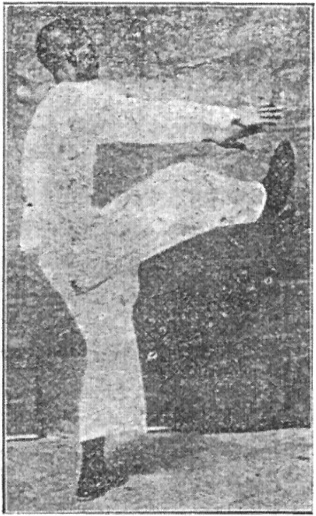
第九十七式
Posture 97
1,名稱……「彎弓射虎」此式右手在右耳前。左手往前伸出。狀如我國古代武士之彎弓射箭形態。故名。
Name: BEND THE BOW TO SHOOT THE TIGER
In this posture, your right hand is in front of your right ear, left hand extended forward, in the manner of our nation’s ancient warriors when they drew a bow to fire an arrow, thus the name.
2,練法……承上式。右足將落時往橫方落步。成右弓式。左腿蹬直。兩手隨腰往前方下捋引之意。然後由下又圓轉而上。轉向東北(正面)兩手仍握拳。左拳往前用意推勁。肘微下垂。手虎口朝上。右手則同時轉至右頭上。與額距離約七八寸許。拳心向上。全身重點。坐在右腿上。兩眼向前平視。两胳膊彎曲。前推後拉。均用暗勁。又如開弓之意也。
Practice method:
Continuing from the previous posture, when your right foot is about to come down, step it down to the side into a right bow stance, left leg pressing straight. Your hands go along with your waist, going forward and downward with an intention of pulling in, then from below again arc upward, arcing toward the northeast (which is now directly in front of you). Your hands then grasp into fists, your left fist goes forward with the intent of a pushing energy, elbow slightly hanging down, tiger’s mouth upward, and your right hand at the same time arcs until about seven or eight inches above the right side of your forehead, the center of the fist upward [to the right]. The weight is on your right leg. Your gaze is forward and level. Both arms are bent, the forward arm pushing and the rear arm pulling, both using a concealed energy. It is like the intention of drawing a bow.
3,功用……此式為運動右腰與背頂及腿之伸縮力也。又能壯健身軀。而無腰酸腿軟之病。
Effects:
This posture exercises the bracing outward of the right side of your waist and back, and the flexibility of your legs. It also can strengthen your body and erase the maladies of backache and weakening legs.
4,用法……此式是化勁。若我將敵手握住。敵必思掙脫。我則乘其重心往外傾時。順勢用力將敵放勁。彼必跌出。若敵握我左手。則我立用在上之拳。還擊之。同時身手幷進。敵雖欲逃。然已不及矣。
Application:
This posture is a neutralizing technique. If I am about to grab the opponent, he will want to throw it off, so I take advantage of his center of balance as he leans outward in doing so, seizing the moment and applying power as he is about express his. He will inevitably stumble away. If he then grabs my left hand, I vertically apply my upper fist to counter with a punch, my body and hands advancing in unison. Even if he wishes to escape, it will already be too late.
5,姿勢……如第九十七式。第七十六圖。是也。
For this posture, see photo 76:
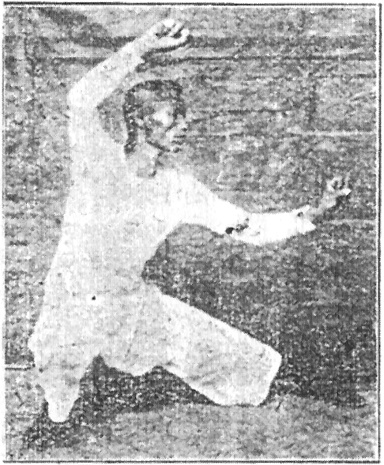
第九十八式
Posture 98
「上步搬攔捶」由射虎式。右手向後鬆。手心朝上。左手向右鬆。手心朝下。兩手相合。卽往後引拉之意。再次由後圓轉而前。擰右脚變為上步搬攔捶。其餘均與第十五式。各節相同。故不另述。
STEP FORWARD, PARRYING-BLOCK PUNCH – From the SHOOT THE TIGER posture, your right hand loosens to the rear, palm up, and your left hand loosens to the right, palm down, your hands coming together and going to the rear with an intention of drawing in. Then from the rear they circle forward as you step forward with your right foot turned out to perform STEP FORWARD, PARRYING-BLOCK PUNCH. The rest is the same as in Posture 15, and so will not be explained again here.
第九十九式
Posture 99
「進步指襠捶」詳見第十六式。完全各節相同。故不另述。
ADVANCE, PUNCH TO THE CROTCH – Same as Posture 16, and so will not be explained again here.
第一百式
Posture 100
「如封似閉」詳見第十七式。完全一切相同。故不另述。
SEALING SHUT – Same as Posture 17, and so will not be explained again here.
第一百零一式
Posture 101
「十字手」詳見第十八式。完全各節相同。故不再述。
CROSSED HANDS – Same as Posture 18, and so will not be explained again here.
第一百零二式
Posture 102
「抱虎歸山」詳見第十九式。完全一切相同。故不另述。
CAPTURE THE TIGER TO SEND IT BACK TO ITS MOUNTAIN – Same as Posture 19, and so will not be explained again here. [There is no explanation provided for why these two postures are again divided into two when in 51 and 59 they were combined, nor is there any explanation for why they would be either divided or combined in the first place. A more natural movement count for this set would perhaps be 105 or 101 rather than 103.]
第一百零三式
Posture 103
1,名稱……「合太極」收式。此式之動作。由上式抱虎之後。然後兩手按下。為太極拳最末之一式。表示練完收式。還本歸原。亦即精。氣。神。相合之意。故名為「合太極」者也。
Name: MERGING WITH THE GRAND POLARITY
This is the closing posture. Its movements continue from the preceding posture. After CAPTURE THE TIGER, your hands then push down, making the final posture in the set. The performance concludes by returning to its original condition, and there is also the idea of essence, energy, and spirit merging with each other, thus the name.
2,練法……承上式。兩手上抱。手心朝上。捧至胸前。同時兩手擰翻。手心向下。右足橫移左半步。寬與肩齊。身亦同時有上昇之意。一上一下。須同時動作。如合太極。(一)圖。迄至身己立直。兩手亦下埀直。手指向下。分停在左右兩胯旁邊。兩眼均往前平視。氣貫丹田。心中仍空空洞洞。無思無慮。還本歸原。如(二)圖是也。是卽收式之姿勢也。
Practice method:
Continuing from the previous posture, your hands embrace upward, palms up, propping up in front of your chest. Your hands then turn over so the palms are downward and your right foot shifts over a half step so your feet are shoulder width. Your body at the same time has a rising intention. Up [goes your body] and down [goes your hands], they must move simultaneously. It is like the first photo below. As soon as your body is standing straight, your hands are hanging straight, fingers down, halting beside each hip. Your gaze is forward and level. Energy going into your elixir field, your mind again emptying to have no thoughts or considerations, returning to its original state. It is like the second photo below. This is the closing posture.
3,功用……與第一式之功用相同。
Effects:
Same as in Posture 1.
4,用法……與第一式之用法相同。
Application:
Same as in Posture 1.
5,姿勢……如第一百零三式。第七十七圖(一)。與及第七十八圖(二)是也。
For this posture, see photos 77 & 78 [78 being a repeat of photo 1]:

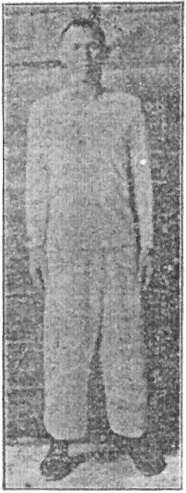
(按)由第六十式起。至第一百零三式止。是為下半蹚。
Note:
From Posture 60 to Posture 103 constitutes the second half of the set.
–
末論
AFTERWORD [TO THE BOXING SET]
凡練太極拳。自始至終。須神不外散。氣不外走。方能得着此中玄妙。以上所述太極拳之練法。功用。用法。等等。僅畧言其大槪耳。蓋拳脚功夫。變化無窮。不能執一而論。語云「熟能生巧」。又云「業精於勤」。學者習之有恆。用心研究。自能舉一反三也。
(注意)第二章之太極拳術詳解。(已完)
Always when practicing the Taiji Boxing solo set, from start to finish your spirit must not disperse nor energy leak away, and then you will be able to obtain its subtleties. The explanations above for its practice methods, effects, applications, and so on, are only brief words for conveying a general idea. Fighting skill is a matter of transforming limitlessly and cannot be condensed to such descriptions. As the saying goes: “Practice makes perfect.” It is also said: “The essence of the endeavor is work.” If you practice with constancy and study diligently, then you will naturally get a lot from a little. Here ends Chapter Two.
–
第三章 太極拳推手法
CHAPTER THREE: TAIJI BOXING’S PUSHING HANDS METHODS
–
(一)太極拳「推手」之講義
1. TAIJI BOXING’S PUSHING HANDS CURRICULUM
太極拳術之練法。可分之為二。卽練架子與練推手是也。推手者。為二人或三人互相推手也。如練架子純熟之後。則應繼續研究推手。以求懂勁。而達實用。猶讀書必習作文也。夫練習架子。為知已功夫。在推手時。為知彼功夫。孫子曰。知已知彼。百戰百勝。可見「推手」一項。亦佔有重要之位置。豈可忽哉。然推手本無定勢。由掤。捋。擠。按。採。挒。肘。靠。等式。千變萬化。循環不己。如環之無端。又非如他種拳術。而有固定方法者可比。惟初學推手時。須照本書推手方法。依其次序而習之。萬勿躐等。則日久功到自然成矣。
吾人在敎授初學推手時。必先使其明瞭內容。何者為掤。何為者捋。如對方用擠或按攻來。須用何式何法以化之。庶免臨時思索。則事半功倍。更不宜任意發勁。令初學者。受傾跌之痛苦。否則彼懷畏懼之心理。裹足不前。則國術普遍之功。俟諸何日。迄至推練有相當根基。酌量發勁而試騐之。尤未為晚也。蓋非如是辦法。不能引起學者興趣。凡我同志。以為然否。
故練習推手。須依照太極拳論之範圍。切勿隨便做去。而成為病手。迨至純熟。最好與程度相等者研究。互相琢磨。最為有益。如隨便畫圈揉手。以致勁別不分。而養成滑手之病。墊攔之弊。茲再將太極拳論。以分析方法詳述之。說明其必須之規矩如左。
The training method in the Taiji boxing art can be divided into two parts: practicing the solo set and practicing the pushing hands. Pushing hands is when two people, or even three, are pushing each other with their hands. Once you have become skillful in the practice of the solo set, you should then continue your study with pushing hands in order to identify energies and reach the level of practical application. For an analogy, you have to practice writing in order to learn how to read well. Training the solo set is the practice of knowing the self. When pushing hands, it is the practice of knowing the opponent. Sunzi said [Art of War, chapter 3]: “Knowing both self and opponent, in a hundred battles you will have a hundred victories.” This can be seen in any example of pushing hands. Since it occupies such an important position, how can it be overlooked?
Pushing hands did not originally have fixed postures. It came from the techniques of ward-off, rollback, press, push, pluck, rend, elbow, and bump, constantly transforming, going round and round without end like a limitless circle. While it is not like other kinds of boxing arts, it is comparable in that it has fixed methods. During the beginning of learning pushing hands, the methods in this book should be complied with, practicing according to the sequence. On no account are steps to be skipped, and then in the course of time, skill will naturally develop.
When we teach beginners pushing hands, we must first clarify its contents. What is ward-off? What is rollback? If an opponent attacks using press or push, what technique or method must be used to neutralize it? By taking time to deeply ponder, twice the effect will be gained for half the effort. It is not appropriate to be just willfully issuing power.
Beginners must endure being thrown, which will keep them from being fearful and hesitant to go forward, and this is the whole point of the widespread practice of martial arts. When the day comes that their pushing training has built up a sufficient foundation, discuss how to issue power and have them experiment with it, no matter how long it takes. If we do not proceed in this way, we will be unable to spark the interest of students. My comrades, am I not right?
Therefore when practicing pushing hands, the parameters of Taiji Boxing’s theory must be complied with, and students are not to just do whatever they feel like, which would create bad habits. Once someone has achieved skillfulness, it is best to work with someone else who is at the same level, for they will then refine each other to bring about the most benefit. If they casually rub circles with their hands, energies will not be distinguished and they would cultivate the bad habits of sliding and blocking. This brings me again to Taiji Boxing’s theory, which I will use as a means of analyzing in detail as I explain the required standards below.
▲第一步 審查推手者。有無求懂勁之資格。
STAGE ONE OF EXAMINING ONE’S PUSHING HANDS: THE PRESENCE OR ABSENCE OF THE PREREQUISITES FOR WORKING TOWARD IDENTIFYING ENERGIES
(甲)開合陰陽。
A. OPEN & CLOSE, PASSIVE & ACTIVE
太極拳經云。「太極者。無極而生。動靜之機。陰陽之母也。動之則分。靜之則合。」是足徵太極拳根本。係從無極而來。乃無為而有為也。內中包含動靜之義。若動中有靜。乃能心平氣和。以辨別對方之勁。靜中有動。乃能轉換精氣神。以變化對方之勁。在動時。則為分。為開。為攻。為順抽絲。在靜時。則為捲。為合。為守。為逆抽絲。故太極拳一切動作。不離開此二種作用。其用開合之自身。必須具陰陽之功。所謂陰陽者。內中包含虛。實。收。放。及弛。張。等功用也。兩者務須相對。以變化萬方。若缺其一。無論餘一之如何巧妙。均屬無用。此太極生兩儀之說也。以上所述。如能做到。非待走架子。已練到此項作用後不可。若由推手。而能造成此項開合陰陽功用。决無此理也。
The Taiji Boxing Classic says: “Taiji [grand polarity] is born of wuji [nonpolarity], meaning it is the moment when stillness becomes motion, and gives rise to the passive and active aspects. When there is movement, the passive and active aspects become distinct from each other. When there is stillness, they return to being indistinguishable.”
This is a sufficient description of the essence of Taiji Boxing. It comes from wuji, and thereby it does through non-doing. It contains within it the manifestations of movement and stillness. If there is stillness within movement, it can calm your mind and harmonize your energy, in order for you to differentiate the opponent’s energies. If there is movement within stillness, it can convert essence to energy to spirit, in order for you to transform the opponent’s energies. When there is movement, there is spreading out, opening, attacking, and outward reeling of silk. When there is stillness, there is rolling in, closing, defending, and inward reeling of silk.
Therefore in every movement in Taiji Boxing, there is no departing from these two kinds of functions. When you open and close with your body, you must have the skill of passivity/activity, which embodies the functions of emptiness/fullness, gathering/releasing, slackening/expanding, and so on. The two opposites must correspond to each other in order to transform in all ways. If you lack either one, no matter how good the other may seem to be, both will be rendered useless.
Thus is explained the “great pole” generating the two polarities, as described above. If you think you will be able to accomplish this without needing to practice the solo set, that these effects have already been trained into you, you will be wrong. And if you think that through practicing only pushing hands you will be able to bring about these functions of open/close and passive/active, you will utterly lack these principles.
(乙)粘黏連隨
B. STICKING, ADHERING, CONNECTING, AND FOLLOWING
太極拳經云。「無過不及。隨曲就伸。」係指太極拳。與人對待時。旣須有陰陽動靜之功用。又須個人運用之姿勢。不越其範圍。亦不可不及。施之於人。須恰當其機。恰臨其時。乃可以輕制重也。
The Taiji Boxing Classic says: “Neither going too far nor not far enough, comply and bend then engage and extend.”
This has to do with Taiji Boxing’s partner work. Each person has to be functional at passive/active and movement/stillness. Both must also neither overreach in their postures nor stop too short. In carrying out techniques upon the opponent, you must take the right opportunities. When you see the appropriate moment, then you can use lightness to control heaviness.
因是一切對待。須
In accordance with all of this while dealing with an opponent, you must:
無過。則為粘勁。若過。則為頂病矣。
[1] “Neither go too far…” – This refers to sticking energy. If you go too far, that is the error of crashing in.
不及。則為丢病。能及。則為黏勁矣。
[2] “… nor not far enough,…” – This refers to the error of coming away. If you can go far enough, that is adhering energy.
隨曲。則為連勁。若不能隨曲。則為匾病矣。
[3] “… comply and bend…” – This refers to connecting energy. If you cannot comply and bend, you will make the error of collapsing.
就伸。則為隨勁。伸過。則為抗病矣。
[4] “then engage and extend.” – This refers to following energy. If you overextend, that is the error of resistance.
此四項功用。係完全由推手而得。惟欲求此。四項功用之實况。須具下列(丙)(丁)兩項之條件。
These four kinds of skills are obtained entirely through doing pushing hands, and will only come to you if you work hard for them. Once these four are a reality, you must then possess the two conditions (C & D) which follow.
(丙)剛柔順遂。
C. HARDNESS & SOFTNESS, SMOOTHNESS & COARSENESS
太極拳經云。「人剛我柔謂之走。我順人背謂之粘。」係指人以剛來。己以柔應。柔與剛遇。須不與頂勢。不生丢象。而柔勁中。尤須藏有掤勁。為有掤勁。而不丢頂。方能走也。故無掤勁之柔。與剛遇則匾。不足以應剛。自不能稱之為走矣。
若用順遂之勢以臨人。方可逼人以不順也。令人不得勢也。此非用粘字功不可矣。粘字近于攻。為剛。走字近於柔。為守。俗呼走為瀉勁。粘為補勁。因個人有粘走之功。而後可以調節對方之勁。不生丢頂。而後方可粘黏為一也。如是乃可動靜相應。得以感覺對方勁之如何矣。
The Taiji Boxing Classic says: “He is hard while I am soft – this is yielding. My energy is smooth while his energy is coarse – this is sticking.”
The situation here is: the opponent attacks with hardness and I respond with softness. When softness encounters hardness, it must not crash into it [i.e. respond by likewise becoming hardness], nor come away from it [i.e. become too soft], for soft energy particularly needs to have ward-off energy stored within it. Having ward-off energy, as well as neither coming away nor crashing in, then you will be able to yield. When softness without ward-off energy encounters hardness, it will collapse, being insufficient to respond to hardness, and that certainly could not be called yielding.
If you can use smooth energy when dealing with an opponent, then you can compel him to use coarse energy, causing him to be unable to get into a good position. If you are not sticking to him, you will not be able to do this. Sticking verges on attack, which is hard. Yielding verges on softness, which is defensive. It is commonly said that yielding is an energy of flowing out and sticking is an energy of filling in. Because both people have the ability to stick and yield, then each has the ability to harmonize with the other’s energy. Not generating any instances of coming away or crashing in, you can then stick and adhere to each other as one. If these are the case, then movement and stillness can respond to each other and you will be able to sense the state of the opponent’s energy.
(丁)急緩粘走。
D. QUICKNESS & LEISURE, STICKING & YIELDING
太極拳經云。「動急則急應。動緩則緩隨。」上列所論。雖能用走以引進。用粘以使對方根斷。仍須就對方動作之快慢。而追隨之也。所以動急則急應。動緩則緩隨。而後其功可得矣。如不能急緩相生。則不能粘走相應。豈能感覺對方勁之動靜變化乎。
試觀上列四項。如在走架子時。不能具開合陰陽之習慣。所運之勁。又無剛柔之分。所動之度。不能行急緩之功。安能得黏連粘隨之效乎。若欲在推手時。由粘黏連隨中。再求開合。陰陽。剛柔。緩急。順遂。豈非倒行逆施乎。况此乃二人之動作。即個人有此心意。多為對方所牽制。而不可能。即能粘黏連隨。亦係為病手之粘黏連隨。為不得機不得勢之粘走。安能得收太極拳之用乎。所以欲求懂勁。必先具求懂勁之資格。有此資格。乃多行推手。以得經騐。而後眞正之粘黏連隨可生。此為學太極拳者。不可超過之程序也。雖然。此項粘走之「變化萬端。而理為一貫。必須由推手着熟。而漸悟懂勁。由懂勁而階及神明。然非用力之久。不能豁然貫通焉。」此為學習推手。以求懂勁之過程也。
The Taiji Boxing Classic says: “If he moves fast, I quickly respond, and if his movement is slow, I leisurely follow.”
With this concept, although you can use yielding to entice the opponent to enter and use sticking to cause his root to break, you still have to regard his speed and pursue him in accordance with it. Thus the skill of “if he moves fast, I quickly respond, and if his movement is slow, I leisurely follow” can then obtained. If quickness and leisure cannot generate each other, then sticking and yielding will not be able to respond to each other. How then would you be able to sense when the opponent’s energies are changing between movement and stillness?
Keep an eye on the four themes above. If when practicing the solo set you are unable to have a habit of open/close and passive/active in the energy of the exercise, or to distinguish between hard and soft when gauging your movement, then you will be unable to have the skill of acting quickly/leisurely. How could you then get any results from sticking, adhering, connecting, and following? If you wish to be doing pushing hands starting from sticking, adhering, connecting, and following, and from that point work toward open/close, passive/active, hard/soft, quickness/leisure, smooth/coarse, would that not then go against commonsense?
Furthermore, this is an exercise between two people, and so each person has the same things in mind. Often you will be unable to control the opponent, which is a matter of your ability in sticking, adhering, connecting, and following, or an issue of faulty technique during them. If your sticking and yielding is not putting you in the right place at the right time, how can you acquire any functionality in your Taiji Boxing? Therefore if you want to work toward identifying energies, you must first possess the requirements for identifying energies.
Once in possession of all these parts, then through frequent practice of pushing hands you will obtain further by way of experience, and then genuine sticking, adhering, connecting, and following will be generated. But when learning this part of Taiji Boxing, you must not try to rush ahead through the process. Although this passage is about sticking and yielding – “There is an endless variety of possible scenarios, but there is only this single principle [of sticking and yielding] throughout. Once you have ingrained these pushing hands techniques, you will gradually come to identify energies, and then from there you will work your way toward something miraculous. But unless you practice a lot over a long time, you will never have a breakthrough.” – this is the process in the pushing hands training of working toward identifying energies.
因此學習推手者。在第一步。應審查其
In accordance with the above, the first stage of learning pushing hands should be examined through these questions:
1,有無開合之勁。即一切動作。有無順逆抽絲之勁也。
Do you have the energies of open and close? Do you have in every movement the energies of reeling silk outward and inward?
2,有無陰陽之分。即一切動作。有無虛實之分也。
Are you distinguishing between passive and active? Are you in every movement distinguishing between empty and full?
3,有無緩急之功。即一切動作。有無快慢之能也。
Do you have the skill of quickness/leisure? Do you have in every movement the ability to be fast/slow?
如均有之。乃可學習推手。以求粘黏連隨之功矣。
If you have all of these things, your pushing hands training can move on to the skills of sticking, adhering, connecting, and following.
▲第二步 審查推手者。粘黏連隨之姿勢與精神。
STAGE TWO OF EXAMINING ONE’S PUSHING HANDS: THE POSTURE & SPIRIT OF STICKING, ADHERING, CONNECTING, AND FOLLOWING
1,輕。
LIGHTNESS
太極拳經云。「虛靈頂勁。」求粘黏連隨者。自身必須有輕凈之能力。然後可以知其量。所以頂勁虛懸。乃頂上有掤勁之謂也。因此精神能提得起。所以無遲重之虞。而後變化。自然活潑矣。
The Taiji Boxing Classic says: “Forcelessly press up your headtop.”
When working toward sticking, adhering, connecting, and following, you must have in yourself the ability to be extremely light, then you can know the opponent’s power. Therefore your headtop is to be effortlessly suspended, and then there is ward-off energy all the way up to your headtop. Because of this, spirit can be lifted up, and so there will then be no worry of the movement being late or sluggish, and instead changes will be natural and lively.
2,沉。
HEAVINESS
太極拳經云。「氣沉丹田。」求粘黏連隨者。自身必須有沉着之能力。然後可以制人。而不復受制於人。故氣沉丹田。為下掤勁之功也。乃以心行氣。務須沉着。得歛入骨髓之故也。則推手時。不致浮飄其動作矣。
The Taiji Boxing Classic says: “Energy sinks to your elixir field.”
When working toward sticking, adhering, connecting, and following, you must have in yourself the ability to be extremely calm, then you can control the opponent and not be controlled by the opponent. Therefore energy sinking to your elixir field is the skill of a downward ward-off energy. In using mind to move energy, you must be calm so as to get it to gather into your bones, and then when pushing hands, it will not result in the movements floating.
3,中正不偏。
BEING CENTERED RATHER THAN LEANING
太極拳經云。「不偏(不倚)。」不偏求粘黏連隨者。必須自身中正不偏之功。而後可以支撐八面也。在粘黏連隨時。應以中正之身。與之以週旋。則進退。仍有裕如。不致為人所擊。致招變化不開之病也。
The Taiji Boxing Classic says: “Neither lean…”
In working toward sticking, adhering, connecting, and following, you must have the skill in your body of being centered and not leaning so as to be able to brace in all directions. When sticking, adhering, connecting, and following, your body should be centered in order to twist, and then when advancing or retreating, you will maintain effortlessness, presenting no place for the opponent to attack, not committing the error of drawing him in to try and neutralize him but then neglecting to spread him away.
4,不倚不墊。
NEITHER SLANTING NOR DIGGING IN
太極拳經云。「(不偏)不倚。」不倚求黏粘連隨者。必須不將已勁。倚靠人之身手之弊。不以己之身手。而為人墊勁之弊。因倚靠人之一點。及替人墊勁。均失求懂勁之意矣。而己身易浮起。足根易斷。為人所引進矣。因此倚墊二字。乃頂抗病之媒也。
The Classic continues: “… nor slant.”
In working toward sticking, adhering, connecting, and following, you must not send forth your own energy, but instead rely on the errors of the opponent’s body or hands. Do not use your own body and hands, but instead make use of the opponent’s error of digging in. If you were to lean against him at that spot [where he is digging in,] you will simply replace his digging-in energy, which would unavoidably make you lose your chance to identify his energies. Your body would easily float up, your heel would easily disconnect from the ground, and the opponent would have a way in. Slanting and digging in are both vehicles for the error of resistance.
5,靈。
NIMBLENESS
太極拳經云。「忽隱忽顯。」求粘黏連隨者。己勁應有靈敏活潑之功。能隱則為柔。為輕。能顯則為剛。為沉。如能剛柔相變。輕沉相換。靈敏迅速。令人不測。乃係不為人懂而極易懂人之法也。
The Taiji Boxing Classic says: “Suddenly hide and suddenly appear.”
In working toward sticking, adhering, connecting, and following, your own energy should have the ability to be sensitive and lively. When you are able to “hide”, that is a matter of softness and lightness. When you are able to “appear”, that is a matter of hardness and heaviness. If you are able to have hardness and softness transform into each other, to have lightness and heaviness alternate with each other, to be sensitive and decisive, and to cause your opponent to have nothing to perceive, then you will have the method of easily being able to read him while keeping him from reading you.
以上五項。如能行之。多係两膊常相繫住。及鬆靜專主一方之關係。而後方可兩者倒換靈敏。左重則右虛。右重則左杳矣。有此靈敏之功後。對方若仰來。則以高粘之。俯來。則以深黏之。對方若進。則長以連之。若退。則促以隨之。如是四者。則粘黏連隨之功可得。其知覺靈敏。有如一羽不能加。其身手圓活。即蠅虫亦不能落也。拳經云。「人不知我。我獨知人。英雄所向無敵。蓋皆由此而及也。」
If you are capable with the five themes above, it will usually be the case that your arms will work in tandem to release in a specific direction and later be able to take turns dexterously. [The Taiji Boxing Classic says:] “When there is pressure on the left, the right [left] empties. When there is pressure on the right, the left [right] disappears.” Once you have this level of sensitivity:
[1] If the opponent moves upward toward you, he is made to go higher because you are sticking to him. [“When looking up, it is still higher.”]
[2] If he moves downward toward you, he is made to go lower because you are adhering to him. [“When looking down, it is still lower.”]
[3] If he advances, he is made to reach farther because you are connecting to him. [“When advancing, it is even farther.”]
[4] If he retreats, he finds himself nearer to you because you are following him. [“When retreating, it is even nearer.”]
With these four being the case, the skills of sticking, adhering, connecting, and following will thus be obtained. With keen sensitivity it is as though “A feather cannot be added and…” with nimbleness of body and hands as if “… a fly cannot land.” The Classic continues: “The opponent does not understand me, only I understand him. A hero is one who encounters no opposition, and it is through this kind of method that such a condition is achieved.”
因此學習推手。在第二步。應審查其
In accordance with the above, the second stage of learning pushing hands should be examined through these questions:
1,有無領起頂頭懸。減輕之功。
Do you have the quality of leading upward to suspend your headtop – the skill of lightening?
2,有無下沉丹田氣。增沉之功。
Do you have the quality of energy sinking to your elixir field – the skill of becoming heavier?
3,身體是否中正不偏。
Is your body centered instead of leaning?
4,有無墊擱人手之弊。
Are you committing the error of bracing against your opponent’s hands?
5,能否靈敏以變換。剛柔輕沉。
Can you alternate fluently between hardness and softness, lightness and heaviness?
如有此五項之功。而無有弊。則推手之姿勢。及精神。可謂得矣。粘黏連隨之功。不愁不生矣。四功己得。再求懂勁自易。制人之法。亦可連帶不求而獲矣。
If you possess these five skills and are without error, then it can be said you have obtained both the posture and spirit of pushing hands. You also then do not need to worry that the skills of stick, adhere, connect, and follow are not developing, for these four skills will have already been obtained. Working toward identifying energies will now be natural and easy, and the method of controlling opponents will be obtained without seeking it.
▲第三步 審查推手者。求懂勁之方法。
STAGE THREE OF EXAMINING ONE’S PUSHING HANDS: METHODS OF WORKING TOWARD IDENTIFYING ENERGIES
1,秤勁。
WEIGHING ENERGY
太極拳經云。「立如平凖。」求懂勁者。必須立如平凖。與人對待時。自身視之如磅秤。頭頂作為天秤之凖頭。兩手作左右之兩盤。两膊相繫。作為天秤之橫木。腰作磅秤之根株。下通至尾閭。有如磅秤之立柱。尾閭中正。神貫於頂。上下一線。有此種種。乃可秤對方勁之大小。稍有輕重浮沉。莫不顯然而有凖。是為懂勁之輕重法也。
The Taiji Boxing Classic says: “Stand like a scale.”
In working toward identifying energies, you must stand like a scale. When awaiting the opponent, your body appears as a flat scale. Your head is like the uppermost point above the hinge, your hands making the trays to each side, your arms bound to each other to make the horizontal balance beam, your waist the platform base, and going down through the base to your tailbone, there is the supporting post holding everything up. Your tailbone is centered and spirit penetrates to your headtop, making a single line up and down. Equipped will all these things, you can then weigh the size of the opponent’s energies. Whether there is the slightest bit of lightness or heaviness, floating or sinking, they will all be revealed with precision. This is the method of identifying the lightness or heaviness of energies.
2,化勁。
NEUTRALIZING ENERGY
太極拳經云。「活似車輪。」求懂勁者。雖有平凖在身。仍須裝置於車輪之上。因人與物異。雙方均思秤人。而不願為人秤。須為秤就人。人不能就秤也。故須以氣作輪。以腰為軸。兩膊相繫以待。如輪之橫人。上下相隨。為輪之竪行。稍一觸動。則上下。左右。前後。旋轉自如。而後乃可秤得人上。是為懂勁之方向法也。
The Taiji Boxing Classic says: “Move like a wheel.”
In working toward identifying energies, although you now have “stand like a scale” in your body, you still need to install a wheel-like property. Because people and things are different, the two parts are to be put together as a scale-man, but we are not to entertain the notion of a man-scale, for we must add the scale quality in the context of the body and cannot do it the other way around. [In other words, while your body must adopt some scale-like attributes, you should not try to imitate a scale so exactly that you cease to function like a person when facing an opponent.] Therefore you must treat energy as a wheel and your waist as the axle, your arms united in service of each other. When your wheel is turning horizontally, your upper body and lower will be coordinating with each other, the wheel rotating on a vertical axis. When you feel the slightest touch, then in going up or down, left or right, forward or back, rotations will be smooth, and then it can be the case that the scale quality has been achieved by your body. This is the method of identifying the direction of energies.
3,牽引。
DRAWING IN
太極拳經云。「偏沉則隨。雙重則滯。」求懂勁者。旣懂對方勁之來去方面。又懂對方勁之輕重大小。可謂已得懂勁之方法矣。自身旣立如平凖之中正不偏。又活如車輪之上下相隨。對方若加之以勁。則一方感覺偏沉。自可本其沉勁之方向以相隨。是為舍已從人矣。若勁係來勢。則以車輪之轉。而引進落空矣。若勁係去勢。則牽動四両撥千斤矣。此牽引勁。為推手不可少之勁也。牽引勁之所生。乃在自身有偏沉之功。對方卽加之以勁。仍須調整使之偏沉也。如能旋轉。其原動力。均在車輪微微偏沉。左右上下前後之一點。因有此不平均之微沉。而車輪牽動以旋轉矣。若輪之左右前後。均是相等之重。此為雙重之病。力量相等。必改滯住其輪。不能動矣。若偏重一邊太過。車輪必致傾覆而倒矣。何能秤人之勁乎。故此處偏沉。乃指微微之偏。不是偏重一邊之偏也。
The Taiji Boxing Classic says: “If you drop one side, you can move. If you have equal pressure on both sides, you will be stuck.”
In working toward identifying energies, if you are identifying the direction that the opponent’s energy is coming or going, and are identifying the weight and size of his energy, then it can already be said you have obtained the method of identifying energies. Having in yourself the centered and unleaning quality of standing like a scale, as well as the upper and lower body coordination of moving like a wheel, then once the opponent adds some energy, you feel the direction it is going and sink toward that side, and can then follow along with it based on the direction his energy is now sinking. This is letting go of yourself to follow the opponent. If his energy is coming toward you, then turn like a wheel and draw it in to land on nothing. Once his energy has passed you, then tug on his action with four ounces [of extra weight] moving [his initial weight of] a thousand pounds. [The equivalent English idiom to “four ounces moving a thousand pounds” is therefore “the straw that broke the camel’s back”.]
This drawing-in energy is the indispensable energy in pushing hands. What creates the drawing-in energy is your body possessing the skill of sinking to one side. If the opponent adds energy, you still must adjust by getting it to sink to one side. If you can rotate his original force, it is always with the wheel slightly sinking away to one side and at a single point, whether left or right, up or down, forward or back. Because there is this irregularity in slightly sinking, the wheel tugs at his movement by rotating. If the wheel has equal pressure to the left and right, or forward and back, this is the error of double pressure. With the power equalized in this way, it would inevitably change the situation by impeding your wheel so you cannot move. [i.e. The wheel is being pushed to both sides at the same time and is thus held fast. If we translate “double pressure” as “double weighted”, the image is then of the scale’s trays being held level with each other rather than one side dropping and the other side rising.] But if you go to one side too far, your wheel will be overturned, and how can you then have the energy of a scale-man? Therefore this sinking to one side depends on being done slightly rather than with exaggeration.
以上三項。為求懂勁之法。須有如平凖。車輪。二物。時伴其身。此項之凖輪。兼有制人之運用法。須有牽引力。為之推動。拳經云。「每見數年純功。而不能運化者。率皆為人所制。卒不能制人者。雙重之病未悟耳。」亦即無牽引力所致也。欲避此病。須知陰陽。此虛實輕沉。以倒換之論也。又須知粘走。此剛柔順遂。以變化之謂也。然後。粘卽是走。走卽是粘。陰不離陽。陽不離陰。粘走相應。陰陽相濟。是為懂勁。懂勁之後。愈練愈精。默識揣摩。漸至從心所欲矣。
The three themes above are methods of working toward identifying energies. You must possess qualities such as scaleness and wheelness, and both of these things are to accompany your body always. With these qualities together, you have a method of controlling the opponent’s movement, but you must have ability to draw him in for there to then be a pushing action.
The Taiji Boxing Classic says: “We often see one who has practiced hard for many years yet is unable to perform any neutralizations and is generally under the opponent’s control, and the issue here is that this error of double pressure has not yet been understood.” The meaning of that particular term is: an inability to draw the opponent in. “If you want to avoid this error, you must understand passive and active.” – meaning emptiness and fullness, lightness and heaviness – which has to do with rotation. You also must understand sticking and yielding – meaning hardness and softness, smoothness and coarseness – which has to do with transforming.
The Classic then goes on: “In sticking there is yielding and in yielding there is sticking. The passive does not depart from the active and the active does not depart from the passive. Sticking and yielding correspond to each other, for the passive and active exchange roles. Once you have this understanding, you will be identifying energies. Once you are identifying energies, then the more you practice, the more efficient your skill will be, and by absorbing through experience and by constantly contemplating, gradually you will reach the point that you can do whatever you want.”
學習推手者。第三步。應審查
The third stage of learning pushing hands should be examined through these questions:
1,平凖之感覺性强弱。內中分毫。能分別否。
As to the strength or weakness of the sensitivity of your scale, do you feel inside the slightest differences and can you make distinctions?
2,車輪之橡皮帶。內中氣量够度否。
As to your rotating like a rubber tire, are you sufficiently inflated within [so that you rotate rather than collapse]?
3,牽引力。能否隨心意。以活潑變化輕沉否。
As to your ability to draw the opponent in, can you do as you please and change with liveliness between lightness and heaviness?
4,推手者之腦力。是否遲鈍。抑靈敏否。
As to your mental acuity when pushing hands, are you dull-witted or are you sharp?
如此四項。俱臻上乘。則懂勁之功。自可操券而得矣。能懂其勁。則上下相隨。左右逢源。信手而發。悉中肯綮矣。惟應注意者。求懂勁。雖屬舍己從人。然從人自有分寸。不可盲從。從人尤須有一定地點。不可亂從。故欲從人。應就近己身之一點。而粘之。粘定後。卽在此點與之週旋不脫以隨之。無論對方如何變化。均以此粘點。作半勁之中心。從一不從二。從近不從遠。因從近。則槓桿在我。易放得機得勢。因從一。則不致開門捉影。顧此失彼矣。此為求懂勁。極端注意粘定之點。萬不可舍近以求遠也。太極拳經云。「本是舍己從人。多誤舍近求遠。」此為太極拳經最後之結論。學習者應極端注意之。
茲並附兩表。作自修時。自行問答之用。
If you attain these four things to a high level, then you have the skill of identifying energies and will undoubtedly succeed. If you can identify the opponent’s energies, then your upper body and lower will be coordinated with each other, and to the left and right you will achieve what you intend, effortlessly issuing and precisely on target. But you will have to pay attention when working toward identifying energies.
Although this has to do with the principle of letting go of yourself and following the opponent, in following him you will naturally have a sense of how far to do so and must not be following along blindly. When following him, you especially need to have a specific spot that you are following and must not be following him randomly. If you want to follow him, it should be at a spot close to you that you are sticking to. Once you are sticking firmly to that spot, then however it turns, do not come away from it. Regardless of how he adjusts, remain with that spot, staying focused upon it. Follow only one spot at a time, not two, and following only one that is close to you, not one that is far. Because I am following a point that is close to me, the fulcrum of the lever lies within me, and it is easy to release at the right moment and in the right position. Because I am following only one point, the result will not be opening a door to capture a shadow or looking to one thing while losing sight of another.
In this way, you are working toward identifying energies. In paying attention intently to the spot at which you are firmly sticking, you will be utterly incapable of ignoring your immediate situation in favor of what has nothing to do with it. The Taiji Boxing Classic says: “The basic of basics is to forget about your plans and simply respond to the opponent. We often make the mistake of ignoring what is right in front of us in favor of something that has nothing to do with our immediate circumstances.” This is the concluding point in the Taiji Boxing Classic. You should pay it great attention.
The material above and the two included checklists below will serve as a means to inquire and verify of yourself when studying on your own.
走架子審查表
SOLO SET CHECKLIST
第一步
1ST STAGE – [six things to check]:
類別 功 病
(classification – indicator of skill / indicator of error)
身 是否中正安舒 有無前俯後仰左傾右斜之病
[1] body – Are you centered and comfortable? / Or are you bowing forward, yawning back, slanting away to the sides?
形 是否活潑貫注 有無呆板盲目之病
[2] shape – Are you lively and absorbed? / Or are you stiff and unaware?
腰 是否如車輪大纛 有無如直棍或扭絲之病
[3] waist – Is it [rotating] like a wheel and [poised] like a flag of command? / Or is it merely twisting like a bit of string and standing like a stick?
頂 是否虛虛領起 有無埀頭挺項之病
[4] headtop – Is it forcelessly guided to lift? / Or is your head drooping, your forehead sticking out?
脊 是否牽動氣貼脊背 有無脊背不生影嚮之病
[5] spine – Are you leading movement with the energy sticking to your spine? / Or does your spine have no influence on the movement?
步 是否如貓之行 有無笨走實邁之病
[6] step – Are you stepping like a cat? / Or are you walking clumsily and falling weighted onto your foot?
第二步審查四項
2ND STAGE – four things to check:
類別 功 病
(classification – indicator of skill / indicator of error)
運 是否旋轉如抽絲 有無直行手不打旋轉之病
[1] wielding – Are you rotating like reeling silk? / Or are your hands moving straight and not attacking with rotations?
按 是否有意上寓下之摺叠 有無硬接折斷之病
[2] pushing down – Are you folding with an upward intention that contains a downward intention? / Or are you being hard and brittle?
蓄 是否加强如開弓 有無匾折而收之病
[3] storing – Is it as powerful as a drawn bow? / Or does it collapse and shrink in?
發 是否迅速如放箭 有無軟放及無彈性之病
[4] issuing – Is it fast as an arrow? / Or are you timidly releasing like a bow with no elasticity?
第三步審查四項
3RD STAGE – four things to check:
類別 功 病
(classification – indicator of skill / indicator of error)
順 是否順遂以抽絲 有無週轉不圓之病
[1] smoothness – Are you reeling silk both inward and outward? / Or are your rotations not round?
輕 是否有上掤勁 有無虛浮無主之病
[2] lightness – Do you have an upward ward-off energy? / Or are you floating aimlessly?
沉 是否有下掤勁 有無滯重不活之病
[3] heaviness – Do you have a downward ward-off energy? / Or are you stagnant and sluggish?
靈 是否靈敏以變換 有無牢守不化之病
[4] nimbleness – Are you nimbly transforming? / Or are you holding your ground inflexibly?
以上三步審查。均為練架子之功夫。凡學習此拳者,均應自行審查。着着加以審問。則所練的架子。自能循規蹈矩。不致越出軌外矣。
Use the three stages above to examine yourself. They all have to do with training the skills in the solo set. All who learn this boxing art should personally investigate it, inquiring into every technique. Thus when practicing the solo set, you will be able to follow a standard instead of veering off course.
推手審查表
PUSHING HANDS CHECKLIST:
第一步 審查七項
1ST STAGE – seven things to check:
類別 功 病
(classification – indicator of skill / indicator of error)
開合 是否外抽以開裹抽以合 有無雙直開合之病
[1] open & close – Are you drawing outward to open and wrapping inward to close? / Or are you opening and closing in straight lines?
陰陽 是否處處有虛實 有無過虛過實之病
[2] passive & active – Is there everywhere an emptiness and a fullness? / Or are you being overly empty, overly full?
粘黏 是否無過不及 有無項丢之病
[3] sticking & adhering – Are you keeping yourself from going too far, not far enough? / Or are you crashing in, coming away?
連隨 是否隨曲就伸 有無匾抗之病
[4] connecting & following – Are you complying and bending, then engaging and extending? / Or are you collapsing and resisting?
剛柔 是否忽隱忽顯 有無專柔專剛之病
[5] hardness & softness – Are you suddenly hiding, suddenly appearing? / Or are you fixated on being soft, fixated on being hard?
順遂 是否變化婉轉 有無方走稜角之病
[6] smoothness & coarseness – Are you transforming smoothly? / Or does your yielding have edges and corners?
急緩 是否速慢相生 有無遲緩如一之病
[7] quickness & leisure – Are speed and slowness generating each other? / Or are your equating leisure with sluggishness?
第二步 審查四項
2ND STAGE – four things to check:
類別 功 病
(classification – indicator of skill / indicator of error)
輕沉 是否頂勁虛懸與丹田墜 有無不分輕沉之病
[1] lightness & heaviness – Do you have the qualities of your headtop being forcelessly suspended and your elixir field sinking? / Or are you not distinguishing between lightness and heaviness?
中正 是否中正不偏 有無俯仰傾斜之病
[2] being centered – Are you centered instead of leaning? / Or are you yawning backward, bowing forward, or slanting off to the sides?
倚墊 是否獨立不羣 有無支架擱置對方身手之病
[3] slanting and digging in – Are you standing independently? / Or are you bracing against your opponent’s body or hands?
靈敏 是否遇現卽虛遇虛卽沉 有無牢守如一之病
[4] sensitivity – Are you emptying when encountering substance and sinking in upon encountering emptiness? / Or are you stubbornly guarding against everything in the same way?
第三步 審查三項
3RD STAGE – three things to check:
類別 功 病
(classification – indicator of skill / indicator of error)
平凖 是否權衡畢顯感覺靈敏 有無掤勁折斷不生感覺之病
[1] scale-like quality – Are you judging fully whether you are perceiving with great sensitivity? / Or is your ward-off energy stopping before sensing what it encounters?
車輪 是否上下左右旋轉自如 有無車輪濡滯之病
[2] wheel-like quality – Are you turning up and down, left and right, smoothly? / Or is your rotation sluggish?
牽引 是否微沉卽動 有無遲重不靈之病
[3] drawing in – Are you sinking slightly with your movement? / Or is your movement slow, heavy, and awkward?
備考:
以上一二三步之審查。雖為推手時。所審查之點。然其根本。仍在走架子。除去粘黏連隨之功。及倚墊之病。係由推手而得者外。其餘無一不是走架子之功夫也。
For reference:
Use the three stages above to examine yourself. Although you have these points to check during pushing hands, the foundation is still the solo set. Apart from the skills of sticking, adhering, connecting, and following, and such errors as slanting and digging in, which can only be addressed through pushing hands, all the other skills are gained through practicing the solo set.
–
2,四正推手法
PUSHING HANDS METHOD FOR THE FOUR PRIMARY TECHNIQUES:
掤。捋。擠。按。(裏按外按)四正方也。
Warding Off, Rolling Back, Pressing, and Pushing Down (including both pushing down inward and pushing down outward) – aligning with the four cardinal compass points [of the eight trigrams].
第一式 「預備式」
Pattern 1: PREPARATION POSTURE
▲說明
Explanation:
如甲乙二人練習。先對面立正。其距離約以兩之手能接近。而不覺費力為凖則。然亦不可過於遠或近。否則不易得機得勢矣。
甲先上右足一步。左足仍不動。乙亦同時上右足一步。左足在原地不動。是為合步。反之左足在前。右足在後。亦為合步。
甲乙二人。同時將两手提起。高與胸平。右手手心向自己。左手手指向上。輕按在右手脉腕處。兩臂稍曲如圓形。身軀挺直。不可前俯後仰。兩眼向前方注視對手之人。其姿勢如第一式第一圖是也。
For two people, A and B, to practice, they first stand facing each other squarely, at approximately the distance at which they are able to touch each other’s outstretched hands. The standard is that there should be no sensation of strenuous effort, and so they should be neither too far from each other nor too near, for otherwise it will not be easy to achieve either the positioning or the timing.
A [to the right in the photo] first steps forward with his right foot, his left foot staying where it is. B also at the same time steps forward with his right foot, his left foot staying where it is. They both have the same foot forward. If they otherwise had the left foot forward and right foot behind, they would also be in a same-step position.
Both people at the same time lift both of their hands to chest level, right palm facing themselves, left hand with its fingers upward and lightly pressing down on the pulse area at their own right wrist, both arms slightly bent into semicircles. Their bodies should be erect and must not be either bowing forward or yawning back. The gaze is forward toward the opponent. This posture is as in photo 1:
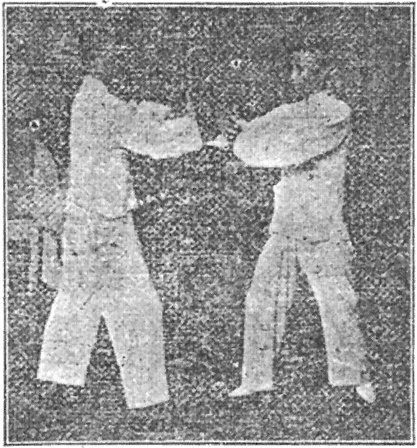
第二式 「太極雙魚搭手式」
Pattern 2: TAIJI DOUBLE-FISH TOUCHING-HANDS POSTURE
▲說明
Explanation:
承上式。甲乙二人。仍站在原地。兩手靠近。作雙搭手姿勢。如太極雙魚圖。兩人互相注視其手。為隨機應變之用也。甲以左手按住乙之右肘尖。右手橫斜停於左肩之前方。手心向己身。與乙之右手背相粘。兩臂彎曲。其狀如算術之9字。此時須氣沉丹田。身。腰。肩。均鬆開。有下沉之意。能如是。則無氣喘上昇。及一切不良之弊病也。
乙亦如甲之動作。用左手輕按在甲之右肘尖。右手橫斜停於左肩之前方。手心向自己身。與甲之右手背相粘。两臂彎曲。其狀如算術之6字。餘與甲同。故從畧。其姿勢如第二式。第二圖是也。
Continuing from the previous posture, both people still standing as they were, they close in on each other with both hands, making the double touching-hands posture, which resembles the taiji double-fish diagram. [When looked at from above, the fish are swimming the counterclockwise version in the case of right hand forward, clockwise in the case of left hand forward.] Both people are observing the hands so as to adapt according to the situation.
A [still to the right in the photo] is using his left hand to push on B’s right elbow, his right hand sideways at an angle in front of his own left shoulder, palm toward his own body, sticking to the back of B’s right hand. With both arms curved, the shape looks like a 9 [if seen from above from B’s side]. At this time, he must sink energy to his elixir field, loosen his torso, waist, and shoulders, and have a downward sinking intention. If it can be done in this way, then the breath will not become strained and all harmful errors will be avoided.
B’s action is the same as A’s. He is using his left hand to push on B’s right elbow, his right hand sideways at an angle in front of his own left shoulder, palm toward his own body, sticking to the back of A’s right hand. With both arms curved, the shape looks like a 6 [as seen from above from B’s side]. The rest is the same as with A, and thus need not be repeated. See photo 2:
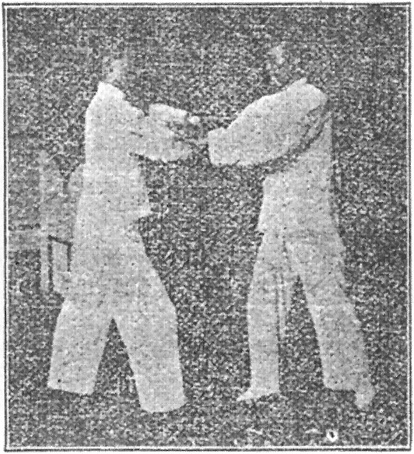
甲乙二人。將兩形以合。正是兩個陰陽魚。合成為一圓形之太極圖也。所以拳譜謂「動之則分。靜之則合」。即此意也。動靜者。亦卽易經。陰陽相摩。八卦相盪之理耳。
Both of their shapes being brought together makes the two passive/active fish, which together form the circular taiji symbol. It is the same idea as in the Boxing Treatise: “When there is movement, the passive and active aspects become distinct from each other. When there is stillness, they return to being indistinguishable.” [In the case of this pushing hands position, if both just stand there holding the shape, neither fish is either passive or active, but if A pushes forward, his is now the active fish while B’s has become the passive fish.] Movement and stillness are as they are explained in the Book of Changes: “Passive and active [hardness and softness] rubbing against each other, the eight trigrams stimulate each other into being.”
「附誌」以下每項推手之開始動作。或有以此二式為首。
Note:
The beginning movements for all of the pushing hands exercises below are these two patterns above.
第三式 「掤式」使用及練法
Pattern 3: WARD-OFF – Its Function & Practice Method
▲說明
Explanation:
承上式。乙得機勢。將右手(曲肘)向甲身前擠去。掌心向已身。兩足仍在原地。右足彎曲為弓式。左腿伸直。身畧往前傾。左手附於右手腕部。掌心向外。同時兩眼注視甲方。甲見乙擠來。即身往後坐左腿。(兩足仍在原地)。變前脚伸直為虛。後脚稍曲為實。全身重點。皆在左腿。同時涵胸拔背。雙臂彎曲。肘尖下垂。以左手掤住乙之右肘。右手仍粘住乙之右手背。雙手又如上捧之意。勿使乙擠到己身胸各部。但此式之使用。為化解乙之擠法也。其姿勢如第三式第三圖是也。
Continuing from the previous posture, B takes the opportunity and sends his right arm (with the elbow bent) pressing out forward toward A’s body, the palm facing his own body. His feet still standing in the same place, his right leg bends to make a bow stance, left leg straightening, body slightly leaning forward. His left hand is placed at his own right wrist, the palm facing outward, his gaze in B’s direction.
A [still to the right in the photo] sees B’s press coming, so his body goes to the rear and sits on his left leg (both his feet still standing in the same place), changing his forward leg to be straightening, becoming empty, while his rear leg slightly bends and becomes full, the weight on the left leg. At the same time, he hollows his chest and plucks up his back, bending both arms so the elbows are hanging down, and uses his left hand to ward off B’s right elbow, his right hand still sticking to the back of B’s right hand. Both hands seem to have an intention of carrying upward to keep B’s press from reaching A’s chest, although the purpose of this technique is to neutralize B’s pressing technique. See photo 3:

(按)掤之用法。有二。一曰平掤。如第三式是也。一曰高掤。為按式之後。用雙圈手。亦如前法。往上捧架。則敵勁無所施矣。
Note:
There are two ways off applying ward-off: level ward-off, as here in Pattern 3, and high ward-off, as mentioned below [in Section 6b], which circles around with both hands and then prop upward as described above, rendering the opponent’s power useless.
第四式 「捋式」使用及練法
Pattern 4: ROLLBACK – Its Function & Practice Method
▲說明
Explanation:
承上式。甲乙二人仍站原處。甲見乙雙手擠來。封住左臂肘。仍涵胸坐腿。不使貼近身體。先用左掌轉上粘住乙之左手。手背相粘。右掌又放下。圓轉上托住乙之左防其用肘擊來。同時肘尖两手一氣往着左邊斜角捋去。意在傾仆乙於外方之用也。捋時左手往前拉引。右手乘勢推送。如是則敵人重心已失。(前傾)鮮有不跌者。其姿勢如第四式第四圖是也。
Continuing from the previous posture, both people are still standing in the same place. A [still to the right in the photo] sees B’s hands coming in with a press and seals off B’s left elbow [with his right hand], still hollowing his chest and sitting back so as not to allow B to get close to his body. He first turns over his left palm and uses it to stick to B’s left hand, sticking to each other with the backs of the hands, and then releases his right palm [from sticking to B’s right hand] and turns it over to prop up B’s elbow and prevent him from striking with it. At the same time, A’s elbows and hands roll back in a single action to the left corner with the intention of getting B to lean out and fall down. When rolling back, A’s left hand draws in and his right hand takes advantage of the momentum and pushes out. If done in this way, an opponent would be caused to lose his balance (i.e. lean forward) and would rarely not fall. See photo 4:
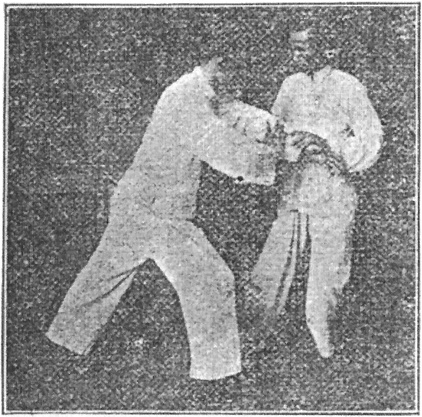
(按)乙如得機勢。將甲雙手封閉在胸部之下。甲卽两手往左右兩旁挒開之。其功效與捋式同。而變化不同。務令對方無法推測也。
Note:
If B were to gain the upper hand, then A would instead seal over from his chest downward with both hands and rend apart to both sides. The effect of this would be the same as rolling back [i.e. B losing his balance and falling], but the neutralizing is different, leaving the opponent with no method of pushing.
第五式 「擠式」使用及練法
Pattern 5: PRESS – Its Function & Practice Method
▲說明
Explanation:
承上式。兩人仍在原處。乙被甲捋。將往外傾。乘勢用右手按在左膀臂上。用力往甲身擠去。同第三式。左手手心向已身。右手手心向外。兩臂彎曲。全身重點。皆在右腿上。身體亦向甲方畧傾。雙眼注視左手。甲見乙擠來。勢不得力。將往後傾仆。乃立卽坐後涵胸。將雙手往下沉勁一按。則可以化險為夷矣。其姿勢如第五式第五圖是也。
Continuing from the previous posture, both people are still standing in the same place. B [still to the left in the photo] is being rolled back by A and is about to lean outward. He takes advantage of the momentum and uses his right hand to push on his own left forearm to press out powerfully toward A’s body as in Pattern 3, but with his left palm facing his own body and his right palm facing outward. Both arms are curved, the weight is on his right leg, and his body slightly leans toward A. His gaze is toward his own left [right] hand.
A sees B’s press coming. There is no hope for his posture and he is about to be leaned back until he falls down, so he immediately sits back, hollows his chest, and sends his hands pushing downward with a sinking energy to thus be able to transform danger into safety. See photo 5:

「附誌」四正推手中之掤。捋。擠。按。亦如形意門之五行生剋拳。大致相同。如甲乙二人。先行互相掤手。如乙往甲方掤推。甲則涵胸坐後。將乙之右手臂。往右邊捋下以化乙之掤勁。乙被捋時。似不得力。乃速轉用右臂膀以擠式攻甲。甲見乙擠來。又變按式。往左邊坐身涵胸。沉勁按下而化之。乙被甲用按式化去。又復變囘為掤式。如此互換。循環不已。此來彼往。以至無窮。左右之推法一樣。如甲先捋。則往甲之左邊去捋。反之乙亦然。茲述其大槪者如此。至神而明之。則又存乎其人矣。
Note:
The warding off, rolling back, pressing, and pushing within the Pushing Hands Method for the Four Primary Techniques resemble the two-person exercise in Xingyi of the five elements generating and overcoming each other, the general concept being the same.
Both people start by giving each other a ward-off posture. When B pushes A with his ward-off, A then hollows his chest and sits back, sending B’s right forearm to the right side with a downward rollback, neutralizing B’s ward-off energy. When B is being rolled back, it seems his position is hopeless, but then he quickly turns, using his right forearm to attack A with a press. A sees B’s press coming, so he then changes to the push technique, going to the left, lowering his body, and hollowing his chest, pushing down with a sinking energy to neutralize it. B, having been neutralized by A’s pushing technique then returns to the ward-off posture [on the left side, from which he will then roll back A’s soon-to-be-incoming press].
In this way the movements exchange, recycling indefinitely, both people going back and forth without limit. The exercise is the same for both left and right sides. If A starts by rolling back to his left, then B will respond accordingly [by pressing with his left forearm]. This description has just been of the general idea, but once the method has been fully understood, it will then be a part of you.
第六式 「按式」使用及練法
Pattern 6a: [INWARD] PUSH DOWN – Its Function & Practice Method
▲說明
Explanation:
甲丙二人練習。對面立正。其距離以兩人之手。能接近為合度。甲丙先上右足一步。左足蹬直。仍在原處。成為右弓式。身亦往前微傾。全身重點。皆在右腿上。同時將雙掌向甲胸部推去。(手心向前。手指向上)。兩眼注視甲方。
甲見丙雙掌推來。亦出右足。伸直為虛步。左足仍在原地不動。稍屈曲為實步。全身重點。皆左腿上。迄丙之雙掌將推到胸前。卽涵胸拔背。隨將兩手。用手心平着。為往下按去之用。按往丙之雙掌背。勿使侵進。兩肘尖下垂。距離肋部二三寸許。或肘尖平着。用手下按亦可。两眼注視丙之雙掌。是為丙外推。甲裡按之動作。又名裡按。其姿勢如第六式第六圖是也。
Two people, A and C, stand facing each other squarely at a distance of being able to reach each other’s outstretched hands. C [to the right in the photo] starts by stepping out his right foot. His left leg straightens, staying where it is, making a right bow stance, his body also slightly leaning forward, the weight on the right leg. At the same time, both his palms push out toward A’s chest (palms outward, fingers upward). His gaze is in A’s direction.
A sees C’s double-palm push coming and also steps out with his right foot, the leg straightening, making it the empty foot. His left foot does not move from its location but the leg slightly bends, making it the full foot, the weight on the left leg. As C’s push is about to arrive in front of A’s chest, A hollows his chest and plucks up his back, while sending his hands as flattened palms to push away downward on the backs of C’s palms to keep him from invading forward. A’s elbows are hanging down two or three inches away from his ribs, or can be flattened out while the hands are pushing down. His gaze is toward C’s palms. This movement is C pushing down outward and A pushing down inward, also called “inward push down”. See photo 6:
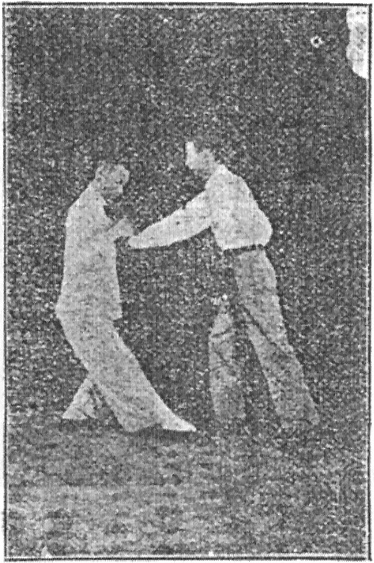
第六式 「按式」使用及練法
Pattern 6b: [OUTWARD] PUSH DOWN – Its Function & Practice Method
▲說明
Explanation:
承上式。二人仍在原處。丙見不能將甲推倒。欲收囘雙掌。甲乘勢將雙手粘着。丙之兩手腕。圓轉而上。(此時甲之雙掌在內。丙之雙掌在外。卽翻轉手指向上為掤。與攬雀尾之第六式相同)。乘機反向丙方。雙掌推去。右足彎曲。左足蹬直。變成左弓步。身體亦往前微傾。兩眼注視丙方。其姿勢如第六式第七圖是也。
Continuing from the previous posture, both people are still standing in the same place. C [still to the right in the photo] sees he cannot get his push to land on A, so he decides to withdraw his palms. A takes advantage of the momentum and sticks to C’s wrists with both hands, rotating them [under and] upward. (A’s palms are now on the inside and C’s are on the outside, and A’s are turned over so that the fingers are upward to make a ward-off the same as in part 6 of CATCH THE SPARROW BY THE TAIL.) He seizes the opportunity to reverse in C’s direction, pushing out with both palms, while his right leg bends and his left leg presses straight to make a left [right] bow stance, his body slightly leaning forward. His gaze is in C’s direction. See photo 7:
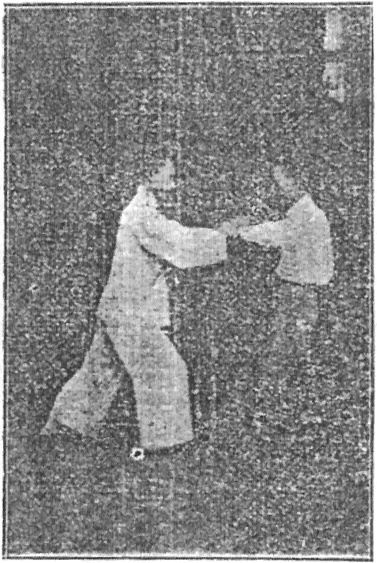
丙見甲雙掌推來。卽涵胸。身往後坐。右腿伸直為虛。左腿稍曲為實。重點在右腿上。同時兩手掌心。仍粘着甲之雙手腕之背部。往下用沉勁按下。使不能進然後又翻轉雙掌圓轉而上。變成第六式第六圖之姿勢。
反向甲推去。如此循環不已。此式名為甲外推。丙裡按之動作。又名外按。查此式之推手。係由太極拳中「攬雀尾」之第六式所變化者也。
As C sees A’s double-palm push coming, he hollows his chest and sits his body back, his right leg straightening and becoming empty, his left leg slightly bending and becoming full, the weight shifting to be on the right leg. At the same time, his palms now stick to the backs of A’s wrists and he pushes downward with a sinking energy to keep him from being able to advance. Then he too [takes advantage of A’s withdrawing] and turns his palms over and upward, the posture changing to again be as in photo 6.
Reversing toward A, he pushes out, and in this way the exercise recycles indefinitely. This movement [for photo 7] is A pushing down outward and C pushing down inward, also called “outward push down”. To further investigate this pushing hands scenario, it relates to the movement change in part 6 of CATCH THE SPARROW BY THE TAIL.
–
3,四隅推手法(即大捋推手)
PUSHING HANDS METHOD FOR THE FOUR SECONDARY TECHNIQUES (KNOWN AS LARGE ROLLBACK PUSHING HANDS):
採。挒。肘。靠。四隅角也。
Plucking, Rending, Elbowing, and Bumping – aligning with the four corner compass points [of the eight trigrams].
第七式 「大捋使用及練法」
Pattern 7: LARGE ROLLBACK – Its Function & Practice Method
◎說明
Explanation:
大捋推手者。四斜角推手之方法也。其步法為行四隅。(斜方)以濟四正之所窮也。開始之動作。與亦第一式。第二式相同。故從畧。請參閱上文便明白矣。
Large Rollback Pushing Hands is the “four corners” pushing hands method. Its footwork travels to the four corners (i.e. diagonal compass points). It compensates for the limitations of the four primary techniques. The movements begin in the same way as in sections 1 & 2, and so they will not be repeated since you can easily understand by reviewing them above. [The twelve-movement description below is copied from Yang Chengfu’s 1931 manual, having itself copied the text from Xu Yusheng’s 1921 manual.]
甲右足向西北角斜邁進一步。成馬式。或弓式。右臂肘平屈以右手按乙之右腕。左臂屈肘。用下膊骨中間。向西北角斜捋乙之右臂。使其外傾。其姿勢如第七式第八圖是也。
[1] A steps his right foot diagonally to the northwest corner, making a stance between a horse-riding stance and a bow stance, and with his right arm level and bent, his right hand pushes on B’s right wrist, while his left arm bends at the elbow and uses the middle area of the outer forearm bone to roll back B’s right arm diagonally to the northwest corner, causing him to lean outward. See photo 8. [Photo 8 can be used to show the situation described here only with the roles reversed, and so it is shown further down with movement 11, where it more appropriately fits.]
乙即趁勢出左足。向外走甲前方。橫出一步。卽移右足向甲襠中插襠。前邁一步。亦成馬式。或弓式。同時右臂伸舒。向下肩隨甲之捋勁。向甲胸部前靠。左手撫右肱內輔助之。此時甲乙二人。仍相對立。其姿勢如第七式。第九圖是也。
[2] B [to the left in the photo] then takes advantage of the momentum and steps his left foot across forward and outward [to the left], moving his right foot to step forward between A’s legs, making a stance between a horse-riding stance and a bow stance. At the same time, his right arm extends downward, his shoulder going along with A’s rollback energy, and bumps forward toward A’s chest with his left hand assisting by touching the inside of his own right arm. Both people are again facing each other [with B looking toward the northeast]. See photo 9:

甲以左手下按乙之左腕。右手按乙之左肘尖下採。同時左足由乙之右足。外移至乙之襠中。
[3] A uses his left hand to push down on B’s left wrist and his right hand to push down on B’s left elbow, plucking down. At the same time, his left foot goes from the outside of B’s right foot to step between B’s legs.
乙隨甲之採勁。右腿向西南方後撤。作騎馬式。左臂平屈。右手撫甲之左腕。右臂屈肘。用下膊骨中處。向西南方斜捋甲之左臂。
[4] B goes along with A’s plucking energy and withdraws his right [left] leg to the southwest, making a horse-riding stance, and with his right [left] arm level and bent, his left hand touches A’s left wrist, and his right arm bends at the elbow and uses the middle area of the forearm bone to rollback A’s left arm diagonally to the southwest.
甲趁勢右足前出一步。移左足向乙襠中插襠。前邁一步。同時左臂伸舒向下。肩隨乙之捋勁。向乙胸部前靠。右手撫左肱內。以輔助之。甲乙二人仍對立。
[5] A takes advantage of the momentum and steps his right foot forward, moving his left foot to step forward between B’s legs. At the same time, his left arm extends downward, his shoulder going along with B’s rollback energy, and bumps forward toward B’s chest, with his right hand assisting by touching the inside of his own left arm. Both people are again facing each other [with A looking toward the southeast].
甲左臂欲上挑。乙卽隨甲之挑勁。左手作掌。向甲面部作伺擊狀。右手按甲之左肩。斜向下挒勁。
[6] A’s left arm wants to lift up. B then goes along with A’s lifting energy, his left hand doing a palm strike toward A’s face while his right hand pushes on A’s left shoulder, diagonally rending downward.
甲隨乙之挒勁。撤左足向東北方邁去。左手撫乙之左腕。右臂屈肘。向東北斜捋乙之左臂。
[7] A goes along with B’s rending energy and withdraws his left foot a step to the northeast, his left hand touching B’s left wrist, his right arm bending at the elbow, and rolls back B’s left arm to the northeast.
乙趁勢上右步。移左足向甲襠中前邁。左臂隨甲之捋勁。用肩向甲胸部前靠。右手輔助之。
[8] B takes advantage of the momentum and steps forward with his right foot, moving his left foot to step forward between A’s legs, his left arm going along with A’s rollback energy and using his shoulder to bump forward toward A’s chest, his right hand assisting. [The direction B is facing is northwest.]
甲以右手下按乙之右腕。左手按乙之右肘尖下採。同時右足由乙左足外移至乙之襠中。
[9] A uses his right hand to push down on B’s right wrist and his left hand to push on B’s right elbow, plucking down. At the same time, his right foot goes from the outside of B’s left foot to step between B’s legs.
乙隨甲之採勁。撤右足向東南方邁。右手撫甲之右腕。左臂屈肘。向東南斜捋甲之右臂。
[10] B goes along with A’s plucking energy and withdraws his right foot to the southeast, his right hand touching A’s right wrist, and with his left arm bent at the elbow, rolls back A’s right arm diagonally to the southeast.
甲趁勢上左步。移右足。向乙襠中前邁。右臂隨乙之捋勁。用肩向乙胸部前靠。左手輔助之。
[11] A [still to the right in the photo] takes advantage of the momentum and steps forward with his left foot, moving his right foot to step forward between A’s legs, his right arm going along with B’s rollback energy, and uses his shoulder to bump forward toward B’s chest, his left hand assisting. [The direction A is facing is southwest.] [See photo 8:]
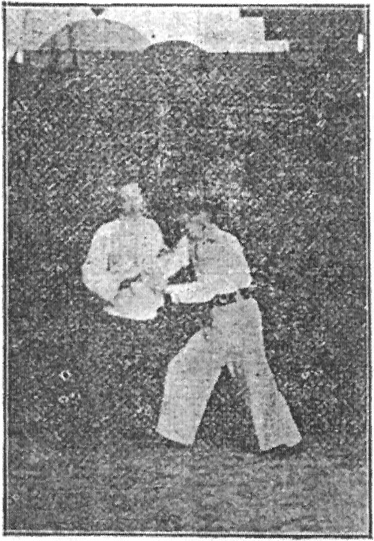
甲右臂欲上挑。乙卽隨甲之挑勁。右手作掌。向甲面部撲擊。左手按甲之右肩斜向下挒甲退左腿。雙手捋乙之右臂腕肘處。還太極雙魚搭手式。此為採。挒。肘。靠。之一次。如欲繼續演練。下仍仿之。是謂之四隅推手之法也。
[12] A’s right arm wants to lift up. B then goes along with A’s lifting energy, his right hand doing a palm strike toward A’s face while his left hand pushes on A’s right shoulder, diagonally rending downward.
[1 repeating] A retreats his left [right] leg, and with both hands rolls back B’s right arm at the wrist and elbow area.
Both people have returned to the taiji “double fish” posture of crossing their [right] hands. This completes one series of plucking, rending, elbowing and bumping. If you wish to continue to practice from this point, the rest is as before. This is called the “pushing hands method for the four secondary techniques”.
▲說明
Explanation [for how to switch roles]:
甲放棄左手採勁。而變為閃。所謂閃者。即以掌向乙面部作撲擊狀。其步法皆未動。其姿勢如第七式第十圖是也。
[Instead of continuing from the above into B performing movement 2 and then explaining A’s switch in movement 3, the explanation here confusingly picks up from B having performed movement 8 and A’s switch happening in movement 9.] A [still to the right in the photo] releases his left hand from its usual downward pluck and changes to “flashing”, which is the palm strike, to B’s face, and A now does not step [from outside to between B’s legs]. See photo 10:
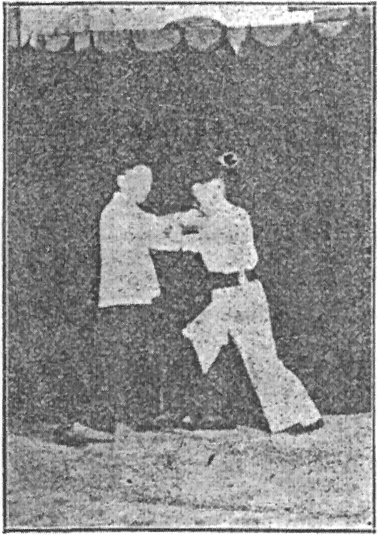
待乙起左手。退左脚與右脚一並。急復將左脚又向左隅角後退却一步。翻身後脚坐實。復以右手捋甲左手。以左手採甲右手時。甲即隨乙之第一步。退却時。甲卽追上一步。將左後脚提與前脚暫並。卽乙退進第二步時。甲急移右脚向右前隅角進一步。卽急將左脚插進乙之襠中。卽加以右肩貼近乙之左臂靠去。是為進者三步。退者二步。中間有一步。須两脚並齊之後。換步上去而成第七式第十一圖之姿勢也
B [to the right in the photo] now lifts his left arm, withdrawing his left foot to be next to his right foot, then quickly retreats his left foot a step to the left rear corner [southwest], turning his body and sitting onto his rear foot. While using his right hand to roll back A’s left hand and using his left hand to pluck A’s right hand [elbow], A then goes along with B’s first step [of feet together], and as B retreats [stepping back to the southwest with his left foot], A then chases a step forward. A has lifted his left foot in the rear and brought it forward to be next to his front foot [meaning both people have the feet-together moment in unison], then when B has retreated, A has advanced a second step by quickly shifting his right foot, advancing a step to the right forward corner [southwest], then quickly steps his left foot forward between B’s legs, also putting his right [left] shoulder close to B’s left arm [chest], bumping outward [to the southeast]. This is: advancing three steps [for A], retreating two steps [for B], and centering with one step [for both]. Once both of A’s feet are standing next to each other, he must then step out forward with the other foot. See photo 11 [reverse view]:
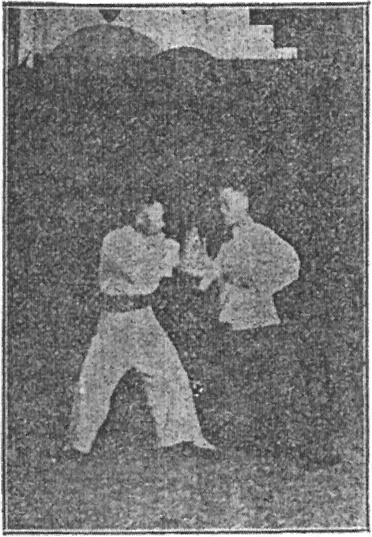
(按)太極拳術。以之運動四肢。活潑身軀。最為適宜。若求致用。非兼習推手不為功。蓋學習推手。能使全身富於知覺。其法甚多。分有雙手推者。有單手推者。步法尤須相合。進退一致。甲乙二人。粘連不斷。旋轉不已。隨曲就伸。虛實互用。此來彼往。如常常推練。久之則知覺靈敏。粘黏連隨。無不如意。周而復始。循環不已。其切要之處。全在手之粘勁。及換步靈妙耳。
Note:
[Rather than continuing with a clarifying “B will now perform the role of plucking while A has switched to doing the rending”, this “note” is actually not a comment on the above at all, but is instead a slightly misplaced intro to Part 4 below.] The Taiji boxing art exercises the limbs and enlivens the body. But it will be at its most effective if you also work toward its practical application. Unless you simultaneously train in pushing hands, you will not become skilled, for it is through learning pushing hands that you can make your whole body abundantly aware.
There are many methods, dividing into double-hand pushing and single-hand pushing. Both people, A and B [and sometimes in this book also A and C], particularly need to be consistent with each other’s stepping, advancing and retreating as one, as they are sticking and connecting to each other continuously, circling endlessly. They follow and bend, then engage and extend, emptiness and fullness making use of each other as both people go back and forth.
If you practice the pushing exercises frequently over a long period, then your sensitivity will become very keen as you stick, adhere, connect, and follow. All will happen as you intend due to repeating the exercise over and over, recycling it ceaselessly. The most important aspects of it are the sticking energy of your hands and that your stepping has a great nimbleness.
–
4,其他推手法
OTHER PUSHING HANDS METHODS
甲第八式 「單手推單手」之使用及練法
A. Pattern 8: SINGLE HAND VS. SINGLE HAND – Its Function & Practice Method
▲說明
Explanation:
甲丙二人。先上右足為合步。左足仍在後。或同時各伸出右手(為掌式)。手背互相黏粘。左手亦掌。叉在左腰部。左臂肘亦屈曲。如三角形。
甲先用右手作平面畫一圓形。向丙方之胸前推去。意欲推倒之推時掌心向上。手臂伸直。微帶曲意。卽肘往下沉。兩眼注視丙方。右膝屈曲為弓式。身亦往前畧傾。全身重點。皆在右腿上。氣貫丹田。則下部穩固矣。
丙見甲用掌推來。乃立卽涵胸。身往後坐變右脚為虛。左腿稍曲為實。全身重點。皆在左腿上。同時將右掌收回。肘尖下埀。引甲之勁。往己身之右側方落空。不使其侵我毫末也。但引手時。須在引到當中之處。便即翻轉手心向上。復往自己身體之右側方。引進落空。若待引甲之手將到我胸前時。距離約數寸許。則無法能化甲之來勢矣。其姿勢如第八式第十二圖是也。
Both people, A and C, start by stepping forward with their right foot to make the same-step position, left foot staying behind. Then in unison each extends his right hand (as a palm), the backs of the hands sticking to each other. The left hand is also a palm, holding the left side of the waist, elbow bent to make the arm into a triangle.
A [to the left in the photo] begins by sending his right hand in a horizontal arc, pushing out toward C’s chest, keeping in mind that the palm is upward before turning over into the push, arm straightening but with an intention of slightly bending, elbow sinking down. His gaze is in C’s direction. His right knee bends to make a bow stance, body slightly leaning forward, the weight on the right leg. Energy passes through to the elixir field, then to the lower body to stabilize it.
C sees A’s palm coming in with a push, so he immediately hollows his chest and sits his body back, his right leg becoming empty, left leg slightly bending and becoming full, the weight on the left leg. At the same time, he withdraws his right hand, elbow hanging down, to draw in A’s energy to the right side of his own body, getting A to miss rather than letting him even slightly approach directly. But when he draws in with his hand, he must draw in toward the center to more easily turn his palm upward, then go toward his right side to lead A into missing. But if when drawing in A’s hand he waits until it is only a few inches from his chest, then there will be no way he can neutralize A’s incoming force. See photo 12:
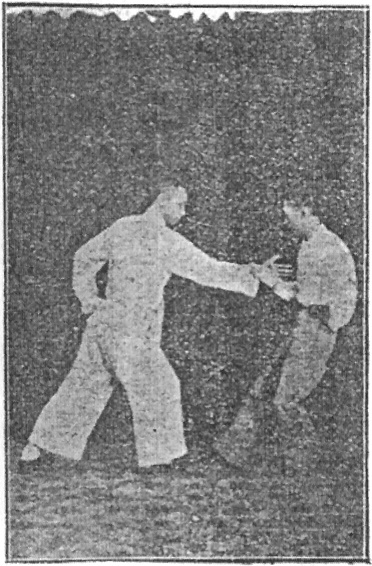
承上式。為連貫練習及使用。丙旣將甲之來勢往右方解脫。乘機復用右手(手心向上)往甲方胸前推去肘亦下垂。全身重點。向前微傾。右足變成弓步。左足在後蹬直。左手仍叉腰。兩眼注視甲方。
甲見丙由右而左。用掌推來。立卽涵胸。身往後坐。餘與丙上式相同。亦往右側方。引丙之勁落空。两眼亦注視丙手。以窺其變化而應付之也。其姿勢如第八式第十三圖是也。
Continuing from the previous practice-and-application scenario in which C escapes A’s incoming force by taking it to the right side, C [still to the right in the photo] then seizes the opportunity to send his right hand (palm upward) forward with a push toward A’s chest, elbow hanging down. The weight slightly inclines forward, his right leg changing to make a bow stance, left leg straightening behind, left hand still holding at the waist. His gaze is in A’s direction.
A sees C’s palm going from right to left [left to right], coming in with a push, and immediately hollows his chest and sits his body back. The rest is the same as in C’s case above, A also drawing in C’s power to the right side until it misses. His gaze is now toward C’s hand to observe his changes and thereby respond to them. See photo 13:
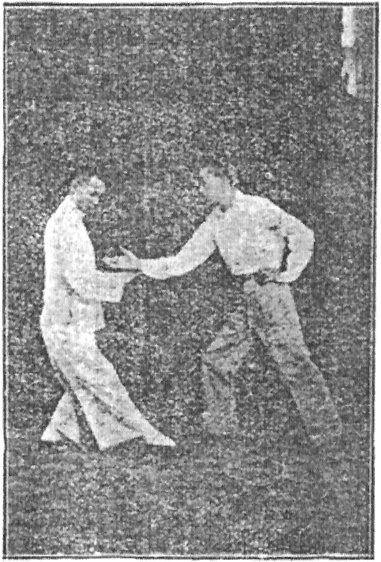
(按)此式之推手。如甲丙二人。互相推盪。作平面圓形之太極雙魚式。此發彼化。循環不己。常常推練。日久功到自然成矣。
Note:
In this pushing hands pattern, both people are pushing against each other in a level circle, as with the taiji double-fish shape, one issuing, the other neutralizing, recycling the movement endlessly. If you frequently practice this exercise over a long period, hard work will naturally produce achievement.
乙 第九式 「雙手推單手」之使用及練法
B. Pattern 9: DOUBLE HAND VS. SINGLE HAND – Its Function & Practice Method
▲說明
Explanation:
此式之練法。甲丙二人。亦為合步。丙先用推手。往甲身前兩。右手按住甲之右手背。左手按住甲之右肘尖。兩手手指向上。左足在後伸直。右膝屈曲為弓式。兩眼向前平視甲方。
甲見丙兩手朝左邊推來。封住右手。乃立卽涵胸。身往後坐。右足斜直。在前為虛。左足在後。稍彎曲為實。左手叉在左腰部。手。臂。肘。成為三角形。同時以右手臂(臂肘彎曲)向丙方迎攩。務與丙之雙手。貼近靠着。其姿勢如第九式第十四圖是也。
For this practice pattern, A and C are again in the same-step position. C [again to the right in the photo] begins by sending his hands forward with a push covering both sides of A’s body, his right hand pushing on the back of A’s right hand, left hand pushing on A’s right elbow, the fingers of both hands upward. His left leg is straightening behind, right knee bending to make a bow stance. His gaze is forward and level in A’s direction.
A sees C’s hands coming in with a push to the left side to seal off his right arm, so he immediately hollows his chest and sits his body back, right leg in front slanting away and straightening, becoming empty, left leg behind slightly bending, becoming full. His left hand is holding the left side of his waist, with the hand, shoulder, and elbow forming a triangle. At the same time, he sends his right arm (elbow bent) toward C to receive and ward away, dealing with both of C’s hands as they press in close. See photo 14:
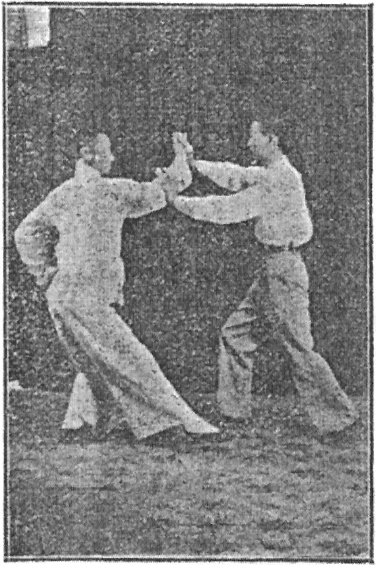
迄丙發勁推來。迅擰腰用右手。臂。肘。往己身前之右側方。往外引進落空。以化丙勁。又卽將臂肘。往下沉墜。其手臂由下圓轉而上。(劃一圓圈形)反向丙方推出。右足變為弓式。丙見甲推來。又即涵胸坐後。與甲之動作相同。惟不以左手叉腰得機又向甲方推去。甲又化之。如此練習。又如算術之8字。連揉两圈。互相推盪。循環不已。與第八式相同。不過此式則為雙手。此其分別之處也。但此式之動作。專為甲方練習肩部之活動力。練時左右手。均須受相當之練習。則臨敵不致有轉動不靈之弊也。
B has issued energy and his push is on its way, so A quickly twists his waist, sending his right hand, shoulder, and elbow across in front of his own body to the right side, drawing in outward so C’s force misses and is neutralized. Sinking his elbow down, he rotates his arm upward from below (drawing an arc), then reverses toward C with a push, his right leg changing to make a bow stance.
C sees A’s push coming, and so he hollows his chest and sits back. His movement is then the same as A’s above, except without his left hand on his waist. When he sees the opportunity, he again pushes out toward A, and A again neutralizes.
They practice in this manner, forming a [vertical] figure-eight, continuously rubbing in a double circle, pushing against each other over and over indefinitely. It is the same as in Pattern 8, but is distinct by way of its double-handedness. Also, the movement of this pattern focuses on training the maneuverability of A’s shoulder. It must be practiced equally on both sides so as to not result in the error of a lopsided aptitude for facing an opponent.
丙第十式 「對步雙手推雙手」之使用及練法
C. Pattern 10: FACING-STEP DOUBLE HAND VS. DOUBLE HAND – Its Function & Practice Method
▲說明
Explanation:
甲丙二人練習。對面立直。兩足平行。分開如||形。寬與肩齊。是為對步。身體挺直。重心穩定。兩眼向對方平視。其距離之遠近。以雙手能接近為合度。起初動作。為雙掤手式。與第二式之動作相同。所異者惟步法耳。其姿勢如第十式第十五圖是也。
A [to the left in the photo] and C face each other standing straight, their feet on parallel lines shoulder width apart. This is the facing-step position. Their bodies are straight, balance stable, and their gaze is level toward each other. As for their distance apart, they should be able to connect with both hands. The movement begins with both hands making the ward-off posture, same as in Pattern 2, the only difference being the stance. See photo 15:
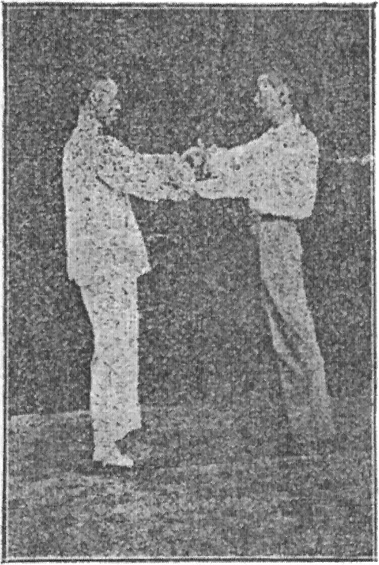
承上式。甲丙二人。仍立原處。用四正推手法。互相以掤。捋。擠。按。作循環不斷之意。請參閱上文。便明白矣。不過當甲得機會。往丙按時。如丙直立不動。則必被甲推倒。故丙斯時擰腰涵胸。身往右側後坐。變右足為虛。向外伸直。左腿彎曲在後為實。足尖轉動。兩足仍在原處。全身重點。移在左腿。蓋如此之動作。一轉身時。則甲之來勢。完全失去。不得不隨之轉動。身往右坐。與丙成為斜角對面相持之形狀也。而兩人之姿勢相同。两眼互相平視如第十式。第十六圖是也。
Continuing from the scenario above, both people are still standing in the same place. They use the pushing hands method for the four primary techniques, warding off, rolling back, pressing, and pushing each other, with the intention of recycling the movements continuously. Review its description above to more easily understand. But this time it is A [still to the left in the photo] that initiates. As he pushes toward C, if C is standing straight and not moving, he will inevitably be pushed out by A. Therefore C in this moment twists his waist and hollows his chest, his body turning to the right and sitting back, his right leg straightening outward, becoming empty, left leg bending behind, becoming full. The toes have turned but both feet are still standing in the same place, the weight on the left leg. By turning in this way, A’s incoming force is completely dispelled, and so A will have to go along with the turning movement, turning his body to the right and sitting. A and C are now facing each other along a diagonal, both in the same posture, and their gaze is level toward each other. See photo 16:

兩人之部位如下(二)
甲
\
丙
The second position of both people is thus:
A ↓
↑ ╲ ↓
↑ ╲ ↓
↑ C
承上式。丙旣將甲之來勢化解。後乘機向甲方按去。甲又如丙之方法。擰腰涵胸而往後方坐身。解脫丙之來勢。足尖轉動。兩足仍在原處。大致與上式相同。所異者。惟甲丙兩人之部位及方向耳。兩眼互相注視。其姿勢如第十式第十七圖是也。
Continuing from the scenario above, once C [still to the right in the photo] has dissolved A’s incoming force, he then seizes the opportunity to push out toward A. A imitates C’s method of twisting his waist and hollowing his chest to escape C’s incoming force. The toes have turned [to the left] but both feet are still standing in the same place. It is mainly the same as above, the only difference being that A and C twist in opposite directions. Their gaze is toward each other. See photo 17:
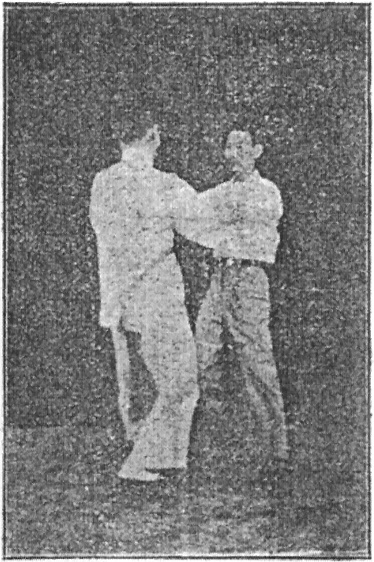
(按)此式之動作。為雲手式變化出來。專為練習腰。胯。腿。之運動。練之日久。能使身軀各部靈活。能制人而不為人所制也。兩人之部位如下(三)
丙
/
甲
The third position of both people is thus:
↓ C
↓ ╱ ↑
↓ ╱ ↑
A ↑
Note:
During the course of these movements, the CLOUDING HANDS posture emerges. The exercise focuses on training the waist, hips, and thighs. If it is practiced over a long period, it can make every part of the body nimble, and you will be able to control an opponent and not be controlled by him.
丁第十一式 「拗手推手」之使用及練法
D. Pattern 11: TWISTING-HAND PUSHING HANDS – Its Function & Practice Method
▲說明
Explanation:
甲乙二人練習。先做乙雙手掤甲右單手臂。如第九式。甲見乙掤住己臂。勢將外傾。乃速以左手掌。按住乙之右肘尖。同時右手擰翻扭乙右手。(手心向上。)用力往下按壓。並上左足一步。成左弓式。插在乙之襠後。兩眼注視乙方。乙兩足仍在原處。站着不動。身畧往外後傾。左手臂埀下。兩眼亦注視甲方。其姿勢如第十一式。第十八圖是也。
A and B are practicing. B [to the right in the photo] begins by warding off A’s right arm with both hands as [C did] in Pattern 9. A sees B warding off his arm, and that he is about lean out, so he quickly uses his left palm to push on B’s right elbow. At the same time, he twists B’s right hand (so the palm is upward) and powerfully presses down while going forward a step with his left foot to make a left bow stance, stepping behind B’s legs. His gaze is in B’s direction. B’s feet are still standing in the same place and have not moved, but his body is slightly leaning out to the rear and his left [right] arm is hanging down. His gaze is likewise in A’s direction. See photo 18:
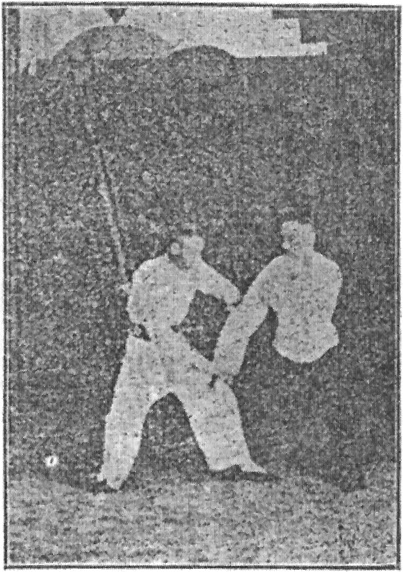
承上式。乙被甲拗轉手臂。其勢將傾。於是用肩肘之力。往囘上抽。反握甲之右拳。往己身向內。圓轉而上。又以右掌按甲右肘尖。甲乙二人同時擰轉右脚尖。脚跟仍在原處。並各提起左足。膝須稍高。脚尖向地。此時兩人之手。復成雙手掤式。兩足兩手。如太極雙魚啣接之形式。互相平視。右足獨立。身腰畧前彎。此為上式之過渡法。其姿勢如第十一式。第十九圖是也。
Continuing from the scenario above in which B’s arm has been twisted by A [to the right in the photo] and his posture is about to lean, he then applies the strength of his shoulder and elbow to retract upward, counter-grabbing A’s right fist and drawing it in toward his own body, arcing upward, also using his right palm to push down on A’s right elbow. In unison, each turns out his right toes, heel remaining in the same spot, and each lifts his left leg. The knee must be slightly higher [than the thigh], and the toes are pointing down. At this moment, their hands are again in the double-hand ward-off posture, their hands and feet merging to form the taiji double-fish shape. They are looking straight toward each other, each standing one-legged on his right foot, body slightly bending forward at the waist. This is a method of transition from the above scenario. See photo 19 [reverse view]:

承上式不停。乙連續落下左足。仆直為虛。插在甲之襠後。右足屈曲。全身重點。皆在右腿。同時左手按住甲之右肘尖。左手擰翻。扭轉甲手。(手心向上)。用力往下按壓。兩眼注視甲方。甲旣被乙按住。似不得力。身亦往外後傾。兩眼又向乙方注視。其動作大致與第十八圖相同。所異者惟方向耳。如此互拗。循環不已。其姿勢如第十一式。第廿圖是也。
Continuing from the scenario above without pausing, B [still to the left in the photo] lowers his left leg, bringing it down straightened and empty behind A’s legs. B’s right leg is bent, and the weight is on it. At the same time, his left hand pushes down on A’s right elbow while his left [right] hand twists to turn over A’s [right] hand (so the palm is upward) and powerfully presses down. His gaze is in A’s direction. Now being pushed down by B, A seems to be in a hopeless position, his body leaning out to the rear. His gaze is likewise in B’s direction. The movement is mainly the same as with photo 18 [20], the only difference being the orientation [a snap of the reverse profile]. In this manner they twist each other over and over indefinitely [and the exercise is of course the same on the other side]. See photo 20 [reverse view]:
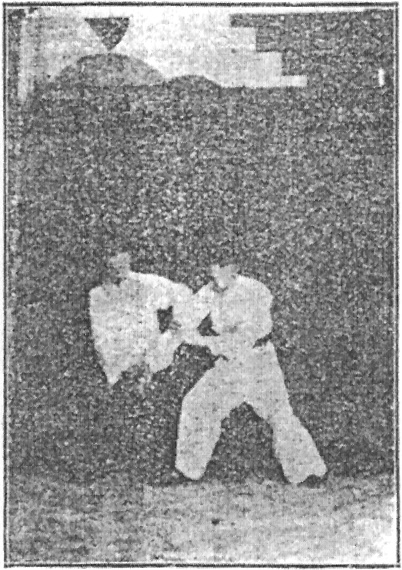
(按)此式之動作。有人名之曰「掉手推手」。卽掉轉其手之意。然亦有人名之曰。「拿手手推」。其意即拿住對方之手。而推之也。
Note:
Some people call this exercise Dropping-Hand Pushing Hands due to the intention of dropping down and turning over the opponent’s hand. There are also some who call it Seizing-Hand Pushing Hands due to the intention of seizing the opponent’s hand and pushing him.
戊第十二式 「左右三人雙手推單手」之使用及練法
E. Pattern 12: THREE-PERSON DOUBLE HAND VS. SINGLE HAND ON BOTH SIDES – Its Function & Practice Method
▲說明
Explanation:
此式之推手。為三人練習之用。甲在當中。成為左右雙手推單手之姿勢。其動作與第九式。大致相同。丙先得機。向甲身按推。右膝彎曲為弓式。左腿伸直在後。全身重點。稍往前傾。右手按在甲右手背。左手按住甲之右肘尖。有向下擠按之意。兩眼注視甲手。
甲見丙推來。乃立涵胸擰腰。身往後坐。右腿斜直為虛。在腿屈曲為實。使丙不能侵及甲身。兩眼注視丙手。同時並以左手向乙方擠去。
乙見甲用擠勢推來。又如丙之以兩手掤住甲之左手背肘尖。立卽涵胸坐後。以避來勢。推須用右足在前。伸直為虛。左腿彎曲在後為實。此時甲之步法與丙為合步。與乙為對步。其姿勢如第十二式。第廿一圖是也。
This pushing hands pattern is for practicing with three people. A is in the middle, making a posture of double hand vs. single hand on both sides, and so the movement is mostly the same as in Pattern 9.
C [to the left in the photo] begins by seizing the opportunity, pushing down toward A’s body, his right leg bending to make a bow stance, left leg straightening behind, the weight slightly inclining forward. His right hand is pushing on the back of A’s right hand, left hand pushing on A’s right elbow, and he has an intention of pressing downward. His gaze is toward A’s hand.
A sees C’s push coming, and so he immediately hollows his chest, twists his waist, and sits his body back, his right leg slanting away and straightening, becoming empty, left leg bending, becoming full, making C unable to approach his body. His gaze is toward C’s hands. At the same time, he also presses out toward B with his left hand.
B [to the right in the photo] sees A’s push coming, as a pressing posture, and also that C is using both hands to ward off the back of A’s left hand and his elbow, so he immediately hollows his chest and sits back to avoid the incoming force [and also has an intention of rolling back diagonally outward]. While being pushed, his right leg must straighten in front, becoming empty, and his left leg bend behind, becoming full. A is now in a same-step position with C and a facing step position with B. See photo 21:
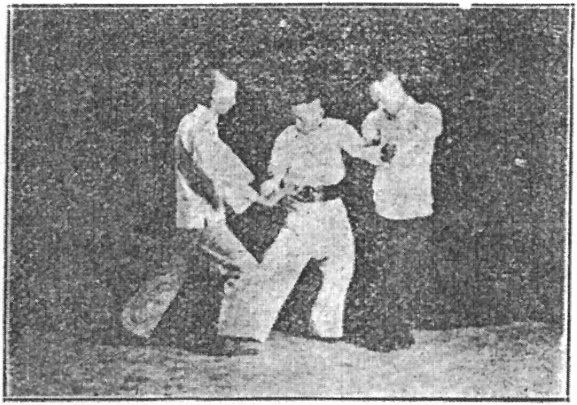
承上式。乙先乘勢往下按推。右足在前曲膝。變為弓式。左足在後伸直。全身重點。稍往前傾。有往甲方擠推之意。兩眼注視甲手。
甲見乙推來。乃立即涵胸擰腰。身往後坐。左足斜直為虛。右足屈曲為實。使乙不能侵及甲身。向丙方變為弓式。同時並以右手向丙方擠去。兩眼注視丙手。
丙見甲用擠勢推來。又如乙之以两手掤住甲之右手背及肘尖。立即涵胸坐後。以避來勢。兼有往外斜捋之意。但以右足在前。伸直為虛。左腿彎曲。在後為實。兩眼注視甲手。此時甲之步。與丙為對步。與乙為合步。其姿勢如第十二式。第廿二圖是也。
Continuing from the previous scenario, B [still to the right in the photo] now takes advantage of the momentum and pushes down, his right leg bending to make a bow stance, left leg straightening behind, the weight slightly inclining forward, and he has an intention of pressing downward. His gaze is toward A’s hand.
A sees B’s push coming, and so he immediately hollows his chest, twists his waist, and sits his body back, his left leg slanting away and straightening, becoming empty, right leg bending, becoming full, making B unable to approach his body, and switching into a bow stance toward C. At the same time, he also presses out toward C with his right hand. His gaze is toward C’s hands.
C [still to the left in the photo] sees A’s push coming, as a pressing posture, and also that B is using both hands to ward off the back of A’s right hand and his elbow, so he immediately hollows his chest and sits back to avoid the incoming force, and also has an intention of rolling back diagonally outward while his right leg straightens in front, becoming empty, and his left leg bends behind, becoming full. His gaze is toward A’s hands. A is now in a facing-step position with C and a same-step position with B. See photo 22:
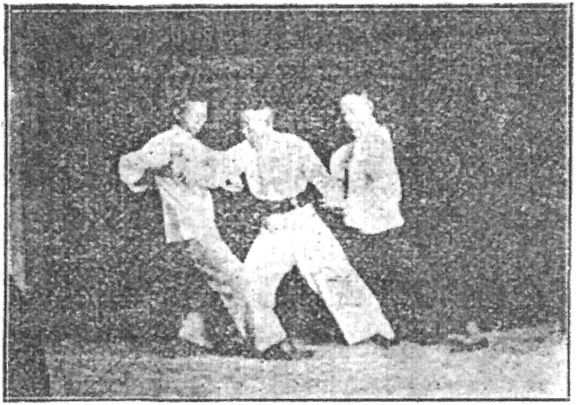
(按)如丙方往下按化甲擠。甲則同時向乙方擠去。迄乙叉按化甲擠。甲則反向丙方擠去。須隨屈就伸。為左右合步。擰身涵胸。則活潑自如。依此循環練習。三人須同一致之動作。方能得着此中立妙也。
凡在推手時。須全身各部。一氣整動。方能收效。如若散漫。則不易將敵方推倒也。
Note:
When B pushes down to neutralize A’s press, A then at the same time presses out toward B. B then also pushes down to neutralize A’s press, so A reverses and presses out toward C. [A] must follow and bend [on one side] while engaging and extending [on the other], getting into the same-step position back and forth, twisting his torso and hollowing his chest. For it to be done lively and smoothly depends on practicing it over and over. All three people must move in unison [for the person in the A role] to be able to obtain this exercise’s marvel of neutrality. Always when pushing hands, you must use every part of your body in a unified and complete action for it to be effective. If on the other hand it is a sloppy mess, it will not be easy for you to push opponents away.
「附誌」推手演式者
Note:
The performers in these pushing hands demonstrations are:
(甲)顧汝章
Person A – Gu Ruzhang
(乙)白志祥
Person B – Bai Zhixiang
(丙)唐啓賢
Person C – Tang Qixian
–
補述
SUPPLEMENTARY COMMENTS [ABOUT FOOTWORK]
太極推手。其法甚多。千變萬化。循環不已。而步法亦殊重要。如合步推手。對步推手。活步推手。順步推手。速步推手。及一步三手等等。胥皆由掤。捋。擠。按。採。挒。肘。靠。而產生者也。所謂合步者。如第八式是也。對步者。如第十式是也。活步者。兩人同時活動其步也(即動三次足。實上二次步。一次在原地)。若甲前進。則乙後退。反之亦然。但此式又可變為合步。或順步。順步者。兩人之足。皆順在一邊之意也。如甲右足在前。左足在後。乙左足在前。右足在後是也。夫順步。亦可變為活步。或合步。至於速步者。專為練習步法敏捷。氣力增長。前進後退。各無一定之姿勢。此擠彼按。甲掤乙捋。隨意變換。旋轉不停也。一步三手者。卽兩人相推三次。甲上前一步。乙退後一步之謂也。綜上各式。皆用四正推手法。(雙搭手)應由掤。捋。擠。按。依序而進。其變化處。請參閱各式之說明便知矣。不過其步法之不同耳。
In Taiji’s pushing hands, there are many methods, ever-changing and cycling endlessly. Its footwork is particularly significant, such as same-step pushing hands, facing-step pushing hands, moving-step pushing hands, opposite-step pushing hands, rapid-step pushing hands, one step with three techniques, and so on. They are all generated from the techniques of ward-off, rollback, press, push, pluck, rend, elbow, and bump.
What is called same-step is like in Pattern 8.
Facing-step is like in Pattern 10.
Moving-step is when both people move in their steps at the same time (there being three steps, which are actually two walking steps and one planting step.) If A is advancing, B is retreating, and vice versa. But it can also be switched to same-step or opposite-step.
Opposite-step is when both people are stepping on the same side, for instance if A’s right foot is forward, left foot behind, then B’s left foot is forward, right foot behind. From opposite step, it can change to moving-step or same-step.
As for rapid-step, it focuses on practicing the stepping with agility and increased energy, advancing and retreating without a specific plan, whether one is pressing and the other pushing, or A is warding-off and B is rolling back, exchanging according to the moment and circling without pause.
One step with three techniques is when both people push each other three times, then A takes one step forward, B taking one step back [and vice versa].
Each of the methods above are using the Pushing Hands Method for the Four Primary Techniques (i.e. double-touching hands), complying to warding off, rolling back, pressing, and pushing as they go in sequence through their transformations. You may refer to their explanation [Patterns 3–5] for ease of understanding, for the footwork is the only thing here that is different.
–
跋
POSTSCRIPT
太極拳一書。為顧師汝章最近之著作也。邇因課忙。囑為校訂。查是書內容之豐富。註解之詳明。與及姿勢之正確。足為後學楷則。入門之捷徑也。
夫太極拳術。為武當嫡派。原出內家。其動作尚慢。能以靜制動。以柔剋剛。以逸待勞。其根本則純以自然之氣。由丹田而達於四肢。拳經所謂無微不至也。其運勢之宛轉變化。使人莫測端倪。其發勁之迅速。又如疾雷閃電。令人猝然莫知措施。至其應敵方法。為乘人之勢。藉人之力。即四両撥千斤是也。然非勤於用功。未克臻此。至於轉弱為强。却病延年。尤其餘事耳。且是拳之優點甚多。練之有益無損。誠養生之妙術也。茲畧述其大意。綴為跋語。
受業唐啟賢謹跋於廣州國術社
This volume on Taiji Boxing was recently written by Gu Ruzhang mainly because he has been busy teaching it and was urged to make an authoritative text for the students to compare their lessons against. Examine it for its rich contents, its comprehensive annotations, and its postural standards. It is a sufficient model for students, making it easier to learn the fundamentals.
The art of Taiji Boxing is descended from Wudang, coming from the internal school. Its movements emphasize slowness. It can use stillness to control movement, softness to overcome hardness, ease to await exhaustion. Its essence is simply to make use of one’s natural energy. From the elixir field, it reaches to the extremities, as is said in the Taiji Classics [Understanding How to Practice]: “penetrating even the smallest nook”.
Its movements are indirect and changing, causing the opponent to have no idea what is happening. Its issuing is sudden, like a thunderclap or lightning flash, giving the opponent no chance to know what to do. Its method of dealing with opponents is to take advantage of an opponent’s position and make use of his force – “four ounces moving a thousand pounds”.
Yet if you do not diligently work at it, you will not be able to attain such a level that softness becomes strength, or that sickness is prevented and life extended, which are its special byproducts. There are a great many advantages to the art, and practicing it is a case of benefits without drawbacks. It is indeed a marvelous method of nourishing your health. I hope these slight statements of its grand meaning might serve as an adequate coda.
– sincerely written by your student, Tang Qixian, at the Guangzhou Martial Arts Society
–
–
–
